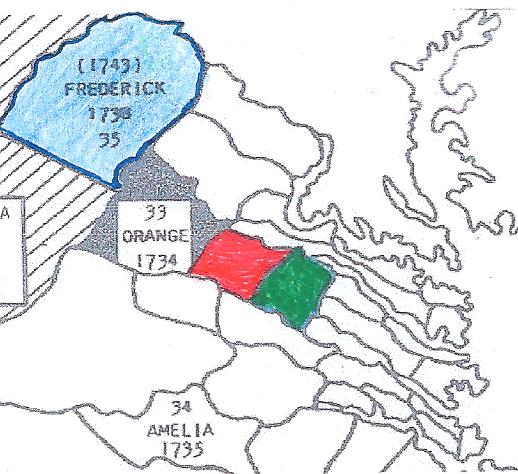 Map
showing Frederick County (in blue)
Map
showing Frederick County (in blue)Chapter 6
Son ~ James
By the time James and Agnes Todd Ware had their next child, their oldest son, John, was around five and Nicholas was two. Naming him after his father, James Ware, Agnes delivered her baby on March 13, 1741-42. (There has often been confusion with the exact date for James because some sources list the year as 1741 and some as 1742. There is a detailed explanation for this ‘double-dating’ at the end of this chapter listed under supporting documentation.)
Working from either date, the senior Wares were approximately 28 years old at the time of James’ birth. Several references have stated that he was “one of the handsomest men in the state and one of the finest looking men to be found anywhere.” (Ref. 2, 6) For James and Agnes, however, they probably could have cared less about their son’s good looks at the time. A yellow fever epidemic had hit Virginia in 1741, striking fear in every colonist’s heart. Eighteenth century doctors, not knowing much about how to treat such diseases, relied on their standard approach of ‘purging’ in hopes of getting the sickness out of the body. Even the weakest victims were often subjected to heavy doses of laxatives or bloodletting, and tiny infants stood little chance of surviving such extreme treatments. Fortunately, James stayed healthy, and the entire Ware household weathered the season without any casualties.
James II decided to enter the medical profession upon adulthood. He “studied medicine and moved to Caroline County to set up his practice.” (Ref. 2) It was in that county that he met young Virginia Catherine Todd, a close neighbor. Her nickname was Caty, and she “was the daughter of Dr. James Todd, an eminent physician and a Scotchman.” (Ref. 2) There must have been quite a mutual attraction because James and Caty married in 1767, with James being 26 and Caty not quite 14 at the time! (Ref. 2,35G, 602) In a letter written in 1831 by their son, Charles Ware, he stated that his
parents “were married early in life, particularly your grandmother (before she was 14 years old.)” (Ref. 35G)
The newlyweds “remained in Caroline County until their first child, Thompson Ware, was born in 1769. They then moved to Frederick County and continued to live there until 1791.” (Ref. 35G, 602, 2350)
 Map
showing Frederick County (in blue)
Map
showing Frederick County (in blue)
(Caroline County is in green)
Caty soon gave birth to a second son in Frederick County. Named after both his father and grandfather, James Ware III was born on January 13, 1771. (Ref. 1, 2, 6, 621, 940) He would be followed shortly by five other children, and it would seem that for every year Caty was pregnant, a milestone was met in the formation of the new country for which the colonists were fighting. Mary Todd (called Polly) Ware was born in 1772, the year that three radical proclamations asserting the rights of the colonies to self-rule were presented by Samuel Adams. In 1773, the year of the Boston Tea Party, another daughter, Lucy Ware, was born. Charles was born when the first shot was fired in 1775, Kitty arrived while the war still raged in 1777, and even baby George came into the world before the fighting finally ceased and peace was won.” (Ref. 56, 173) It was a turbulent time in which to raise a family.
Military records show that James II was “a cavalry soldier in a Virginia unit” and he is listed as a Revolutionary War Patriot. (Ref. 629,834) One can assume his skills as a physician were put to use in many capacities. (See records below)
RECORDS FOR JAMES WARE II


![]() James
Ware of King and Queen, E.
James
Ware of King and Queen, E.
James Ware 2 VA State Regiment, E (Ref. 2388)
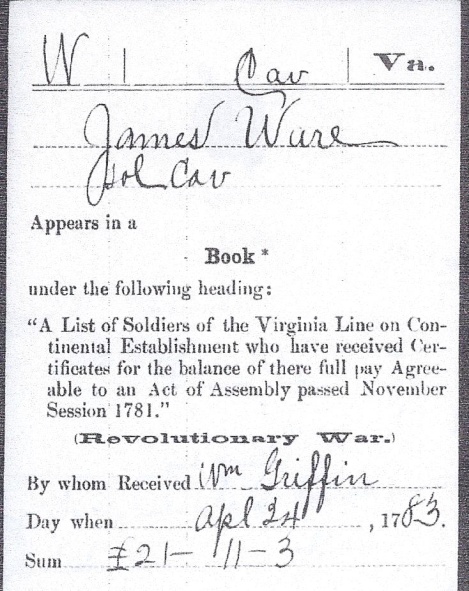 (Ref.
2489)
(Ref.
2489)
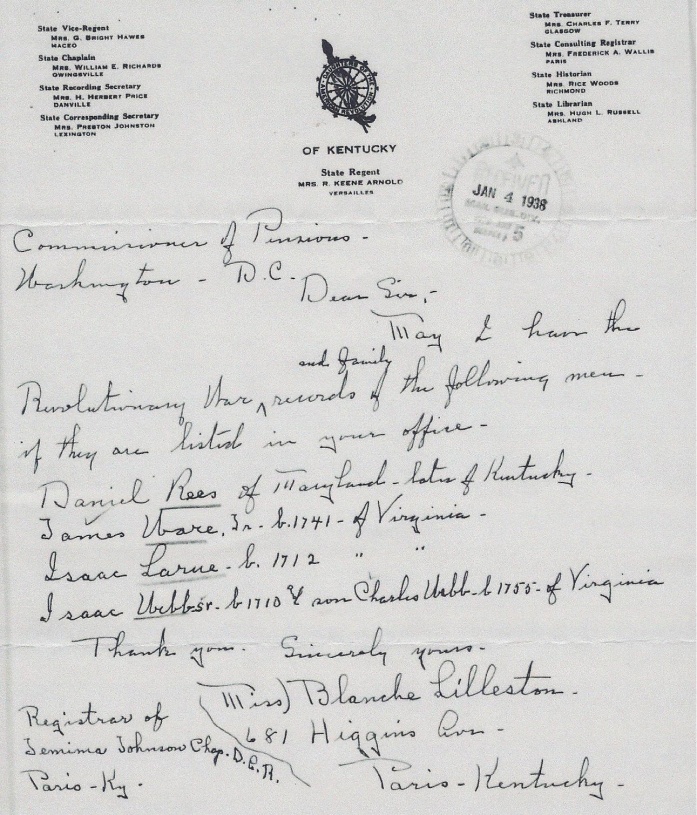
Request form for Revolutionary war record of James Ware
Dr. Ware did military service in Winchester, where he and Caty had their home. “There is a deed on file in the courthouse there for property bought by James Ware in 1781. The deed conveys to him half an acre of land in Winchester, Virginia for 2,000 pounds of tobacco; Virginia money.” (Ref. 2, 334) Caty would find herself in the very middle of much of the war activities.
Winchester was the county seat for Frederick County. George Washington had supervised the construction of Fort Loudoun there in 1756, and it was often thought to be the most formidable fort on Virginia's colonial frontier. “After the surrender of Burgoyne, in 1777, many of his men were sent to a military prison, at Winchester, others were quartered at Albemarle Barracks (now Charlottesville). The prisoners taken at the Cowpens were also sent to Winchester, as were likewise the soldiers in the army of Cornwallis.”(Ref. 2557) On January 8, 1782, it is recorded that James, “along with Edward Smith and other inhabitants of Winchester, communicated with the Executive of Virginia. They were setting forth reasons why the British prisoners in barracks near Winchester should not be moved.” (Ref. 372) By this time, Caty had delivered her last child.
The years spent in Frederick County had been fruitful ones. For a little over 20 years, from 1770 to 1791, James and Caty had vested themselves in the community and lifestyle of northern Virginia. As a large landowner in the area, James was expected to fulfill certain civic responsibilities as well as military ones, and he not only owned property in Winchester, but “there are also Virginia documents that state, “a large marsh on Chapel Run is mentioned in the deed from Colonel Hugh Nelson to James Ware in 1788 for 478 acres of land whereon the said James Ware now lives.” (Ref. 320) The following excerpt from Virginia Roots in Kentucky Soil provides us information about the duties that accompanied such land holdings:
“In October 1772, James Ware was appointed overseer of the road leading from Berry’s Ferry (where US Route 50 crosses the Shenandoah River) to Winchester. Part of this old road is still in use and crosses the road leading from Boyce to Old Chapel near New Market.” (Ref. 203, 272, 322) General Daniel Morgan, an American pioneer, soldier, and United States representative from Virginia, had previously been the overseer and James succeeded him. (Ref. 203, 272, 322) In 1785, General Morgan petitioned the court of Frederick County to have this road changed so that it would pass by a mill being built at that time in Millwood. “Upon the petition of Daniel Morgan, praying for a road to be opened from James Ware’s fence between the Chapel road and the road to Berry’s Ferry, by a new mill to be erected on Burwell’s land, it was ordered that Marquis Calmes, William Ball, Charles Webb, and Isaac Webb or any three of them do view the ground and report the conveniences and inconveniences which would attend the altering of the said Chapel Road so as to be by the said mill.” (Ref. 249) In May of the same year, the court approved Morgan’s petition.
![]()

![]()
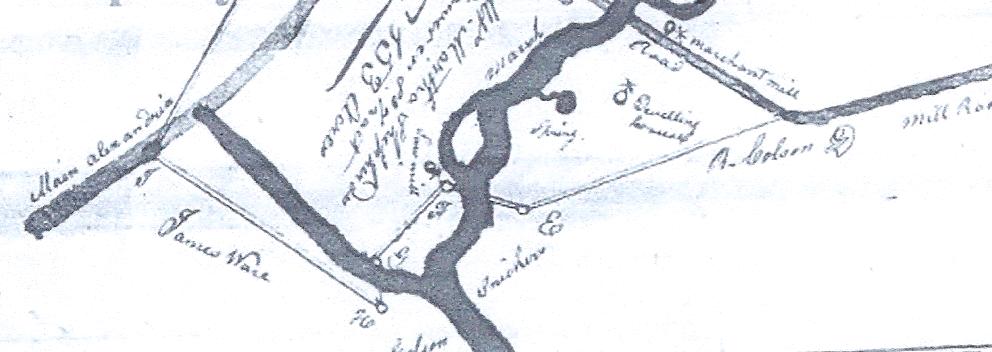
![]()
Map showing property of Dr. James Ware in Frederick Co., Virginia
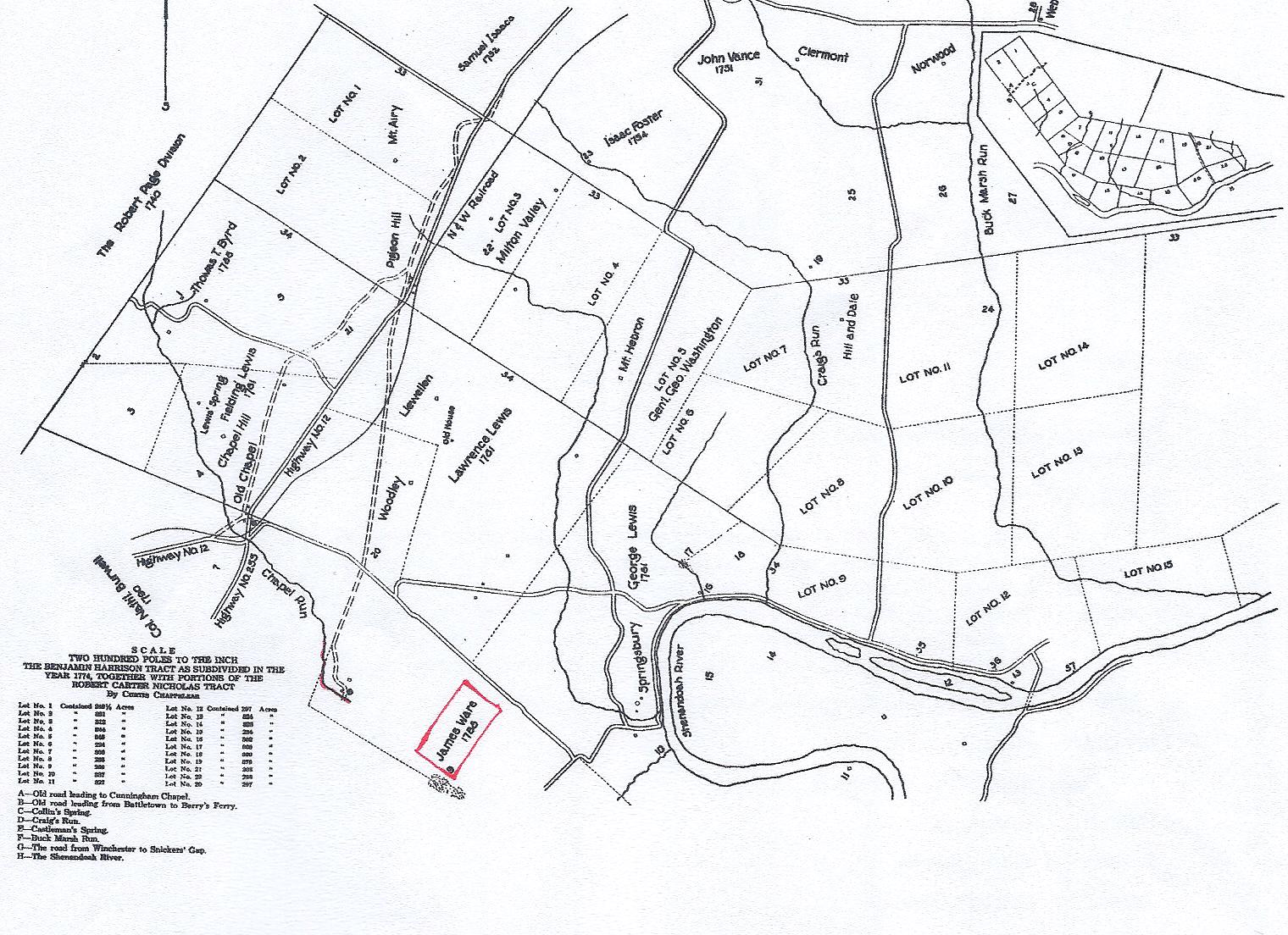
![]() Map
showing the property of Dr. James Ware
Map
showing the property of Dr. James Ware
Along with community obligations, military service, and raising a family, James and Caty maintained a solid and committed religious life. Their future would find the couple embracing a different faith in Kentucky, but they were faithful members of the Episcopal Church during those years spent in Virginia. Reverend Alexander Balmain, “who had been a chaplain in the army, was chosen as minister for Frederick Parish by the Episcopal vestry and elected immediately after the Revolutionary War.” (Ref. 708) He was also a personal family friend who wrote a journal providing much information about the church and the Ware family. His entries included a list of subscribers in the congregation for September 1782 through September 1784. “Subscribers invariably meant contributors to the support of the minister, and under the title ‘subscribers paid in money’ was the name of James Ware.” (Ref. 242, 708) The congregation first met in the McMahon home, but building soon began on a church. “Around 1791, many of the members, perhaps all, joined the Old Chapel congregation.” (Ref. 706, 1000) Since that is the same year James moved to Kentucky, it is hard to know if he ever actually attended services in Old Chapel.
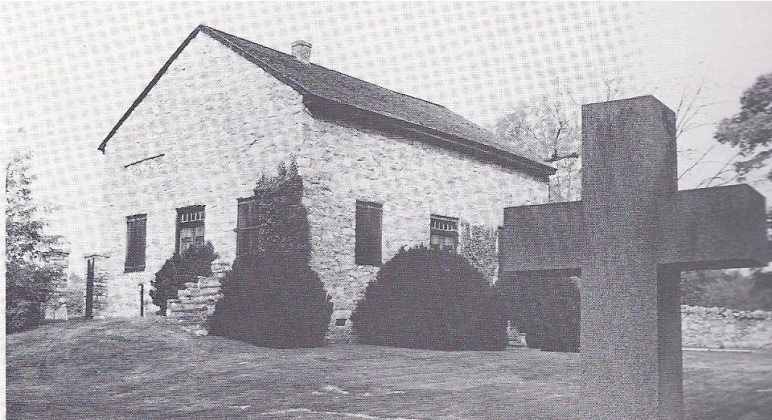 Old Chapel Episcopal
Church
Old Chapel Episcopal
Church
In the fall of 1784, Dr. Ware (i.e., James II) decided to visit Kentucky for the first time, and he remained there all that winter. (Ref. 35G, 334) John Adams, John Jay, and Benjamin Franklin had negotiated the Treaty of Paris the previous year, thus ending the eight-year war with Great Britain. Peace was finally at hand.
With that peace, James and other American soldiers looked forward to reaping the rewards of a free people. This new country, however, was still trying to get its feet on the ground and money was in short supply. “Revolutionary soldiers of Virginia were unpaid, and the state used her western lands to settle these debts.” (Ref. 2254) It was a satisfying arrangement for all. “Awarding bounty land as an inducement for enlisting in the military forces had been a long-standing practice in the British Empire in North America. A land bounty is a grant of land from a government given as a reward to repay citizens for the risks and hardships they endured in the service of their country.” (Ref. 2110) All colonists knew well the value of land - - it was the measuring rod of wealth in this new world.
The first warrants “were issued about the year 1784,” which would explain why James chose that year to visit Kentucky. (Ref. 2491) Opportunities for prosperity were boundless with the possession of these land grants, and in May of 1779, the Virginia General Assembly passed laws that expanded the land patenting process to include acquisitions by treasury warrants. From October 1779 to December 1783, over 23,000 of these treasury warrants were purchased from the Virginia Land Office or authorized by the state General Assembly by special legislation. James was the owner of several of those warrants.
To understand the land grants, it is important to remember that the country looked much different in the 1700s than it does today. The newly formed Congress, in creating the Ordinance of 1787, “established the precedent by which the United States would expand westward across North America by the admission of new states, rather than by the expansion of existing states. What was then known as the Northwest Territory was organized out of the region south of the Great Lakes, north and west of the Ohio River, and east of the Mississippi River.” (Ref. Wikipedia) This was a monumental decision on the part of (what used to be) the original 13 colonies because it shifted forever the boundaries and powers of each state. It showed tremendous forethought on the part of the nation’s leaders at the time.
According to Wikipedia, “in October 1784, Virginia ceded to the nation the vast territory northwest of the Ohio River, but there were two major stipulations attached to the deal. One demand was that the Northwest Territory had to be divided, eventually, into new states (later determined to be Ohio, Indiana, Illinois, Michigan, Wisconsin, and the portion of Minnesota east of the Mississippi River).” The second stipulation was that the Virginia Military District, which included the area east of the Little Miami River and west of the Scioto River, was to be used to fulfill land grants promised to those Virginia soldiers who had done service in the Continental Army during the war. The federal government agreed to Virginia’s requests when it accepted the state’s offer of land in 1784.
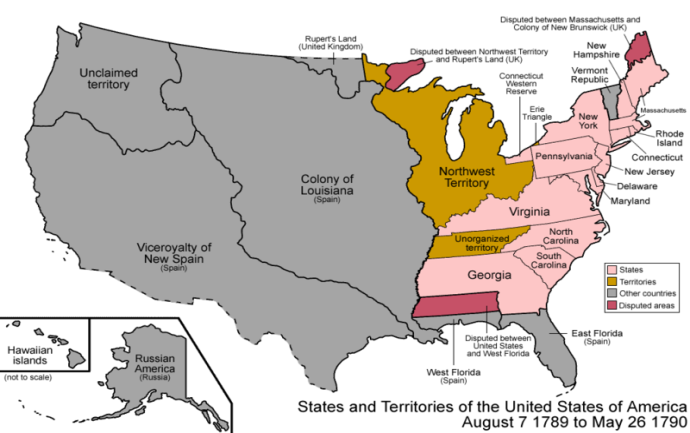
Map showing how different the state boundaries looked in the 1700s
Article 5 of the Ordinance of 1787 specifically addressed this issue of creating separate states.
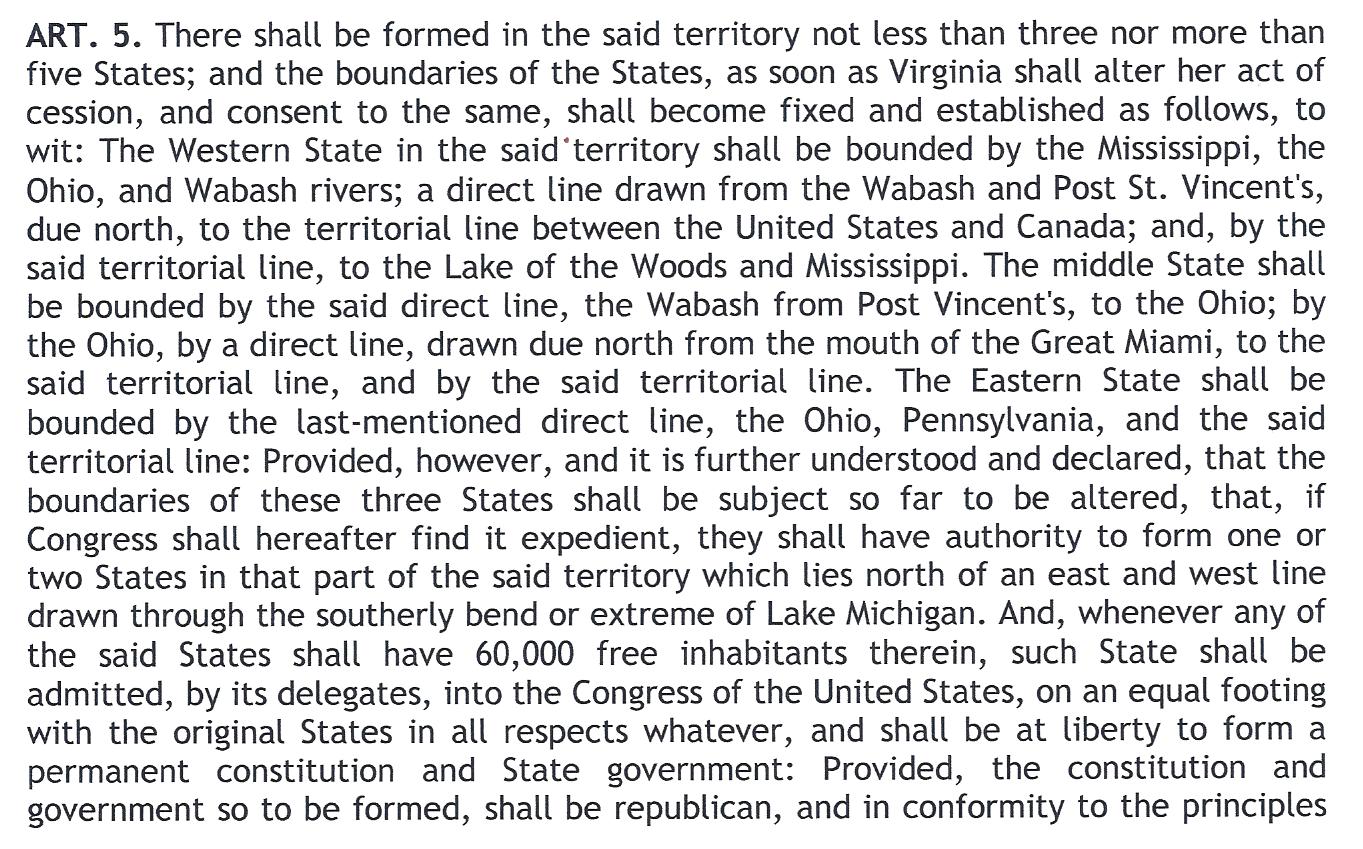
![]()

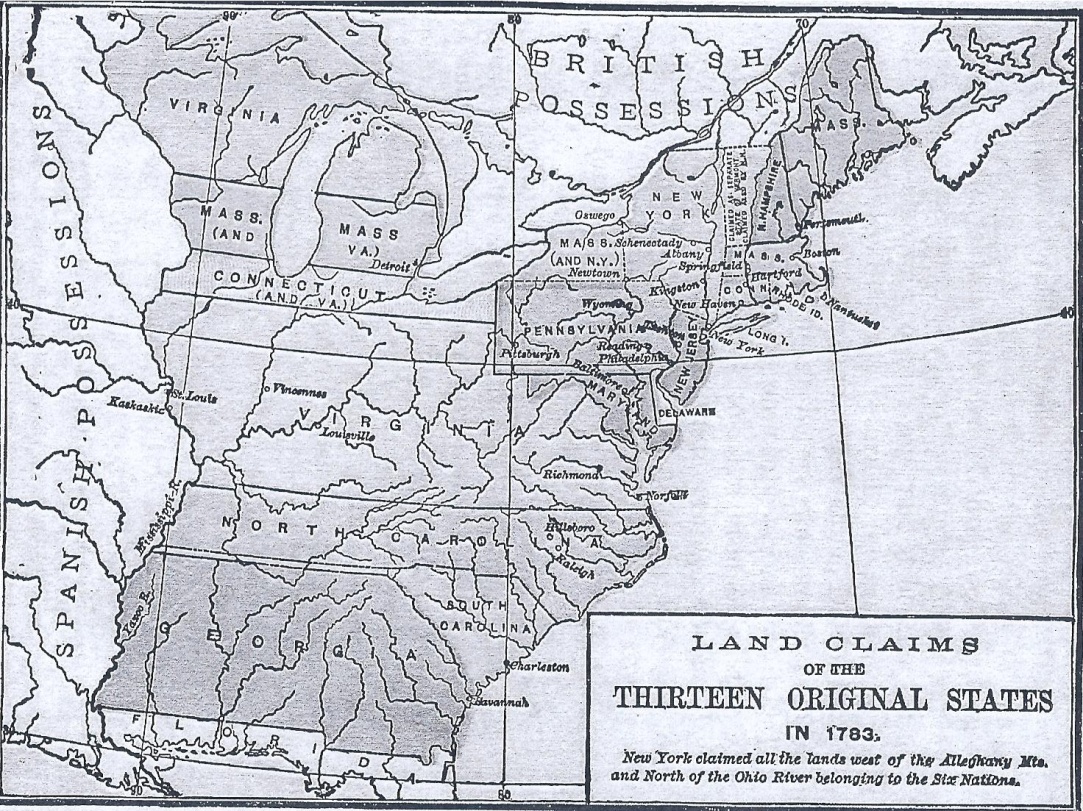
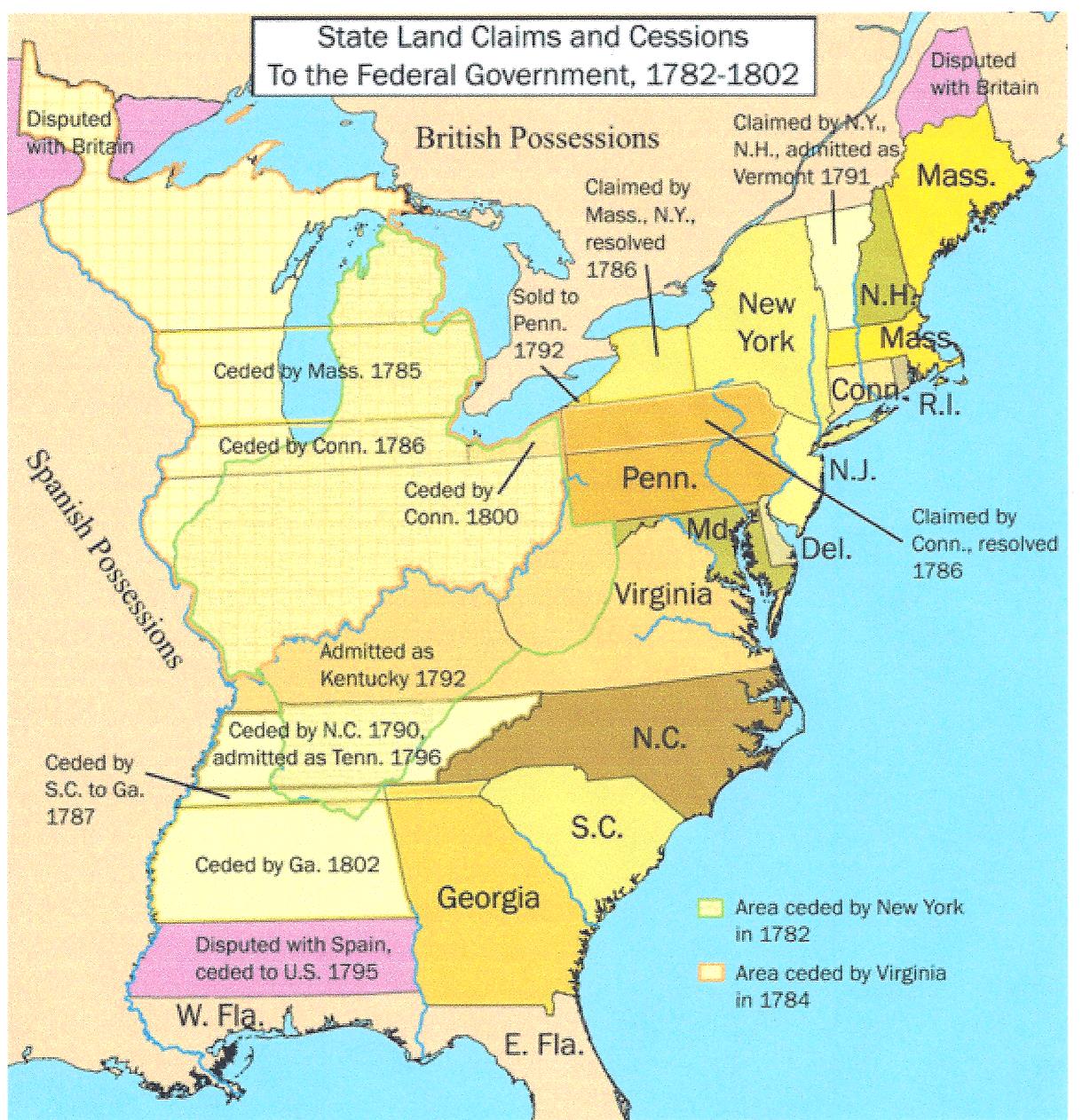
The two maps above show how differently the state boundaries looked after the land was ceded.
Most of what we know of as ‘Kentucky’ today was simply a part of Virginia in the 1700s. In 1776, the frontier county of Fincastle, Virginia, was dissolved and renamed Kentucky County, Virginia. Then “Kentucky County was divided by the Virginia legislature in 1780 to form the counties of Fayette, Jefferson, and Lincoln.” (Ref. 864)
Map showing the division of Fincastle Virginia into Kentucky County in 1776
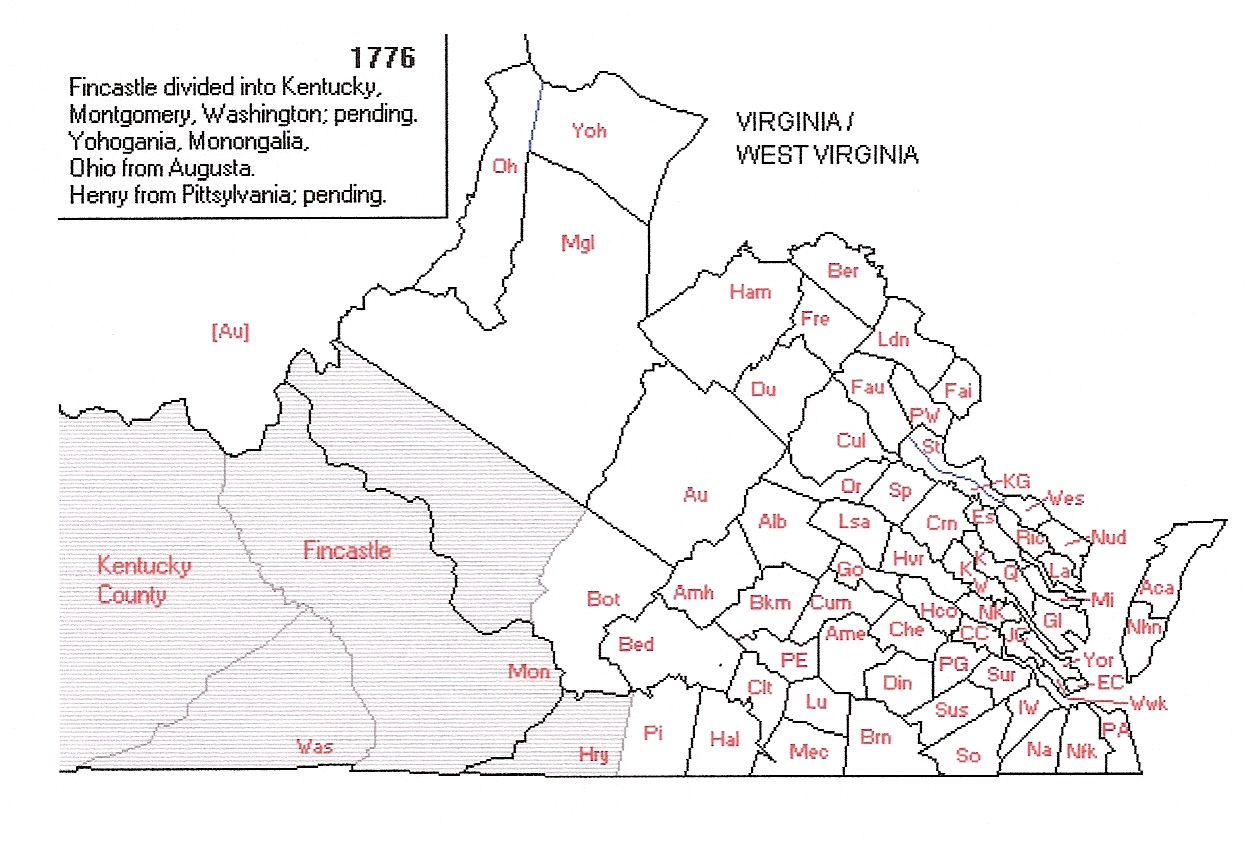
There were still further divisions for Kentucky, which “occurred on May 1, 1785, when Fayette County was divided into two parts, the northern section being called Bourbon and the southern section keeping the name of Fayette. The first courthouse in 1787 was in Hopewell; renamed Paris on December 1, 1790.” (Ref. 941)
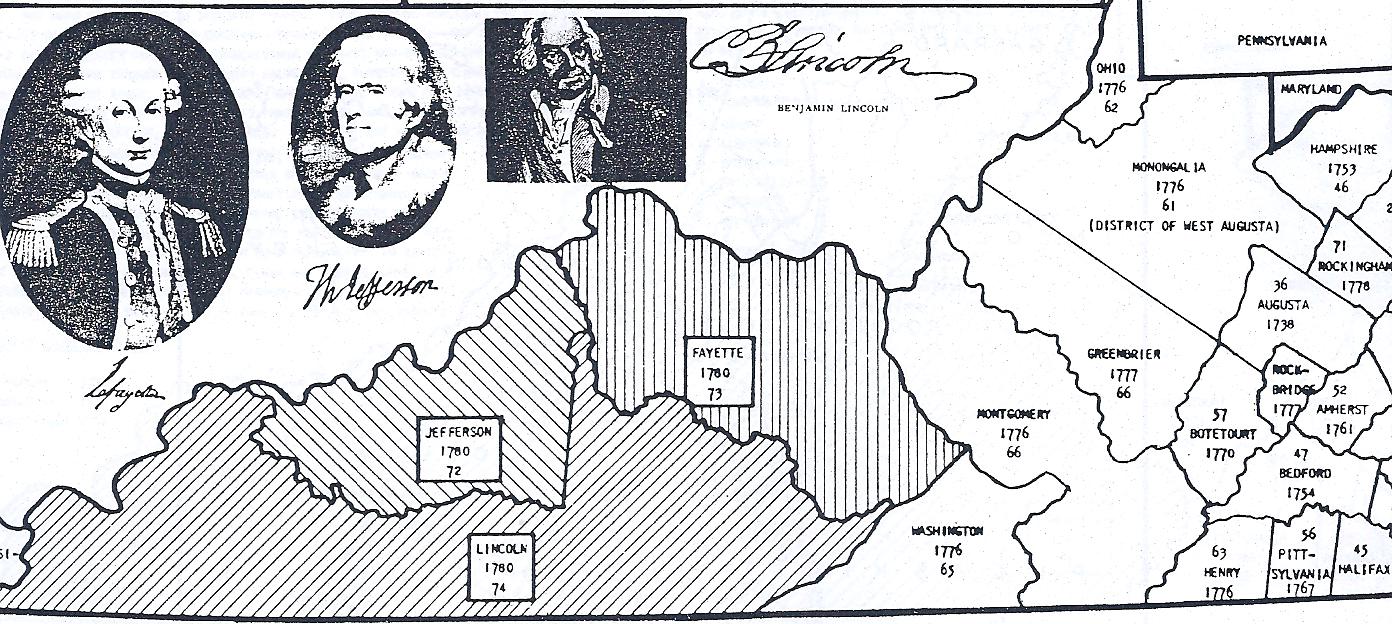 Map showing division
of Kentucky counties
Map showing division
of Kentucky counties
In 1788, Woodford County was then formed out of Fayette County. (Ref. 864) The city of Versailles, near Lexington, was carved out of Fayette in 1792 and became the county seat of Woodford County. Many of the names that appear in early Kentucky towns reflect the great influence France had with the colonies during the war. General Marquis Calmes, a friend of the beloved Marquis de Lafayette, the man so instrumental in obtaining the support of France during the Revolutionary War, was an associate of the Wares in Virginia. He founded the city of Versailles, Kentucky, using the name of “Versailles” (one of his favorite cities in France) as a way to honor his Huguenot ancestry.
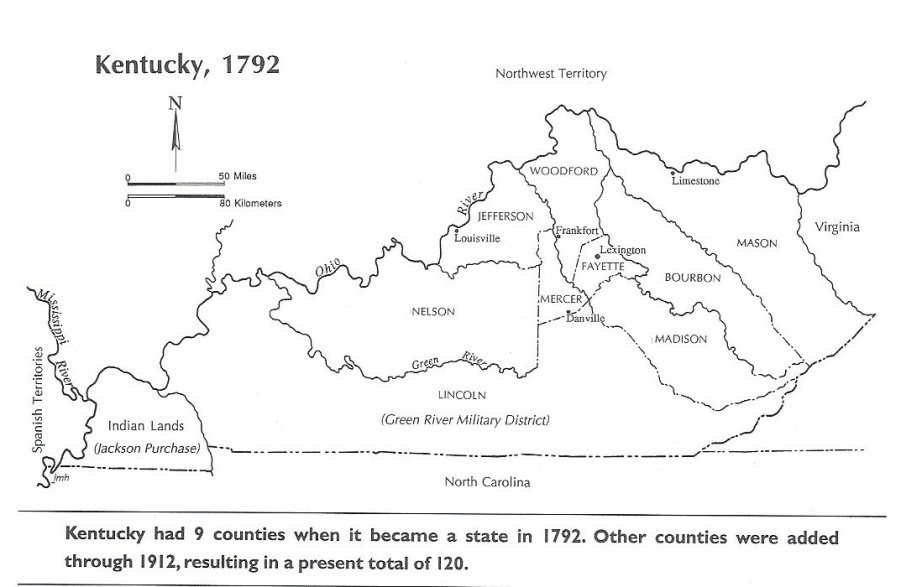 (Ref.
2543)
(Ref.
2543)
Courtesy of Neal O. Hammon)
It was into these counties the Ware family eventually settled: “Thompson settled in Paris, James and Caty homesteaded in Fayette County around Lexington, Charles lived near Versailles, George in the homestead, Lucy Webb the adjoining farm, Polly Webb near Paris, James Ware I in Woodford County, and Catherine Ware Scott in Frankfort.” (Ref. 299)
As written in Virginia Roots in Kentucky Soil, “Many members of the Ware family had served in the Revolutionary War and, consequently, many found themselves the proud owners of new lands offered in the wilderness of Kentucky. It was a wonderful opportunity for families to become part of a newly organized society. If relatives moved together at the same time and made their holdings on adjoining properties, they could virtually create small ‘dynasties’ where neighbors were family and family were neighbors. Such was the case with James Ware II.” (Ref. 2350)
The Ware and Webb families were good examples of those who traveled together. Dr. Ware and Caty had two daughters who married into the Webb family, making them bound not only by friendship but by blood. Both Webb brothers had fought in the war and received land grants, as did James. Fayette County papers reflect that both families settled close to each other. “Ware’s military survey, done in 1782, [was] of 1,000 acres of land in the neighborhood, on or near Cane Run.” (Ref. 1033, 1072) Isaac Webb had “enlisted in the Revolutionary army at the age of 17, served to its close, attained the rank of Captain, and received land from Virginia as well.” (Ref. 174) Isaac, however, had also re-enlisted so he “received 2,666 2/3 acres of land for three years’ service; also an annual pension of $320.00 from May 31, 1833 until his death.” (Ref. 6, 174) According to Cornelia Ware Anker, “it was partly by Isaac Webb’s persuasion that the move was made.” (Ref. 2)
With “payment” for military service in hand, there were still four major steps that had to be accomplished before owning the land patent. One needed the actual (1) “warrant” to obtain authorization for a survey, (2) an entry number to reserve the land for patenting, (3) the performance of the actual field survey done by “a regularly appointed County Surveyor,” and finally, (4) the ‘Governor’s Grant’ or signature which would seal the deal.
 (Ref. 2536) Easy formula
to remember
The surveyor needed the following information in order to do
his job - “the
proposed boundary in numbers of acres, on some particular
watercourse, and in one of the original counties.”
(Ref. 2284)
It was possible for a person to have several warrants (1) in their
possession, but unless the other criteria (2, 3, and 4) were met, the
land was not legally theirs.
(Ref. 2536) Easy formula
to remember
The surveyor needed the following information in order to do
his job - “the
proposed boundary in numbers of acres, on some particular
watercourse, and in one of the original counties.”
(Ref. 2284)
It was possible for a person to have several warrants (1) in their
possession, but unless the other criteria (2, 3, and 4) were met, the
land was not legally theirs.
The warrant recipient also had choices regarding disposition of their land. Some “assigned their land to sons or other relatives, while others sold their ‘interest and title’ in the land to some pioneer and his family, or to some real estate speculator.” (Ref. 2491) In the case of one man, he was awarded over 15 warrants but he chose to patent only 11 of them. He probably just sold off the other parcels if they did not benefit his estate.
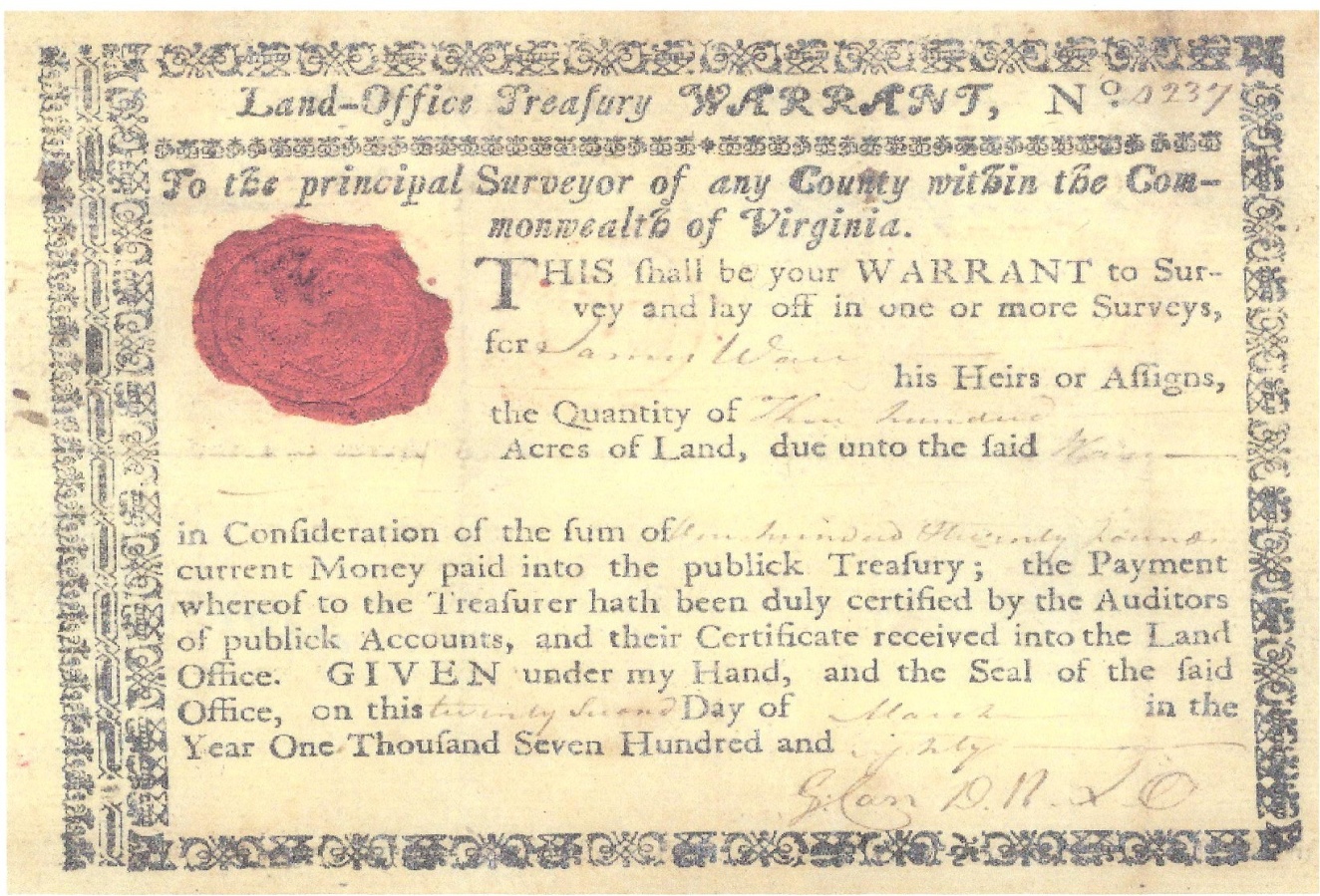 This warrant
is a
good
example of one which James, obviously, chose not to keep. He
signed this warrant for 300 acres of land over to Benjamin Combs.
This warrant
is a
good
example of one which James, obviously, chose not to keep. He
signed this warrant for 300 acres of land over to Benjamin Combs.

#4237 “I assign the within warrant to Ben Combs & his heirs at witness my hand this twenty-ninth day of March 1780” (witness signature) James Ware
Some warrants were “made for veterans of the French and Indian War, their heirs, or assignees. Surveys for officers were usually in 1000 or 2000-acre tracts, but thirteen were for 3000 acres, one for 5000 acres, and one for 6000 acres. There were only two 50-acre surveys made on warrants to private soldiers and fourteen 200-acre surveys made on warrants to sergeants. These surveys were usually called military surveys. Hancock Taylor made 30 of these surveys, James Douglas made 23, Isaac Hite made 3, and the remainder were made by John Floyd. Many of these survey descriptions mention the names of the men who had adjacent surveys.” It was also recorded at some point that “the present Iron Works Pike was the base line used by John Floyd to lay out many of his surveys along Elkhorn Creek.” (Ref. EARLY KENTUCKY LAND RECORDS, 1773-1780 by Neal O. Hammon)
A deposition of Robert Johnson, taken at the Kentucky Hotel in Lexington on June 10, 1812, gave a detailed description of the location of the Ware property. Johnson stated, “The Ironworks Road runs by the corner of Ware’s, Christian’s, and Meredith’s military surveys, which road crossed the road from Lexington to Georgetown and Henry Mill Road (now the Newtown Pike.) The corner to Ware’s and Christian’s military survey is below Georgetown Road near Hutchison’s Tavern, and the greater part of Christian’s and Meredith’s lines are above the same road from Lexington to Georgetown. I believe these surveys were well known to people of Bryant’s Station and Lexington as early as 1781-1782. Robert Johnson bought a settlement and preemption of Bryant which joined Ware’s, Christian’s, and Floyd’s, also part of Patrick Henry’s military survey and in 1783 he settled where he now lives at the Great Crossing.” (Ref 1072 & 1033)
The following is a land warrant belonging to James Ware II that contains the (1) warrant, (2) entry date, (3) survey, and the (4) grant with the final seal.
![]()
Land warrant dated March 22, 1780, for three thousand acres of land purchased for the price of twelve hundred pounds Entry number 4234
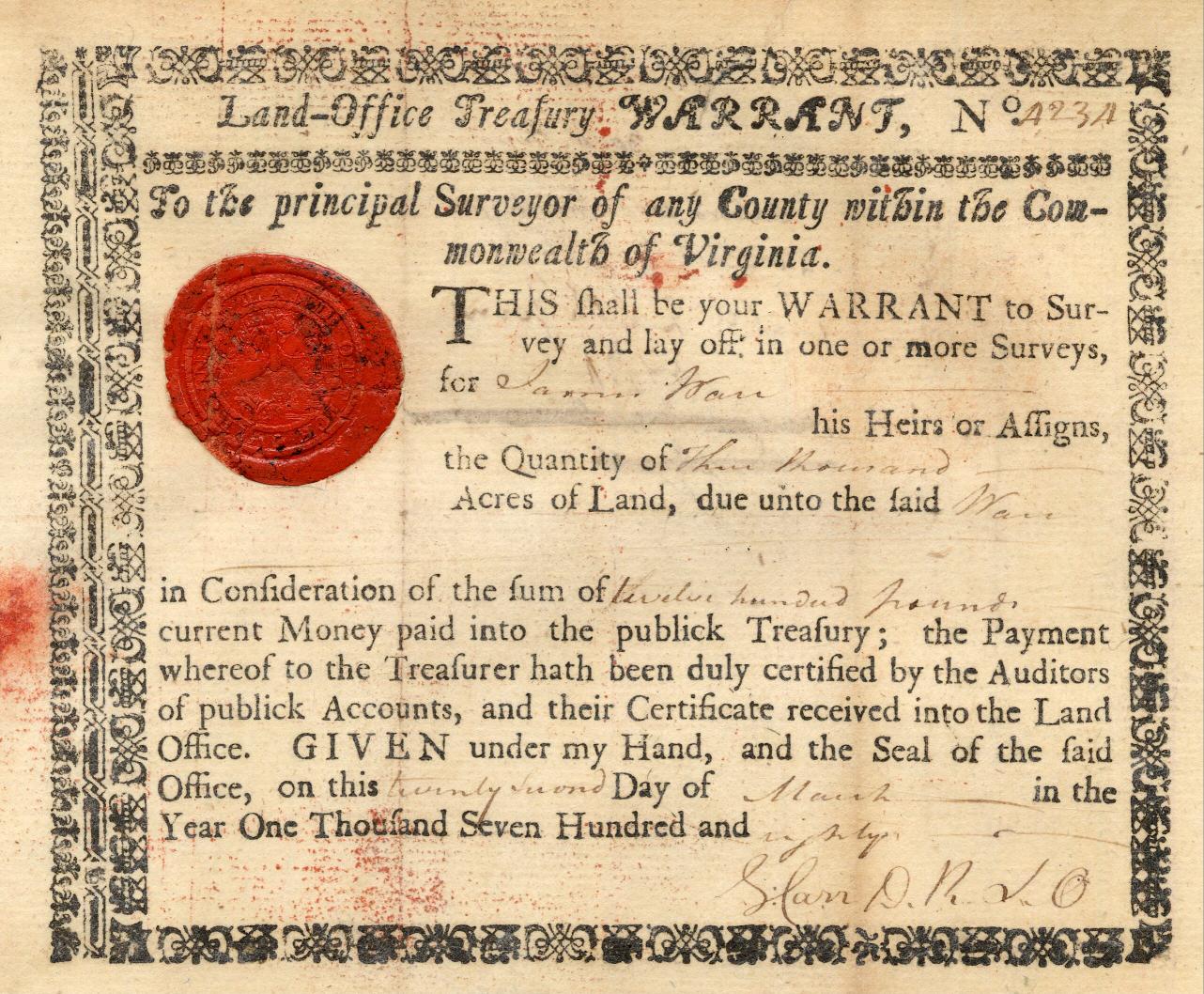 Warrant 4234
Warrant 4234
Entry date written on the back
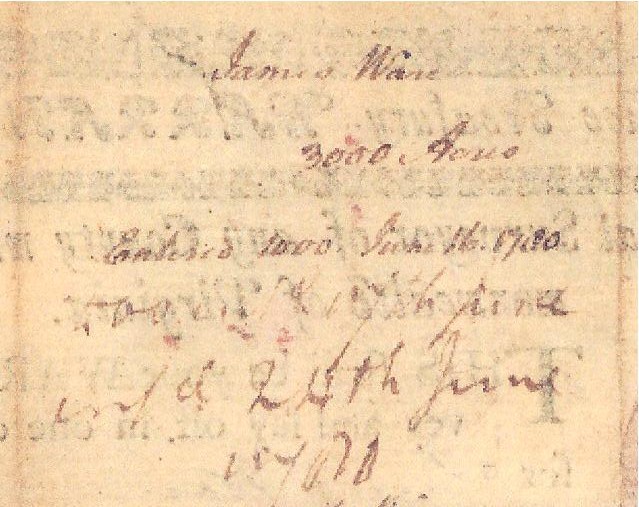 James Ware 3000 acres
Transaction for 1,000 acres on June 16, 1780 –
refiled 24th
June 1780
James Ware 3000 acres
Transaction for 1,000 acres on June 16, 1780 –
refiled 24th
June 1780
Survey below was done for the above land warrant (#4234) –
Interesting note: The transaction for 1000 acres was notated on the original claim and entered on June 16, 1780; then the claim was re-filed on June 24, 1780.
![]()
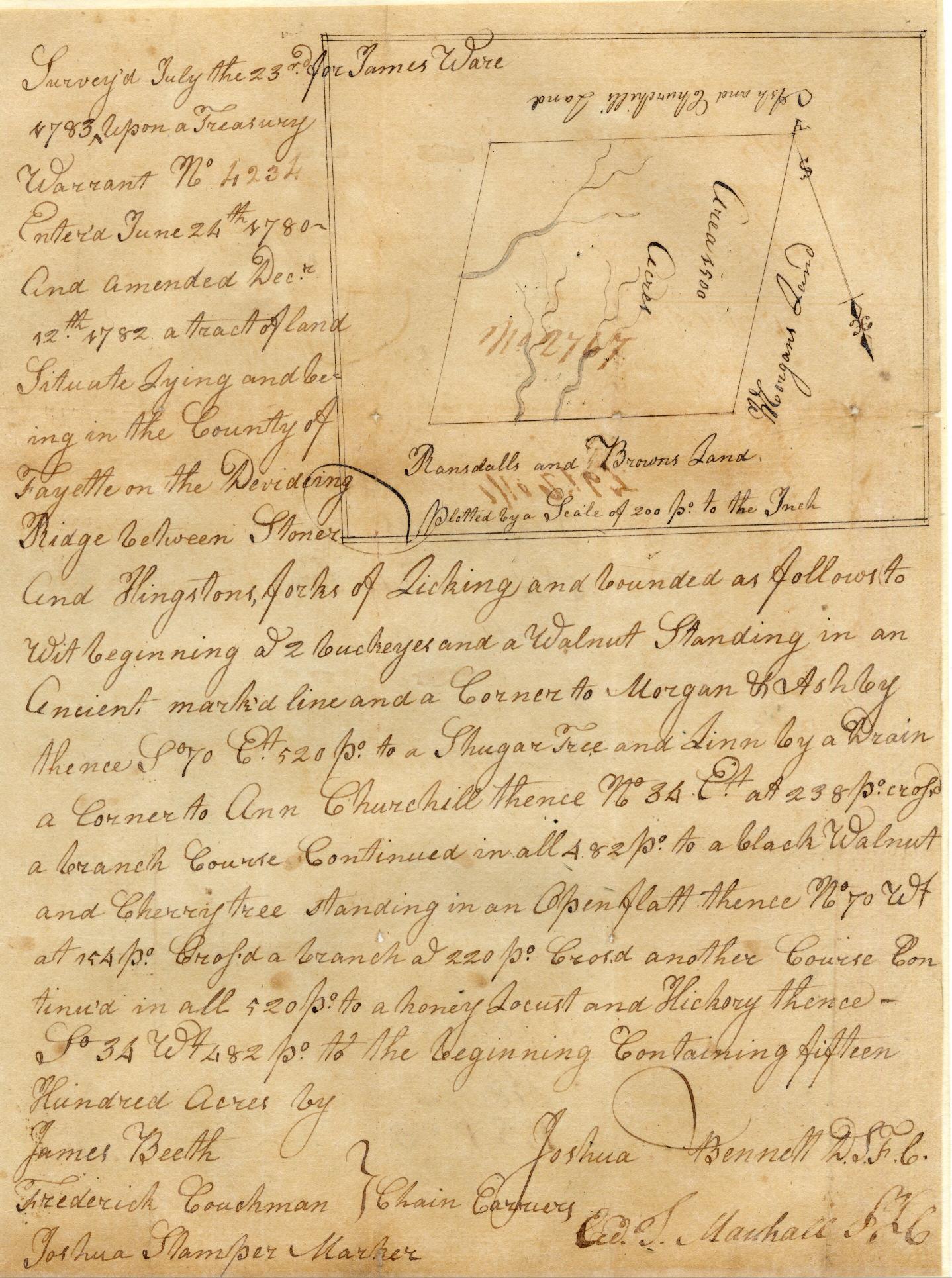
“Surveyed July 23, 1783 for James Ware upon a Treasury Warrant #4234”
Entered June 24, 1780, and amended on December 12, 1782, when the transaction for 1000 acres took place.

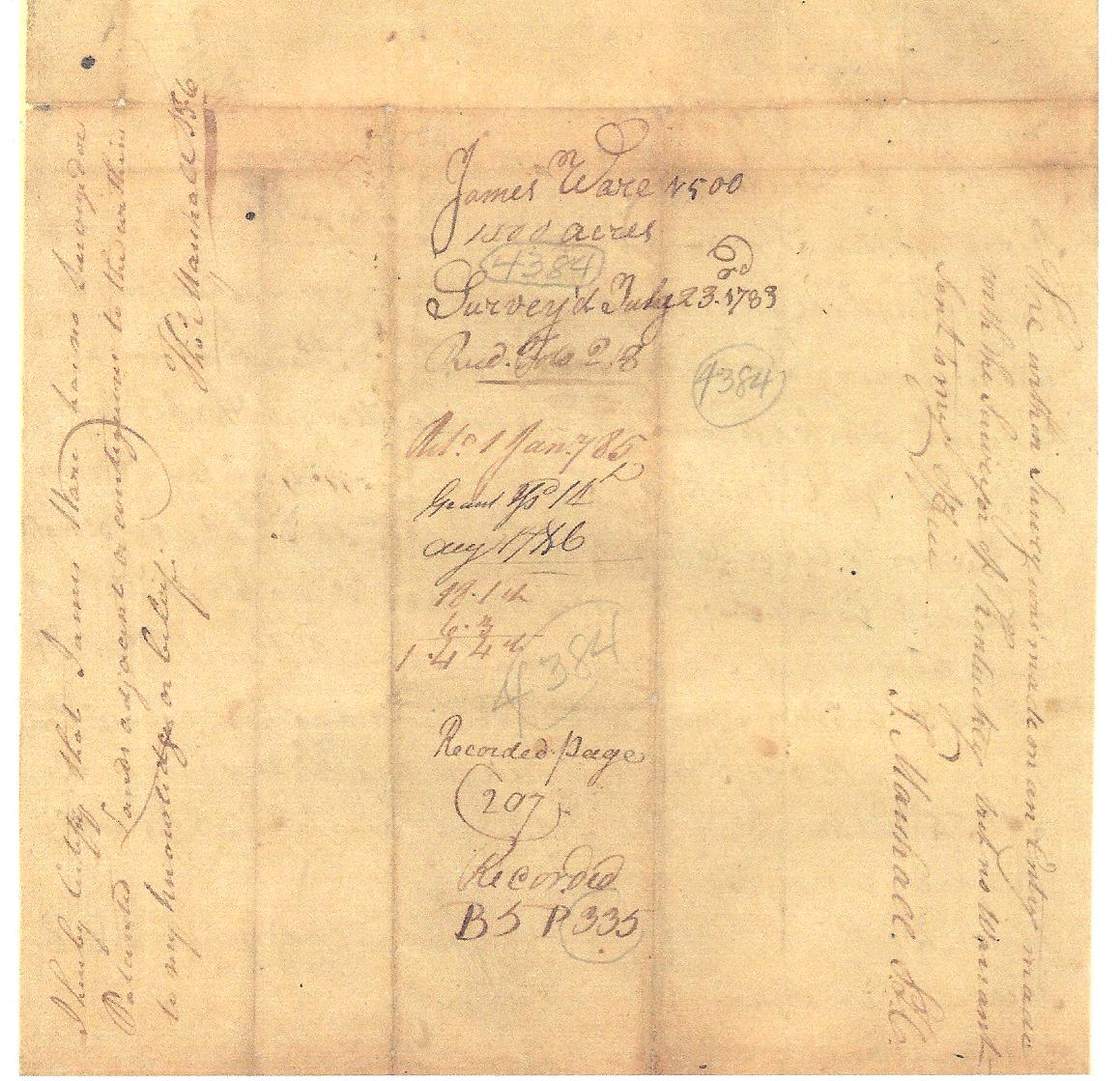 4384
1500 acres
4384
1500 acres
Although only the front part of the above final Warrant #4384 was available for copy, the registration number and survey note tell us that it was for 1500 acres of land, and the survey was done in 1783. Governor Patrick Henry signed the final paperwork.
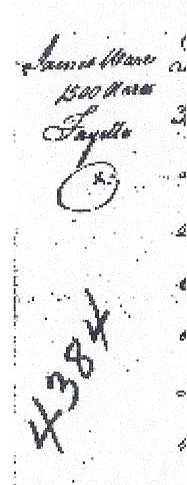
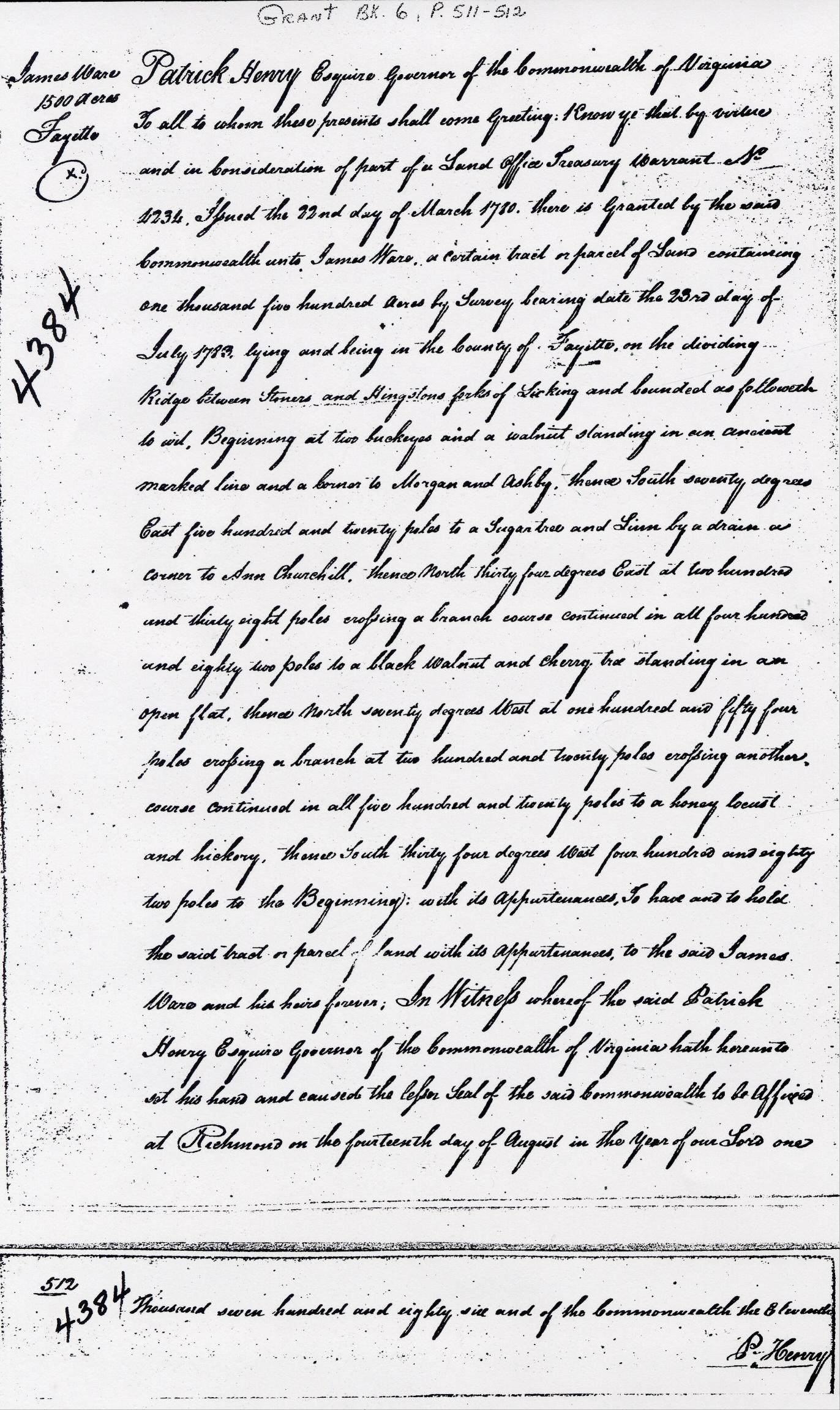
Final paperwork signed by Governor Patrick Henry
Obviously, the final warrant for 1500 acres takes into account the 1000 acres James chose to remove or sell.
It is mentioned in the document that it is “in consideration of part of a Land Office Treasury Warrant No. 4336” – making this now patent #4384.
The following is a transcription of the above document signed by Patrick Henry, giving a wonderful description of the location of the land James Ware purchased and showing the manner in which distances were measured.
![]() “Patrick Henry, Esq., Governor of
the Commonwealth of Virginia, to all to whom these present shall
come, greeting - Know ye that by virtue and in consideration of part
of a Land Office Treasury Warrant No. 4336 offered the 22nd
Day of March, 1780 there is granted by the said Commonwealth unto
James Ware, a certain land or parcel of land, consisting 1,500 acres
by Survey bearing date the 23rd
day of July 1783, lying and being in the County of Fayette on the
dividing Ridge between Stoner’s and Hingston’s Forks of Licking
and bordered as follows – to and beginning at 2 Buckeyes and a
Walnut standing in an ancient marked line and a corner to Morgan and
Ashby, thence South 70 degrees east, 520 poles to a Shugar Tree and
Line by a Drain a Corner to Ann Churchill, thence North 34 degrees
East at 238 poles crossed a branch course - continued in all 482
poles to a black Walnut and Cherry tree standing in an Open Flatt –
thence North 70 degrees West and 154 poles crossed a branch at 220
poles crossed another Course, continued in all 520 poles to a Honey
Locust and Hickory – thence South 34 degrees West to 282 poles to
the Beginning with its appointments to have and to hold the said
tract or parcel of land with its appointments to the said James Ware
and his heirs forever. In witness whereof the said Patrick Henry,
Esquire, Governor of the Commonwealth of Virginia hath hereto set his
hand and attached the Proper Seal of the said Commonwealth of
Virginia to be affixed at Richmond . . . .”
“Patrick Henry, Esq., Governor of
the Commonwealth of Virginia, to all to whom these present shall
come, greeting - Know ye that by virtue and in consideration of part
of a Land Office Treasury Warrant No. 4336 offered the 22nd
Day of March, 1780 there is granted by the said Commonwealth unto
James Ware, a certain land or parcel of land, consisting 1,500 acres
by Survey bearing date the 23rd
day of July 1783, lying and being in the County of Fayette on the
dividing Ridge between Stoner’s and Hingston’s Forks of Licking
and bordered as follows – to and beginning at 2 Buckeyes and a
Walnut standing in an ancient marked line and a corner to Morgan and
Ashby, thence South 70 degrees east, 520 poles to a Shugar Tree and
Line by a Drain a Corner to Ann Churchill, thence North 34 degrees
East at 238 poles crossed a branch course - continued in all 482
poles to a black Walnut and Cherry tree standing in an Open Flatt –
thence North 70 degrees West and 154 poles crossed a branch at 220
poles crossed another Course, continued in all 520 poles to a Honey
Locust and Hickory – thence South 34 degrees West to 282 poles to
the Beginning with its appointments to have and to hold the said
tract or parcel of land with its appointments to the said James Ware
and his heirs forever. In witness whereof the said Patrick Henry,
Esquire, Governor of the Commonwealth of Virginia hath hereto set his
hand and attached the Proper Seal of the said Commonwealth of
Virginia to be affixed at Richmond . . . .”
![]()
We know that as of “August 14, 1786, James owned 1500 acres on the dividing ridge between Stoners and Hingston’s Fork of Licking.” (Ref.948)
![]()
 Record
Record
![]()
Below are maps of Old Kentucky - showing waterways with the rivers associated with the location of James Ware II’s land.
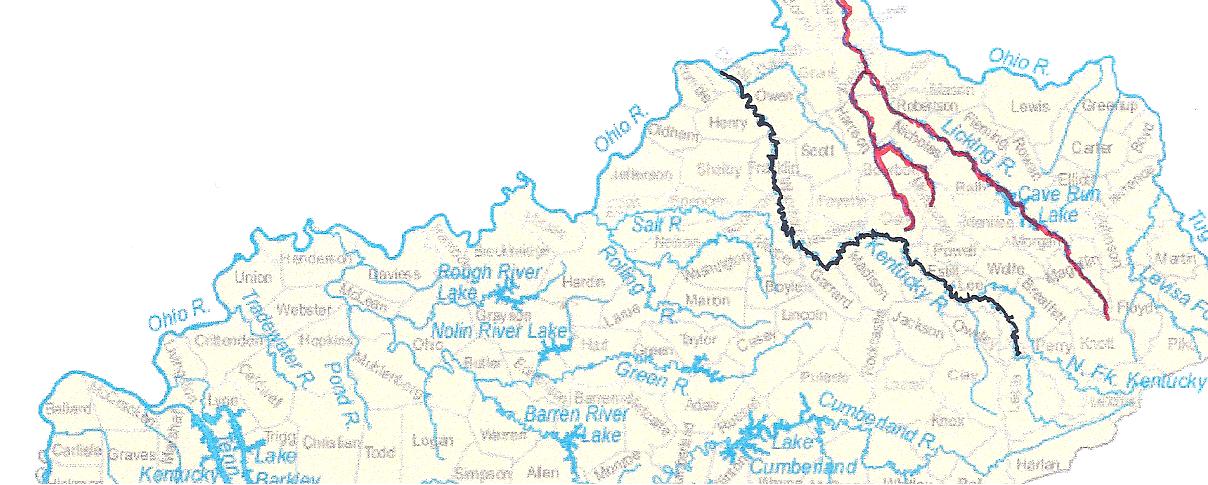
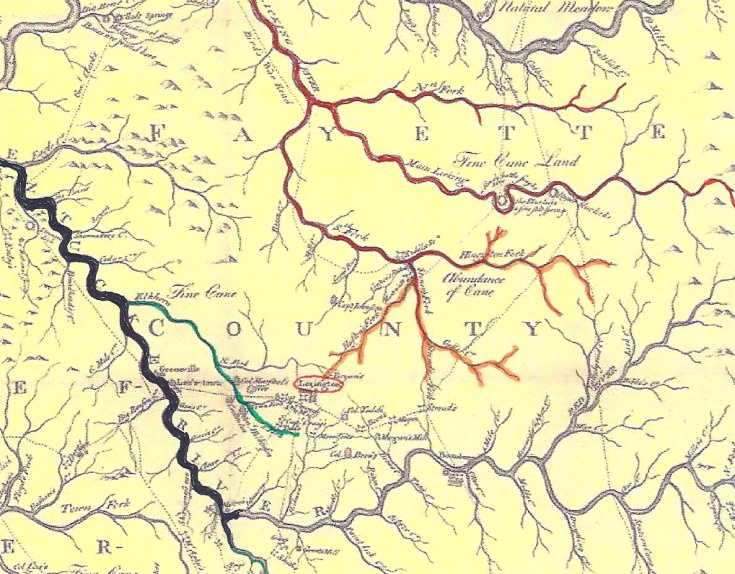 Lexington circled
Lexington circled
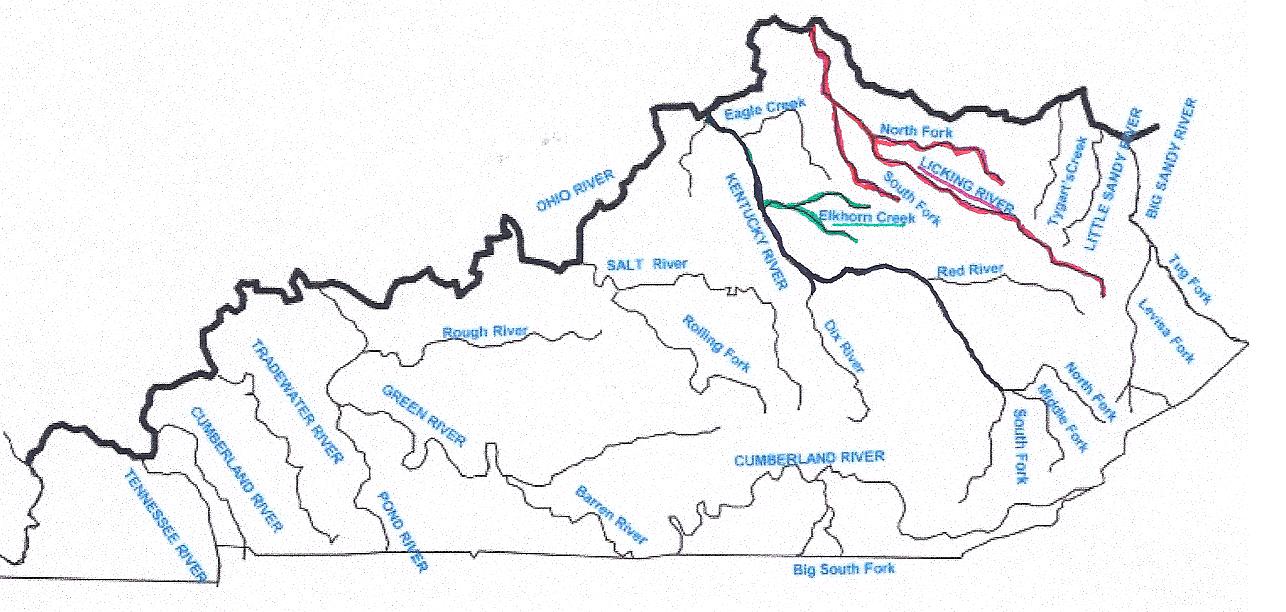
X Forks of Licking River X Kentucky River X Elkhorn Creek
X Hinkston (Hingston) Fork of Licking

Licking River where it joins the Ohio
Dr. Ware and Caty settled in a wonderful location. In his work titled, The American Geography, Jedidiah Morse wrote the following description of the area in 1794:
“Elkhorn river, a branch of the Kentucky, from the south-east, waters a country fine beyond description. Indeed, the country east and south of this, including the head waters of Licking river, Hickman's and Jessamine Creeks, and the remarkable bend in Kentucky river, may be called an extensive garden. The soil is deep and black, and the natural growth, large walnuts, honey and black locust, poplar, elm, oak, hickory, sugar tree, &c. Grape vines run to the tops of the trees; and the surface of the ground is covered with clover, blue grass, and wild rye. On this fertile track, and the Licking River, and the head waters of Salt River, are the bulk of the settlements in this country.”
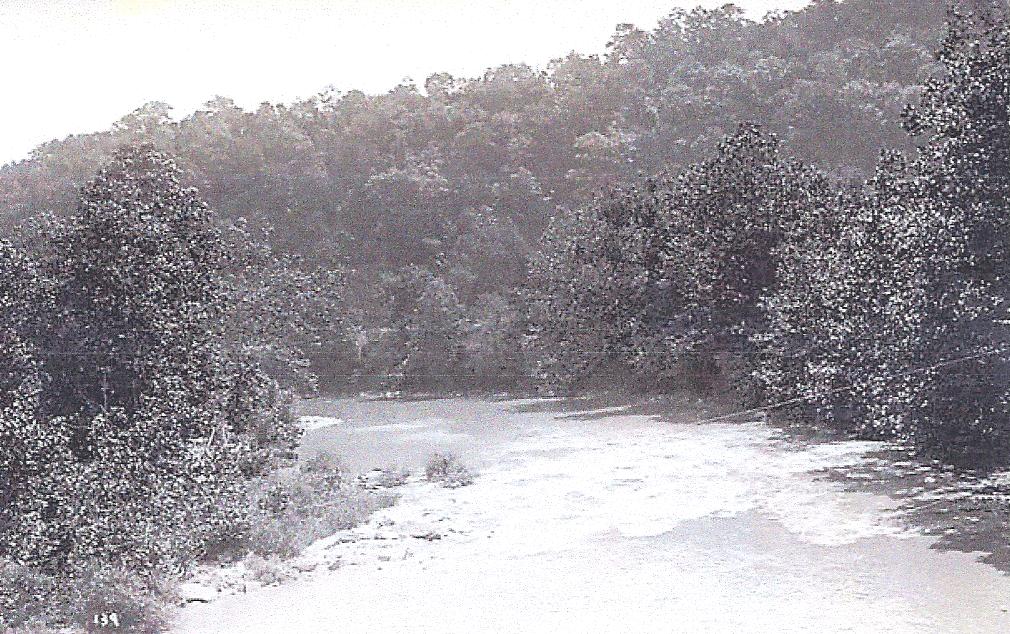
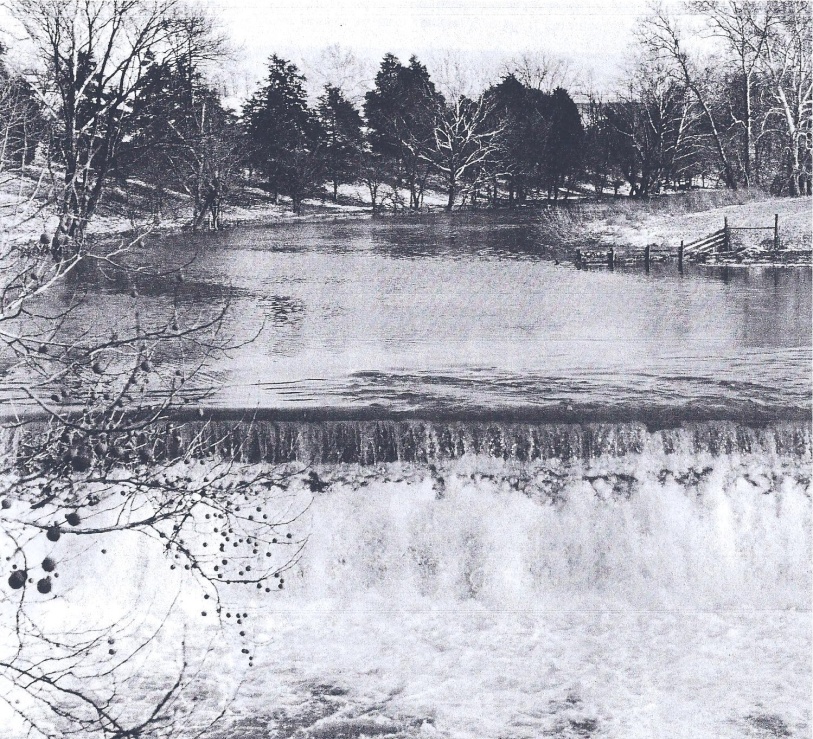 2564
2564
(On left) Elkhorn Creek from suspension footbridge, near Frankfort Used with kind permission of the Kentucky Historical Society
Although the locale was promising, it did not come without risks. As the Kentucky historical site explains, “In the late 1700s, early settlers to Kentucky had to fight for their survival. They came from the east to claim the land and build up settlements out of the wilderness. Life was hard and dangerous. For many, their best hope for survival was in a fort. These forts, and smaller structures called stations, were the beginnings of today’s Kentucky towns.” (Ref. Web)

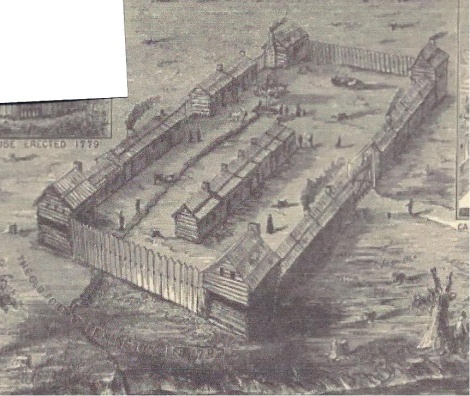 Lexington
Fort (Station)
Lexington
Fort (Station)
The elegant homes that would one day dot the landscape were certainly not in existence when James first came to Kentucky in 1784. “A few of the new arrivals on the frontier were what must be described as members of well-to-do, influential families. Mostly they came west to preempt large tracts of land with warrants issued by Virginia. . . .” (Ref. 2573) Such was the case with Dr. Ware and his family. There were many benefits in moving to Kentucky, but the journey to get there would require that the family give up any comfort, luxury, or safety they had known in Virginia.
As Theodore Roosevelt wrote in 1889, “The settlement of Kentucky was a much more adventurous and hazardous proceeding than had been the case with any previous westward extension of population from the old colonies; because Kentucky, instead of abutting on already settled districts, was an island in the wilderness, separated by two hundred miles of unpeopled and almost impassable forest.” (Ref.867) The Wares traveled through this area for several months before reaching their final destination.
The advance preparations made in earlier years by Dr. Ware’s sons, Thompson and James Ware III, were a huge help for the weary travelers. “Several of the men had been out before, clearing the land and preparing a shelter for them on land near where the city of Lexington now stands.” (Ref. 3) One of these sons later wrote that his father “had, previous to the move, sent out some Negroes and an overseer to make a settlement and clear some ground. . . .” (Ref. 35G, 299) Even with the advance planning, the family still encountered rough surroundings when they finally arrived at their new home. As Cornelia described it, the home the Wares built was “at first a settlement and some cleared land; the line of Fayette and Bourbon counties ran through their house. This was near Lexington.” (Ref. 2) It would be several years before Lexington would come close to resembling the more “civilized” towns they had left behind.
Settlers coming from Virginia into Kentucky used one of two routes. James’ parents, James Sr. and Agnes Todd Ware, had made their migration earlier by way of the “Wilderness Road,” a trail that went through the Cumberland Gap. “A settler’s choice of routes depended partly on where they started, how prosperous they were (the river route being more expensive than the overland route) and other factors. But one critical factor affected all settlers coming into Kentucky - safety in numbers. Settlers tended to make the long trek in large companies, often composed of family and friends from the same neighborhood.” (Ref. Wikipedia) James and Caty chose to travel by flatboat down the Ohio. Their daughter, Polly, would later report “they descended the Ohio in flat boats in momentary apprehension of being attacked by the Indians.” (Ref.602)
![]() The
family had every right to be fearful because shortly before their
move, from 1783 to 1790, there had been “no
less than 1,500 authenticated instances of men,
women and children being killed or captured by the Indians in the
sparsely settled Kentucky.”
(Ref.
904) Even
“as
late as 1793, a party of hunters were pursued by the Indians to
within five miles of Frankfort.”
(Ref.
1026)
The
flatboats, built with green timber and put together with wooden pegs,
were hardly a comfortable way to travel, let alone being safe. (Ref.
903, 904)
The
family had every right to be fearful because shortly before their
move, from 1783 to 1790, there had been “no
less than 1,500 authenticated instances of men,
women and children being killed or captured by the Indians in the
sparsely settled Kentucky.”
(Ref.
904) Even
“as
late as 1793, a party of hunters were pursued by the Indians to
within five miles of Frankfort.”
(Ref.
1026)
The
flatboats, built with green timber and put together with wooden pegs,
were hardly a comfortable way to travel, let alone being safe. (Ref.
903, 904)
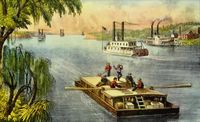 Currier
& Ives
Currier
& Ives
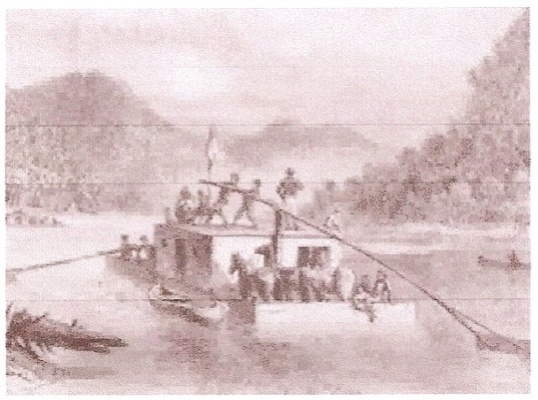
Upon arrival, most new settlers started out with a simple log cabin as their first form of shelter. “Since there were no sawmills or stone cutters in the vicinity, the main source of building material came from the local forests and was assembled with the use of the broad ax and strong arms. The builders dug a square trench two feet deep with dimensions as large as desired. The logs were fastened together with wooden pegs; round logs were halved together at corners and woofed [crossed or enter-twined] with logs or with bark and thatch on poles. This made for a good shelter, especially when the cracks were ‘chinched’ with clay.” (Ref. 960) This was sometimes the only home for years to come.
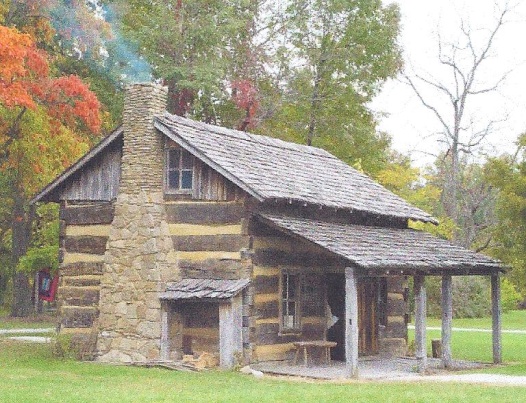
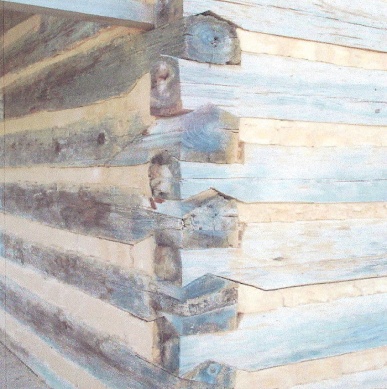 (The
word “chinching” was actually a nautical term. It referred to
the process of pressing
oakum into a seam as a temporary measure until the seam could be
properly caulked.)
(The
word “chinching” was actually a nautical term. It referred to
the process of pressing
oakum into a seam as a temporary measure until the seam could be
properly caulked.)
 We know from a letter,
written in 1812 to James Ware III in Virginia, that Thompson,
grandson of James Ware I, was “still
very slow lived in his old cabin”
even at that date. Thompson eventually built a beautiful home, but
he was among those early settlers who started from scratch. (Ref.740)
We know from a letter,
written in 1812 to James Ware III in Virginia, that Thompson,
grandson of James Ware I, was “still
very slow lived in his old cabin”
even at that date. Thompson eventually built a beautiful home, but
he was among those early settlers who started from scratch. (Ref.740)
It certainly was not long, however, before James and Caty became involved in their new community. According to a 1792 letter, the family “moved to Kentucky in the spring . . . and arrived at their new home on the 16th of June, 1791.” (Ref. 35G, 334, 2247) The History of Pioneer Lexington reports that by December 8, 1792, “James Ware was appointed one of the Justices for Fayette County.” (Ref. 2288)
![]()
 Report
of new appointments made in 1792
Report
of new appointments made in 1792
Dr. Ware and Caty homesteaded on land in Fayette County “that he subsequently lived and died on.” (Ref. 299) The following maps show the location of his property.
Maps
showing location of James Ware land – courtesy of the Kentucky
Historical Society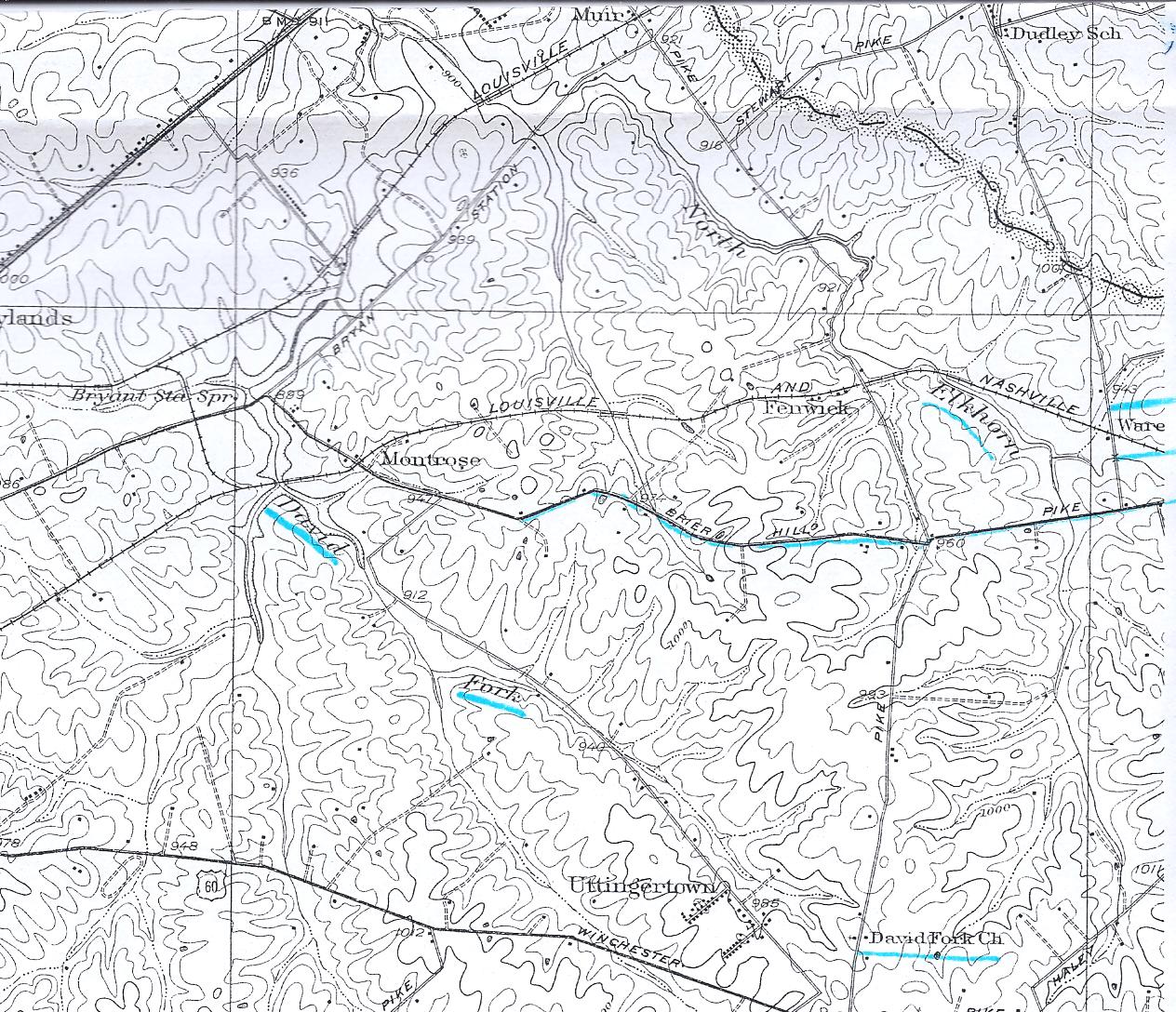
Notice the names of David’s Fork, David’s Fork Church, & Ware
Notice “Ware Crossing” and
David’s Fork
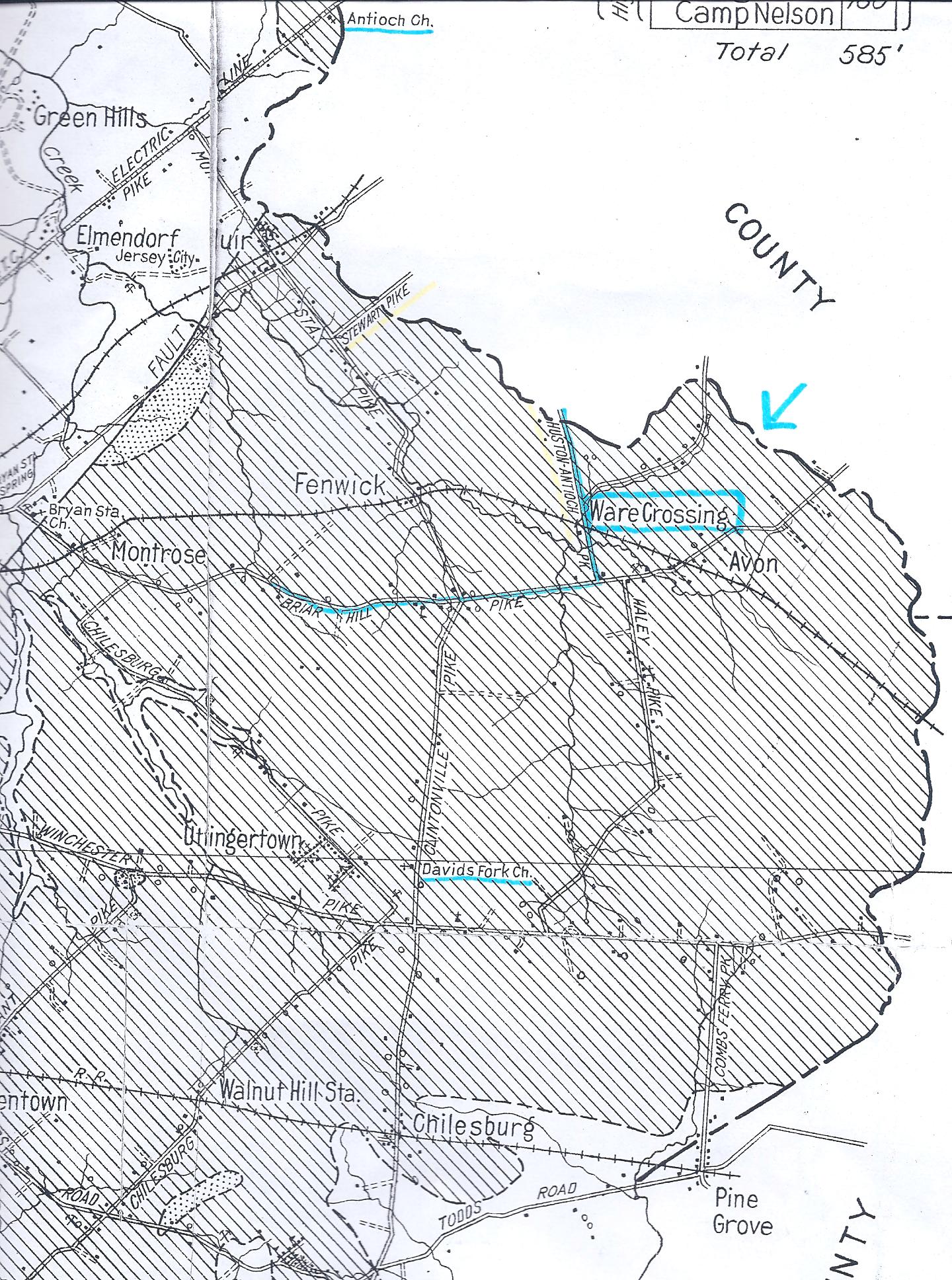
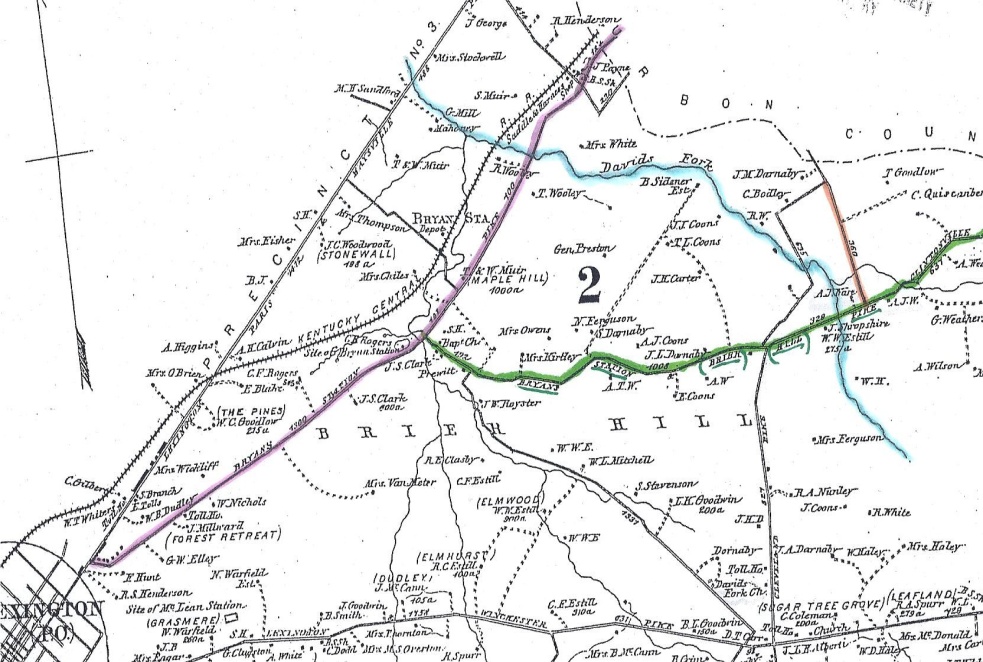
Bryant Station Pike Briar Hill Pike (Rd) Houston and Antioch David’s Fork
W.G. Stannard, a 19th century author, recorded the following information concerning the property of James: “In 1792, Dr. Ware and the Webb families built three homes on the old Ironworks Pike, just east of the Bryan Station Pike. The Dr. James Ware house still stands at the intersection of the Briar Hill Pike and (new) Antioch Pike. (Ref. 939) With time and growth, the names would change. “The road markers in Fayette County, as of 1998, showed that road as the Houston-Antioch Road and a current map shows the name as Antioch Road, most of it is in Bourbon County.” (Ref. 944)
Current Maps (as of 2010) showing location of the property of Dr. James Ware
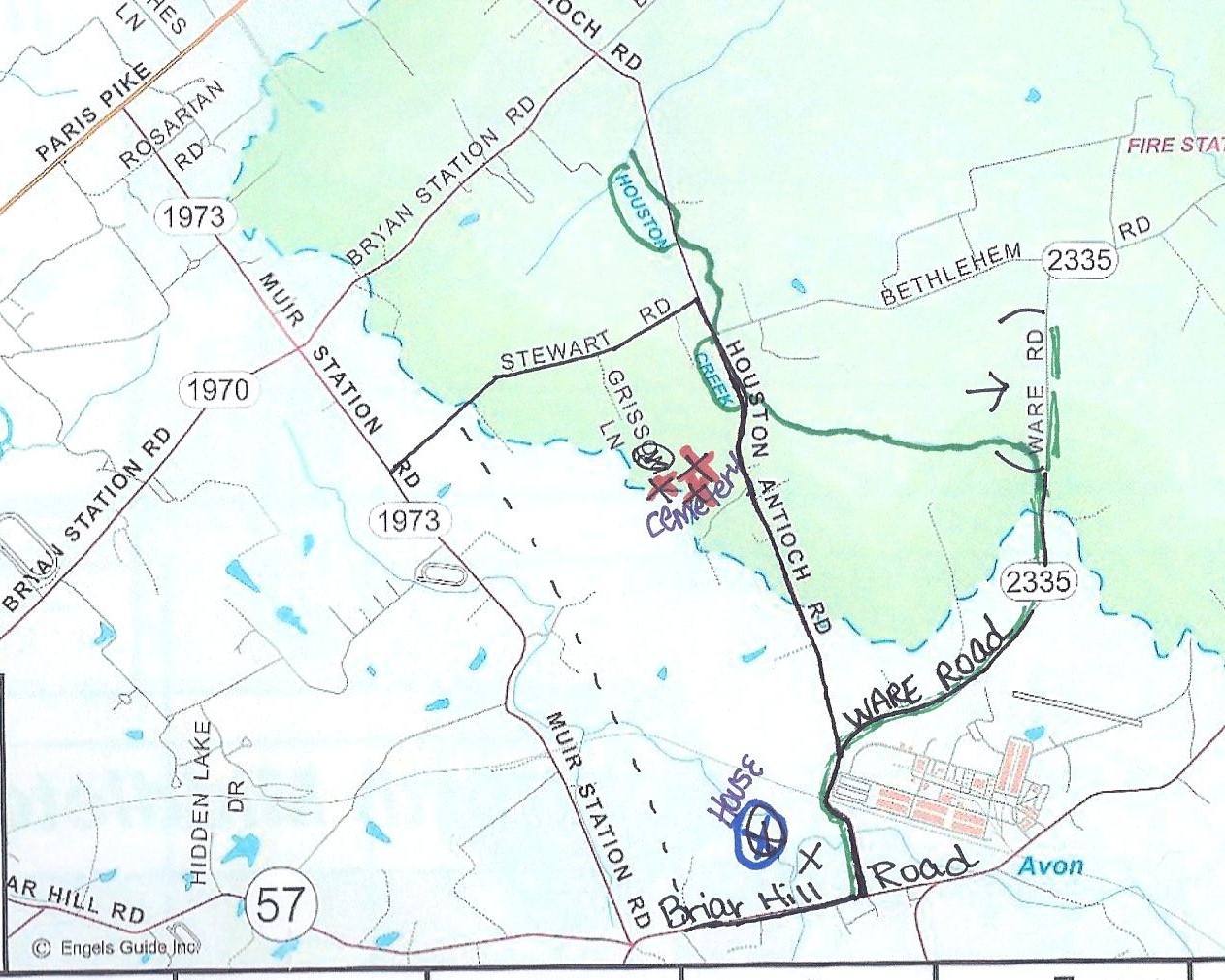
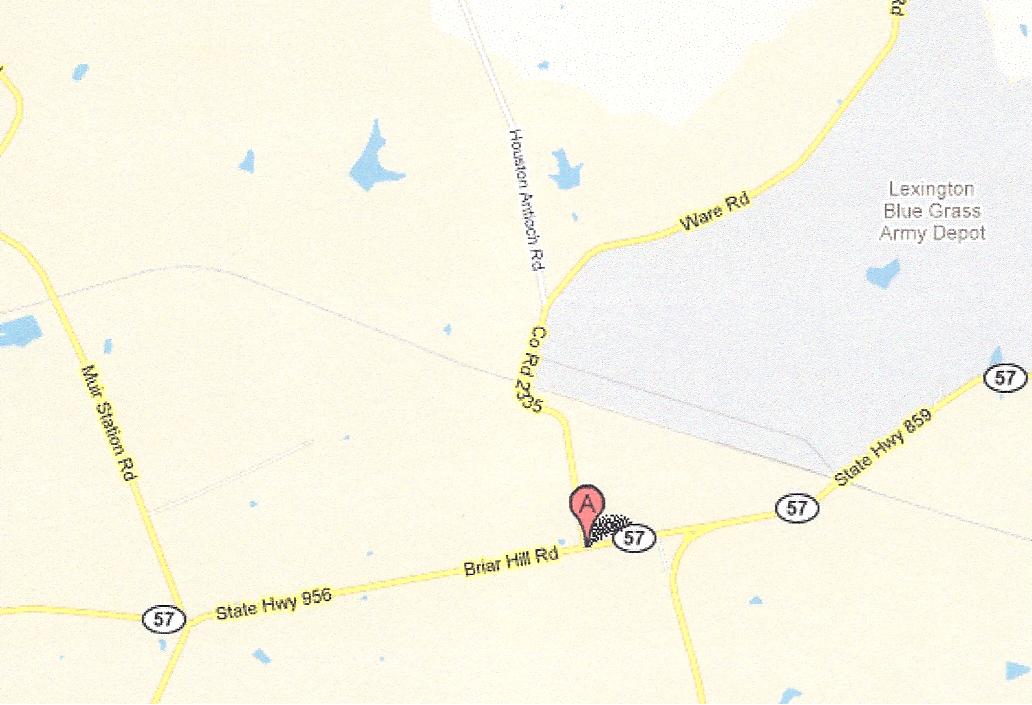
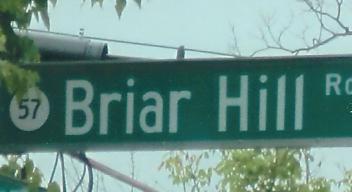
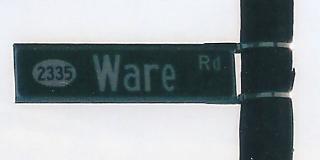 Road
signs near Ware property
– Photos
taken by James and Judy Ware 2010
Road
signs near Ware property
– Photos
taken by James and Judy Ware 2010
Cornelia Anker wrote, “I have been told that the Wares [were] very influential and wealthy in Kentucky.”(Ref. 2) She was informed correctly. A large part of the success of the family came as a result of owning good property. Water was an essential attribute, but the soil and topography of the land also contributed to its richness. “Geographically, the location of Lexington was fortunate in that the town became the transportation hub of the state. Nearly all the early Kentucky trails and roads passed through or near this settlement. Commerce going to and from the surrounding settlements, except that which went by river, passed through Lexington. Not only was Lexington the highway focus of the state but it likewise became commercially the ‘queen city’ of the West, a position it maintained until 1818 when Louisville, as a river town, began effectively to drain it of its commercial resources.” (Ref. 2254)
Lexington was, indeed, a good place to settle, but several of James and Caty’s offspring put down their new roots in different sections of Kentucky; properties equally as favorable and still relatively close by. All of their children, with the exception of James III who returned to Virginia, would make Kentucky their final home.
The following pages provide details on the children of James and Caty Todd Ware: (1.) Thompson, (2.) James III, (3.) Mary Todd (Polly) (4.) Lucy Catherine, (5.) Charles, (6.) Catherine, and (7.) George.
1. Thompson Ware - In hindsight, it seems ironic that the first child of James and Caty (Thompson) was born the same year that Daniel Boone began exploring Kentucky - the eventual final resting place for so many of the Ware family. As a child, Thompson was raised and educated in Virginia with his younger brother James III. (Ref 35E) He visited Kentucky when he was about 20 years old, and it was there he met and married his wife, Sallie Conn. “He settled near Paris, which later became the county seat for Bourbon County.” (Ref. 299, 845) As his nephew, Josiah Ware, once said, “Thompson Ware went to Kentucky as an Indian fighter when Cincinnati was just two or three cabins and some stumps.” (Ref. #299)
Thompson and Sallie were married in 1799; he was 30 years old and she was 18. (Ref. 1070, 2112, 2113) They flourished in Bourbon County and had a very large family. As he wrote in a letter to his niece back in Virginia, “we have had twelve children – eleven living and eight of them daughters. Our youngest is a son; one year old. Our families are all in Kentucky, except yours [referring to James], where we can at least see one another once or twice a year. And your Aunt Polly Webb lives within a mile, where we can see each other every week.” (Ref. 35E)
The following data pertains to the 12 children of Thompson and Sallie (grandchildren of James and Caty and great grandchildren of James and Agnes.) For a more in-depth history, please refer to Virginia Roots in Kentucky Soil, the sequel to this book.
![]() Catherine Todd Ware
– Catherine,
better known as Kitty, was obviously named for her grandmother, Caty
Todd. Born in 1799, she married Grant Allen on October 24, 1830,
when she was 31 years old. (Ref.
967, 1074)
“He
had previously been married to Kitty’s younger sister, but
tragically, Polly died very suddenly after the birth of their first
child.” (Ref.
2350) As
her Aunt Lucy wrote in a letter dated in 1830, “Kitty
takes care of the baby as if it were her own.”
(Ref.
597) Grant
and Kitty eventually moved to Missouri, where Kitty died of
consumption in 1863 at almost 64 years of age. (Ref.
691, 1070)
Catherine Todd Ware
– Catherine,
better known as Kitty, was obviously named for her grandmother, Caty
Todd. Born in 1799, she married Grant Allen on October 24, 1830,
when she was 31 years old. (Ref.
967, 1074)
“He
had previously been married to Kitty’s younger sister, but
tragically, Polly died very suddenly after the birth of their first
child.” (Ref.
2350) As
her Aunt Lucy wrote in a letter dated in 1830, “Kitty
takes care of the baby as if it were her own.”
(Ref.
597) Grant
and Kitty eventually moved to Missouri, where Kitty died of
consumption in 1863 at almost 64 years of age. (Ref.
691, 1070)
![]() Thomas Ware
- Sallie
delivered a son in 1801. Thomas wed Harriet Miller in 1823 at the
age of 22. He “began
as a merchant in 1824 . . . and continued for 10 years.”
(Ref.
2114)
During the Civil War, on July 17, 1862, Thomas “was
killed in a fight at Cynthiana against the attack of John H.
Morgan’s men and in defense of his government.”
(Ref.
1070)
According
to the
personal war record of General Richard Montgomery Gano, Thomas’
cousin, “Several
Confederate soldiers hid behind some cars close to the depot and
were fired at by the men in the second story window of the depot.
The Confederates fired up at the men in the windows and a ball hit
Thomas Ware, fracturing his jaw and going up through his brain and
out the top of his head, which killed him. Ware was carried up to
his home and laid out in the parlor. Gano went up to his residence
and saw his wife and four daughters. He told them how much he
regretted that his cousin had been killed.”
(Ref.
2276)
Thomas was 61 years old at the time of his death.
Thomas Ware
- Sallie
delivered a son in 1801. Thomas wed Harriet Miller in 1823 at the
age of 22. He “began
as a merchant in 1824 . . . and continued for 10 years.”
(Ref.
2114)
During the Civil War, on July 17, 1862, Thomas “was
killed in a fight at Cynthiana against the attack of John H.
Morgan’s men and in defense of his government.”
(Ref.
1070)
According
to the
personal war record of General Richard Montgomery Gano, Thomas’
cousin, “Several
Confederate soldiers hid behind some cars close to the depot and
were fired at by the men in the second story window of the depot.
The Confederates fired up at the men in the windows and a ball hit
Thomas Ware, fracturing his jaw and going up through his brain and
out the top of his head, which killed him. Ware was carried up to
his home and laid out in the parlor. Gano went up to his residence
and saw his wife and four daughters. He told them how much he
regretted that his cousin had been killed.”
(Ref.
2276)
Thomas was 61 years old at the time of his death.
![]() Cassandra
Ware
– Born
in the winter of 1803, Cassandra was at the rather advanced age of
34 before she wed Samuel Woodson on November 8, 1837. (Ref.
597,967, 1070)
“For
the most part, couples married young. Life expectancy was short and
adulthood came at an earlier age than today. A boy was considered a
man at the age of 16. Any girl not married by the age of twenty was
considered an old maid.”
(Ref.
2116) It
is of interest, however, that even though young people were expected
to enter matrimony early in life, “whenever
and wherever in 18th century Virginia there was a legal requirement
that a person be of age (that is an adult) he or she must have
reached his 21st
birthday . . . . If either of the parties to be married was not of
age, the consent of a parent or guardian was necessary.” (Ref.
Web ) Samuel
Woodson had previously been married to Nancy H. Allen, but she died
in 1833. He and Cassandra were married for 14 years before
Cassandra died June 20, 1851, at the age of 48. (Ref.
1070, 2112)
Cassandra
Ware
– Born
in the winter of 1803, Cassandra was at the rather advanced age of
34 before she wed Samuel Woodson on November 8, 1837. (Ref.
597,967, 1070)
“For
the most part, couples married young. Life expectancy was short and
adulthood came at an earlier age than today. A boy was considered a
man at the age of 16. Any girl not married by the age of twenty was
considered an old maid.”
(Ref.
2116) It
is of interest, however, that even though young people were expected
to enter matrimony early in life, “whenever
and wherever in 18th century Virginia there was a legal requirement
that a person be of age (that is an adult) he or she must have
reached his 21st
birthday . . . . If either of the parties to be married was not of
age, the consent of a parent or guardian was necessary.” (Ref.
Web ) Samuel
Woodson had previously been married to Nancy H. Allen, but she died
in 1833. He and Cassandra were married for 14 years before
Cassandra died June 20, 1851, at the age of 48. (Ref.
1070, 2112)
![]() Sarah Ware
– Sally,
as she was usually called, was born to the Wares in 1806. She
married Robert Spotswood Russell on May 29, 1827. In a letter
written to relatives back in Virginia, her Aunt Lucy described an
incredibly difficult time Sally went though after the birth of her
first baby:
Sarah Ware
– Sally,
as she was usually called, was born to the Wares in 1806. She
married Robert Spotswood Russell on May 29, 1827. In a letter
written to relatives back in Virginia, her Aunt Lucy described an
incredibly difficult time Sally went though after the birth of her
first baby:
“Your Uncle Thompson Ware’s daughter, Sally, has been as ill as ever any person was, to recover. She had a son and in three weeks, was taken ill with child-bed-fever. When her life was despaired of by her physician, Dr. Innes, (and every person that beheld her) they sent for Dr. Scott. They kept him three days there. Your Aunt Webb went from her last week. . . . When the doctor came, she said it really appeared like raising the dead. Sally was taken with strong convulsion fits in an hour after he got here – which lasted nearly two days; one after another. But before he came away, she began to mend slowly and has been mending ever since. She can now walk about the yard but not entirely come to her reason.” (Ref. 597) Sally did recover -- she did not die until 1884 at the age of 78.
![]() Mary
Ware
- Thompson’s
wife gave birth to another girl in 1808. They named her Mary, but
just like Thompson’s sister, Mary Todd Webb, she quickly assumed
the nickname of Polly.
“At
the age of 20, she married Grant Allen in December 1827. Sadly,
Polly also had a difficult time with pregnancy; her experience
ultimately resulting in her death on November 23, 1828.”
(Ref.
2350)
Lucy wrote about this news as well: “I
suppose you heard his [Thompson’s]
daughter, Polly Allen, died very suddenly. Her child was about 3 or
4 weeks old. She had been quite sick for two weeks, but Mary
thought had gotten nearly well. Polly got up in the morning, put on
her clothes, walked to the fire, fell sick, was carried to the bed,
and died in a few minutes.” (Ref.
597)
Mary
Ware
- Thompson’s
wife gave birth to another girl in 1808. They named her Mary, but
just like Thompson’s sister, Mary Todd Webb, she quickly assumed
the nickname of Polly.
“At
the age of 20, she married Grant Allen in December 1827. Sadly,
Polly also had a difficult time with pregnancy; her experience
ultimately resulting in her death on November 23, 1828.”
(Ref.
2350)
Lucy wrote about this news as well: “I
suppose you heard his [Thompson’s]
daughter, Polly Allen, died very suddenly. Her child was about 3 or
4 weeks old. She had been quite sick for two weeks, but Mary
thought had gotten nearly well. Polly got up in the morning, put on
her clothes, walked to the fire, fell sick, was carried to the bed,
and died in a few minutes.” (Ref.
597)
The baby Polly delivered was the infant that her sister, Kitty, subsequently raised. “Childbed fever, also known as septic poisoning, was most likely the result of unsanitary conditions at the time of delivery. It also occurred when the mother was sometimes unable to expel the entire placenta. The afterbirth would soon become septic, resulting in death. This illness would claim the lives of many young mothers before medical science became advanced enough to understand its cause and cure.” (Ref. 2350)
![]() Lucy
Caroline Ware
– Lucy
Caroline was born in 1810.
She
married Henry Clay Bedford, a second cousin of Henry Clay, the
statesman, on September 13, 1829. (Ref.
950, 1070, 1099)
As her Aunt Lucy wrote, “Lucy
Ware, another of your Uncle Thompson Ware’s daughters, has married
Mr. Bedford. He married two of Mr. Blanton’s daughters – both
of them died in childbed; I have no doubt of want of skill in their
physicians. He then married Miss Hutchcraft; she had two children
and died when the youngest was 6 months old. He then
married Lucy Ware. I should have disliked being any man’s fourth
wife, but he is a very clever man, not more than 26 years old, made
an excellent husband and is quite independent. I hope she will do
well.”
(Ref. 782,
967,968)
Lucy and
Henry celebrated almost 30 years of marriage before Henry Clay
Bedford died in 1858.
Lucy
Caroline Ware
– Lucy
Caroline was born in 1810.
She
married Henry Clay Bedford, a second cousin of Henry Clay, the
statesman, on September 13, 1829. (Ref.
950, 1070, 1099)
As her Aunt Lucy wrote, “Lucy
Ware, another of your Uncle Thompson Ware’s daughters, has married
Mr. Bedford. He married two of Mr. Blanton’s daughters – both
of them died in childbed; I have no doubt of want of skill in their
physicians. He then married Miss Hutchcraft; she had two children
and died when the youngest was 6 months old. He then
married Lucy Ware. I should have disliked being any man’s fourth
wife, but he is a very clever man, not more than 26 years old, made
an excellent husband and is quite independent. I hope she will do
well.”
(Ref. 782,
967,968)
Lucy and
Henry celebrated almost 30 years of marriage before Henry Clay
Bedford died in 1858.
![]() Davidella Ware
– Born
on February 18, 1812, Davidella (at age 17) became a member of Old
Union Christian Church on January 11, 1829. In 1834, she became the
wife of Asa Kentucky Lewis Bedford, and after their marriage, she
“took
letter”
to transfer to another church on February 8, 1851. (Ref.
950, 1070, 2112, 2118) Asa
was
described as
“a man of courage and convictions, with an amiable and strong
force of a character; highly esteemed by his neighbors.”
(Ref. 966,
2119)
Davidella and Asa provided many grandchildren for Thompson and
Sallie: (1) Mary Frances, (2) Thompson Ware, (3) James Henry, (4)
Asa K. Lewis, (5) Charles Coleman, (6) Sallie, and (7) Louisa
(called Lucy.) (Ref.
782)
Before her death, Davidella operated a boarding
house in
Jefferson County, Kentucky. She passed away on June 22, 1877, at
the age of 65. (Ref.
630, 782, 2118, 2120)
Davidella Ware
– Born
on February 18, 1812, Davidella (at age 17) became a member of Old
Union Christian Church on January 11, 1829. In 1834, she became the
wife of Asa Kentucky Lewis Bedford, and after their marriage, she
“took
letter”
to transfer to another church on February 8, 1851. (Ref.
950, 1070, 2112, 2118) Asa
was
described as
“a man of courage and convictions, with an amiable and strong
force of a character; highly esteemed by his neighbors.”
(Ref. 966,
2119)
Davidella and Asa provided many grandchildren for Thompson and
Sallie: (1) Mary Frances, (2) Thompson Ware, (3) James Henry, (4)
Asa K. Lewis, (5) Charles Coleman, (6) Sallie, and (7) Louisa
(called Lucy.) (Ref.
782)
Before her death, Davidella operated a boarding
house in
Jefferson County, Kentucky. She passed away on June 22, 1877, at
the age of 65. (Ref.
630, 782, 2118, 2120)
![]()
![]() Just
recently, a descendant of Davidella and Asa Bedford contacted me and
provided some wonderful new information about this side of the
family. I would like to express my deep gratitude to John
and Judy McGee of Southeast Texas for sharing these treasures.
Their line comes down from the eldest son, Thompson Ware Bedford,
and all the following photographs were kindly and generously shared
by them.
Just
recently, a descendant of Davidella and Asa Bedford contacted me and
provided some wonderful new information about this side of the
family. I would like to express my deep gratitude to John
and Judy McGee of Southeast Texas for sharing these treasures.
Their line comes down from the eldest son, Thompson Ware Bedford,
and all the following photographs were kindly and generously shared
by them.
![]() Davidella
gave
birth to Thompson Ware Bedford
on November 27, 1836 - obviously naming him after her father.
Thompson “graduated
from the medical department of the University of Louisville in
March, 1861; began the practice of medicine in Washington Co., in
April 1861,”
and devoted his whole life to his profession of healing. (Ref.
Hayes Library) He
married Mildred Houtchens in October, 1860. They had the
following children who lived to adulthood: Samuel Wibel Bedford,
Ella Stuart Bedford, Willis H. Knox Bedford, Harriet (Hattie)
Orian Bedford, and Henry Ware Bedford.
Davidella
gave
birth to Thompson Ware Bedford
on November 27, 1836 - obviously naming him after her father.
Thompson “graduated
from the medical department of the University of Louisville in
March, 1861; began the practice of medicine in Washington Co., in
April 1861,”
and devoted his whole life to his profession of healing. (Ref.
Hayes Library) He
married Mildred Houtchens in October, 1860. They had the
following children who lived to adulthood: Samuel Wibel Bedford,
Ella Stuart Bedford, Willis H. Knox Bedford, Harriet (Hattie)
Orian Bedford, and Henry Ware Bedford.


Susan Mildred Houtchens Bedford –
wife of Dr. Thompson Ware Bedford
Photo courtesy of John and Judy McGee of Southeast Texas.
Dr. Thompson Ware Bedford died in 1909 and Mildred passed away in 1915. Judy McGee, the descendent (by marriage) of Thompson and Mildred, shared a wonderful story with me about the Bedford’s daughter, Ella. The family still owns a heart-shaped locket that belonged to Ella with her initials “ESB” engraved on it. Judy “wore it in her wedding per John's request and both her daughters
and daughter-in-law wore it in their weddings.” What a cherished heirloom!
Below are some of the children of Thompson and Mildred Bedford – making them grandchildren of Davidella Ware and Asa Bedford, great grandchildren of Thompson and Sallie Ware, and great great grandchildren of James and Caty Todd Ware.



Samuel Wible Bedford Ella Stuart Bedford McGee Willis H. Knox Bedford
Photos courtesy of John and Judy McGee of Southeast Texas.
Another one of Davidella and Asa’s children, Dr. James Henry Ware, had the children seen below.

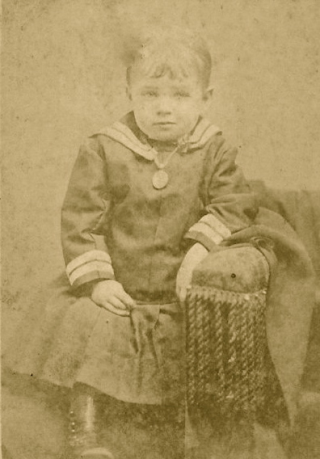
Hill B. Bedford Floy Bedford
Photos courtesy of John and Judy McGee of Southeast Texas
![]() James Thompson Ware
-
Born on
December 23, 1814, James married Patsy Bedford (sister
of Henry Clay Bedford and Asa Kentucky Lewis Bedford)
in 1844.
(Ref.
1070, 2118)
All
three Bedford siblings were second cousins of Henry Clay. The
1850 Federal Census of Bourbon County stated that “James
T. and wife, Patsy, are living with James’ mother and father,
Sallie Conn and (Colonel) Thompson Ware.”
The land they were residing on “was
originally part of Thomas Conn’s tract that Sallie Ware had
inherited from her father.”
(Ref.
2122) At
the time of this census,
James was 35, Patsy was 25, and they had three very small children
of their own: a son named Thompson
and
two daughters, Sallie
and Lucy.
(Ref. 2123) It
was also in 1850 that “James
T. Ware joined the Church of Christ at Old Union by confession of
faith and baptism.”
(Ref.
2112, 2118, 2124)
Patsy had already been a member of the church before she married
James, having “joined
by confession on July 10, 1842.”
(Ref.
2124) The
young couple eventually had three more children: Mary
(1852),
Henry
Bedford
(1853), and James
Thomas
(1858).
James
Thompson Ware
and Patsy eventually inherited the family home of Thompson and
Sallie, which was called ‘Rose Hill’ at the time. (Ref.
740, 2290)
James died on September 30, 1871. (Ref.
964)
James Thompson Ware
-
Born on
December 23, 1814, James married Patsy Bedford (sister
of Henry Clay Bedford and Asa Kentucky Lewis Bedford)
in 1844.
(Ref.
1070, 2118)
All
three Bedford siblings were second cousins of Henry Clay. The
1850 Federal Census of Bourbon County stated that “James
T. and wife, Patsy, are living with James’ mother and father,
Sallie Conn and (Colonel) Thompson Ware.”
The land they were residing on “was
originally part of Thomas Conn’s tract that Sallie Ware had
inherited from her father.”
(Ref.
2122) At
the time of this census,
James was 35, Patsy was 25, and they had three very small children
of their own: a son named Thompson
and
two daughters, Sallie
and Lucy.
(Ref. 2123) It
was also in 1850 that “James
T. Ware joined the Church of Christ at Old Union by confession of
faith and baptism.”
(Ref.
2112, 2118, 2124)
Patsy had already been a member of the church before she married
James, having “joined
by confession on July 10, 1842.”
(Ref.
2124) The
young couple eventually had three more children: Mary
(1852),
Henry
Bedford
(1853), and James
Thomas
(1858).
James
Thompson Ware
and Patsy eventually inherited the family home of Thompson and
Sallie, which was called ‘Rose Hill’ at the time. (Ref.
740, 2290)
James died on September 30, 1871. (Ref.
964)
The oldest son
of
![]() James
and Patsy, Thompson,
was born September 16, 1845. He married Alice Edwards in November
1871, and they provided three great
grandchildren for the senior Wares: James
Thompson
(1873-1930), Edward
(1875),
and Patty
(1879), who married Leonard Cook. Thompson
died in 1899 of heart disease at age 54. Alice lived to be 91,
dying May 19, 1945.
James
and Patsy, Thompson,
was born September 16, 1845. He married Alice Edwards in November
1871, and they provided three great
grandchildren for the senior Wares: James
Thompson
(1873-1930), Edward
(1875),
and Patty
(1879), who married Leonard Cook. Thompson
died in 1899 of heart disease at age 54. Alice lived to be 91,
dying May 19, 1945.
James
Thompson Ware
(son of Thompson and Alice and grandson of
![]() James
and Patsy) married Pearl
Craig. He died (age 57) on September 15, 1930, in Cynthiana,
Kentucky.
James
and Patsy) married Pearl
Craig. He died (age 57) on September 15, 1930, in Cynthiana,
Kentucky.
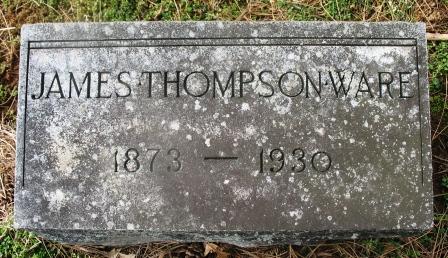
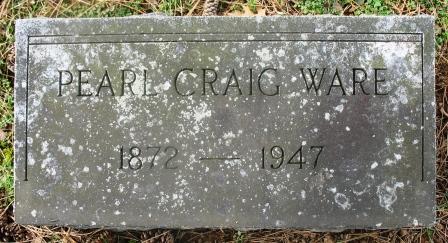 Graves for James and
Pearl
Graves for James and
Pearl
The youngest son
of
![]() James
and Patsy Ware was James
Thomas Ware
– born in 1858. James married twice: Emma Macey
was his first
wife and Cora Richmond his
second. James had a career as a veterinarian in Kansas City,
Missouri. Sadly, he also died of a heart attack at a young age.
(See
death certificate in supporting documents.)
He passed away on March 22, 1921, just shy of his 63rd
birthday.
James
and Patsy Ware was James
Thomas Ware
– born in 1858. James married twice: Emma Macey
was his first
wife and Cora Richmond his
second. James had a career as a veterinarian in Kansas City,
Missouri. Sadly, he also died of a heart attack at a young age.
(See
death certificate in supporting documents.)
He passed away on March 22, 1921, just shy of his 63rd
birthday.
A daughter of
![]() James
and Patsy (named Sallie)
married Robert Younger Berry in 1868. They had these children:
(1) Lewis Berry, (2) James Ware Berry, (3) John Berry, and (4)
Robert Younger Berry, Jr.
James
and Patsy (named Sallie)
married Robert Younger Berry in 1868. They had these children:
(1) Lewis Berry, (2) James Ware Berry, (3) John Berry, and (4)
Robert Younger Berry, Jr.
![]() Frances
Ann Ware
– Frances
was born in 1816. (Ref.
1070) In
1840, at the age of 24, she (like her siblings) joined the family
church at
Old Union
Christian Church. Seven
years later, she married John Hill on December 30, 1847. Frances
died in 1892 at the age of 76.
Frances
Ann Ware
– Frances
was born in 1816. (Ref.
1070) In
1840, at the age of 24, she (like her siblings) joined the family
church at
Old Union
Christian Church. Seven
years later, she married John Hill on December 30, 1847. Frances
died in 1892 at the age of 76.
![]() The family bible states
that there was a 10th
child born to Sallie and Thompson on January 3, 1819. The baby was
a boy but he stayed unnamed.
It seems safe to assume he was probably stillborn. (Ref.
1070) It
would also explain why Thompson later wrote “we
have had twelve children – eleven living.” (Ref.
35E)
The family bible states
that there was a 10th
child born to Sallie and Thompson on January 3, 1819. The baby was
a boy but he stayed unnamed.
It seems safe to assume he was probably stillborn. (Ref.
1070) It
would also explain why Thompson later wrote “we
have had twelve children – eleven living.” (Ref.
35E)
![]() Eliza H. Ware
- Eliza,
born in 1822, joined the family church at the same time Frances did,
in 1840. She married William D. Crockett nine years later, on July
5, 1849. Eliza only lived to be 39 years old, dying in 1861.
Eliza H. Ware
- Eliza,
born in 1822, joined the family church at the same time Frances did,
in 1840. She married William D. Crockett nine years later, on July
5, 1849. Eliza only lived to be 39 years old, dying in 1861.
![]() Charles
William Ware
- The
last child born to Thompson and Sallie, Charles William Ware,
arrived on the exact birth date as his older brother, James Thompson
- - just 10 years later. Sallie was 43 years old when she delivered
this baby on December 23, 1824, and Thompson was 55. In a
letter
written by Thompson’s sister, she wrote, “Charles
William I suppose never will walk a smart child. He was taken sick
and continued so for a year. His head enlarged (opened) when he was
sick at about two years old. He has never walked since; his head
very large now. Whether he took too much calomel or what, I don’t
know.”
(Ref. 35)
Charles
William Ware
- The
last child born to Thompson and Sallie, Charles William Ware,
arrived on the exact birth date as his older brother, James Thompson
- - just 10 years later. Sallie was 43 years old when she delivered
this baby on December 23, 1824, and Thompson was 55. In a
letter
written by Thompson’s sister, she wrote, “Charles
William I suppose never will walk a smart child. He was taken sick
and continued so for a year. His head enlarged (opened) when he was
sick at about two years old. He has never walked since; his head
very large now. Whether he took too much calomel or what, I don’t
know.”
(Ref. 35)
The following excerpt from Virginia Roots in Kentucky Soil provides information on the effects of too much use of calomel.
“Calomel was a primitive medicine used in the late 1700s and early 1800s. It was basically mercurous chloride, and was often used as a purging remedy for diseases such as typhoid. Sadly, little was known at the time about the dangers of mercury poisoning. People believed that whatever illness someone was afflicted with could be aided by ‘draining’ out the body by bloodletting, using leeches, or inducing dramatic diarrhea. Calomel was one of the harsh laxatives used. Although very small doses may have actually produced some medical benefits in certain cases, the very large doses that were often prescribed indiscriminately produced terrible side effects and were frequently lethal. It is possible that this caused Charles’ health problems. It is also possible he may have had a condition like hydrocephalus, which is manifested as too much fluid on the brain. Whatever the diagnosis, the young boy only lived to be 10 years old, dying on October 30, 1834.” (Ref. 2350)

Thompson, patriarch of the above children, had been seven years old when the Revolutionary War began, and one can be sure he grew up hearing all about the battles and military exploits of his father and grandfather. As a grown man, he also did military service “as a captain in the 13th Regiment of the state militia from 1804 to 1805.” (Ref. 2121) Then, during the War of 1812, Thompson experienced the hardships of war himself when he “served with the 71st Regiment and attained the rank of colonel.” (Ref. 968)
Thomas Conn, the father-in-law of Thompson, “owned approximately 2000 acres of land in Centerville, Kentucky, on the immediate west side of the intersection of Russell Cave Road and the Georgetown Pike.” (Ref. 782) When Thompson and Sallie first married, “they received part of Thomas Conn’s huge tract of land,” and it was here that they raised their large family. Ref. 2024)

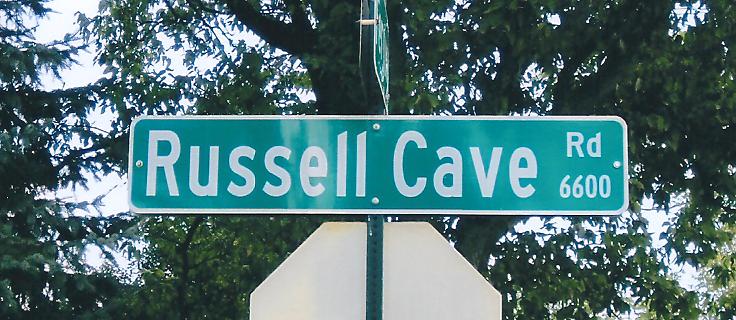
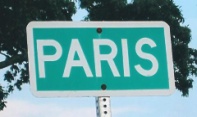

Sign for Russell Cave Road Sign for Paris, Kentucky Water tower
Photos courtesy of James & Judy Ware 2009
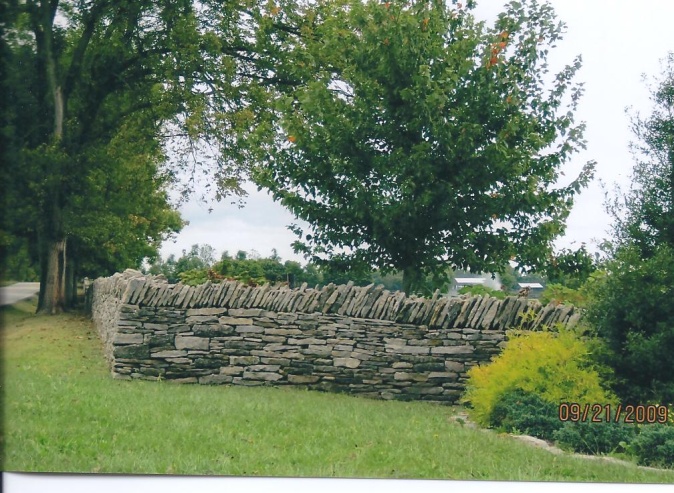
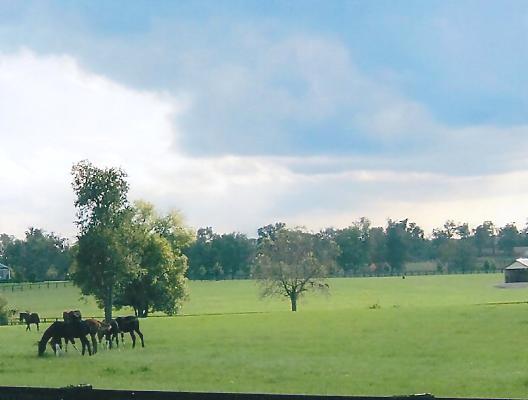 Old
stone fence
Kentucky bluegrass
Old
stone fence
Kentucky bluegrass
![]()
Thompson and Sallie “attended the Union Church [Christian Church denomination] about 2 miles south of the Centerville crossroads. The original building is gone now.” (Ref. 2112) Sallie had joined the church first on November 11, 1826, and Thompson soon followed on February 10, 1827. He also served as a deacon. (Ref. 2118)
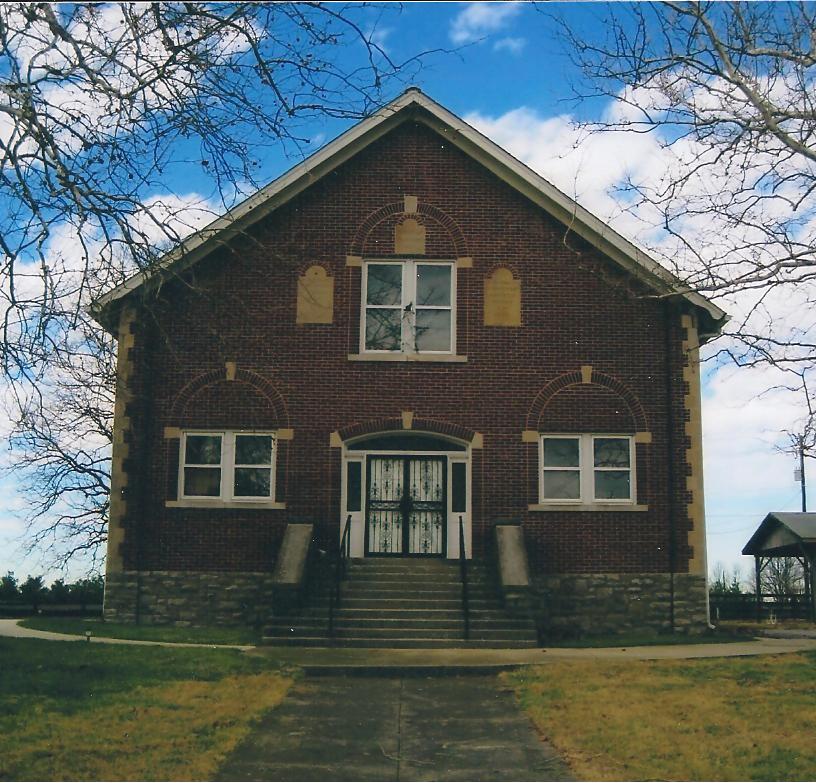 Old Union Christian
Church
Below is the membership agreement that congregants signed upon
joining the church. This information was found in the Union Church
records and kindly provided by Debbie McArdle of Illinois.
Old Union Christian
Church
Below is the membership agreement that congregants signed upon
joining the church. This information was found in the Union Church
records and kindly provided by Debbie McArdle of Illinois.
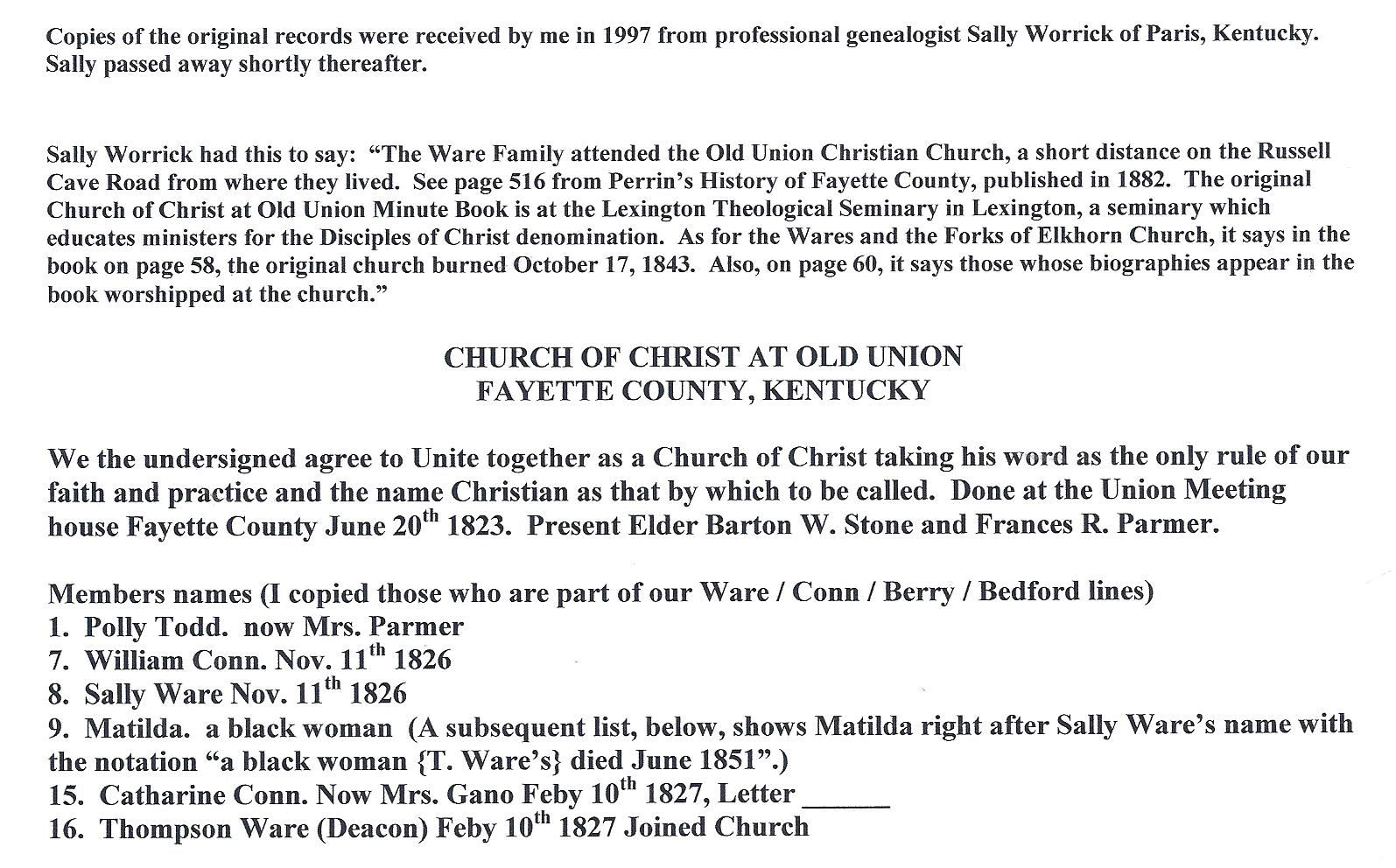
Ref. 2352)
![]() List
of additional members (Ref.
2352)
List
of additional members (Ref.
2352)
Markers on the front of the church
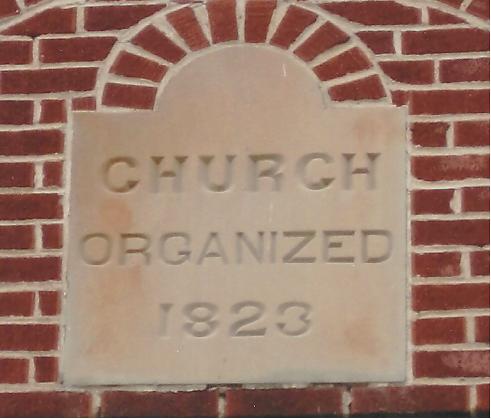
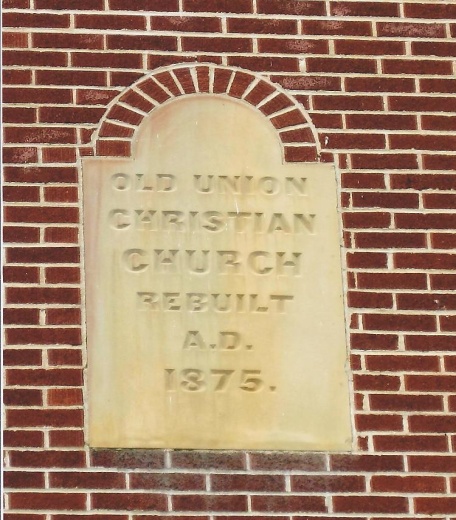
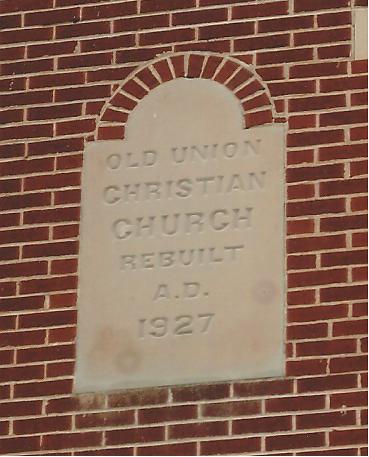
Photos taken by Judy Ware 2010
One of the ministers who served at the church during these years was Reverend John Allen Gano, the husband of Sallie’s niece (Mary Catherine Webb Conn) by her brother, William Conn. He performed the weddings for five of the Ware daughters: Cassandra, Kitty, Davidella, Eliza, and Lucy. (Ref. 967, 1070, 2112, 2350)
Thompson and Sallie were married for 52 years before Sallie died on November 26, 1851. Thompson lived one year longer, dying on September 9, 1852, at the age of 84. (Ref. 968, 2350) The following obituary was printed in “The Western Citizen” newspaper in Paris, Kentucky, on Friday, September 17, 1852:
![]()
1852: Died, at his residence, in this county, on the night of the 9th inst., Col. Thompson Ware in the 84th year of his age. Seldom are we called to record the death of one so aged, whose life was so pure and faultless. Beloved and honored by his fellow citizens, thro a long and exemplary life, he retained his strong hold on the love and esteem of all who knew him. For more than a quarter of a century he was a pious and devoted member and officer of the Christian Church, in whose communion he died. Short, indeed, was the separation between his and the spirit of his excellent wife, which whom he lived so happily on earth more than half a century. A large family of children and their offspring are left to mourn, and with these a wide circle of friends and acquaintances, may truly say with sadness “their like on earth for worth and goodness we shall seldom see.” “If we believe that Jesus died and rose again, we believe, also that all who sleep in Jesus, God will bring with Him.
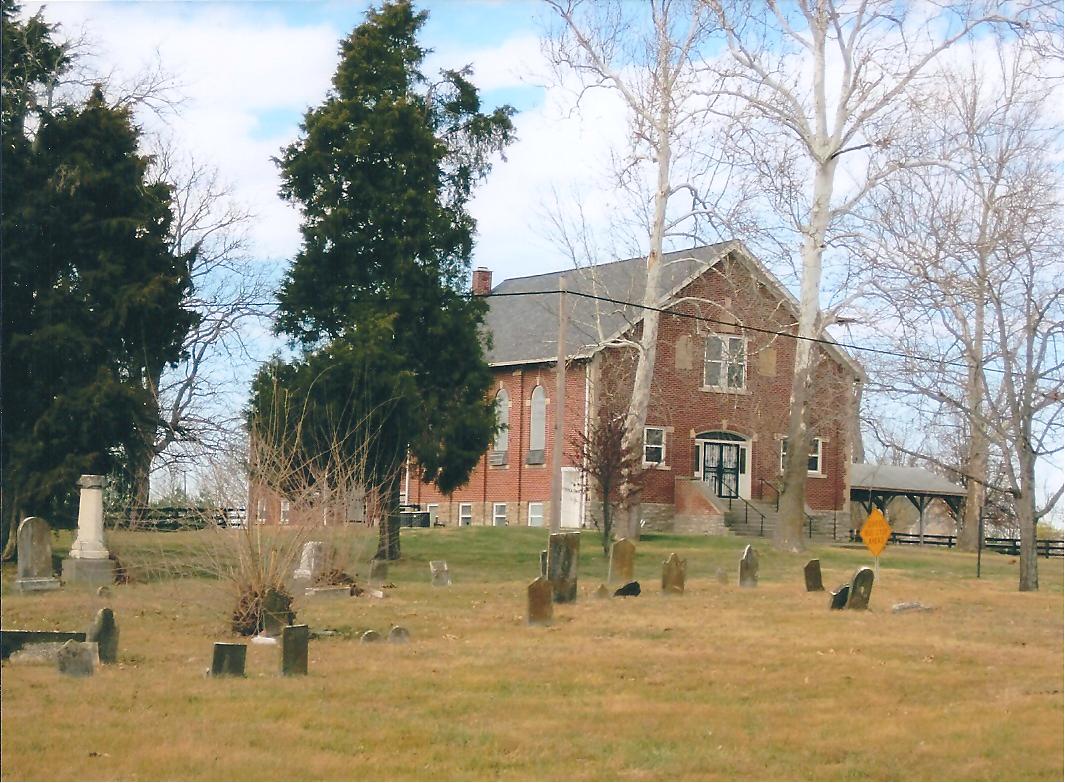
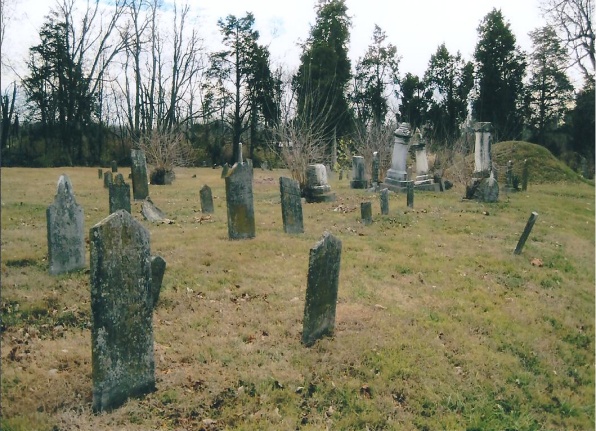
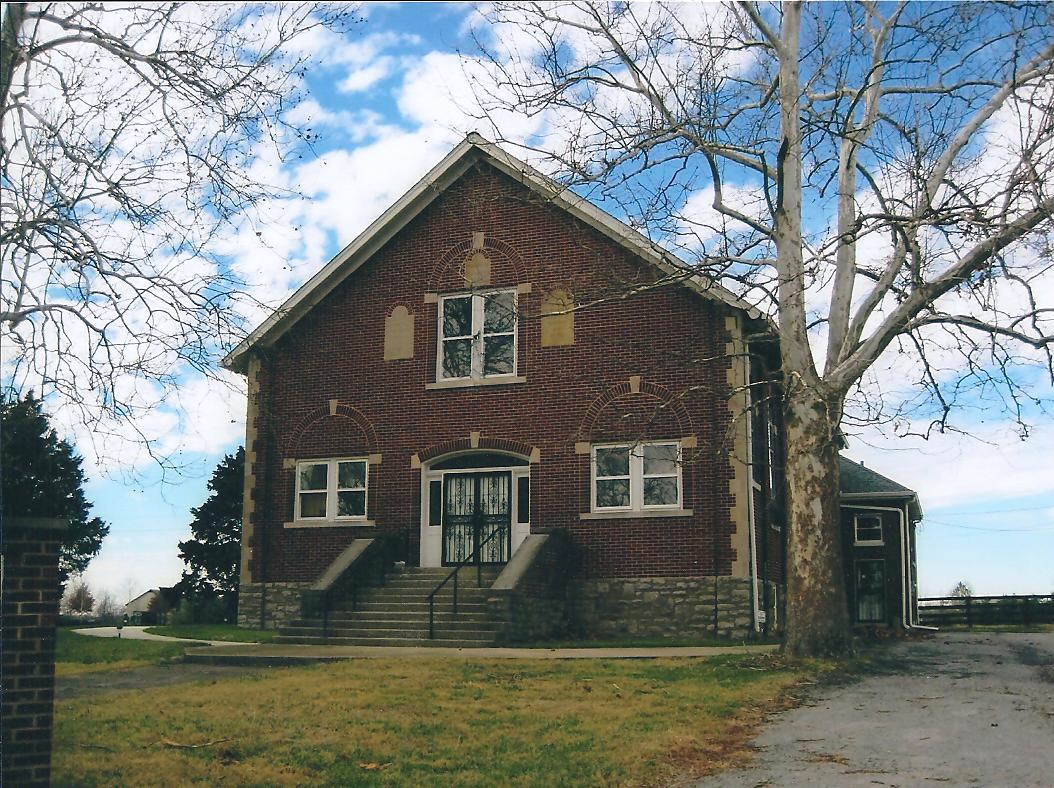
Old Union Christian Church and cemetery – Photos courtesy of Judy Ware 2010
![]()
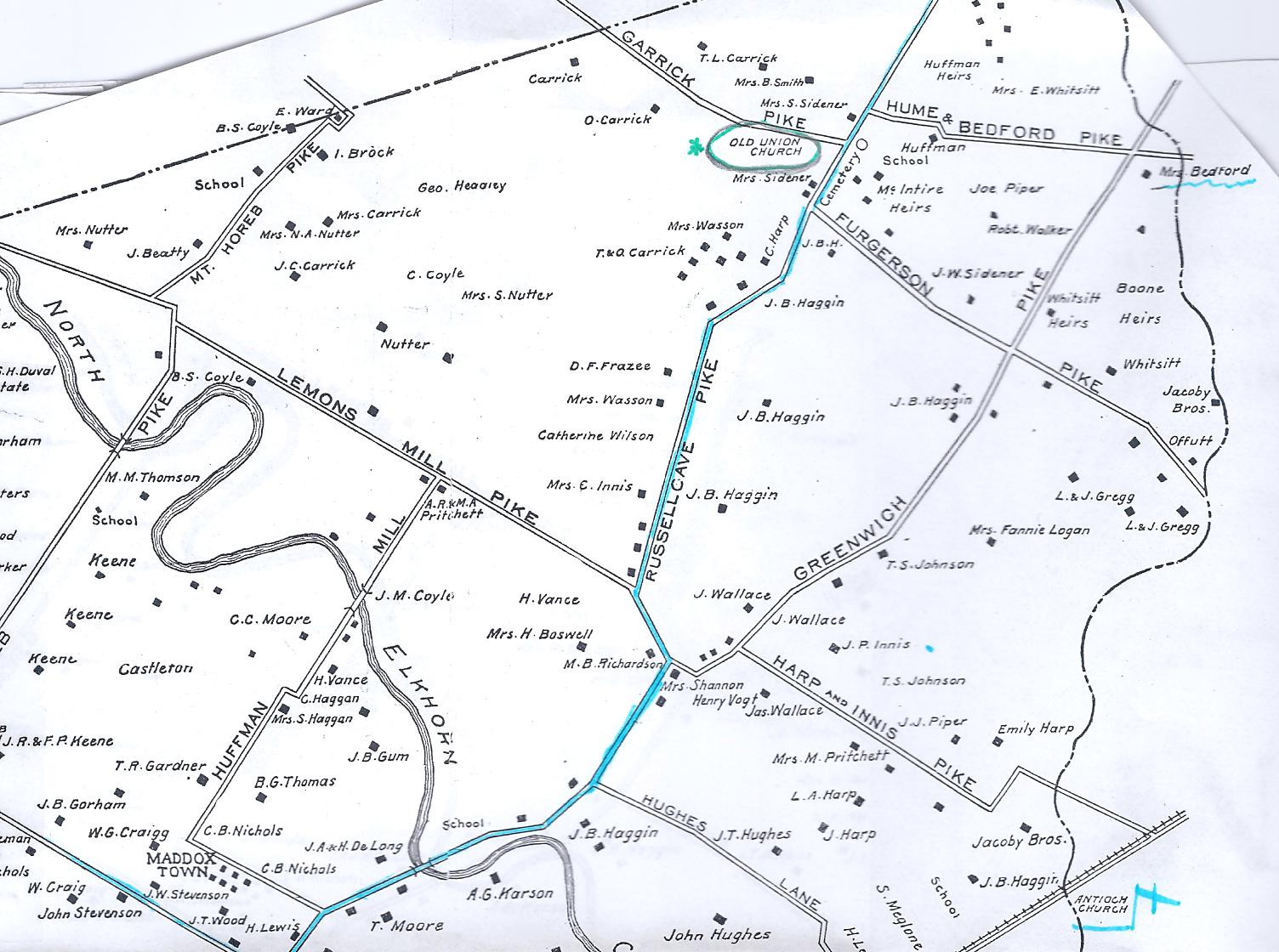
Ref. 939 – MAP SHOWS LOCATION OF OLD UNION CHURCH AND RUSSELL CAVE PIKE
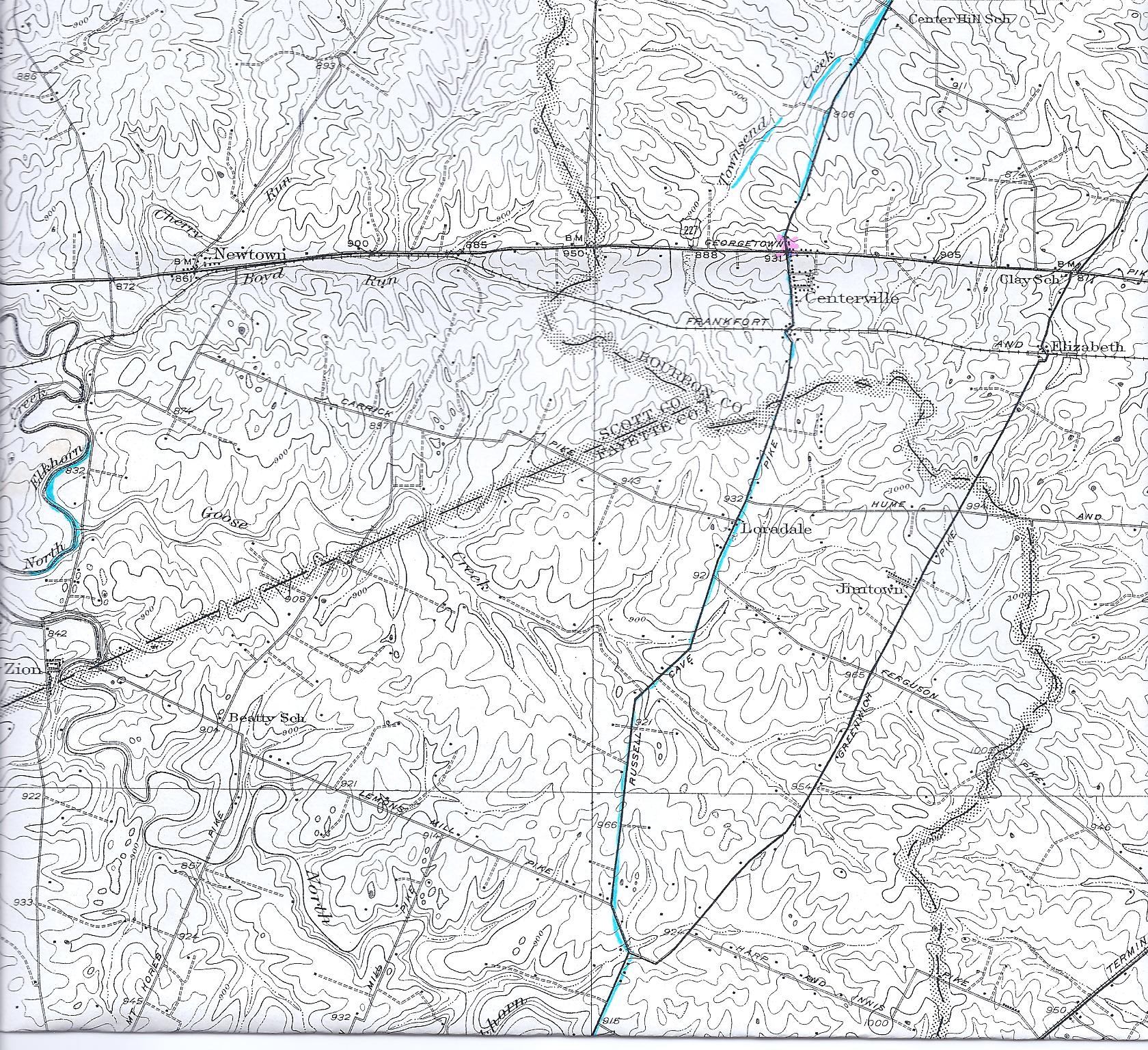
Map showing Townsend Creek, Centerville, & Russell Cave Road State of Kentucky Represented by the Department of Mines and Minerals – Courtesy of the Kentucky Historical Society
![]()
2. James Ware III - The second son of James and Caty was named after both his father and grandfather, so he became James Ware III. He was born on January 13, 1771, one month before Caty had her 18th birthday. By the time young James turned five years old, the nation was fully embroiled in the conflict that would change his world forever. He was probably very aware of his mother’s concern as she “held things down on the home front” while Dr. Ware served in the Continental Army. It was an exciting time in which to grow up, but there must have been great relief when the war finally ended.
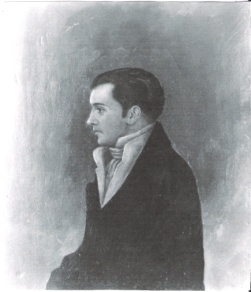 James
Ware III Descendents
of the Ware family who had possession of this painting in 1930 recall
this as a portrait of James Ware III (1771-1821).
James
Ware III Descendents
of the Ware family who had possession of this painting in 1930 recall
this as a portrait of James Ware III (1771-1821).
According to old family letters “in the fall of 1784, James III with his father, James Ware II, visited Kentucky and remained there all that winter. This was at the time when people lived in stations [forts].” (Ref. 6,35G, 334) James was 13 by this time, and Kentucky was an adventure like nothing he had ever known before. The vast western frontier was a far cry from the “civilized” Virginia he knew.
Dr. Ware returned to the Old Dominion after the winter, but “in 1789, he revisited Kentucky and left his sons, Thompson and James III, there.” (Ref. 6, 35G) Thompson later wrote, “we got separated; James located at Louisville and I in the neighborhood of Lexington, when my age was 20 and his about 18 months younger. We would sometimes accidentally see one another in the course of a year or two for several years until he entered into marriage to your mother in Virginia.” (Ref.35E) James had “engaged with Mr. Johnson, the Clerk of Jefferson County, writing in his office until he became fully acquainted with the work.” (Ref. 6, 35G) He became quite successful and his son, Josiah William Ware, would later write of his father that he “owned a great part of the town.” (Ref. #299) His health, however, was a constant problem.
According to a correspondence written in 1831 by his brother, Charles Ware, James “returned to Virginia in the spring of the year that my father moved here, and accompanied us some days and then returned [to Virginia].” (Ref. 35) After his parents and siblings were safely in route to their new homes, James III did, indeed, head back to Frederick County. Josiah later wrote that “suffering from chills and fever undermined his health, so my father sold out his business and returned to Virginia where he farmed but never recovered his health.” (Ref. 299) Suffering from the chronic and often long-term symptoms of tuberculosis, James married twice, had several children, and lived another thirty years after his return.
The following is an excerpt from Virginia Roots in Kentucky Soil:
![]() “We
now know that the symptoms James was suffering from were probably
the early stages of chronic tuberculosis, a disease which would
ultimately kill him. Once the leading causes of death in the
country during the 1700s and 1800s, the disease was known as
“consumption” due to its ability to ‘consume’ the body with
illness. Also called white death or white plague, this terrifying
and very contagious malady often claimed the lives of entire
families. With limited medical knowledge at the time, people were
not aware of how easy it was to become infected by simply having
close contact with a person already contaminated. The constant, and
sometimes uncontrollable, coughing would emit water droplets in the
air that were unknowingly breathed in by anyone in close proximity.
As late as 1900, Louisville, Kentucky, had one of highest
tuberculosis death rates in America. Built on low swampland, the
area was the perfect breeding ground for the bacteria. The disease
could be fast attacking or slowly progressive and chronic. The
classic symptoms of fatigue, fever, chills, and coughing were what
James was experiencing while working in Louisville. With no known
cure at the time, the end result of tuberculosis was always death
and eventually it would claim not only the life of James, but also
both of his wives and several of his children.” (Ref.
2277)
“We
now know that the symptoms James was suffering from were probably
the early stages of chronic tuberculosis, a disease which would
ultimately kill him. Once the leading causes of death in the
country during the 1700s and 1800s, the disease was known as
“consumption” due to its ability to ‘consume’ the body with
illness. Also called white death or white plague, this terrifying
and very contagious malady often claimed the lives of entire
families. With limited medical knowledge at the time, people were
not aware of how easy it was to become infected by simply having
close contact with a person already contaminated. The constant, and
sometimes uncontrollable, coughing would emit water droplets in the
air that were unknowingly breathed in by anyone in close proximity.
As late as 1900, Louisville, Kentucky, had one of highest
tuberculosis death rates in America. Built on low swampland, the
area was the perfect breeding ground for the bacteria. The disease
could be fast attacking or slowly progressive and chronic. The
classic symptoms of fatigue, fever, chills, and coughing were what
James was experiencing while working in Louisville. With no known
cure at the time, the end result of tuberculosis was always death
and eventually it would claim not only the life of James, but also
both of his wives and several of his children.” (Ref.
2277)
![]()
Upon his 1791 return to Virginia, however, James was hoping to obtain respite from his health issues and invest the money he had accrued in Kentucky in farming and horse breeding. On November 10, 1796, he married Elizabeth Alexander, the only daughter of Morgan and Elizabeth (Snickers) Alexander.
 Excerpt
from family bible
Excerpt
from family bible
Elizabeth came from a wealthy family in Frederick County and already owned land that she had inherited from her mother. In 1803, James and Elizabeth decided to expand their holdings and “bought 401 acres in the heart of the Snicker’s tract from Elizabeth’s Uncle William for $14,011.00. The acreage included Snicker’s Ferry, Snicker’s Tavern, the blacksmith shop, and at least one mill.” (Ref. 28, 195, 200) With the wealth he had accrued in Kentucky combined with the acquisition of so much new property from Elizabeth, the Wares suddenly became one of the larger land owning families in the area.
It was on this property, bought from William Snickers, that James Ware III built his home. It was named Riverside because of its close proximity to the beautiful Shenandoah River. (Ref. 52) As described in a newspaper article in 1954, “Built before 1800, the old gray stone house commands a superb view of the Shenandoah River, winding through the Blue Ridge. The original house with beautiful stairway, paneling, and wood carving has been little changed. It was built by James Ware and inherited by his daughter.” (Ref. 507)
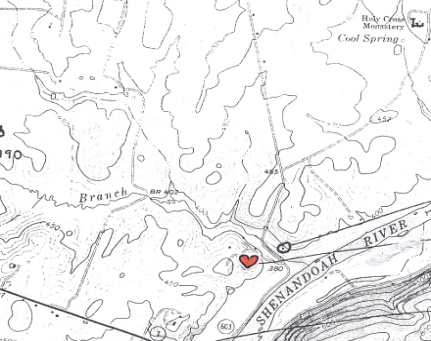
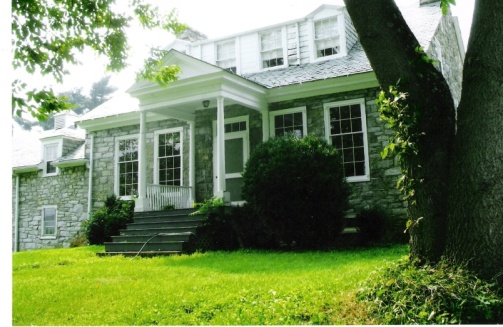
Map showing the location of Riverside and Ware’s Mill Riverside
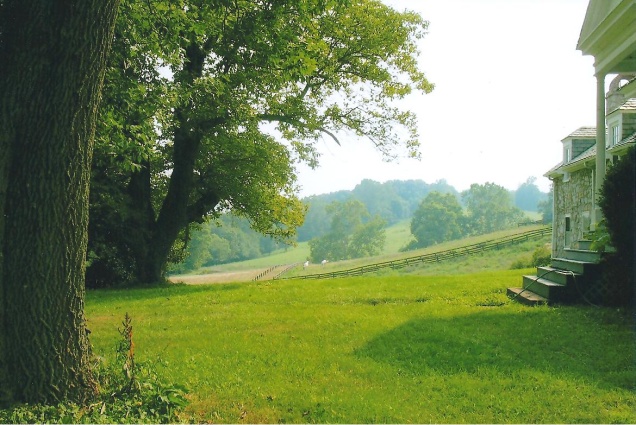
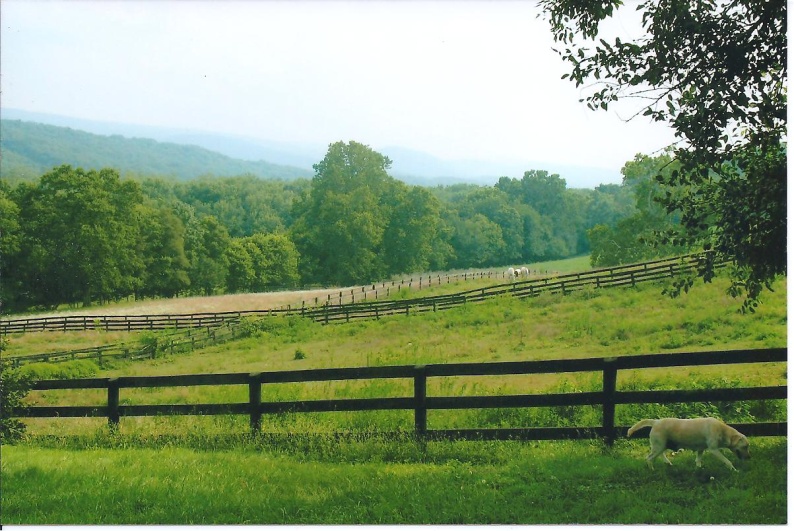
View from the back door of Riverside, with the Blue Ridge Mountains on the horizon and the Shenandoah River nestled off to the left (and below) the tree line.
Directly across the road from Riverside was the mill that James ran as well. It was appropriately named “Ware’s Mill.” Both landmarks are still in existence today.
Photos
taken by Judy Ware 2009
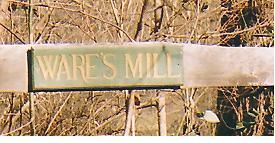
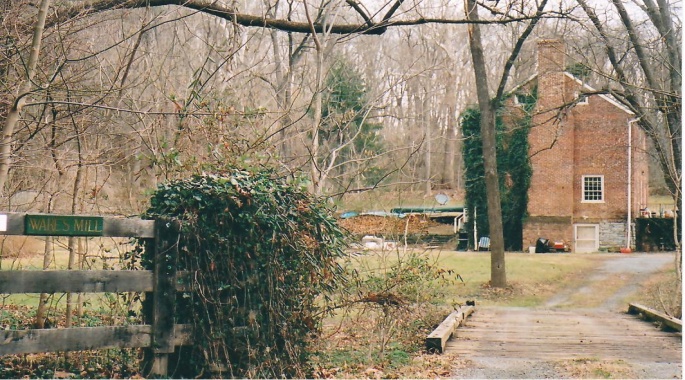
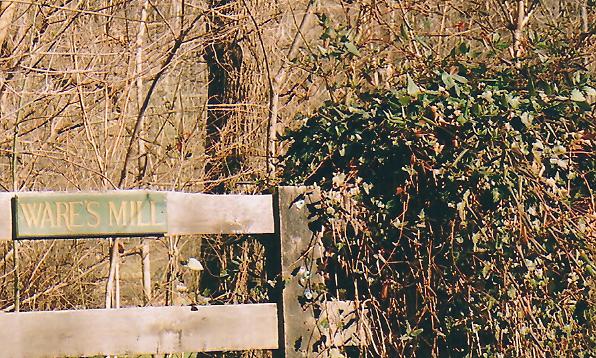
Elizabeth
delivered her first baby on October 1, 1797,
a year
after her marriage to James. The couple named their baby daughter
![]() Sarah Elizabeth Taliaferro Ware, but she was usually called Sally.
She grew up to marry Sigismund Stribling. Two more children followed
shortly thereafter:
Sarah Elizabeth Taliaferro Ware, but she was usually called Sally.
She grew up to marry Sigismund Stribling. Two more children followed
shortly thereafter:
![]() Charles Alexander Ware in 1800 and
Charles Alexander Ware in 1800 and
![]() Josiah William Ware in 1802. Charles died in 1823 at the young age
of 23. Sarah and Josiah were extremely close, grew up together, and
eventually lived right across the road from each other. Sadly,
however,
Josiah William Ware in 1802. Charles died in 1823 at the young age
of 23. Sarah and Josiah were extremely close, grew up together, and
eventually lived right across the road from each other. Sadly,
however,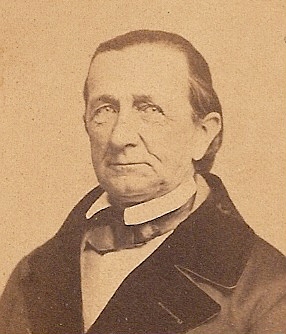 Josiah William Ware neither
sibling really knew their mother. At 29 years of age, Elizabeth
Alexander Ware passed away on August 29, 1803, just days after a
young Josiah celebrated his first birthday. Her death arose from
complications of tuberculosis, a disease she probably, unknowingly,
caught from her husband.
Josiah William Ware neither
sibling really knew their mother. At 29 years of age, Elizabeth
Alexander Ware passed away on August 29, 1803, just days after a
young Josiah celebrated his first birthday. Her death arose from
complications of tuberculosis, a disease she probably, unknowingly,
caught from her husband.
James continued to fulfill his civic and family responsibilities, although the loss of Elizabeth must have seemed like a dark cloud overshadowing his happiness. In 1809, he was appointed as a justice of the peace; his home of Riverside needed continual attention; Ware’s Mill was still up and working; and in 1818, a Virginia newspaper reported that James had been given permission by the Virginia Senate to build a toll bridge over the Shenandoah River. There was no lack of things for him to do.
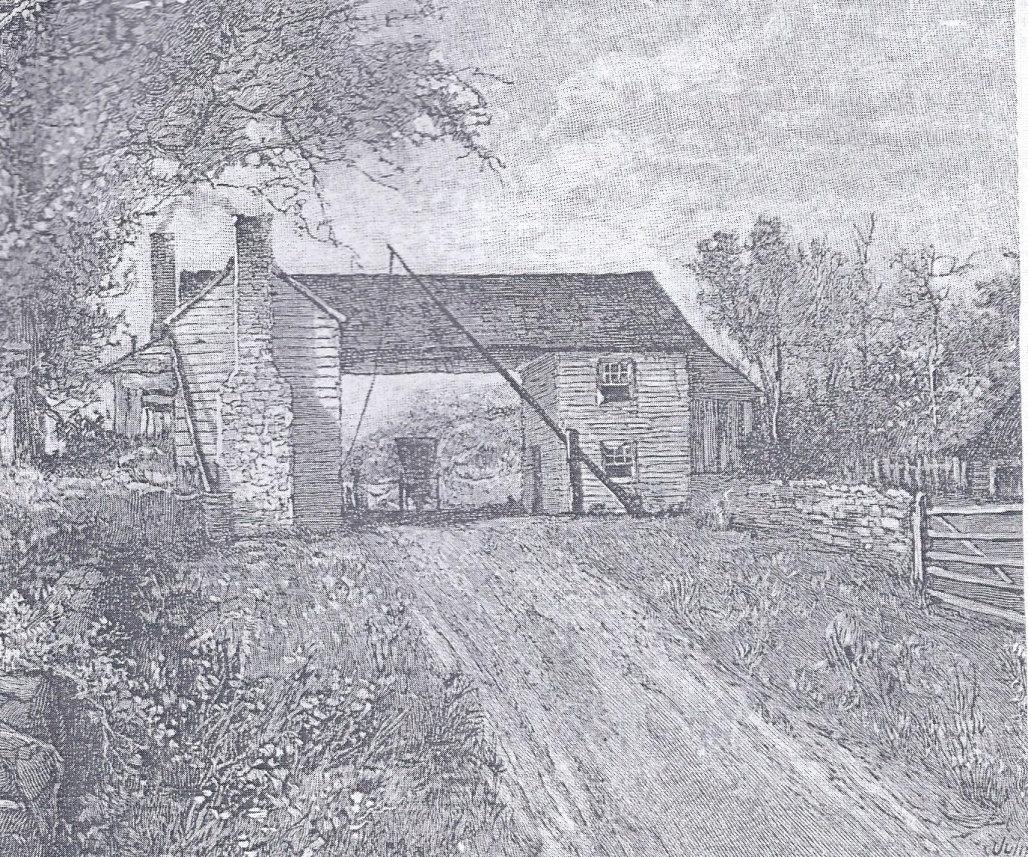
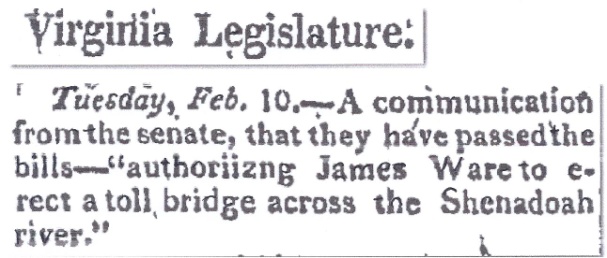
Toll road (Ref. 2532) Newspaper article
![]()
Below
is a complete list of the justices of the peace for Frederick County
from 1779 to 1809
1779
- John Smith.
1783 - Thomas Buck, Isaac Hite.
1798
- Charles Smith, George Blakemore.
1799 - John B. Tilden,
Joseph Blake, Joshua Gore.
1801 - Benjamin O'Rear, John
Jolliffe.
1802 - Moses Russell, Edward McGuire.
1804
- Edward Smith, Joseph Tidball, William Cooke, James M. Marshall,
William Castleman.
1808 - Griffin Taylor, Robert Vance,
Samuel Baker, Lewis McCoole, John S. Ball, William Vanmetre.
1809
- James Ware III.
None of his
business activities altered the fact, however, that when his wife
died, James was left with three children to care for - all under the
age of seven. In 1809, he married again. His new wife was a cousin
named Harriet Taylor, and their union provided six more children:
![]() James W. (1809),
James W. (1809),
![]() Bushrod (1810),
Bushrod (1810),
![]() Thomas (1812),
Thomas (1812),
![]() Lucy (1814),
Lucy (1814),
![]() Harriet (1816), and
Harriet (1816), and
![]() Elizabeth Alexander Ware (1818), who was named for James’ first
wife. Tragically, tuberculosis eventually
took
the lives of all but one child who lived long enough to marry. James
W. died at age 18, Bushrod at 7, Thomas Marshall (known as Marshall)
at 20, Harriet at 12, and baby Mary only lived 14 months. The
dreaded disease also killed both parents. James
III
died
on a Thursday night, September 13, 1821. Harriet followed him the
next year on November 1, 1822. (Ref.
1)
Elizabeth Alexander Ware (1818), who was named for James’ first
wife. Tragically, tuberculosis eventually
took
the lives of all but one child who lived long enough to marry. James
W. died at age 18, Bushrod at 7, Thomas Marshall (known as Marshall)
at 20, Harriet at 12, and baby Mary only lived 14 months. The
dreaded disease also killed both parents. James
III
died
on a Thursday night, September 13, 1821. Harriet followed him the
next year on November 1, 1822. (Ref.
1)
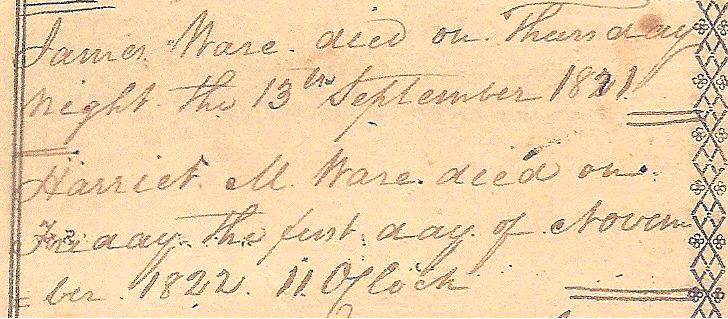 Excerpt from family bible owned by James and Judy Ware
Excerpt from family bible owned by James and Judy Ware
With the passing of both parents, the second set of Ware children found their lives forever changed. The oldest child from James’ first marriage, Sarah Elizabeth, had married and delivered her own first baby in 1821 - just one month before her father died. She became a widow the very next year - one month prior to the death of her stepmother. Charles Ware, at age 23, would die one year following the death of Harriet. Even Josiah, who was 19 when Harriet died, was considered by the courts to be an orphan and was put under the guardianship of Edward J. Smith until he reached the age of his majority (i.e., status of adulthood recognized by law).
James Ware deceased, orphan Josiah William Ware, guardian Edward J. Smith
That still left four orphans from the second union who needed a home. Harriet Ware (probably well aware of her fate) had already asked her brother, Bushrod Taylor, and his wife (Betsey Stribling Taylor) if they would raise the children in the event of her death. Bushrod had rented a small farm from his brother-in-law, James, when he had first moved to Clarke County, and he and Betsey (only married for five years) took in the Ware orphans.
 Bushrod
Taylor
Bushrod
Taylor
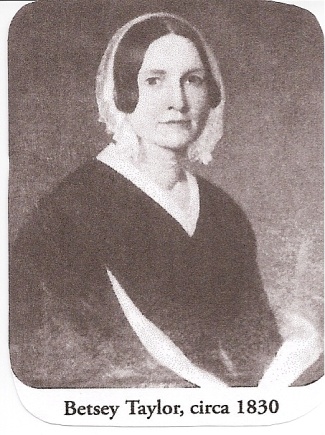 Betsey
Taylor
Betsey
Taylor
Brother and sister-in-law of Harriet M. Taylor Ware, wife of James Ware III
With no children of her own, Betsey became a mother to these Ware siblings in every sense of the word. She “petted, loved, protected, and laughed with the children, striving to lessen their sense of loss.” (Ref. 900) It must have broken her heart to have to bury most of them. “Marshall was the third of the Ware orphans to die and his loss was the most difficult for Betsey to accept.” (Ref. 900) Lucy Catherine Ware was the only child of James and Harriet who lived to marry - her husband was Dr. William McGuire. They lived at Riverside, the home her father built in his youth. (Ref 590, 899, 900)
It was a tragic ending for the son of James and Caty and grandson of James and Agnes, but James’ branch of the Ware family tree would live on in his own son, Josiah Ware, who would eventually become one of the leading citizens of Frederick County.
![]()
![]()
3. Mary Todd Ware - James and Caty Ware had their third child on September 4, 1772. Her name was Mary Todd Ware, but she was forever known as Polly. Her middle name of “Todd” was most likely bestowed either in honor of Caty’s maiden name or the maiden name of Polly’s paternal grandmother, Agnes Todd Ware. Caty now had a busy household with a new baby, three-year-old Thompson, and one-year-old James.” (Ref. 2350)
Polly Ware, “like her siblings, grew up in Virginia. It was there she met and married Charles Webb on February 24, 1791, thus providing the first bridge between the Ware and Webb families that would later move to Kentucky together.” (Ref. 307, 621, 1067, 2350) Polly was 19 years old at the time of her wedding, and Charles was 36.
![]()

Excerpt from family bible showing marriage of Charles and Polly
Polly
delivered her first child in Virginia, but all her other children
would be born in Kentucky. The Webb family joined with the Wares for
the big migration to their new home, and Polly often spoke to her
children about this frightening trip. It
is difficult to imagine the differences in life styles that must have
emerged through this frontier adventure. The same year Polly was
living with the fear of having her head scalped, Thomas Jefferson, in
writing to his daughter Patsy, admonished her to remember that
 “from
the
moment you rise till you go to bed, be as cleanly and properly
dressed as at the hours of dinner or tea. Nothing is so disgusting
to men as a want of cleanliness and delicacy in women. I hope,
therefore, the moment you rise from bed, your first work will be to
dress yourself in such style, as that you may be seen by any
gentleman without his being able to discover a pin amiss, or any
other circumstance of neatness wanting . . . .”
(Ref. 902)
It is
doubtful that Polly Ware was concerned about having a “pin amiss”
on her trip to Kentucky.
“from
the
moment you rise till you go to bed, be as cleanly and properly
dressed as at the hours of dinner or tea. Nothing is so disgusting
to men as a want of cleanliness and delicacy in women. I hope,
therefore, the moment you rise from bed, your first work will be to
dress yourself in such style, as that you may be seen by any
gentleman without his being able to discover a pin amiss, or any
other circumstance of neatness wanting . . . .”
(Ref. 902)
It is
doubtful that Polly Ware was concerned about having a “pin amiss”
on her trip to Kentucky.
Charles and Polly raised their large family in that harsh frontier environment, and they settled around the Versailles area in Fayette County. Polly’s older brother, Thompson, wrote that, “Your Aunt Polly Webb lives within a mile, where we can see each other every week.” (Ref. 35E)
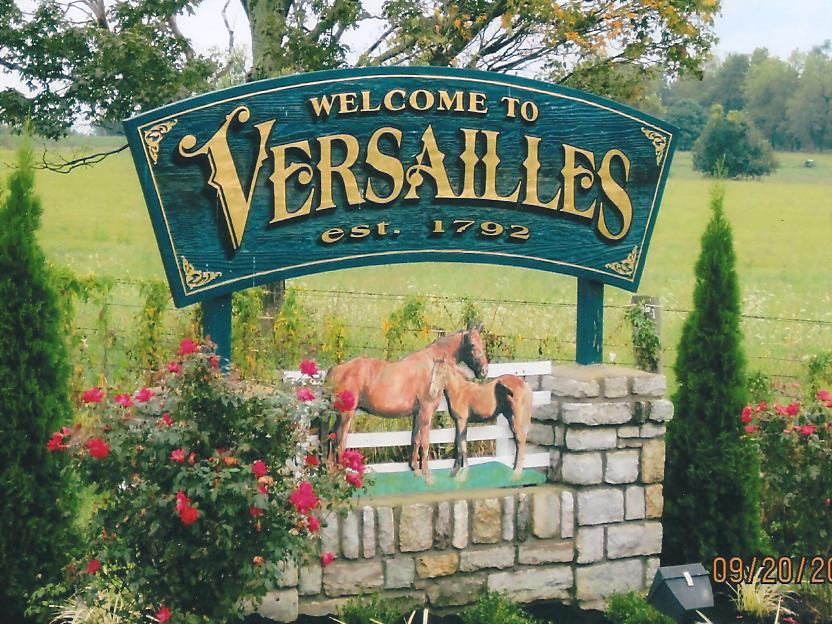
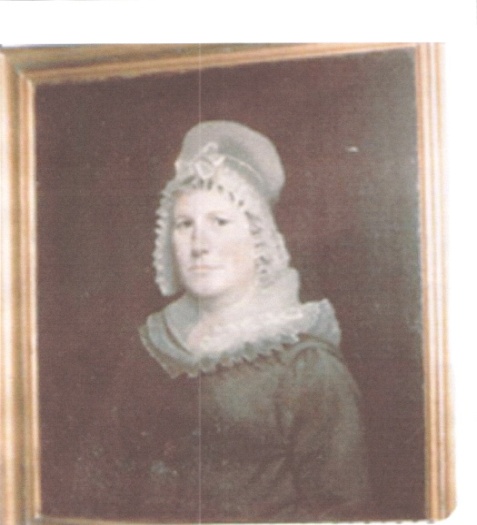 Polly
Todd Ware Webb – Sign for Versailles
photo kindly provided by
descendant, Sandra Walker
Polly
Todd Ware Webb – Sign for Versailles
photo kindly provided by
descendant, Sandra Walker
![]() The following provides
insight into the family of Polly
and Charles Webb. Again, for much more detailed information, please
read Virginia
Roots in Kentucky Soil.
The following provides
insight into the family of Polly
and Charles Webb. Again, for much more detailed information, please
read Virginia
Roots in Kentucky Soil.
![]()

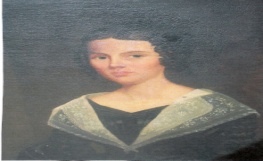 Fanny
Webb
Fanny
Webb
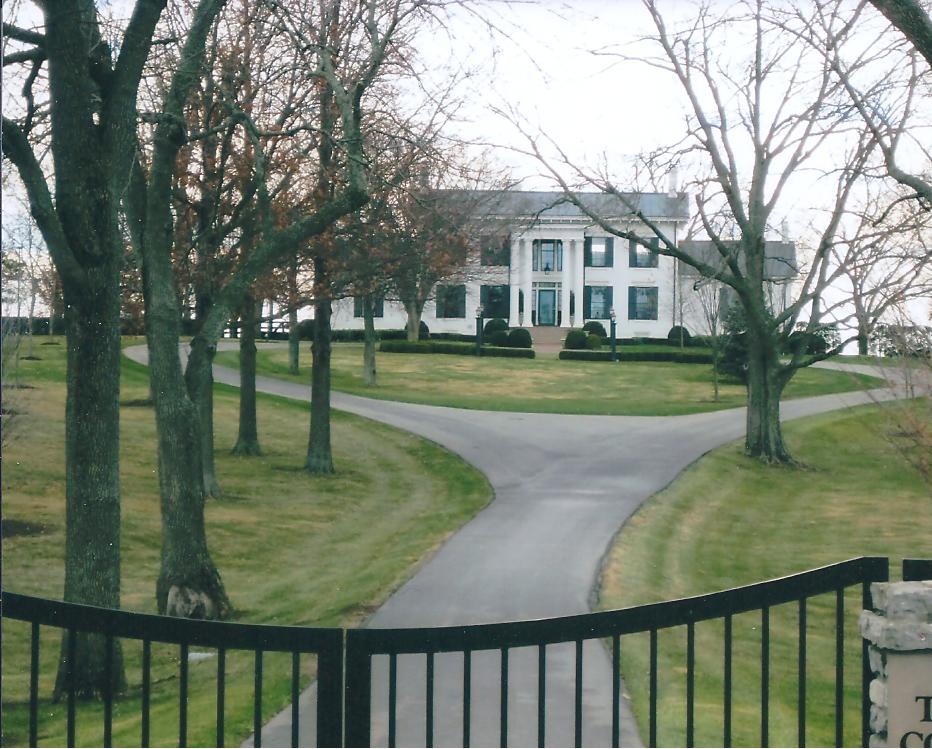 Bellevue
– Home of William Conn
Photo taken by James and Judy Ware
2010
Bellevue
– Home of William Conn
Photo taken by James and Judy Ware
2010
In a letter written by Charles Ware in 1811, he mentioned that “William Conn has settled between Thompson Ware’s and his father. [He] has built a brick house and cleared about 20 acres of land and put it in corn and hemp.” (Ref. 35B) The records show “all this land was around the headwaters of Townsend.” (Ref. 781) William named his lovely home Bellevue.
The Conns only had one child, Mary Catherine, born in 1810. When she was only two years old, her father went to fight in the War of 1812. William attained the rank of captain and “was in the Kentucky Mounted Volunteer Militia from August 31, 1813 to November 8, 1813 under command of Colonel William Mountjoy.” (Ref. 1055)
Fanny and William Conn were wed 18 years when Fanny died on September 23, 1826. In a letter to family in Virginia, Lucy Webb wrote, “Your aunt (Polly Webb) observed to me, with tears in her eyes, “O, if he [referring to the doctor] could have only seen Fanny, I think she would have got well.” (Ref. 597)
Mary Catherine was doted on by her widowed father and when she wed a Unitarian minister named John Allen Gano in 1827, “William gave the newlyweds a farm near his own, most likely the one known locally as Springdale.” (Ref 2350) This farm was “where his father, Thomas Conn, had settled in 1787, and where he lived and died in 1811.” (Ref. 782, 951) Later, when William Conn died at Bellevue in 1872, he bequeathed that beautiful estate to his only daughter - - so John and his wife then moved back to her childhood home. (Ref. 941)
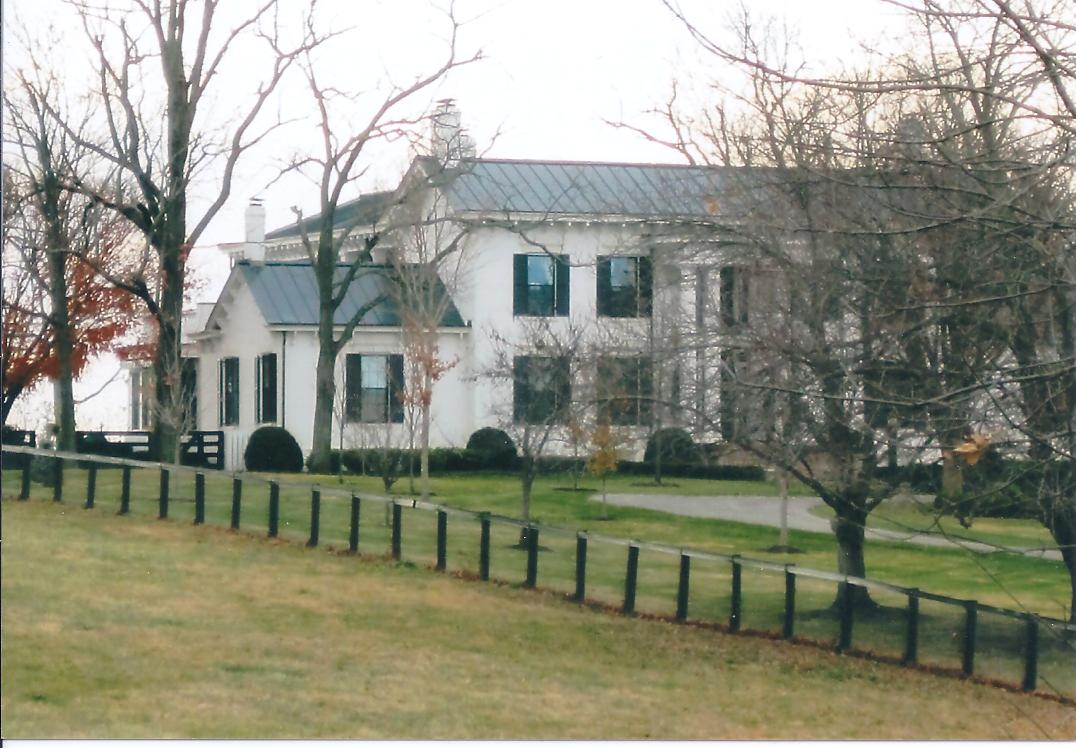
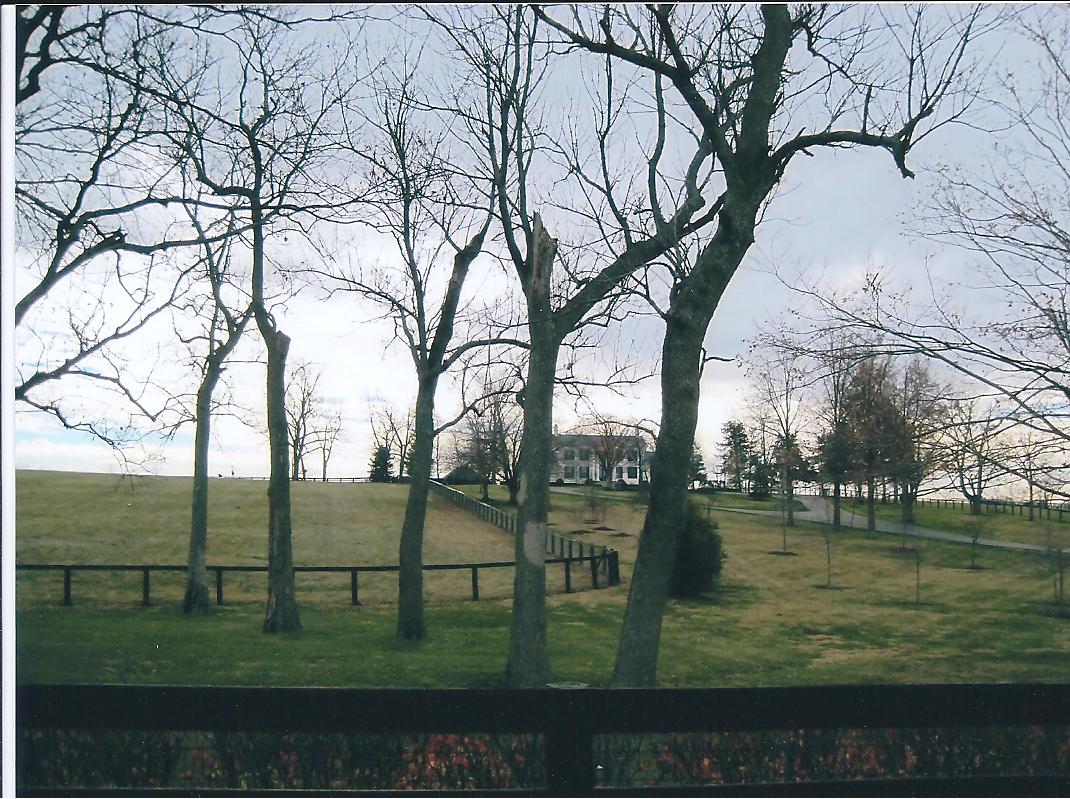
Bellevue – home of William Conn (and later John and Mary Catherine Gano) All color photos taken by James and Judy Ware 2010
![]()
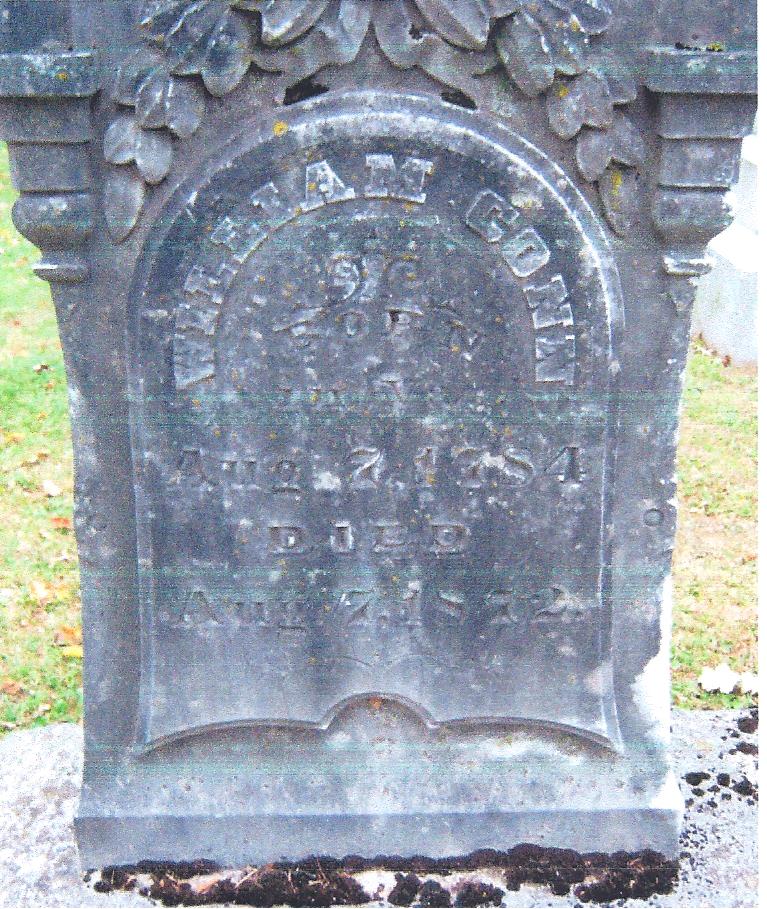
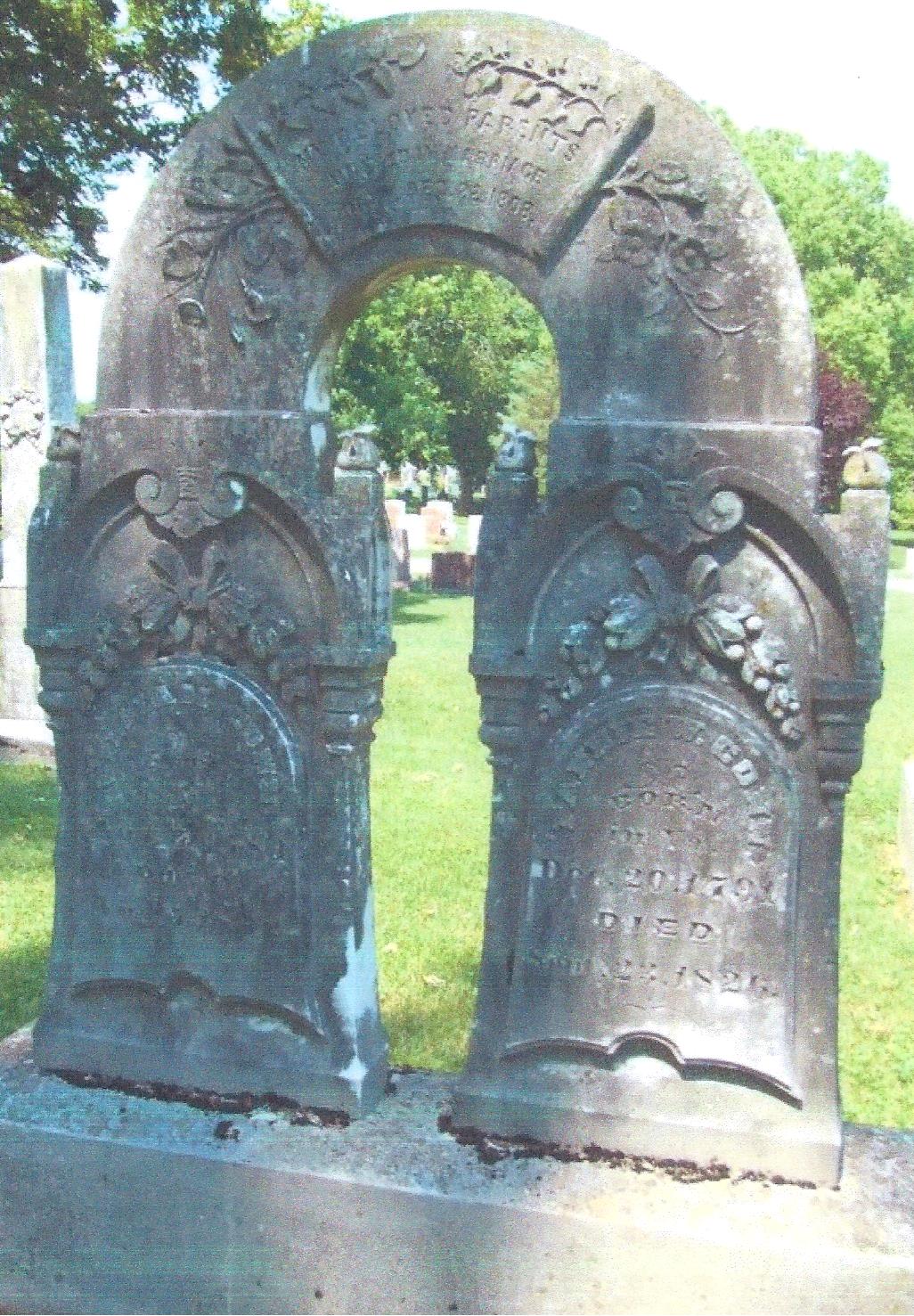
Graves for William and Fannie Webb Conn – marker mentions that Fanny was born in Virginia on Dec. 20, 1791.
![]()

![]() William Conn Obituary
William Conn Obituary
Mary Catherine’s husband, Reverend John Allen Gano, came from a long line of religious leaders. He was greatly loved and officiated at the weddings of several of Mary Catherine’s cousins. (Ref. 782, 951) The couple had nine children, three of whom died in infancy. The offspring of John and Mary Catherine Gano (grandchildren of Polly) are as follows:
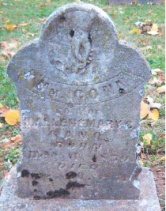 Grave
for William Conn Gano
Grave
for William Conn Gano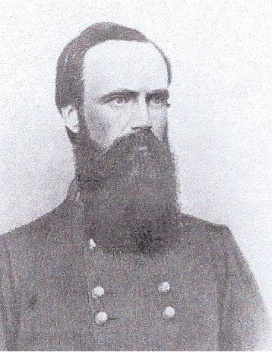
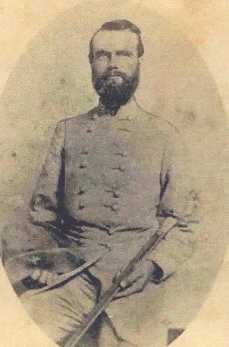
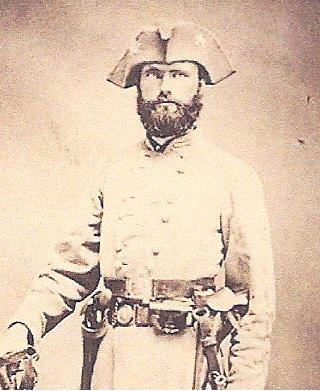
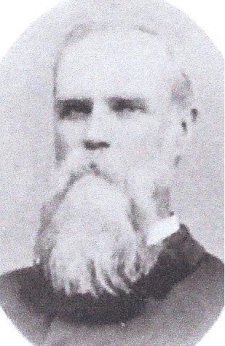
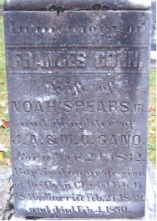 Grave
for Fanny Conn Gano
Grave
for Fanny Conn Gano
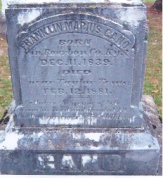 Grave
for Franklin Marius Gano
Grave
for Franklin Marius Gano
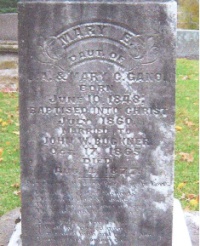 Grave
for Mary Eliza Gano Buckner
Grave
for Mary Eliza Gano Buckner
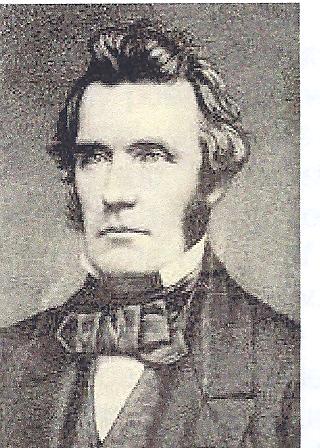 John Allen Gano
John Allen Gano
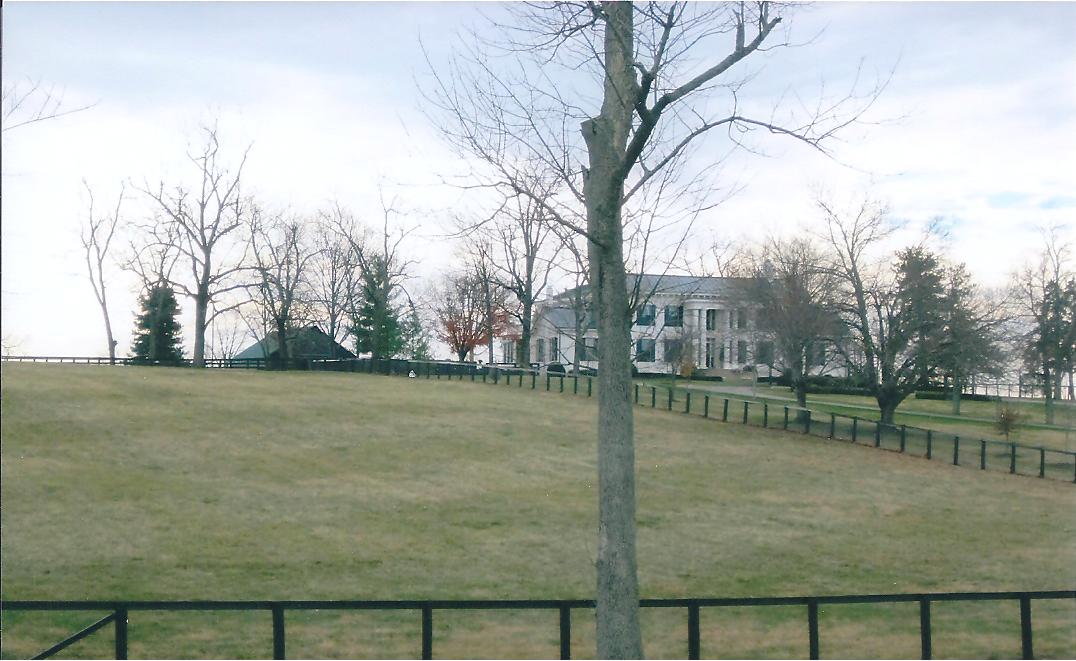 Bellevue
Bellevue
Mary Catherine
predeceased John, who died October 14, 1887.

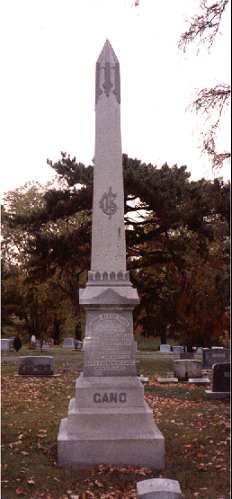
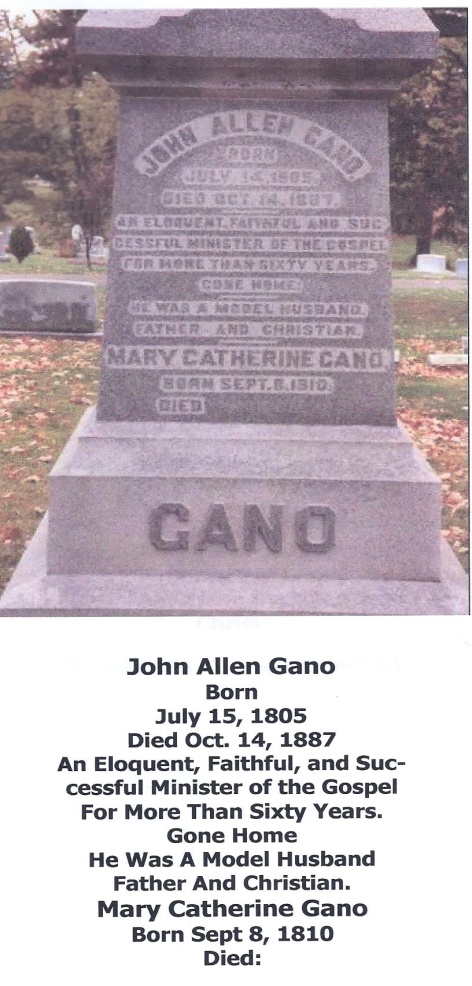 Bellevue
Grave for John and Mary
Catherine Gano
Bellevue
Grave for John and Mary
Catherine Gano
Polly and Charles Webb were well settled in Kentucky before more children came into their family. The next few years must have been heart breaking ones for Polly as she delivered a new infant just about every two years, only to watch them die. There was a seven year difference between the birth of their first child, Fanny, and the birth of the next child that would live to see adulthood.” (From Virginia Roots in Kentucky Soil)
![]() James
Webb
–
He
was born and died
in
1793.
James
Webb
–
He
was born and died
in
1793.
![]() Charles
Webb
–
He
was born and died in 1795.
Charles
Webb
–
He
was born and died in 1795.
![]() Charles
Webb
–
He was born and died in 1797.
Charles
Webb
–
He was born and died in 1797.
![]() Charles
Henry Webb, Jr.
-
Finally,
on July 2, 1798, the Webb family welcomed a son “who
was strong enough to survive the harsh times in which he was born.
They wanted a namesake for Charles so very much that they also named
this fourth son Charles Henry Webb Jr. This Charles not only made it
to adulthood, but he, fittingly, became a doctor.” (Ref.
2350)
Charles
Henry Webb, Jr.
-
Finally,
on July 2, 1798, the Webb family welcomed a son “who
was strong enough to survive the harsh times in which he was born.
They wanted a namesake for Charles so very much that they also named
this fourth son Charles Henry Webb Jr. This Charles not only made it
to adulthood, but he, fittingly, became a doctor.” (Ref.
2350)
At 29 years of age, Charles married Cassandra Frances Ford, the daughter of a wealthy family with a most colorful reputation. Cassandra’s father was James Ford, the notorious leader of the Ford’s Ferry Gang that operated out of Cave-In-Rock, a very large cave lying at the junction of where the Cumberland River meets the Ohio River.” (Ref. 2094, 2205, 2206, 2207, 2267) Ford was described as “one of the cleverest and most ruthless of American criminal masterminds.” (Ref. 2265)
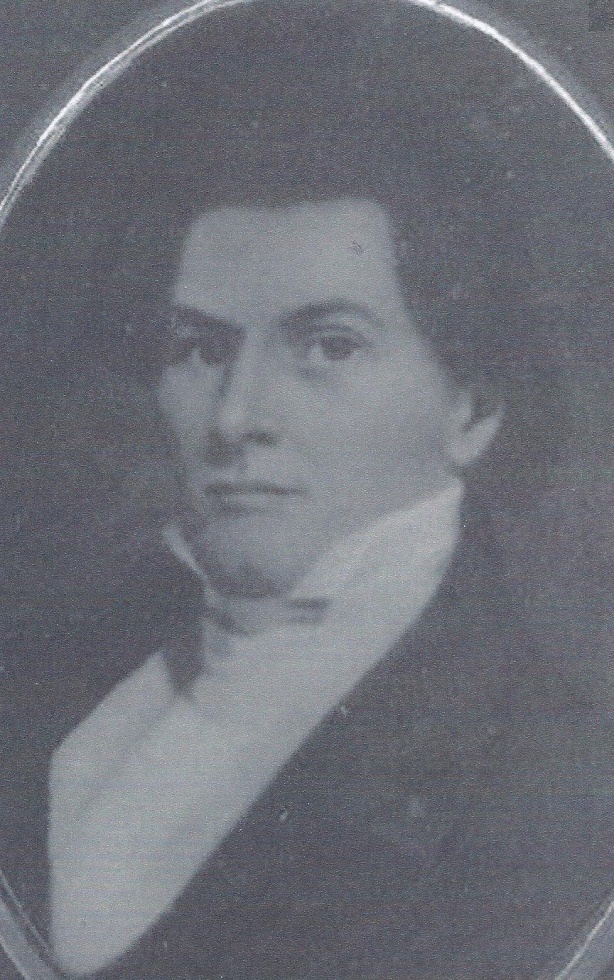 Dr. Charles Henry Webb
Dr. Charles Henry Webb
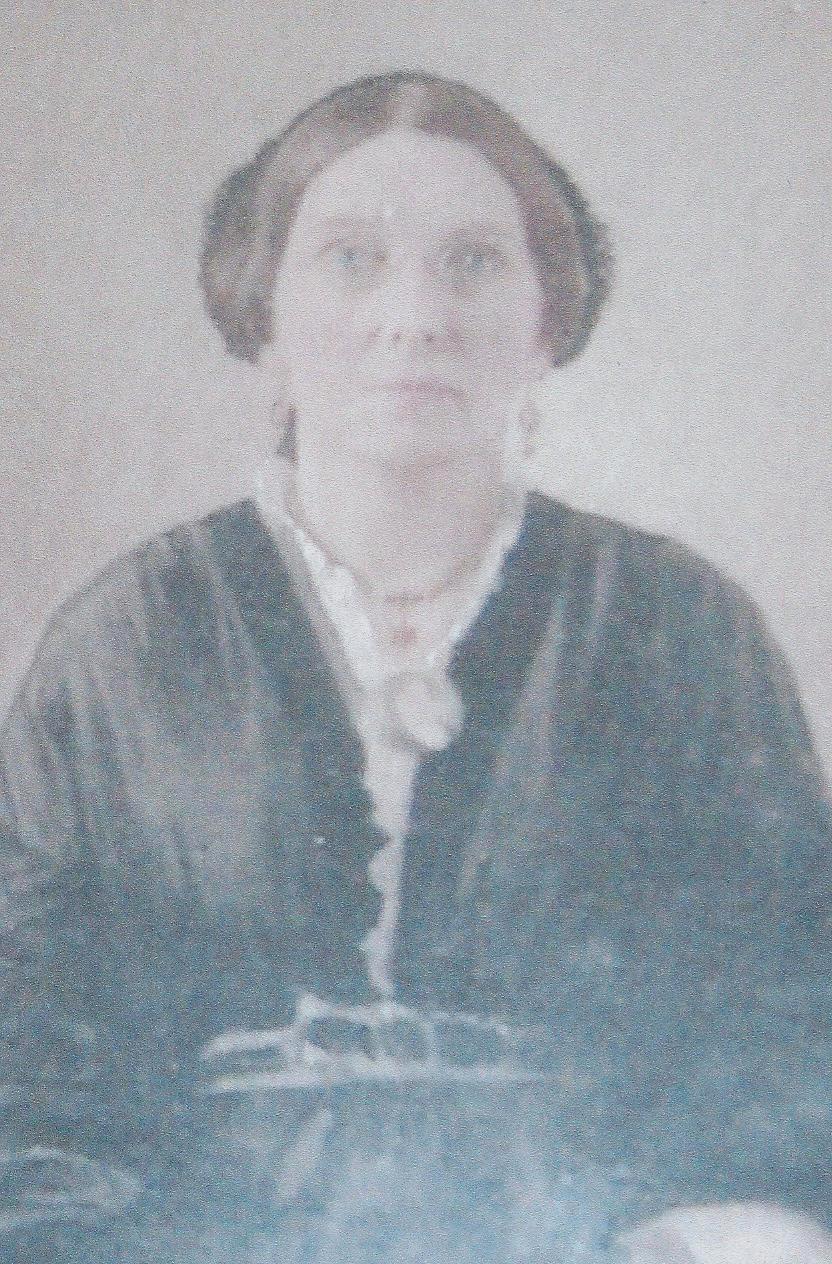 Cassandra Ford Webb
Photos courtesy of
Sandra Walker
Cassandra Ford Webb
Photos courtesy of
Sandra Walker
The following is an excerpt from Virginia Roots in Kentucky Soil.
Cassandra’s father led a somewhat “double life.” For a great deal of time, nobody connected him with crimes being committed against travelers on the river. He “had been elected a delegate to the Tennessee Constitutional Convention in 1795, he was Captain of the Livingston County Cavalry of the 24th Regiment of Kentucky Militia from July 1, 1799 to Dec. 15, 1802, he was justice of the peace of Deer Creek, Livingston Co., Kentucky in 1803, and in May 1809, the acting Governor of Illinois appointed Ford justice of the peace for Randolph County.” (Ref. 2267) James had all the appearances of a law-abiding citizen. Greed got the better of him, though.
Ford heard that a man named “Sam Mason would lure the flat boats into the cave [Cave-in-Rock] and then rob the occupants of their wares and kill them. Since the boats were carried by the river current as propulsion, they simply drifted right into Sam’s hands.” (Ref. 2094) Working behind the scenes, Ford expanded on the idea and actually used his standing in the community as a foil for, not only controlling the ferries, but side tracking any complaints that arose from victims that were lucky enough to make it through alive. He “owned Hurricane Island and a five hundred acre plantation” which was located at one of the most difficult navigation points on the river. (Ref. 2265) As author Boynton Merrill, Jr. wrote in 1976: “There was a ferry across the river at Hurricane Island controlled by James Ford - used as a depot for stolen horses and livestock and boats that had been deliberately wrecked and looted there.” (Ref. 2265)
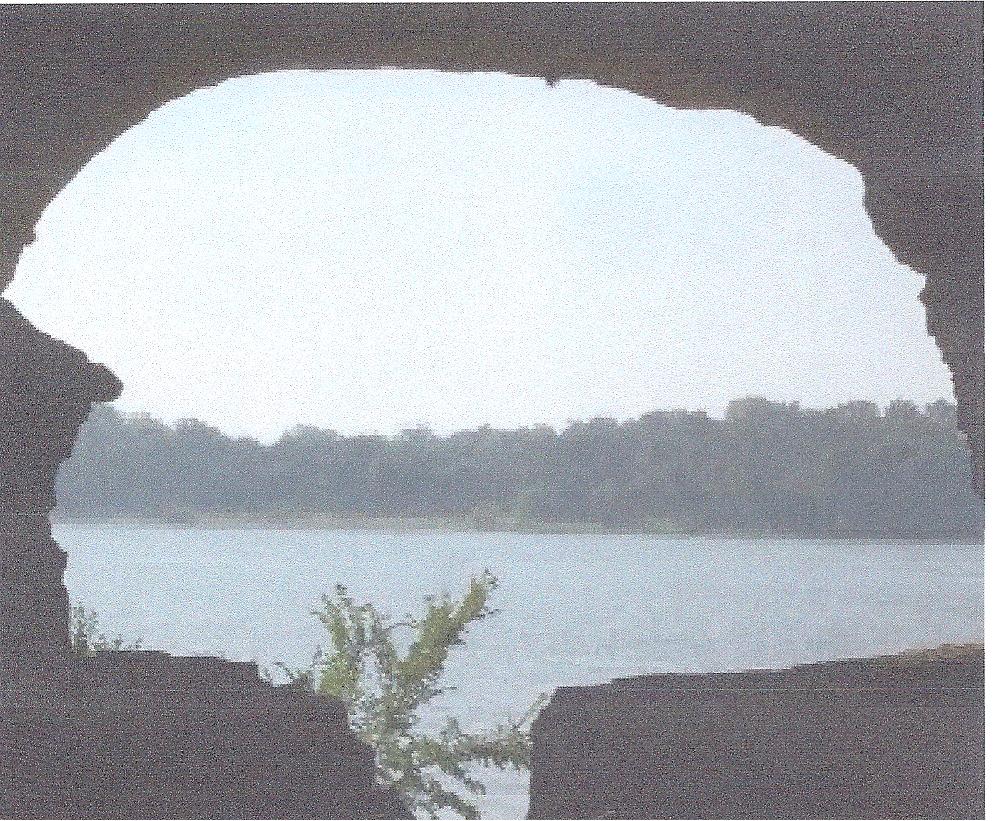 Looking
out from the cave
Looking
out from the cave
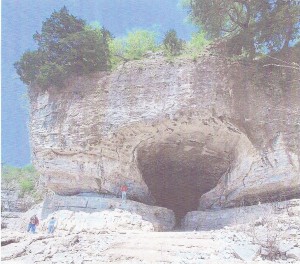 Cave-in-Rock
Cave-in-Rock
Eventually, James Ford was caught for his crimes, but the entire story of his shenanigans is quite fascinating. (To read a more detailed account of this, please see Virginia Roots in Kentucky Soil.)
Presumably, Cassandra and Charles were unaware of the details of how her father obtained his money. Charles worked hard at a thriving medical practice, and the couple had nine children: (1)Mary Susan, (2)Frances Conn, (3) James Philip, (4) Nancy Winifred, (5) Cannie, (6) Charles William, (7) Augusta Ware, (8)Charles Henry Webb III, and (9) another Cassandra.
Charles, a truly devoted son, visited his mother in Kentucky every year. In 1844, he decided to take two of his daughters, Cannie (age 11) and Nannie (age 12), with him for his usual trip. Cassandra, pregnant at the time, stayed home and the other children were either too young to undertake the journey or obligated to school. What should have been an exciting steamboat adventure for the girls turned into a harrowing nightmare. The original account of what happened was written by Augusta Ford Andrews, granddaughter of Dr. Charles Henry Webb. The following are excerpts from her story, kindly provided by descendant Sandra Walker. Again, the entire story may be found in Virginia Roots in Kentucky Soil.
“The devastating event occurred aboard a steamboat called ‘Lucy Walker,’ which was owned by Joe Vann. According to several sources, “at about 5 o’clock on October 23, 1844, the vessel’s engines stopped and she drifted mid-river about 4 or 5 miles below New Albany while some repairs went underway. Suddenly, the steamer’s three boilers exploded in a mighty blast, propelling shards of metal and pieces of human flesh . . . . The vessel caught fire and quickly sank . . . soon the water was filled with bodies of passengers and crew, both the living and the dead. Many were mangled or burned and survived only by rescue efforts of Captain L.B. Dunham and crew of the nearby snag-boat named Gopher. ” (Ref. 1097, 2202) It was a horrendous sight. “This disaster was especially notorious because of the complication of calamities which accompanied it; the explosion itself, the ensuing fire that enveloped what was left after the explosion, and the sinking of the steamboat which resulted in many drowning. Everything happened in such a short space of time that the whole tragedy was completed within a few minutes.” (Ref. 1097, 2202)
“Dr. Webb rushed out on deck. There was another explosion and a piece of metal hit him in the throat. The riverboat was on fire and sinking. Complete pandemonium set in. A passenger caught the two little girls who were running around the deck in their night dresses. He pushed a mattress in the water and put the little girls on it. The mattress started to sink. Nannie told her little sister that they had to get off . . . . They slipped off into the water, one on each corner of the mattress, diagonally . . . . A mattress floating on the water was of no concern. Two little girls at water line didn’t even show up. The sparks from the fire had ignited the mattress. When the fire had burned to the edge and it was too close to hold on any longer, Nannie said, ‘Cannie, don’t be afraid; just hold on until I count to three and we will both let go together.’ Nannie counted to three; they both let go of the mattress and sank below the water. Nannie struggled to break the surface for air and went down again. Just when she was sure she couldn’t make it to the surface again, a man in a small boat looked down and saw something floating in the water. He reached over and grabbed a handful of hair and lifted [her] out of the water. They wrapped her in a rough blanket.
Dr. Webb was with the casualties, but his throat was bandaged and blood had soaked through. “He could not speak and knew he was dying. . . . He motioned for paper and something to write with and wrote: ‘This is my daughter, Nancy Winifred Webb. Please contact my wife, Cassandra Ford Webb.’ (He also wrote) where to reach her. Word was sent to his home and his pregnant wife rode three days on horseback to claim her child and the bodies of her husband and daughter. The baby was born and named Cassandra; she was also called Cannie for her sister who drowned.” (Ref. 475)
 It
is an amazing story of tragedy, heroism, and perseverance. Cassandra
Ford Webb lived 19 more years before her own death on December 6,
1863.
It
is an amazing story of tragedy, heroism, and perseverance. Cassandra
Ford Webb lived 19 more years before her own death on December 6,
1863.
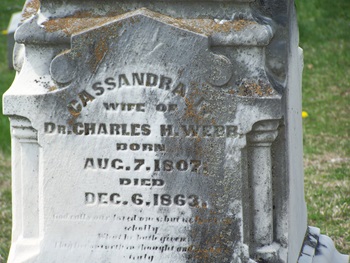 Grave
of Cassandra Ford Webb
Grave
of Cassandra Ford Webb
![]() John
Webb
– On
October 23, 1799, another son was born to Polly
and Charles - - John Webb. Sadly, Polly would lose her husband
before this child was seven years old. The Fayette County Kentucky
Order Book, dated February 1819, shows John “orphan
of Charles Webb, over the age of 14 years, coming into court and made
choice of William Conn for his guardian.” Polly
was raising her
children as a single mother by this time and (since woman held little
rights during those days), it was appropriate to have a male guardian
until the child reached the age of maturity. According to genealogy
law author, John P. Alcock:
John
Webb
– On
October 23, 1799, another son was born to Polly
and Charles - - John Webb. Sadly, Polly would lose her husband
before this child was seven years old. The Fayette County Kentucky
Order Book, dated February 1819, shows John “orphan
of Charles Webb, over the age of 14 years, coming into court and made
choice of William Conn for his guardian.” Polly
was raising her
children as a single mother by this time and (since woman held little
rights during those days), it was appropriate to have a male guardian
until the child reached the age of maturity. According to genealogy
law author, John P. Alcock:
![]() “A
child whose father had died was an orphan in that era, even if her
mother was living. The father in his will could name a guardian or
guardians for his infant children (infant was the legal term for
under age) to manage their estates and arrange for their education.
If he did not do so or if he died intestate, the court could name the
guardian unless the child was 14 or older, in which case he or she
could choose one.”
(Ref.
Alcock)
“A
child whose father had died was an orphan in that era, even if her
mother was living. The father in his will could name a guardian or
guardians for his infant children (infant was the legal term for
under age) to manage their estates and arrange for their education.
If he did not do so or if he died intestate, the court could name the
guardian unless the child was 14 or older, in which case he or she
could choose one.”
(Ref.
Alcock)
It was very kind of William to take on the roll of guardian for Polly’s youngest children. The only other information we have for John Webb is found in Hayden’s genealogy book where he wrote, “Mary Todd Webb’s son, John, lives in Hopkinsville, Kentucky.” (Ref. 6)
![]() Nancy
Webb
–
Polly’s daughter, Nancy Webb (born in 1801), went through the same
legal process her brother had and made the request for William Conn
to be her guardian in January of 1819. Later that year, Nancy
married Dr. Harry (Henry) Eggleston Innes, youngest son of Hugh and
Hannah Eggleston Innes, in Paris, Kentucky. (Ref.
974, 2017, 2201)
Nancy and her husband owned land on Russell Cave Road, and “the
tax record of 1817 for Fayette County showed Dr. Henry Innes with 880
acres of land on the Elkhorn River. A small brick house discovered
in the field on the property was probably the house built by Harry
Innes as his place of residence.”
(Ref. 2017)
According
to a letter sent back to relatives in Virginia sometime after 1820,
Lucy Webb wrote, “Nancy
Innes has four children: Charles, Mary, Frances, and Robert. The
doctor is a very clever, rich man.”
(Ref. 597)
Nancy
Webb
–
Polly’s daughter, Nancy Webb (born in 1801), went through the same
legal process her brother had and made the request for William Conn
to be her guardian in January of 1819. Later that year, Nancy
married Dr. Harry (Henry) Eggleston Innes, youngest son of Hugh and
Hannah Eggleston Innes, in Paris, Kentucky. (Ref.
974, 2017, 2201)
Nancy and her husband owned land on Russell Cave Road, and “the
tax record of 1817 for Fayette County showed Dr. Henry Innes with 880
acres of land on the Elkhorn River. A small brick house discovered
in the field on the property was probably the house built by Harry
Innes as his place of residence.”
(Ref. 2017)
According
to a letter sent back to relatives in Virginia sometime after 1820,
Lucy Webb wrote, “Nancy
Innes has four children: Charles, Mary, Frances, and Robert. The
doctor is a very clever, rich man.”
(Ref. 597)
Some of his great wealth could be seen in the home that Dr. Innes started to build for his son, Charles. “The casual viewer takes little notice of the house in the distance [meaning the home of Dr. Innes] as their eyes are drawn to the stately house closer to the road. This house, called Corinthia, was built for his son, Charles Webb Innes. It is an enormous house with massive columns on the front. The construction of Corinthia was begun in 1832 but took many years to complete.” (Ref. 2017)
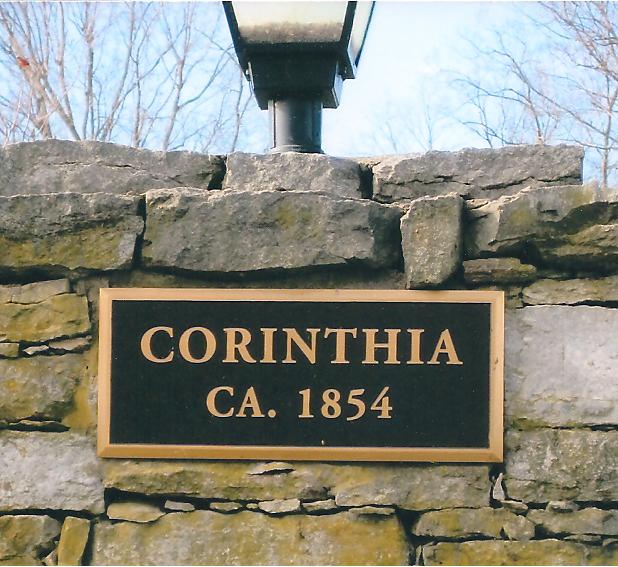
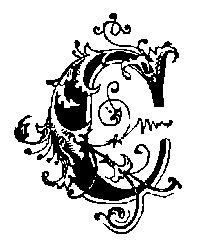
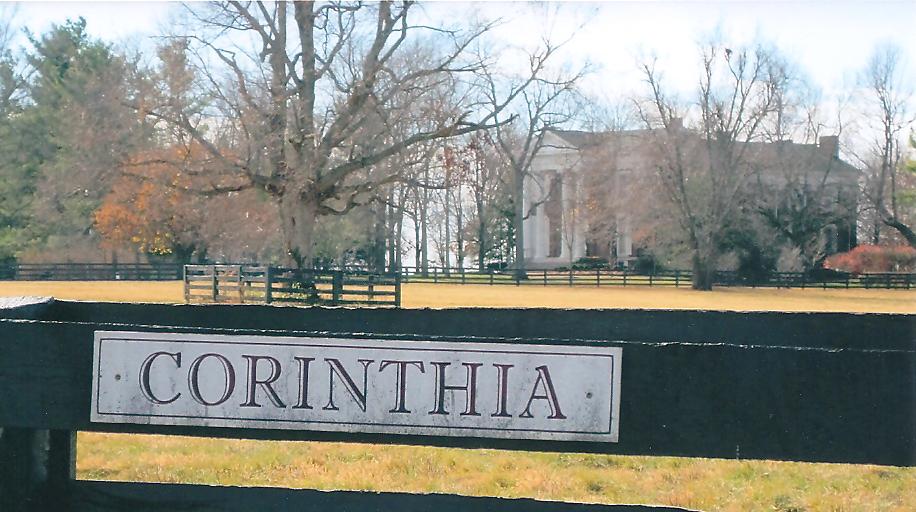
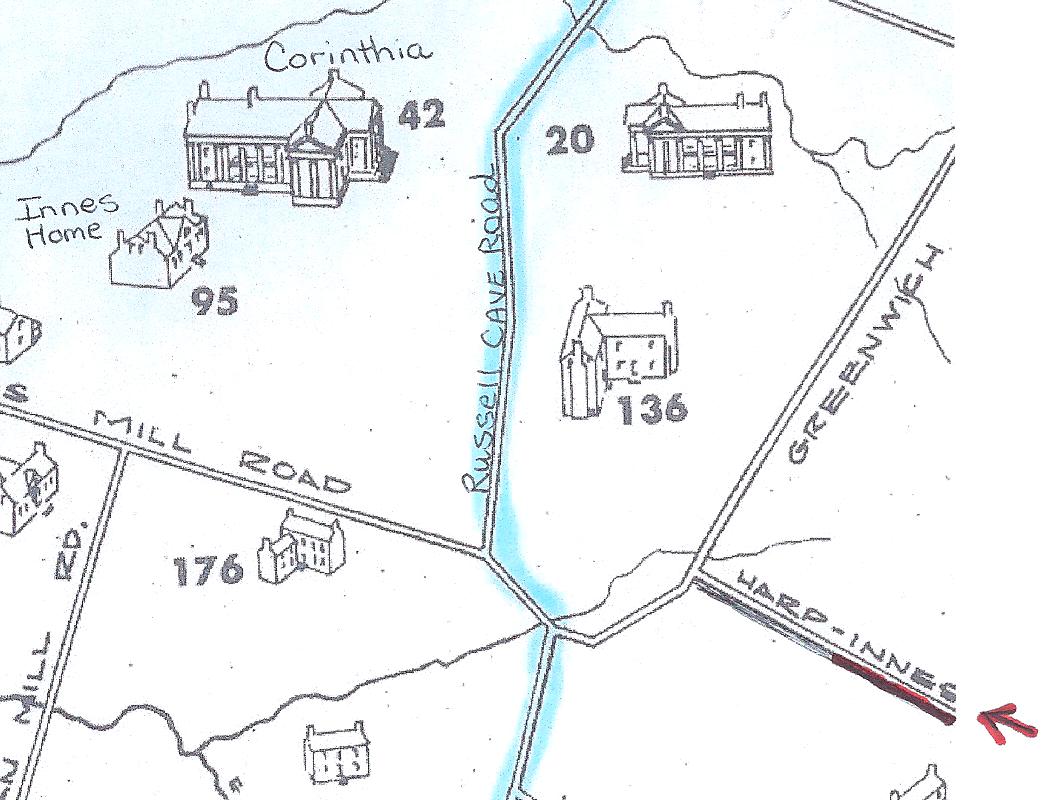
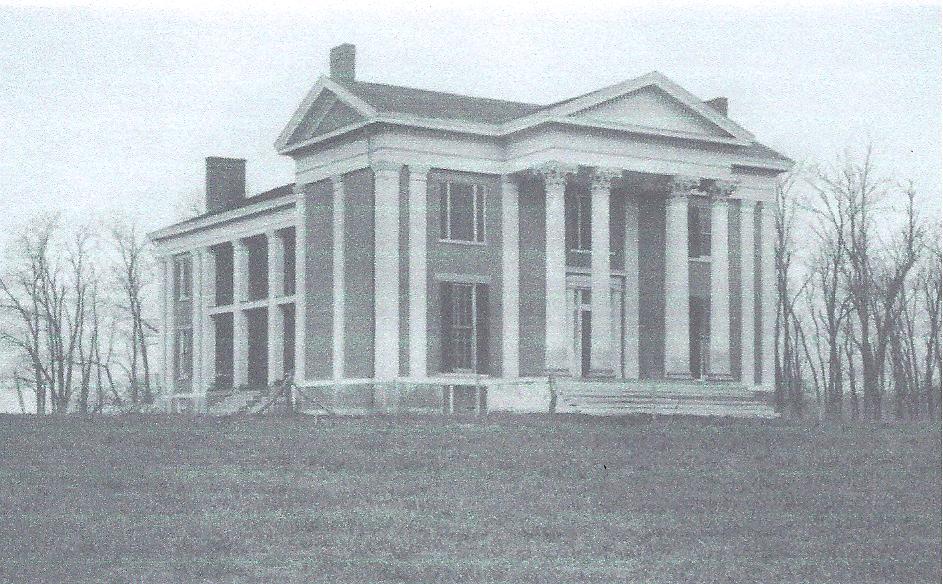
Map showing location of the homes of Dr. & Mrs. Innes and their son, Charles Innes Corinthia in 1898
Nancy’s husband died in 1833 during the cholera outbreak that swept through Kentucky. Since his will stated that “the mansion house and 300 acres went to his widow and the remaining 720 acres were to be divided among his three infant heirs,” one can assume that one of the children must have already died. (Ref. 2201)
![]() Winifred
(Winny) Webb
– In 1804, the last baby was born to Polly
and Charles Webb, a little girl named Winifred. Winny, as she was
called, was only two years old when she lost her father. William
Conn ended up being the guardian for all of Charles Webb’s children
who were minors when both youngest daughters “came
into court and made the choices of William Conn
for
their Guardian.” (Court
record)
Winifred
(Winny) Webb
– In 1804, the last baby was born to Polly
and Charles Webb, a little girl named Winifred. Winny, as she was
called, was only two years old when she lost her father. William
Conn ended up being the guardian for all of Charles Webb’s children
who were minors when both youngest daughters “came
into court and made the choices of William Conn
for
their Guardian.” (Court
record)
On March 23, 1824, Winny married Major George Washington Williams, a “man of prominence in his profession.” (Ref. 589, 621, 2204, 2255) George “served more than 20 consecutive years without a single defeat in both Houses of the Legislature, and in conjunction with Honorable Garret Davis, he represented Bourbon County in the convention which framed the Constitution of Kentucky.” (Ref. 2255, 2203) Some years before the Civil War, George “freed his slaves and was an uncompromising Union man during the war.” (Ref. 2279) This was especially ironic because one of his closest friends was Josiah William Ware of Virginia, Winny’s cousin. Josiah was an influential slave holder with a vast plantation called Springfield.
The Williams family was large - - Winny gave birth to 12 children. One of their many offspring was a daughter, Frances Conn Williams, who married Thomas Henry Clay in 1864. Cousin to the famous orator, Senator Henry Clay, Thomas was “a successful farmer [who] owned 3,000 acres by 1877 and named his farm the Heights.” (Ref. 2290) The following is their wedding announcement from the paper.
![]() MATTERS
MATRIMONIAL
MATTERS
MATRIMONIAL![]()
Mr. and Mrs. Thomas Henry Clay entertained Saturday evening at “The Heights” - their handsome home, in this county with a dinner party which was a very important occasion as it celebrated the announcement of the engagement of the daughter of the house, Miss Nannine Williams Clay, and Mr. Frederick Alfred Wallace. The marriage will take place in the spring. The couple will make their home in Lexington, residing at the Witherspoon House on West Third Street, which was lately purchased by Mr. Wallace. Miss Clay is a great favorite in Blue Grass society, a notable representative of the prominent family to which she belongs and beloved wherever she is known.
Mr. Wallace is general manager for the Northwestern Mutual Life Insurance Company with headquarters at Lexington. He is the son of Mr. and Mrs. Allen N. Wallace of Hopkinsville, the latter a well known journalist of the state and kinsman of ex-vice president Adlai Stevenson. Not only prominent in business and social circles, Mr. Wallace is a leader in philanthropic work, having been appointed at the world’s meeting in London recently as the Kentucky President of the Christian Endeavor Union.
The dinner Saturday evening was notable in the social history of the Blue Grass country for elegance and beauty of detail. A Lexington caterer furnished the elaborate meal, the music was by a Cincinnati orchestra, and lavish and lovely floral decorations came from Louisville. The colors were red and white, and an effect of gorgeousness given to the table with American Beauty roses, many red candles burning, and the beautiful gowns of the company.
The announcement of the engagement of the handsome young couple was made by Miss Kate Alexander, a handsome cousin of Miss Clay and the chosen maid of honor, and immediately, Mr. Chapman Young, toastmaster for the dinner, proposed a toast to the prospective bride and groom, and the responses were bright, eloquent, and full of loving sentiment for the fortunate and happy young couple.
The name cards were works of art and treasured by the company as souvenirs. They were decorated with copies of Gibson girls, the Queen of the feast being a fair type of the American girl we all love so well.
Following is a list of those present at the dinner: Mr. and Mrs. Thomas Henry Clay, Miss Clay, Mr. Wallace, Mr. and Mrs. George Alexander, Mr. and Mrs. John Woodford, Mr. and Mrs. Dwight Pendleton of Winchester, Mr. and Mrs. Thomas Henry Clay, Jr., Misses Kate Alexander, Nannie Clay, Elizabeth Woodford, Amelia Clay, Laura Estill of Lexington, Miss Lutie Williams, Chapman Young of Louisville, John __, Samuel Clay, Ford Hvont, George Williams Clay, Dr. John Sweeney, Duncan Bell, Dexter Clay, Ayletia Buckner.
In later years, Mrs. Frederick A. Wallis (the daughter of Thomas and Frances Williams Clay) became a state regent and historian for the DAR headquarters in Paris, Kentucky. She dedicated a room for her mother called the “Frances Conn Williams Clay Room.” (See photo below)
![]()
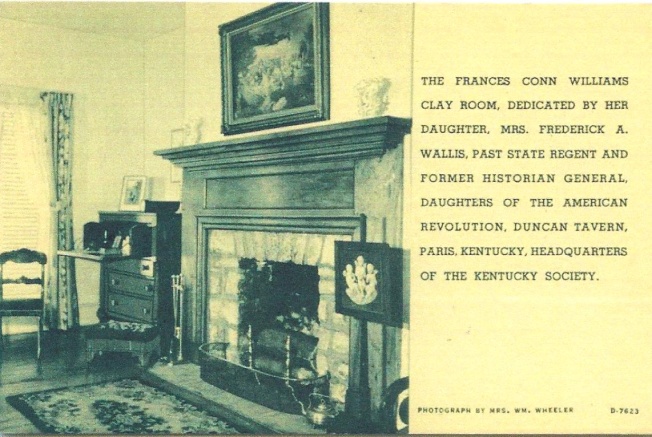
![]()
Frances Conn Williams Clay Room
Another Williams daughter, Nancy M. Williams, (known as Nannie) married Colonel John A. Prall on September 23, 1851. According to his obituary, “before and during the Civil War, he was one of the most prominent lawyers in the state.”
Marriage record
![]()
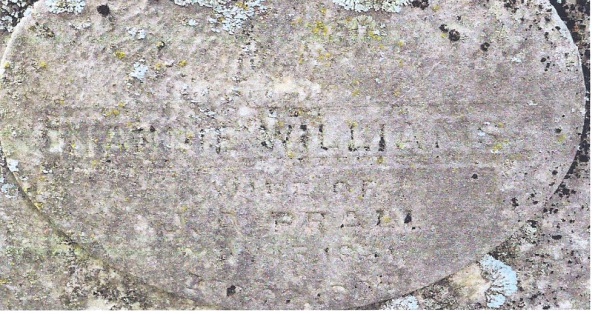 Grave
for Nannie Williams Prall
Grave
for Nannie Williams Prall
![]()
After Polly and Charles Webb settled on their land in 1791, they became active members of the David’s Fork Baptist Church which “became an independent church on August 26, 1801.” (Ref. 2209)
David’s Fork
Baptist Church circa 1940s (Ref.
965) David’s
Fork Baptist Church 2010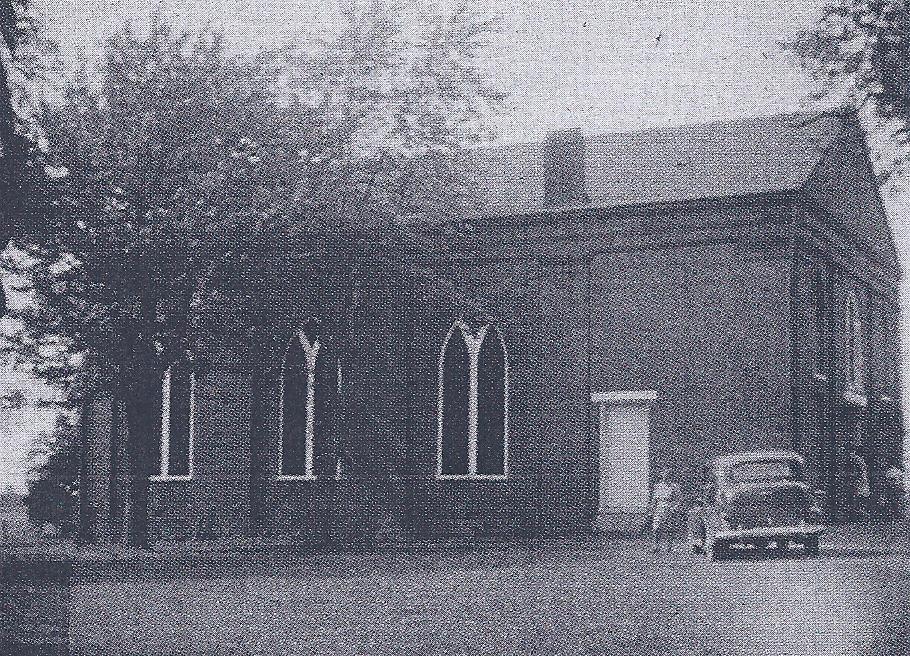
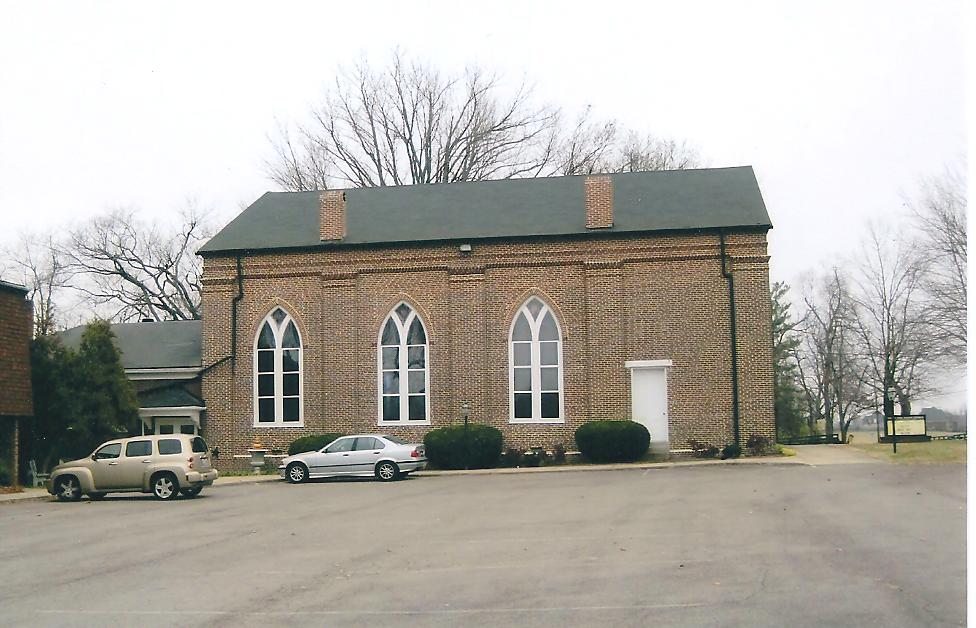 David’s
Fork Baptist Church as of 2010 All
2010 photos taken by James and Judy Ware
David’s
Fork Baptist Church as of 2010 All
2010 photos taken by James and Judy Ware
Charles Webb died in 1806, leaving his 34-year old wife to raise their children alone. Her brother, Thompson, once wrote, “Your Aunt Polly Webb is a widow and I suppose will never marry again.” (Ref. 35E) He was right. Polly lived to be 82, outliving not only her husband, but most of her children. She died “after Christmas, on December 29, 1854 of paralysis.” (Ref. 970)

4. Lucy Catherine Ware - By 1773, Dr. James and Caty Todd Ware had three youngsters (Thompson, James, and Polly) running around the house - all under the age of five. Grandparents James and Agnes were both approaching sixty. Dr. Ware was 32 years old and Caty (who had just recently turned 20) was having another baby. Their newest addition to the family arrived on November 12th and was named Lucy Catherine, a name that would be carried on for many generations.
The whole time Caty was pregnant with Lucy, the colony of Virginia continued to hold its’ breath as relations with Great Britain grew more tense with each passing day. Lucy’s entire childhood would be spent in an atmosphere of war. By her pre-Christmas wedding on December 23, 1790, however, the conflict was finally over. President George Washington had been in office for one year, and the place of her birth was no longer called a ‘colony’ but a ‘state.’ It was a time of new beginnings.
Lucy married one year before her older sister, Polly. Her husband was Captain Isaac Webb, brother of Charles Webb, who would marry Polly in 1791. Isaac “was an officer in the 7th Virginia Continental Line and served as a captain under Green in the 14th campaign.” (Ref. 2, 621,934) Lucy was 17 at her wedding and Isaac (born in 1758) was 32. (Ref. 621, 1067)
Years later, a relative, Josiah Ware, described Isaac Webb as being “a very small man, of an active figure.” (Ref. 174, 638) Especially close to Lucy, Josiah stated she was “very fine-looking; and had as fine a face as you ever saw, full of kindness and benevolence.” (Ref. 638) The family corresponded often over the years, and in 1827, Josiah mailed some strawberry seeds to Lucy’s daughter, advising her that “she must be very careful in opening the letter or she will lose them as they are very small.” In a different letter, written in 1830 to cousin George W. Williams, Josiah teasingly lamented that the mail “brought me only one letter - that from Aunt Lucy Webb. Now is this very astonishing? That out of all my kith and kin only two of them seem to be aware of my existence and these two are of the oldest generation of Uncle Charles [Ware] and Lucy Webb.” Josiah, grandson to Dr. James Ware and Caty, remained one of the strongest links between the Virginia and Kentucky Wares.
James and his son-in-law, Isaac, became close friends in Virginia, and that friendship played a major role in the families moving to Kentucky together. Lucy’s husband, having also been awarded a land grant by the government for service in the Revolutionary War, “had acquired a great deal of land in Fayette and Bourbon counties of Kentucky.” (Ref. 174) In a family letter, it was stated that he “owned nearly all the land Cincinnati was built upon and a great part of the land Lexington was built upon.” (Ref. 2) It is interesting to note that the actual documents he obtained “were signed by both Thomas Jefferson and James Madison.” (Ref. 174)
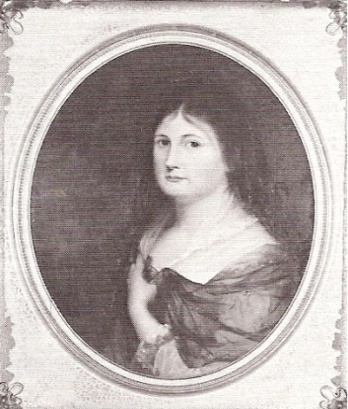 Lucy
Ware Webb –
daughter of Caty and Dr.
James Ware
Lucy
Ware Webb –
daughter of Caty and Dr.
James Ware
![]() From
Virginia
Roots in Kentucky Soil:
From
Virginia
Roots in Kentucky Soil:
“The Ware and Webb families were now joined by two marriages, making it logical for them to travel together and build their homes in close proximity to each other; thereby claiming vast strongholds in this new ‘land of promise’ called Kentucky. Property was wealth, and the two families now had a lot of Bluegrass acreage. . . . Once the great move was made from Virginia to Kentucky, James and Caty must have been pleased when Isaac and Lucy settled close by. Thompson and Polly put down their roots in the Paris/Centerville area, as did Polly and Charles. Lucy and Isaac, however, chose their land in Fayette County. In fact, the Ware and Webb properties were both located near Antioch Pike.”
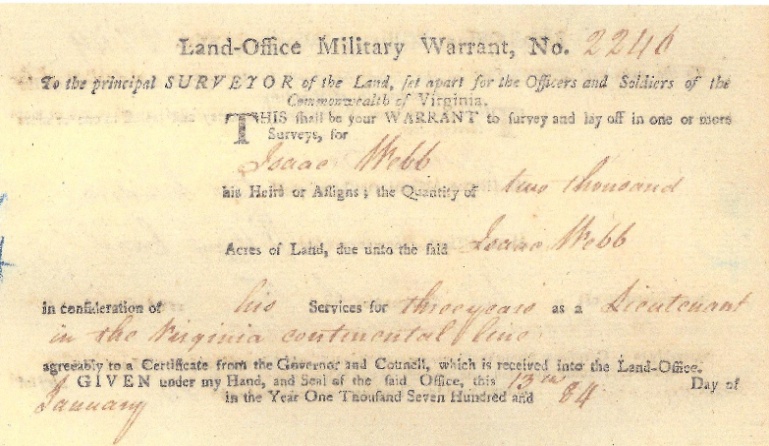
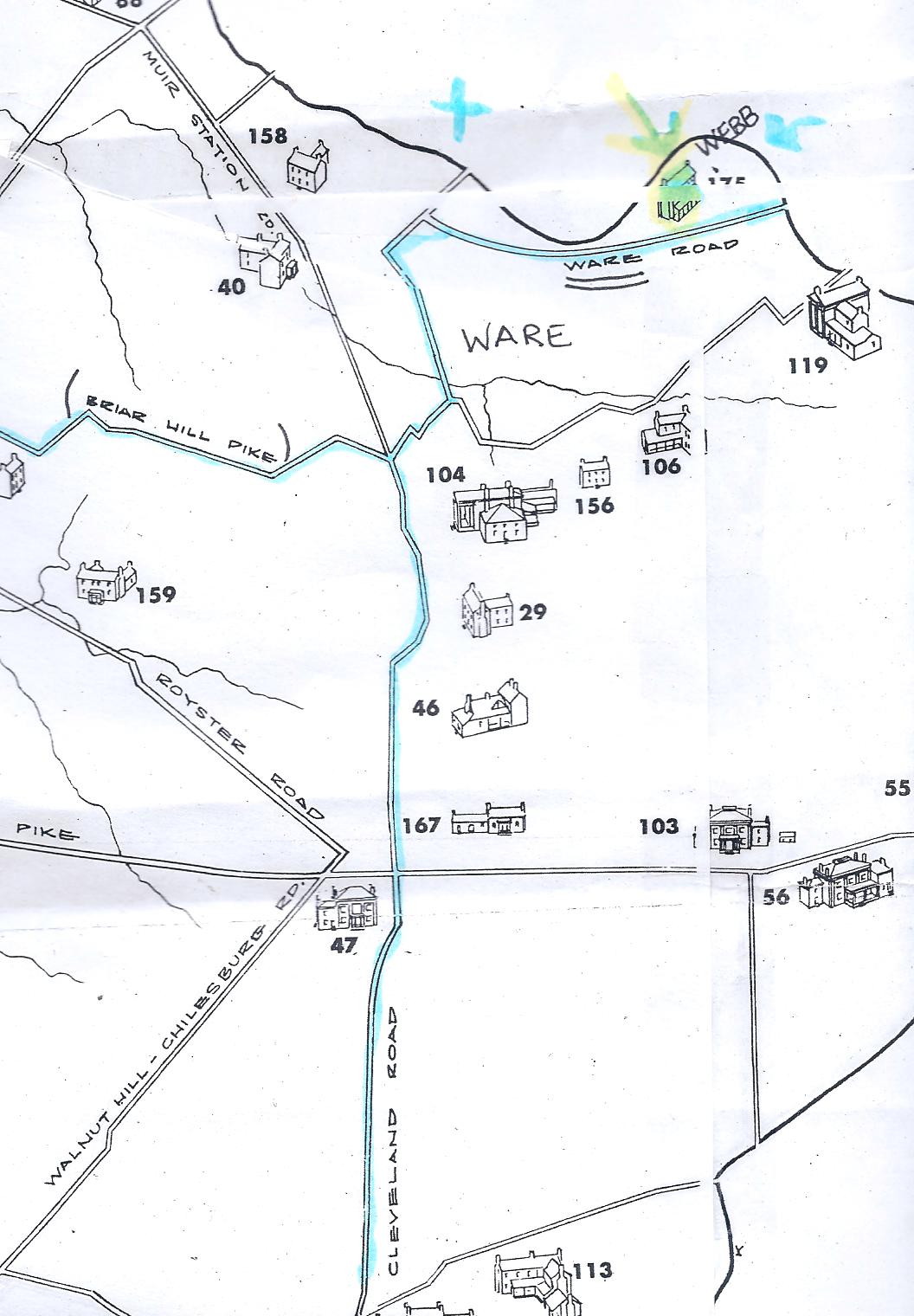 Land
warrant for Isaac Webb
Land
warrant for Isaac Webb
Old map showing Ware/Webb properties located off Briar Hill Pike and Ware Road
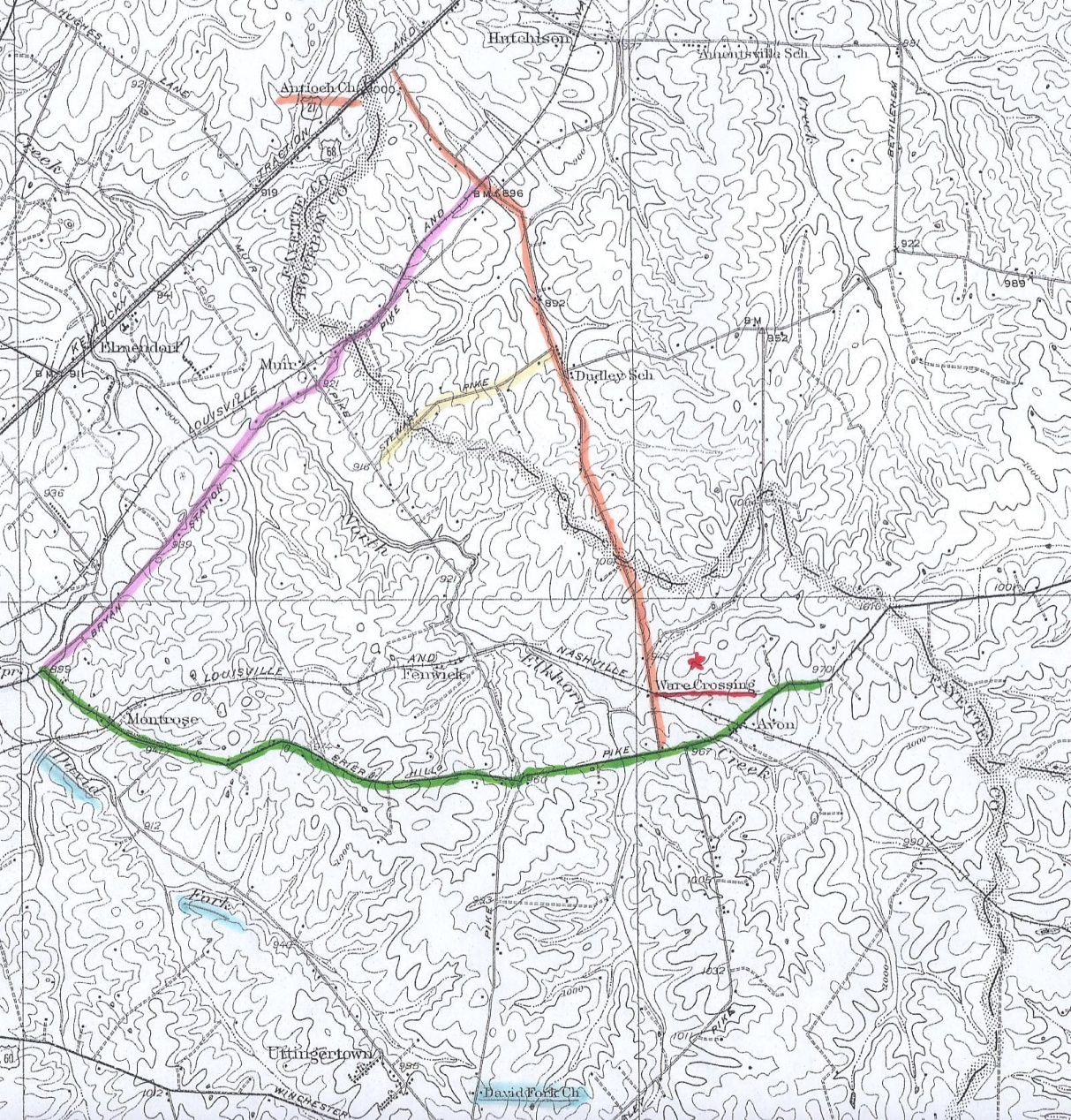
Maps showing location of James Ware land – Courtesy of the Kentucky Historical Society
Bryant Station Pike Briar Hill Pike Ware Crossing David’s Fork Stewart Houston-Antioch
**Notice the locations of Antioch Church, David Fork Church, and Ware Crossing
Lucy and Isaac had a large family. The following gives information about each, but a more detailed account can be found in Virginia Roots in Kentucky Soil.
![]() Catherine
(Kitty) Webb
–
Kitty,
born on September 15, 1791, was most likely named after her
grandmother, Caty Todd Ware. Since the family move to Kentucky
occurred in the spring of 1791, and they did not arrive at their
destination until June of that year, Caty Todd must have been
pregnant while they were making this harrowing journey. Kitty’s
birth came only three months after the weary Virginia travelers
reached Kentucky.
Catherine
(Kitty) Webb
–
Kitty,
born on September 15, 1791, was most likely named after her
grandmother, Caty Todd Ware. Since the family move to Kentucky
occurred in the spring of 1791, and they did not arrive at their
destination until June of that year, Caty Todd must have been
pregnant while they were making this harrowing journey. Kitty’s
birth came only three months after the weary Virginia travelers
reached Kentucky.
On January 31,
1814, Kitty Webb married James Conn, brother of both William Conn
(husband of Fanny Webb) and Sallie Conn (wife of Kitty’s Uncle
Thompson.)
Kitty
was 23, and James was 28.
(Ref.
941)
![]()
 Fayette Co. court record showing marriage of James Conn & Kitty
Webb was bonded by James Webb.
Fayette Co. court record showing marriage of James Conn & Kitty
Webb was bonded by James Webb.
Later that year, as the nation was embroiled in the War of 1812, James Conn did his military service. Attaining the rank of captain, he “led a company from September 10, 1814 to October 9, 1814, under the command of Lt. Col. Andrew Porter.” (Ref. 1055)
Kitty and James had five children; four sons and one daughter. In a letter to Sally Ware in 1819, Kitty wrote of her sons, “My first I call John Scott [Conn] after Dr. Scott of Frankfort, my second is named Webb [Conn] after my father, my third is Joseph Scott [Conn] after Dr. Scott formerly of Chillicothe (the doctor is now living in Frankfort), and Thomas [Conn] after Grandfather Conn. My second son, Webb, I had the misfortune to lose (last March was a year) with whooping cough and measles.” (Ref. 35D) Kitty delivered a baby girl, Catherine, shortly after this letter was sent - - the newborn named after both her mother and grandmother. Kitty died before her daughter ever reached her first birthday.
After six years of marriage, Kitty (Catherine) Conn became one of the victims of an outbreak of cholera. She died on May 10, 1820.
![]()

![]() (Ref. 621)
Bible entry
for Kitty (Catherine) Conn
(Ref. 621)
Bible entry
for Kitty (Catherine) Conn
Captain Conn, now a widower, decided to leave Bourbon/Paris County and relocate to Blue Licks in Nicholas County. He had “inherited the old homestead place of his fathers, but he sold the property to his brother, William Conn, before moving.” (Ref. 941) Kentucky records indicate he relocated “to Nicholas County, Kentucky, where he was living in 1882 and where he probably lived out his life.” (Ref. 941) James remarried in 1823 and had four additional children with his new wife, Martha H. (Patsy) Throckmorton. (Ref. Debbie McArdle, wife of James Talbot McArdle, of Crystal Lake, IL.)
Kitty’s mother, Lucy, gave a written account of what happened to the Conn children after her daughter’s death:
“Kitty’s oldest son, John, is living with James Webb. [James] got me to write to his father [James Conn] that if he would let him have John, he [referring to James Webb] would educate him and give him whatever professional character his talents would best suit. He sent him [John]. Kitty [baby Catherine] is living with me. The other two children, Joseph and Thomas, are with him [James Conn] – to my sorrow. I wrote a letter to him [James Conn] the other day that if he would give up their mother’s [Kitty’s] property that Mr. Webb [Lucy’s husband and Kitty’s father] gave her, though it’s but little, we would take the other two boys and educate them and insure to them the property when they came of age. But I did not send it, knowing it would displease him very much.” (Ref. 597)
Even though Lucy could not visit with her grandsons as much as she would have liked, James Conn did provide well, and equally, for all of his children. Papers kindly provided by fellow researcher, Karin Rice, clearly stipulate how much land was to be allotted to each child after his wife’s dower was taken out. (See below)
![]()
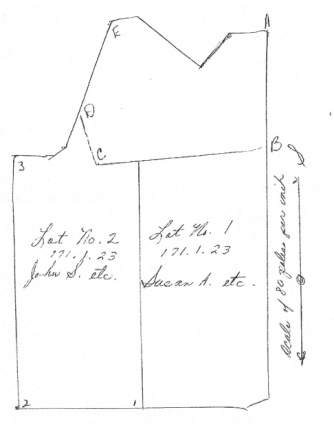
![]() Chart
given courtesy of Karin Rice (Ref.
2268)
Chart
given courtesy of Karin Rice (Ref.
2268)
“Lot #1 went to the children for James’ second marriage, and Lot #2 went to the children he had with Kitty.” (Ref. 2268)
James Conn spent the remainder of his life in Nicholas County. The inscription on his tombstone, found by Bill Wheaton in the Throckmorton Cemetery in 1999, reads as follows:
James
Conn, Died June 22, 1833, aged 47 years, 1 month, 17 days
![]() He died as he lived; a Christian.”
(Ref.
2268, 2269)
He died as he lived; a Christian.”
(Ref.
2268, 2269)
Of the children of James Conn and Kitty, we know their daughter, Catherine, married Robert Innes on April 14, 1847. Robert served as a Representative of Franklin County in the Virginia House of Delegates for several years. (Ref. Woods) The couple “lived in a house on 2nd street in Lexington.” (Ref. 174, 689)
![]()
![]() Fayette
County court record showing marriage of Robert Innes and Catherine
Conn.
Fayette
County court record showing marriage of Robert Innes and Catherine
Conn.
Grave of Robert Innes and his wife, Catherine Conn Innes
![]()
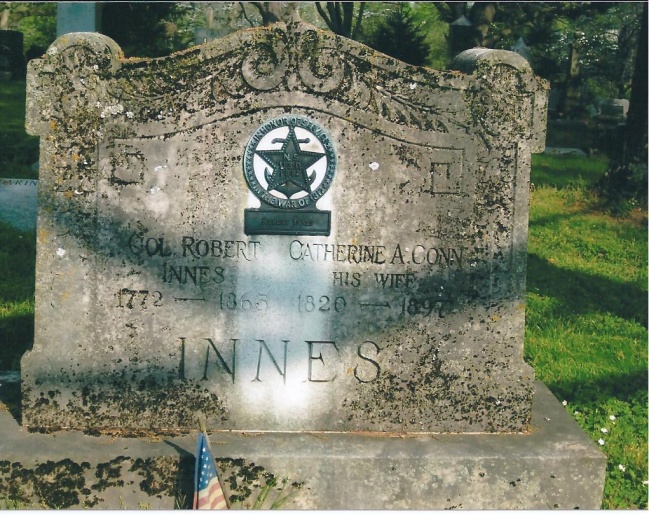
![]()
Kitty’s son, John Scott Conn, served in the Confederacy and lived a long life. His obituary appeared in “The Western Citizen” newspaper:
![]() JOHN
SCOTT CONN DEAD – Capt.
John Scott Conn, a distinguished Confederate Soldier, and one of the
oldest residents of Louisville, died this morning at the residence of
his niece, Mrs. T.M. Swann, 1215 Fourth Street, in his ninetieth
year. Capt. Conn was born in Bourbon county April 25, 1815, the
son of Catherine Webb and [James] Joseph Conn . . .
he was taken to Chillicothe,
Ohio, where he made his home with his uncle, Dr. James Webb, who was
the father of Mrs. Rutherford B. Hayes. Returning to Kentucky as a
young man, he was graduated at Bacon College, one of Kentucky’s
early institutions, at Harrodsburg, but not now in existence. He
established himself in the practice of law in Bourbon and Fayette
counties. At the outbreak of the Civil War, he enlisted in the
Confederate Army, and later became Captain in Col. Richard Gano’s
Regiment of Morgan’s Brigade. He was captured and held prisoner at
Camp Douglas. When offered his freedom if he would take the oath of
allegiance, he indignantly refused. He was never reconstructed, and
always declined to take any part in Confederate reunions or other
celebrations, holding aloof on the ground that he ‘could never
jollify over his defeat.’ After the war, Mr. Conn settled down to
practice law in Centerville, Bourbon County, and later removed to
Lexington. He retired from practice twenty years ago and made his
home with his sister, Mrs. Robert Innes. He came to Louisville six
years ago, and had since that time made his home with his niece, Mrs.
Thomas M. Swann . . . . In spite of his advancing years, Mr. Conn had
been in excellent health lately, though troubled at times with
dropsy, for which he had sustained several apparently beneficial
operations. Last night he sat up late chatting with his nephew, Mr.
Ed Bacon, and several members of his family. He expressed himself as
feeling particularly well. This morning he failed to appear at
breakfast, and a servant was dispatched to find out the cause of his
absence. It was found that he had fallen on the floor of the bathroom
. . . the body will be taken to Lexington on the Southern train
arriving there at 10:40, where it will be buried at once.
JOHN
SCOTT CONN DEAD – Capt.
John Scott Conn, a distinguished Confederate Soldier, and one of the
oldest residents of Louisville, died this morning at the residence of
his niece, Mrs. T.M. Swann, 1215 Fourth Street, in his ninetieth
year. Capt. Conn was born in Bourbon county April 25, 1815, the
son of Catherine Webb and [James] Joseph Conn . . .
he was taken to Chillicothe,
Ohio, where he made his home with his uncle, Dr. James Webb, who was
the father of Mrs. Rutherford B. Hayes. Returning to Kentucky as a
young man, he was graduated at Bacon College, one of Kentucky’s
early institutions, at Harrodsburg, but not now in existence. He
established himself in the practice of law in Bourbon and Fayette
counties. At the outbreak of the Civil War, he enlisted in the
Confederate Army, and later became Captain in Col. Richard Gano’s
Regiment of Morgan’s Brigade. He was captured and held prisoner at
Camp Douglas. When offered his freedom if he would take the oath of
allegiance, he indignantly refused. He was never reconstructed, and
always declined to take any part in Confederate reunions or other
celebrations, holding aloof on the ground that he ‘could never
jollify over his defeat.’ After the war, Mr. Conn settled down to
practice law in Centerville, Bourbon County, and later removed to
Lexington. He retired from practice twenty years ago and made his
home with his sister, Mrs. Robert Innes. He came to Louisville six
years ago, and had since that time made his home with his niece, Mrs.
Thomas M. Swann . . . . In spite of his advancing years, Mr. Conn had
been in excellent health lately, though troubled at times with
dropsy, for which he had sustained several apparently beneficial
operations. Last night he sat up late chatting with his nephew, Mr.
Ed Bacon, and several members of his family. He expressed himself as
feeling particularly well. This morning he failed to appear at
breakfast, and a servant was dispatched to find out the cause of his
absence. It was found that he had fallen on the floor of the bathroom
. . . the body will be taken to Lexington on the Southern train
arriving there at 10:40, where it will be buried at once.
![]()
John had remained a bachelor all his life and was almost 90 years old at the time of his death.
![]()
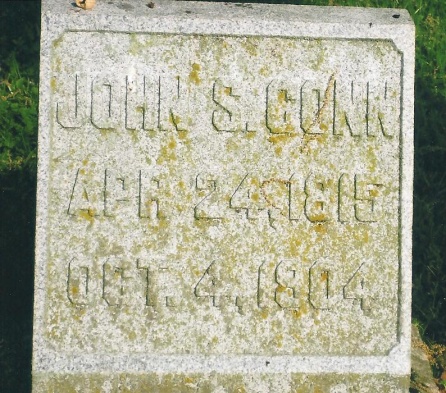
![]() Grave
for John S. Conn
Photo courtesy of James and Judy Ware 2012
The
death year was mistaken – it was actually 1904.
Grave
for John S. Conn
Photo courtesy of James and Judy Ware 2012
The
death year was mistaken – it was actually 1904.
![]() Winny
Webb
– Lucy delivered her next daughter, Winny, on January 28, 1793.
She would marry Mathew Thompson Scott, called “Thompson” by
family members, on June 12, 1811. In a letter from James Ware II, he
wrote, “Thompson
Scott was married to Winny Webb the 12th
of the month.”
(Ref. 35E)
Winny
Webb
– Lucy delivered her next daughter, Winny, on January 28, 1793.
She would marry Mathew Thompson Scott, called “Thompson” by
family members, on June 12, 1811. In a letter from James Ware II, he
wrote, “Thompson
Scott was married to Winny Webb the 12th
of the month.”
(Ref. 35E)
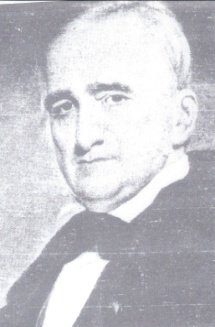 Mathew Thompson Scott
- courtesy
of Bill LaBach (Thompson
Scott was also referred to as Mathew Scott and M. T. Scott in many
incidences.)
Mathew Thompson Scott
- courtesy
of Bill LaBach (Thompson
Scott was also referred to as Mathew Scott and M. T. Scott in many
incidences.)
Mathew, born in Pennsylvania, “came to live with his relative, Dr. John Mitchell Scott of Frankfort” when his parents died. (Ref. 966, 2261) Prior to his marriage to Winny, he had embarked upon a banking career. He “became a clerk in the Lexington branch of the Bank of Kentucky in 1808. After his marriage, he subsequently obtained the position of teller, then cashier, in the United States Bank. When that bank was taken up by Northern Bank of Kentucky in 1835, he became a cashier in the new bank. Mathew Scott became President of the Northern Bank of Kentucky and served in that capacity for six years before his death in 1858. He was also the first treasurer of the Lexington Cemetery Company.” (Ref. 485, 796, 990, 974)
As his lucrative career prospered, Thompson and Winny watched their family grow. They had 14 children: James W. Scott (1811), Elizabeth (Betsy) Thompson Scott (1813), Isaac Webb Scott (1814), Lucy Catherine Scott (1816), Mary Dewees Scott (1817), Lucy Webb Scott (1819), John William Scott (1821), Winny Webb Scott (1822), Matthew Thompson Scott ( 1823), Margaret Scott (1824), Lucy Ware Scott (1826), Joseph Scott (1829), William Nicholson Scott (1831), and William Thompson Scott (1833). (Ref. 477) (For details on all these children, please refer to Virginia Roots in Kentucky Soil)
Sadly, the last child born to Winny arrived during one of the most devastating cholera outbreaks in Kentucky history. “About the 1st of June, the cholera made its appearance, and in less than ten days, fifteen hundred persons were prostrated and dying at the rate of fifty a day. An indescribable panic seized the citizens, half of whom fled from the city, and those who remained were almost paralyzed with fear.” (Ref. 687) Naturally, Winny was terrified. In her last weeks of pregnancy, the couple had to bury their two-year old son, William Nicholson. The new baby, born on June 23rd, was also named William, in honor of the toddler. On July 8, 1833, about two weeks after giving birth, poor Winny died of cholera as well. She was 40 years old at the time, and her death left M. T. Scott with a house filled with children. Family pitched in to help, and Winny’s sister-in-law, “Maria [Cook Webb], took the baby who was William and weaned her own child, Lucy [Lucy Ware Webb Hayes] who was two years old. The cholera was at its height at that time.” (Ref.1)
Mathew Thompson Scott managed to survive the epidemic and marry again three years later. His new wife was another daughter of Lucy and Isaac Webb. Elizabeth (Betsey) Frances Webb was the youngest sister of Winnie, and she was 20 years younger than Mathew at the time of their marriage. They had a very happy life together before Mathew died on August 20, 1858, at the age of 72.
![]()
![]()
![]()
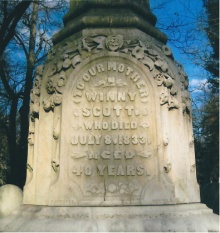 Winny
Scott
Winny
Scott
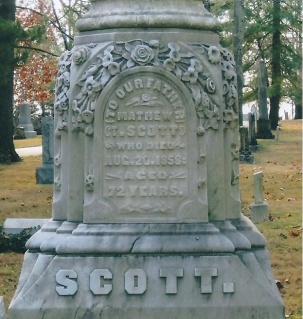 Mathew
T. Scott
Mathew
T. Scott
The graves below are for the children of Mathew and Winny Scott.
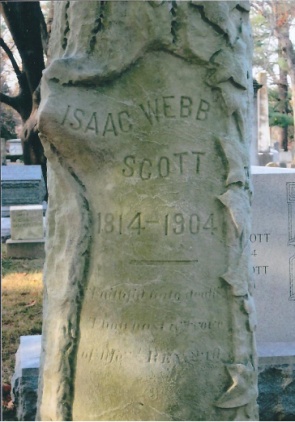
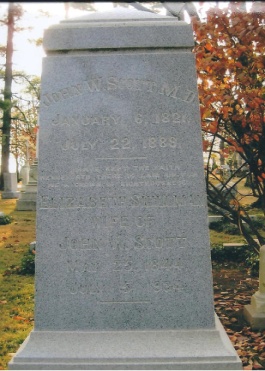
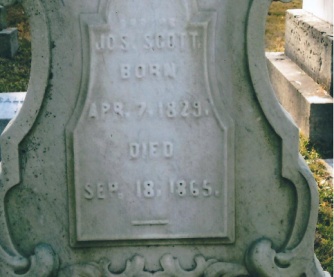
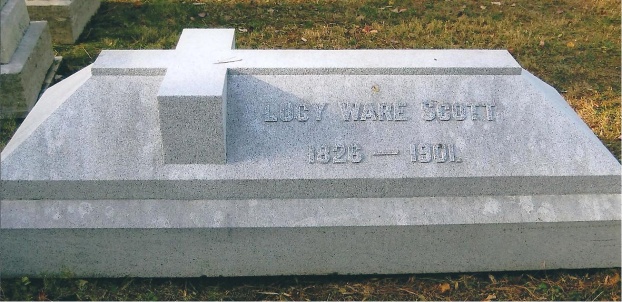
Isaac Webb Scott John William Scott Joseph Scott Lucy Ware Scott
Photos by Judy Ware 2010
![]() James
Webb –
Lucy
and Isaac welcomed their first son on March 17, 1795. They named him
James, in all likelihood out of respect for both Lucy’s father and
grandfather. Lucy was now 22, and her other children, Kitty and
Winny, were four and two years old, respectively.
James
Webb –
Lucy
and Isaac welcomed their first son on March 17, 1795. They named him
James, in all likelihood out of respect for both Lucy’s father and
grandfather. Lucy was now 22, and her other children, Kitty and
Winny, were four and two years old, respectively.
James studied medicine in Lexington, Kentucky, and practiced in Chillicothe, Ohio. Having served in the military at the young age of 17, he was a veteran of the War of 1812. He wed Maria Cook in 1826. Josiah Ware, a cousin, once noted that “Dr. James Webb was a very handsome man. He had black hair and dark eyes, and was tall and straight.” (Ref. 638) James and Maria had two sons, Joseph Thompson Webb and James Dewees Webb. The boys were joined by a sister in 1831 - named Lucy Ware Webb after her paternal grandmother. Dr. Webb, unfortunately, would die before his daughter ever got the chance to know him. Lucy was two years old when the cholera epidemic claimed her father’s life, as well as so many others in her family. In a letter to President Hayes from Isaac Scott, he wrote in reference to his uncle, James Webb: “He died at my father’s [Mathew Thompson Scott] house during the terrible scourge of the cholera in July 1833. I sat by his bedside and nursed him during his illness of 8 days and nights, never taking off my clothes as there was so many sick we could not get help. We had four sick at the same time. My mother [Winny] died a few days before Uncle James.” (Ref. 296)
There were three children born to James and Maria before the epidemic struck – two sons (Joseph Thompson Webb and James DeWees Webb) and a daughter named Lucy Ware Webb. Both boys grew up to be doctors, and Lucy became quite famous in her own right after becoming the wife of a future president of the United States.
In a time when few women were encouraged to broaden their minds, Lucy Ware Webb had “attended the new Wesleyan Female College in Cincinnati at the age of 16.” (Ref. 2251) When a promising lawyer named Rutherford B. Hayes first met her, he was as much attracted to her bright intellect and inquisitive mind as to her beauty. The couple eventually married in Ohio in 1852. According to a description of the event, “the ‘radiant’ bride looked beautiful in her white-figured satin dress, simply tailored with a full skirt pleated to a fitted bodice. She wore a floor-length veil, fastened with orange blossoms. It accented the glistening blackness of her hair and the slimness of her figure.” (Ref. 2250)
Rutherford and Lucy were strongly opposed to slavery, so Hayes fought proudly for the North during the Civil War. When peace came, Rutherford decided to pursue a career in politics. After serving as governor of Ohio, he was nominated by the Republican party for the presidency of the United States. Although it was not a landslide election, he did win, and he and Lucy headed to the White House with several small children in tow. The following is an excerpt from Virginia Roots in Kentucky Soil:
“Lucy became one of the most beloved first ladies in American history. Her sweet nature charmed all who came to know her. Even though she had her strong convictions on issues such as ‘no alcohol served in the White House,’ the nation fell under her spell. Nicknamed ‘Lemonade Lucy,’ she made no apologies for her beliefs. There were some among the Washington elite who complained at first, but ‘Lucy’s courage in adopting a controversial policy for White House entertaining helped to convince people of the honesty and sincerity of the president and the First Lady.’ (Ref. 2250) With her tiny stature (she was only five foot, four inches tall), her beautiful black hair, and kind brown eyes, ‘Lucy Hayes was one of the most personally popular of all of America’s First Ladies.’” (Ref. 633, 2251)
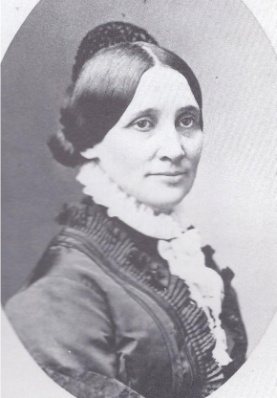
![]()
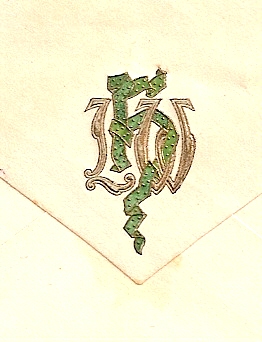 Monogram
of Lucy Ware Webb Hayes
Monogram
of Lucy Ware Webb Hayes
Lucy Ware Webb Hayes Owned by James and Judy Ware Rutherford and Lucy celebrated 37 years of marriage before Lucy died of a stroke in 1889, at age 58. (Ref. 357) Because her father (James) and both paternal grandparents (Lucy and Isaac), had passed away in the cholera epidemic of 1833, they never got to know what a remarkable woman she turned out to be.
Being the great granddaughter of James and Caty Todd Ware, Lucy was therefore the great-great-granddaughter of James and Agnes Ware.






































































































































































![]() Isaac
Webb III
–
Lucy and Isaac had
their
fourth child in 1797, naming their new son Isaac Webb III after both
his father and grandfather Webb. Isaac married Louisa Harrison Jones
and the couple had four children: (1) Lucy Webb (1824), who married
Dr. Robert W. Bush; (2) Edward Webb, who died in 1833; (3) Isaac Webb
IV (1831), who married Miss Gray and died in 1898; and (4) Frances
Webb (1828). In an early letter written by Lucy, she stated, “Isaac
has two children; Lucy and Edward [who]
live ½ mile from him on Miss Winney Webb’s farm.”
(Ref. 597)
She was probably referring to the spinster sister of her husband,
Isaac. Isaac Webb III died on the same day as his father during the
cholera epidemic.
Isaac
Webb III
–
Lucy and Isaac had
their
fourth child in 1797, naming their new son Isaac Webb III after both
his father and grandfather Webb. Isaac married Louisa Harrison Jones
and the couple had four children: (1) Lucy Webb (1824), who married
Dr. Robert W. Bush; (2) Edward Webb, who died in 1833; (3) Isaac Webb
IV (1831), who married Miss Gray and died in 1898; and (4) Frances
Webb (1828). In an early letter written by Lucy, she stated, “Isaac
has two children; Lucy and Edward [who]
live ½ mile from him on Miss Winney Webb’s farm.”
(Ref. 597)
She was probably referring to the spinster sister of her husband,
Isaac. Isaac Webb III died on the same day as his father during the
cholera epidemic.
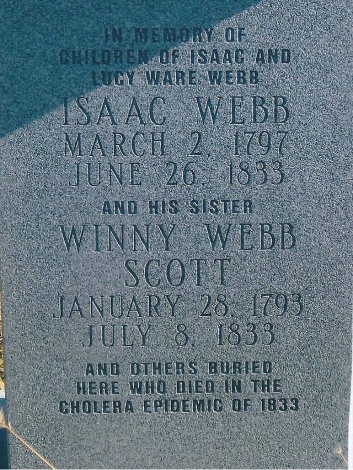
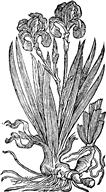
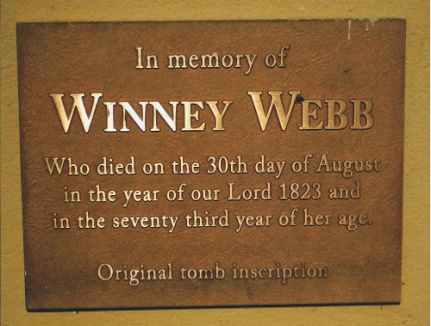
Marker for the children of Lucy and Isaac Webb Sister of Isaac Webb
![]() Lucy
Caroline Webb
–
In
1799,
another daughter was born into the household. This time the child
was a namesake for Lucy; her full name being Lucy Caroline Webb. In
1817, Lucy Caroline became the bride of Dr. Joseph Thompson Scott -
the younger brother of Dr. John Mitchell Scott who had married Lucy’s
aunt, Catherine Ware. Joseph, as his brother before him, went into
the medical profession. He set up his early practice in Chillicothe,
Ohio, where
he met
his first wife, Martha Finley. (Ref.
479,805)
They were married in 1805 and had two daughters before Martha died in
1810. (Ref.
482,688)
Dr. Scott then took his little girls and moved to Lexington, where he
met Lucy Caroline Webb. (Ref.
805)
Lucy
Caroline Webb
–
In
1799,
another daughter was born into the household. This time the child
was a namesake for Lucy; her full name being Lucy Caroline Webb. In
1817, Lucy Caroline became the bride of Dr. Joseph Thompson Scott -
the younger brother of Dr. John Mitchell Scott who had married Lucy’s
aunt, Catherine Ware. Joseph, as his brother before him, went into
the medical profession. He set up his early practice in Chillicothe,
Ohio, where
he met
his first wife, Martha Finley. (Ref.
479,805)
They were married in 1805 and had two daughters before Martha died in
1810. (Ref.
482,688)
Dr. Scott then took his little girls and moved to Lexington, where he
met Lucy Caroline Webb. (Ref.
805)
Known as
“an
able physician and a man of considerable financial ability,”
Dr. Scott married Lucy Caroline “near
Bryant’s Station, ten miles from Lexington.”
(Ref. 2261)
The couple started their own family right away, even as Lucy gladly
assumed the role of “stepmother” for Joseph’s children by his
first marriage. Sarah Finley Scott was 11 years old at the time, and
Elizabeth Thompson Scott was nine.
The Scotts
would add 11 more offspring to the family!
![]()
In 1818, a
baby sister joined the girls - -
![]() Lucy Caroline Webb Scott. She married James Montgomery Holloway in
1836, at the age of 18. The Scotts next had a son named
Lucy Caroline Webb Scott. She married James Montgomery Holloway in
1836, at the age of 18. The Scotts next had a son named
![]() Joseph in 1819. He only lived about a year, dying on September 17,
1820.
Joseph in 1819. He only lived about a year, dying on September 17,
1820.
The third
child,
![]() Mary Epps Scott, came in the winter of 1821. Grandma Lucy proudly
wrote of her young granddaughters, Lucy and Mary,
in a
letter to Virginia. “Lucy
and Mary (Epps) are going to school in Lexington – I never saw two
children learn faster in my life. Lucy plays the best on the piano
that I ever heard one for the time she has been learning.”
(Ref. 597)
Mary Epps Scott, came in the winter of 1821. Grandma Lucy proudly
wrote of her young granddaughters, Lucy and Mary,
in a
letter to Virginia. “Lucy
and Mary (Epps) are going to school in Lexington – I never saw two
children learn faster in my life. Lucy plays the best on the piano
that I ever heard one for the time she has been learning.”
(Ref. 597)
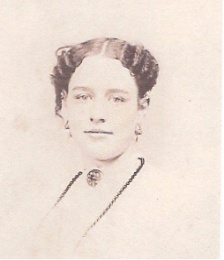 Mary Epps Scott
Mary Epps Scott
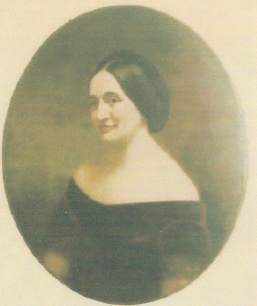
Mary Epps Scott wed John W. McFarland in 1844. She died in 1885.
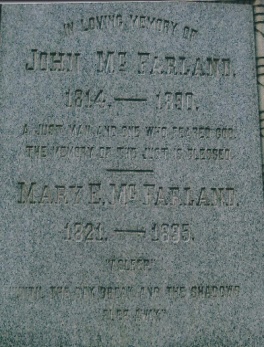
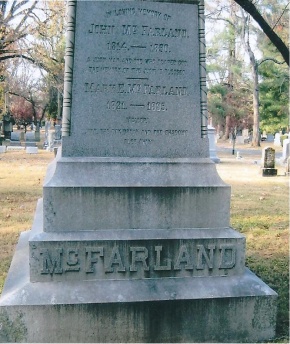 McFarland Graves
Photos courtesy of Judy Ware 2010
McFarland Graves
Photos courtesy of Judy Ware 2010
Another baby
daughter arrived for Lucy and Joseph in 1822, but little
![]() Margaret Scott only lived a short time; dying in 1823. It was four
years before another baby arrived.
Margaret Scott only lived a short time; dying in 1823. It was four
years before another baby arrived.
![]() Isaac Webb was born on
June 27, 1826. Isaac became a doctor, married Mary Buchanan, and the
couple lived in New Orleans, Louisiana. Isaac died there in 1913 at
the age of 86.
Isaac Webb was born on
June 27, 1826. Isaac became a doctor, married Mary Buchanan, and the
couple lived in New Orleans, Louisiana. Isaac died there in 1913 at
the age of 86.
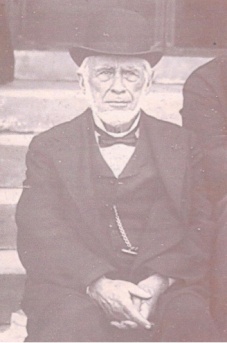
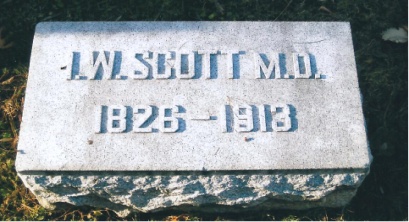
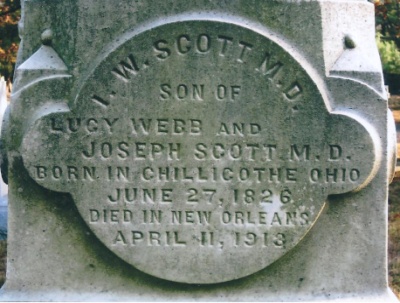
 Markers
in Lexington Cemetery - Photos by Judy Ware
Markers
in Lexington Cemetery - Photos by Judy Ware
Little is known
about Dr. and Mrs. Scott’s next two children. A son,
![]() James N. Scott, was born in 1828. Then a baby girl, named
James N. Scott, was born in 1828. Then a baby girl, named
![]() Catherine Scott, arrived in 1829. Catherine only lived one year
before her death in 1830. James, however, lived to adulthood,
married Sara Woodbridge, and the couple had; Lizzie, Lena, and Isaac
Woodbridge Scott. James N. Ware died in 1867.
Catherine Scott, arrived in 1829. Catherine only lived one year
before her death in 1830. James, however, lived to adulthood,
married Sara Woodbridge, and the couple had; Lizzie, Lena, and Isaac
Woodbridge Scott. James N. Ware died in 1867.
Lucy
Caroline
had their eighth child in 1832, and named him for his father,
![]() Joseph Thompson Scott. He became “a
surgeon in the 1st
Missouri Infantry CSA and served on the staff of General Frost.”
(Ref.
481)
Joseph
“was
taken prisoner during the war, but was later exchanged.” (Ref.
805) He
wed Isidora Churchill Dean in St. Louis, but
“after
the war, Dr. Scott located at New Orleans,” where
he died in 1896.
(Ref.
805)
Joseph Thompson Scott. He became “a
surgeon in the 1st
Missouri Infantry CSA and served on the staff of General Frost.”
(Ref.
481)
Joseph
“was
taken prisoner during the war, but was later exchanged.” (Ref.
805) He
wed Isidora Churchill Dean in St. Louis, but
“after
the war, Dr. Scott located at New Orleans,” where
he died in 1896.
(Ref.
805)
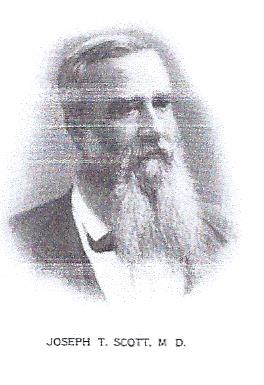 Dr.
Joseph Thompson Scott
Dr.
Joseph Thompson Scott
The Scotts had
another son in 1834 -
![]() Mathew T. Scott. Before dying in 1862, he served in the Confederate
Army where he “lost
an arm in battle and was thence forth known as ‘One-Armed Matt’.”
(Ref. 174)
Mathew T. Scott. Before dying in 1862, he served in the Confederate
Army where he “lost
an arm in battle and was thence forth known as ‘One-Armed Matt’.”
(Ref. 174)
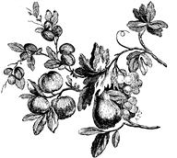
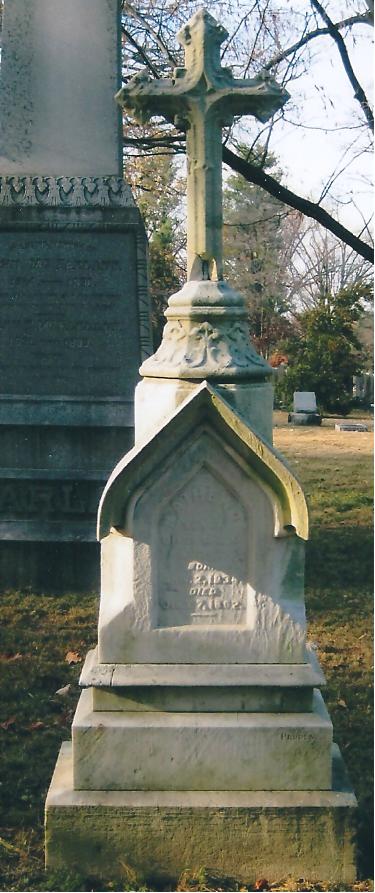
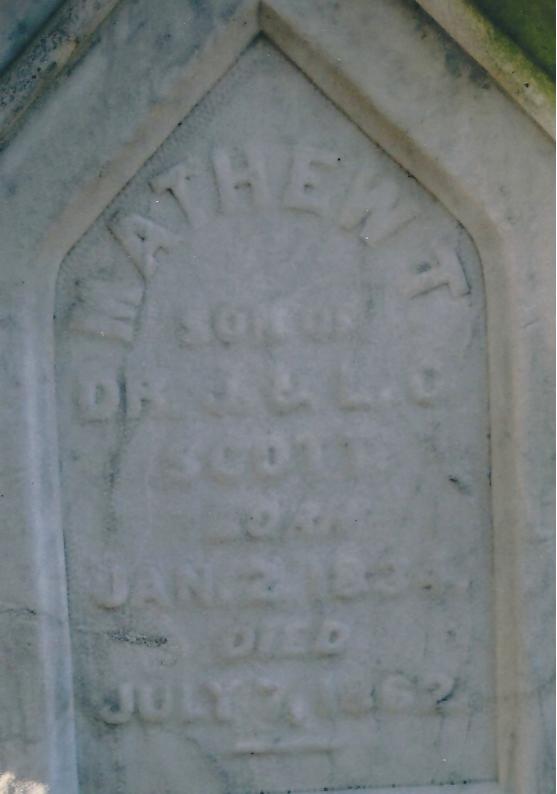 Grave of Mathew T.
Scott
Located in Lexington
Grave of Mathew T.
Scott
Located in Lexington
The last two
children born to Lucy Caroline and Dr. Scott were
![]() Winnie Maria Scott in 1836, and
Winnie Maria Scott in 1836, and
![]() David Humphreys Scott in 1838. Both children lived to adulthood, but
little else is know about them. Winnie married James Stillwell who
“died
of injuries during the Battle of Forts Philip & Jackson.”
She died in May 1910.
David Humphreys Scott in 1838. Both children lived to adulthood, but
little else is know about them. Winnie married James Stillwell who
“died
of injuries during the Battle of Forts Philip & Jackson.”
She died in May 1910.
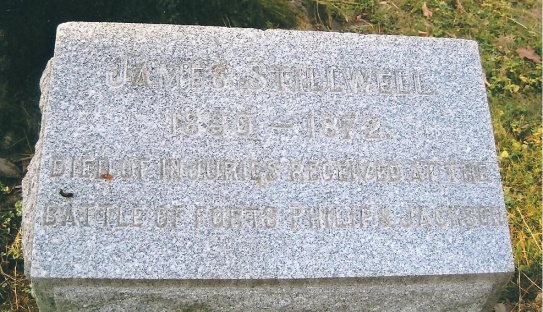
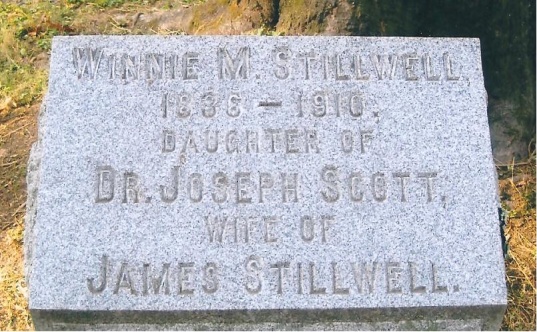
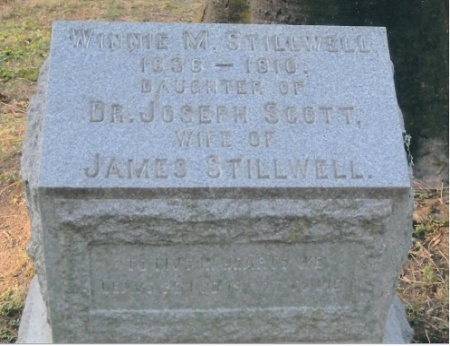 James Stillwell
grave
Winnie Scott
Stillwell grave
James Stillwell
grave
Winnie Scott
Stillwell grave
“To live in the hearts we leave behind is not to die.”
Dr. Scott was well loved by the residents of Lexington and he and Lucy Caroline spent many happy years there. When he died in 1843, his obituary appeared in the “Protestant and Herald” newspaper, and was reprinted in “The Frankfort Commonwealth.” It read as follows:
![]()
"It becomes
our painful duty to record the death of our very highly esteemed
friend and excellent fellow citizen, Dr. Joseph Scott, of Lexington,
who departed this life at his residence, on Tuesday, the 6th inst.,
at about 10:00 p.m. Dr. Scott was born Feb. 19th, 1781, lived
sixty-two years, three months and eighteen days, and then 'slept with
his fathers'. He has been long and most favorably known in this
State and in Ohio, as one of our ablest and most successful
Physicians. Diseases, often of the most malignant character, were
made to yield, with the blessing of God, under his superior skill,
and even death, in some instances, where he had apparently commenced
his work, was staid, and the tide of life and health restored. Many,
very many of the living will bless his memory while they retain their
recollection. His funeral was attended by the largest and most
respectable class of citizens we have ever witnessed on a funeral
occasion in Lexington. Presbyterians, Episcopalians, Methodist and
Baptist, with scores of non-professors of religion, attended with
demonstrations of the deepest feeling and solemnity. The funeral
procession was of great length; scores of carriages, and persons on
horse-back, and the sidewalks of the streets crowded with people on
foot, all slowly, silently and solemnly following the remains of
their departed friend to the last lodging place of mortals - the
grave."
(Ref. 482)
![]()
Joseph was 62 years old when he died. Lucy, at 44, would remain a widow for 25 years before her own death in March 1868.
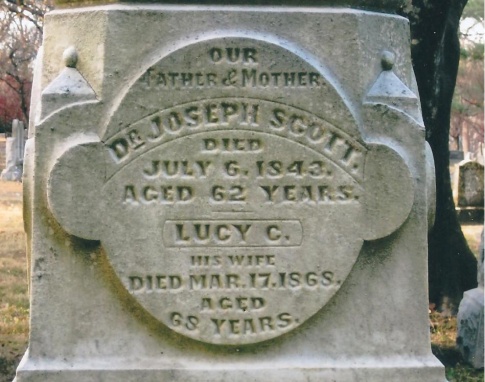
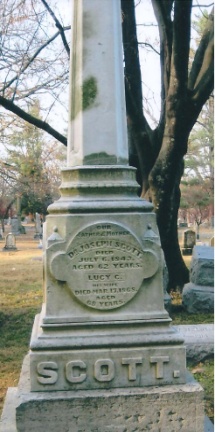 Graves of Dr. Joseph Scott &
Lucy C. Webb Scott - - photos
courtesy of Judy Ware 2010
Graves of Dr. Joseph Scott &
Lucy C. Webb Scott - - photos
courtesy of Judy Ware 2010
![]() Cuthbert
Webb
- In
1801, when Isaac Webb was 43 and Lucy
was 28, they celebrated the birth of another son, Cuthbert Webb.
Cuthbert was the only adult child of Lucy and Isaac who remained
single. Former director of the Rutherford B. Hayes Center,
Watt Marchman, established that “Cuthbert
never married. It appears that Mary Ann, brother Cuthbert, and
daughters Eugenia and Elizabeth C. all settled in the St. Louis area
of Missouri.” Cuthbert
died at his sister’s house, Mrs. Mary Ann Webb Nicholson, in 1860.
Cuthbert
Webb
- In
1801, when Isaac Webb was 43 and Lucy
was 28, they celebrated the birth of another son, Cuthbert Webb.
Cuthbert was the only adult child of Lucy and Isaac who remained
single. Former director of the Rutherford B. Hayes Center,
Watt Marchman, established that “Cuthbert
never married. It appears that Mary Ann, brother Cuthbert, and
daughters Eugenia and Elizabeth C. all settled in the St. Louis area
of Missouri.” Cuthbert
died at his sister’s house, Mrs. Mary Ann Webb Nicholson, in 1860.
![]() Mary
Ann Todd Webb
–
Lucy’s next pregnancy
resulted
in another daughter (Mary Ann Todd Webb) born in 1803. At
the age of 17, Mary Ann wed William Nicholson. (Ref.
192, 2009)
The couple
would have a very large family, providing even more grandchildren for
Lucy and Isaac. Their first four children were:
Mary
Ann Todd Webb
–
Lucy’s next pregnancy
resulted
in another daughter (Mary Ann Todd Webb) born in 1803. At
the age of 17, Mary Ann wed William Nicholson. (Ref.
192, 2009)
The couple
would have a very large family, providing even more grandchildren for
Lucy and Isaac. Their first four children were:
![]() Webb
(nicknamed John) Nicholson,
Webb
(nicknamed John) Nicholson,
![]() James
Cuthbert Nicholson,
James
Cuthbert Nicholson,
![]() William
P. Nicholson, and
William
P. Nicholson, and
![]() Mary
Susan Nicholson. In 1828, their fifth child,
Mary
Susan Nicholson. In 1828, their fifth child,
![]() Lucy
C. Nicholson, was born. She was “destined
to be known as the ‘Belle of Boonville’, Kentucky.”
(Ref. 174,
2009) Lucy
“was a
very bright woman; accomplished in reading both Latin and French.
She met and fell in love with Major David Herndon Lindsay, an army
officer who had recently lost his wife. They were engaged to be
married when the Civil War began, but because of the turmoil of the
times, they decided to defer their wedding until after the
hostilities ceased.” (Ref.
2530)
Lucy
C. Nicholson, was born. She was “destined
to be known as the ‘Belle of Boonville’, Kentucky.”
(Ref. 174,
2009) Lucy
“was a
very bright woman; accomplished in reading both Latin and French.
She met and fell in love with Major David Herndon Lindsay, an army
officer who had recently lost his wife. They were engaged to be
married when the Civil War began, but because of the turmoil of the
times, they decided to defer their wedding until after the
hostilities ceased.” (Ref.
2530)
![]() Lucy,
an ardent southerner, wanted to serve the Confederacy in whatever way
possible. She helped with the wounded, made clothing for the
soldiers, and eventually took greater risks. “On
her return home to Boonville, in the spring of 1862, she was arrested
as a dangerous rebel and was placed in jail for smuggling medicines.”
(Ref.
174, 793, 2009)
As was frequently the punishment in cases such as hers,
“she was subsequently banished from St. Louis with a number of
other ladies and sent south by steamer to Okolona, Mississippi.”
(Ref.
2009, 2275)
Lucy,
an ardent southerner, wanted to serve the Confederacy in whatever way
possible. She helped with the wounded, made clothing for the
soldiers, and eventually took greater risks. “On
her return home to Boonville, in the spring of 1862, she was arrested
as a dangerous rebel and was placed in jail for smuggling medicines.”
(Ref.
174, 793, 2009)
As was frequently the punishment in cases such as hers,
“she was subsequently banished from St. Louis with a number of
other ladies and sent south by steamer to Okolona, Mississippi.”
(Ref.
2009, 2275)
![]()
![]()
Prison record
Lucy eventually connected with Major Lindsay and they were married, but the full story of her adventures is really quite remarkable. She lived to be quite old, but died a tragic death in a fire. (Ref. 174, 793, 2009) (See Virginia Roots in Kentucky Soil for complete story.)
The
Nicholson’s
had
five more children after the birth of Lucy:
![]() Elizabeth
C. (Lizzie) Nicholson, who was born in 1832 and died at the age of 91
in the same house fire that killed her sister;
Elizabeth
C. (Lizzie) Nicholson, who was born in 1832 and died at the age of 91
in the same house fire that killed her sister;
![]() Alice
Peachey Nicholson;
Alice
Peachey Nicholson;
![]() Louise
W. Nicholson;
Louise
W. Nicholson;
![]() L. Gertrude Nicholson; and
L. Gertrude Nicholson; and
![]() Isabelle Eugenia Nicholson.
Isabelle Eugenia Nicholson.
![]() John
Thompson Webb
- Isaac
and Lucy’s ninth
child, John Thompson Webb, was born in 1805. Hayes Library documents
state that he “received
1,000 acres of land on Paint Creek in Ohio from his father and
mother, Isaac and Lucy Ware Webb, deed dated January 21, 1831.”
(Ref. 174)
John moved
later to Mobile, Alabama, where he died.
John
Thompson Webb
- Isaac
and Lucy’s ninth
child, John Thompson Webb, was born in 1805. Hayes Library documents
state that he “received
1,000 acres of land on Paint Creek in Ohio from his father and
mother, Isaac and Lucy Ware Webb, deed dated January 21, 1831.”
(Ref. 174)
John moved
later to Mobile, Alabama, where he died.
![]() Elizabeth
(Betsey) Frances Webb
–
At 33, Lucy had her last baby in 1806 - naming her Elizabeth.
Grandpa James Ware passed away shortly before she arrived, so he
never got to meet this grandchild. Betsey first married Reverend
Joseph P. Cunningham, and they had four children before he passed
away: Isaac Webb (called Webb) was born in 1827, followed by Robert,
Lucy, and Joseph (who was called John). In Lucy’s letter to a
niece, she wrote, “Betsey
Cunningham has two very interesting boys, Webb and Robert. She would
have been so delighted to have met with you and Josiah.”
(Ref. 597)
Elizabeth
(Betsey) Frances Webb
–
At 33, Lucy had her last baby in 1806 - naming her Elizabeth.
Grandpa James Ware passed away shortly before she arrived, so he
never got to meet this grandchild. Betsey first married Reverend
Joseph P. Cunningham, and they had four children before he passed
away: Isaac Webb (called Webb) was born in 1827, followed by Robert,
Lucy, and Joseph (who was called John). In Lucy’s letter to a
niece, she wrote, “Betsey
Cunningham has two very interesting boys, Webb and Robert. She would
have been so delighted to have met with you and Josiah.”
(Ref. 597)
After Robert’s death, Betsey remarried in July 1836. Her husband, Mathew Thompson Scott (known as Thompson), had been married earlier to her older sister Winny. Since Winny died shortly after giving birth to her 14th child in 1833, and there was only a three-year span between her death and the marriage of Betsey and Thompson, it would seem safe to assume that Betsey took over the role of ‘mother’ for the many Scott children. The age difference in Betsey and Thompson was noted in a letter President Hayes sent to his sister. He wrote, “Aunt Betsey is twenty years younger than her husband and the youngest woman of her age I have ever seen.” (Rf. 174) The Scotts had 22 happy years together before Thompson’s death in 1858 at the age of 72. There are records in Lexington which state, “He was a man of superior financial judgment and irreproachable integrity. (Ref. 976)
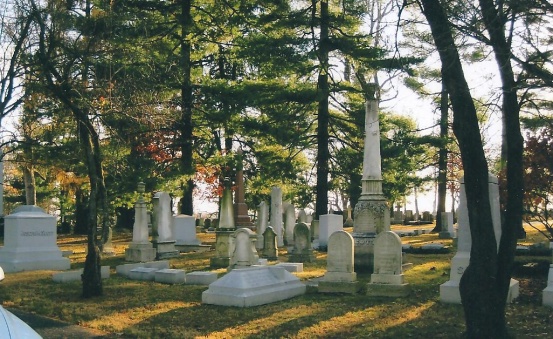 Scott
section in the Lexington Cemetery
Scott
section in the Lexington Cemetery
Photo courtesy of James & Judy Ware 2010

Life for Isaac and Lucy Ware Webb was full and busy during their years in Kentucky. Letters exchanged with their nephew, Josiah, provided great insight into their families. As he once remarked about Lucy, “I had a large bundle of [her letters]; our correspondence was regular and her sheet always full and as if it flowed from her heart.” (Ref. 299) Josiah further wrote, “I knew Lucy Ware intimately and corresponded with her . . . her hair was cut short and was as white as snow. She was a perfect specimen of hospitality.” (Ref. 638)
The year 1833 brought more sadness into the family than they could have ever imagined. The historic cholera epidemic that swept through Kentucky that year brought much death and suffering to everyone, but it seemed to be especially terrible for both the Webb and Ware families. Hardly a member of the family was left unscathed, but it appeared the hardest hit was the home of Lucy and Isaac Webb. “On June 22, 1833, ‘Isaac added a section to his will (he knew he was on his death bed and knew Lucy was too) pertaining to the disposition of his slaves.’ ” (Ref. 296) He wanted to provide an opportunity for them to attain freedom. Not only did the two spouses die within mere days of each other, but many of their other family members did as well.
![]()
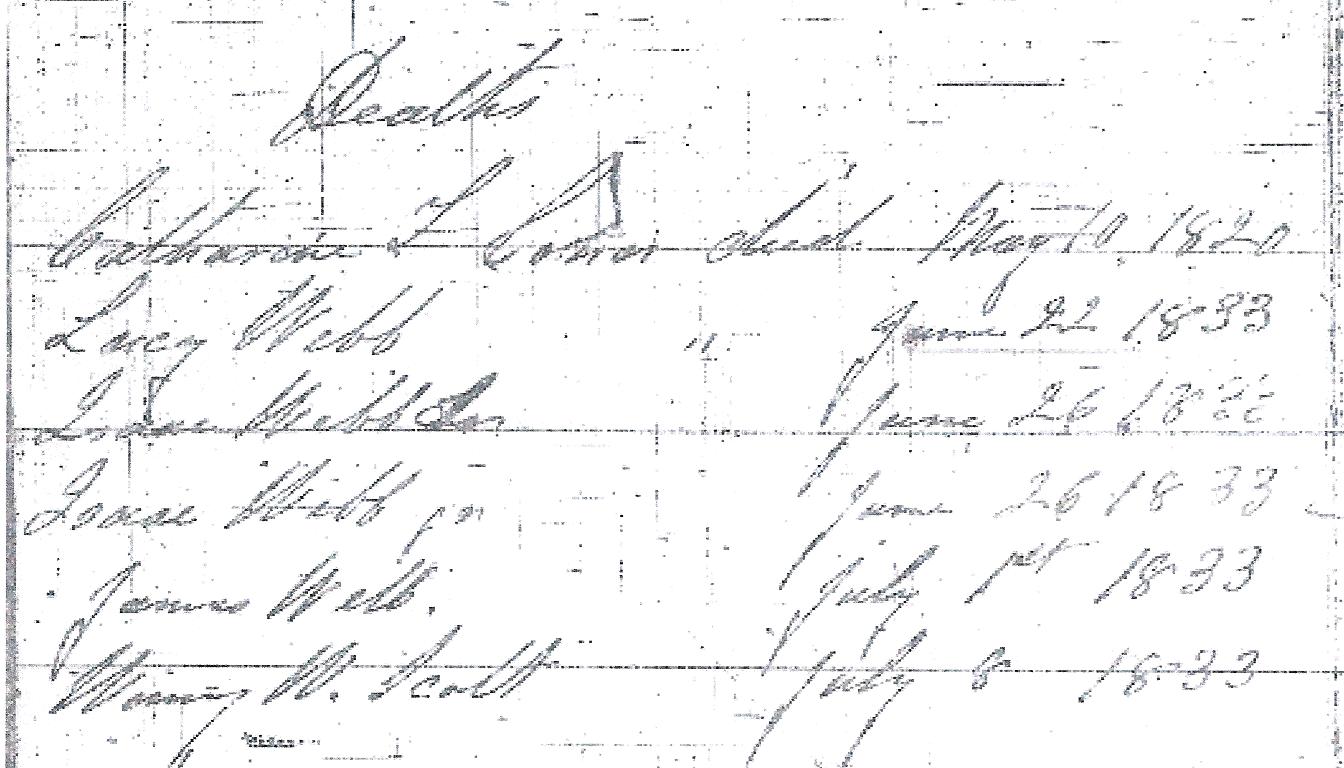
![]() Bible entry
showing deaths
Bible entry
showing deaths
Most of the relatives were buried in a small cemetery near the home of Isaac Webb. One source locates the graveyard “on Stewart Road.” (Ref. 934) In 1998, another researcher provided more detailed instructions on how to find the cemetery. “I have three ‘sources’ that locate the property in Fayette County, about two miles on the Houston Road from its intersection with Briar Hill Pike in Fayette County. For whatever use it is, that road runs northwesterly to and along a Houston Creek on to where it meets the Lexington-Paris Pike (the Antioch Church is at the Lexington-Paris Pike juncture, in Bourbon County, where it is known as the Antioch Pike.) The road markers in Fayette County now show that road as the Huston-Antioch Road and a current map shows the name as Antioch Road (most of it is in Bourbon County.) My sources say a family burial ground is about two miles along the Houston Road, near Isaac Webb’s house. (Ref. 944) It is not an easy site to find because it sits on private property.
In 1931, Ware and Webb family descendants located and restored the old cemetery. They enclosed it with a 20 foot by 30 foot stone wall. It was approximately four feet high, and cemented. They placed a marker commemorating the site:
![]()
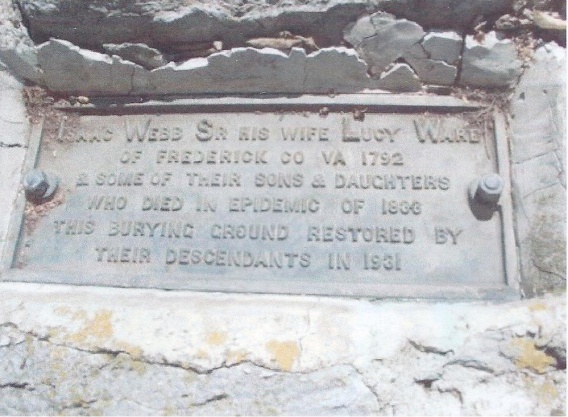
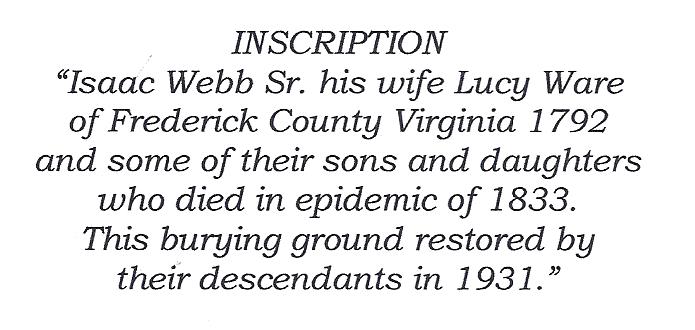
The first restoration project was done beautifully, but “years took its toll, however, and the family resting place again fell into sad disrepair. The large tombstone of Isaac’s sister (Winney Webb) had all but broken apart and the surrounding wall and other graves were hardly recognizable.” (Ref. 2095) (See photos below)
Cemetery that was restored in 1931 – how it looked in 2006
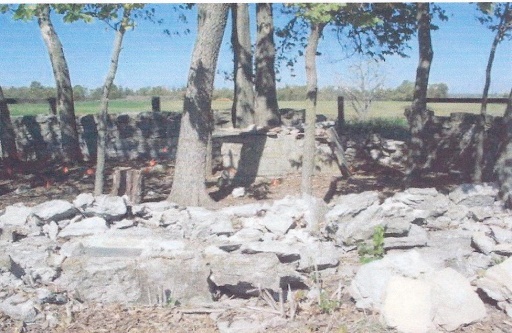
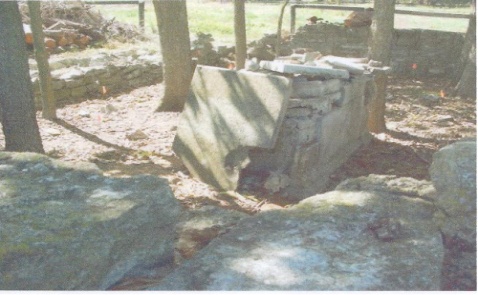
More photos are available in Virginia Roots in Kentucky Soil.
In 2006, this wonderful, old cemetery got another facelift from some very caring family members. The amount of time, money, and love that went into the restoration is a testimony to the kind hearts of those involved. Mike Riegert and Tom Moore were the historical preservationists on the project and Susie Stahl did an incredible job of overseeing everything and keeping it well documented.
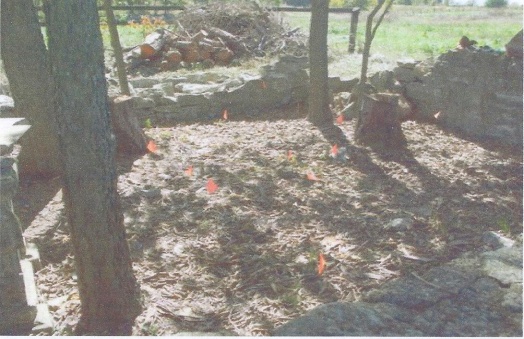
![]()
The beginning of the 2006 restoration
![]() The following photos,
for which I am most grateful, are available courtesy of the people
who transformed the Webb/Ware Cemetery in 2006 – particularly the
late John Woods, whose passion for genealogy inspired many.
The following photos,
for which I am most grateful, are available courtesy of the people
who transformed the Webb/Ware Cemetery in 2006 – particularly the
late John Woods, whose passion for genealogy inspired many.
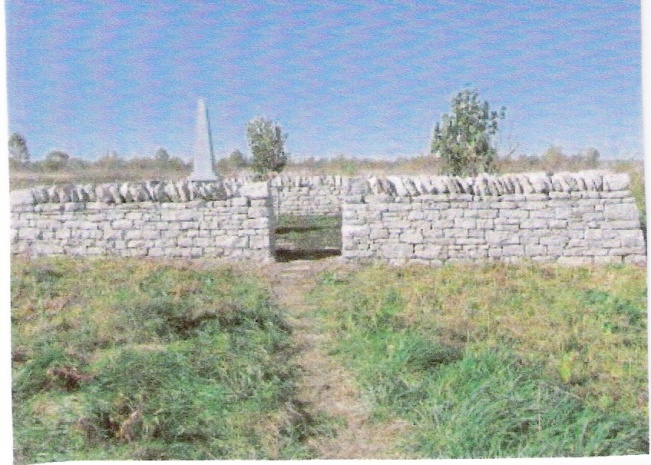
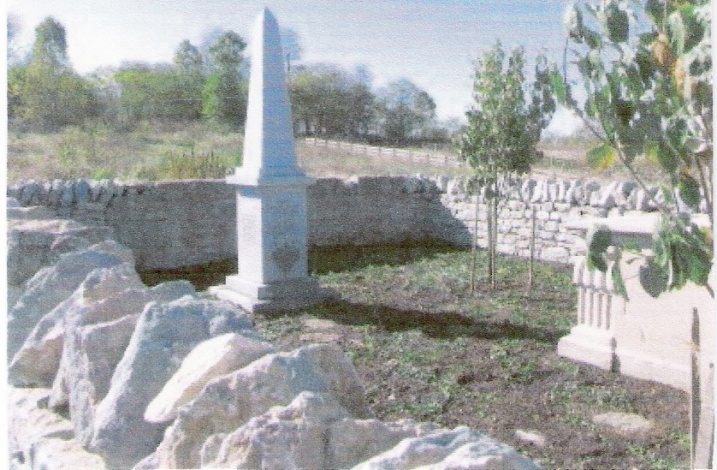
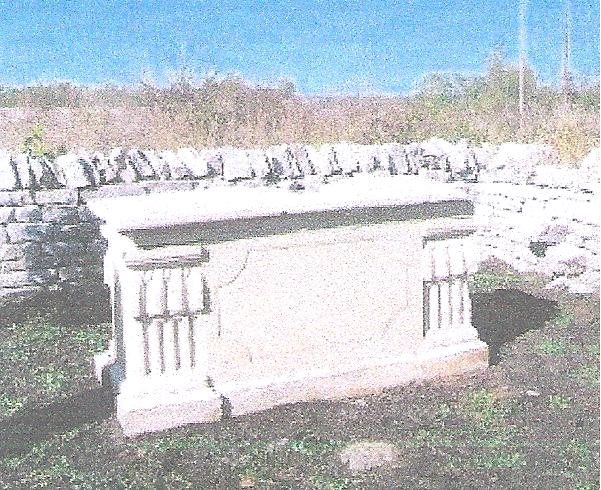 Tomb of Winney Webb
Tomb of Winney Webb
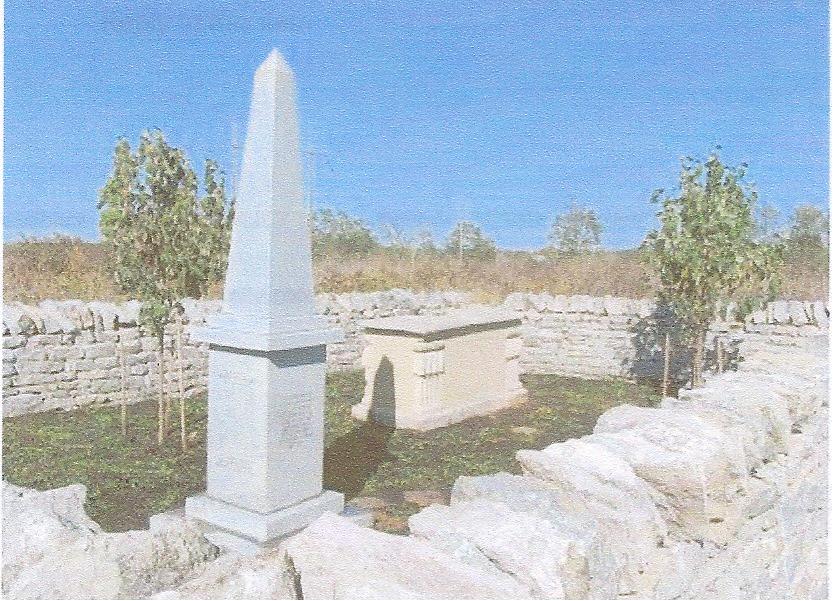
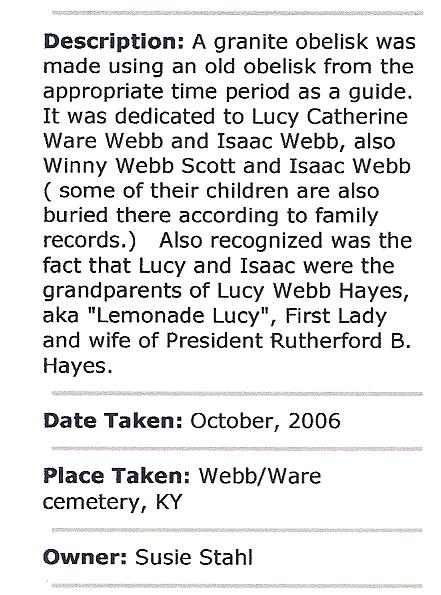
The following photographs were all taken during that visit.
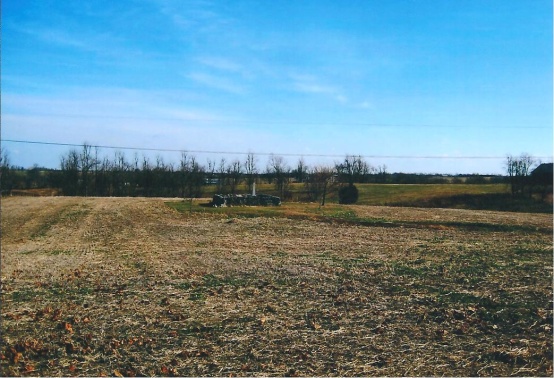
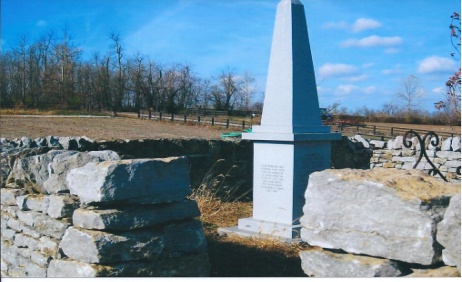
Located across a large field Looking back toward the road
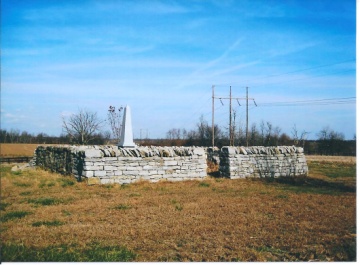
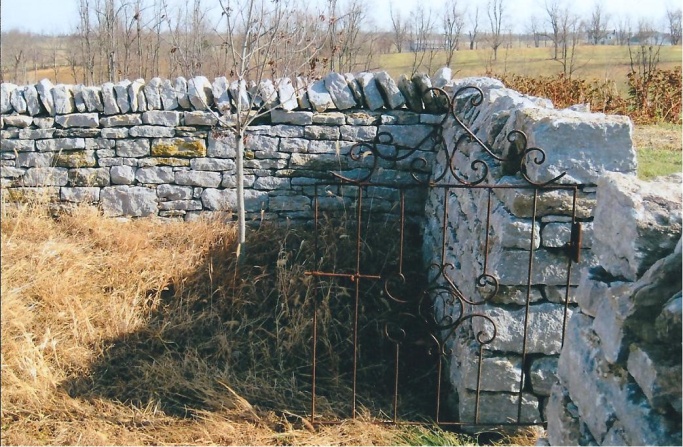
All 2010 cemetery photographs provided courtesy of James and Judy Ware
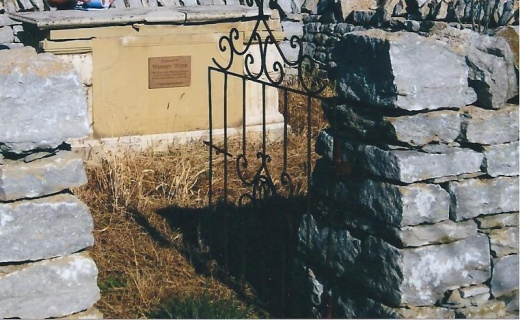 Entering by the gate
Entering by the gate
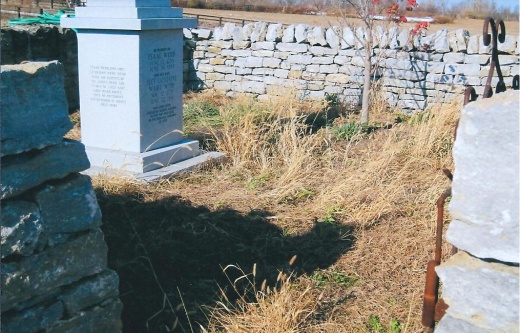
Sadly, it was very overgrown inside the walled area. The four short years since the restoration had taken a huge toll.
 1931
1931
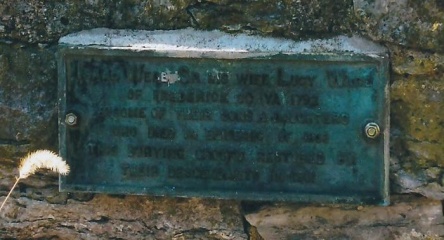 2010
2010
When they did the restoration in 2006, they were very careful to keep as much of the original cemetery pieces as possible. The old marker that was placed in the first restoration of 1931 was still embedded in the walls in 2010. (See above)
The photos below show where part of the original old wall was incorporated into the newly restored wall of 2006.
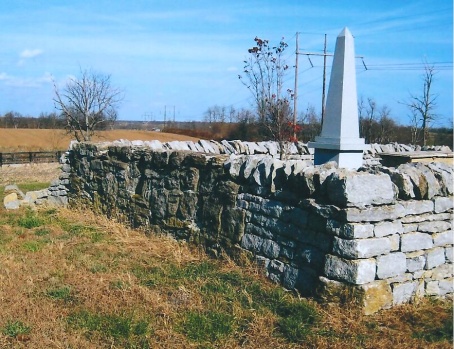
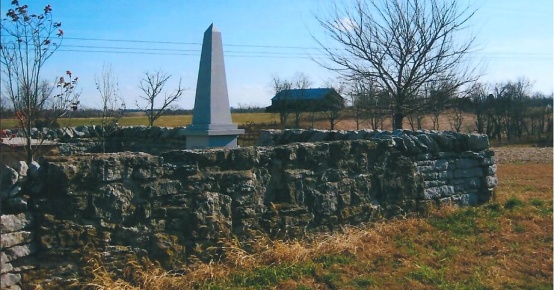
![]()

![]()
There was also a “stile” added in 2006 – a form of stairs built into the wall on both sides to enable a person to climb up and over the wall.
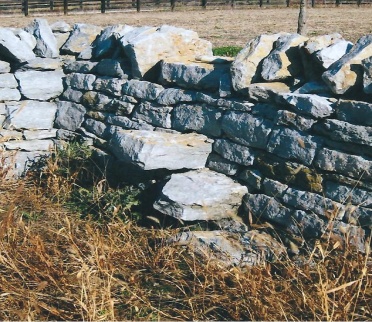
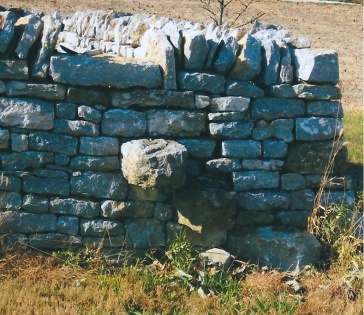
Inside the wall Outside the wall

For James and Caty Todd Ware, thankfully, the hardships that would define 1833 were not known to them in 1775, as they prepared to welcome another child into the family. The world around them was chaotic enough.
![]()
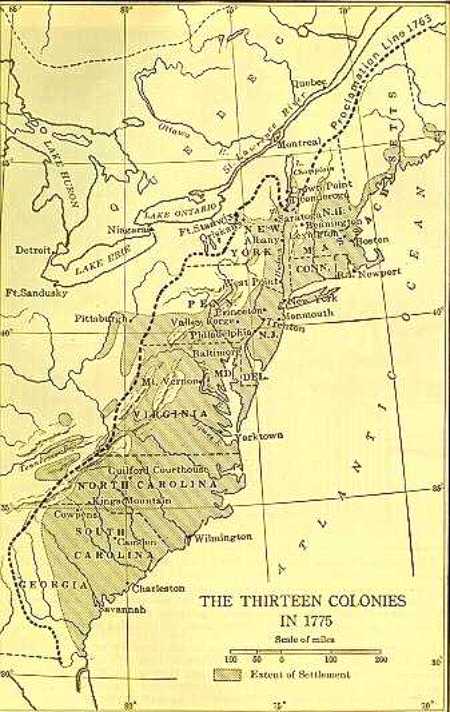
![]()
Map of the 13 colonies
5. Charles Ware The original 13 colonies of Connecticut, Delaware, Georgia, Maryland, Pennsylvania, Massachusetts, New Hampshire, New Jersey, New York, North Carolina, South Carolina, Rhode Island and Virginia “had two major things in common: Great Britain as their enemy and the desire to go to war to fight that enemy.” (Ref. 2350) It was into these times that Charles was born - on August 19, 1775. His older brothers were six and four, and his older sisters were three and two.
When peace finally arrived and the family made their big move to Kentucky, Charles was only 16 years old. He wrote in his letters back home that he stayed with his parents for about two years and then he went back home to Virginia to live with his older brother, James III, for a while. One of his letters stated, “I did not go to live with him (James) until the fall of 1793. We then continued together almost until I married in 1803.” (Ref. 35G)
Charles married Frances Whiting on November 29th and settled in Versailles, Kentucky, where they bought quite a bit of land. (Ref. 1067) The deed specifies that “On Oct. 8, 1811, James Stapp and his wife Sally, of Woodford County sold to Charles Ware of Fayette County for the amount of $2,643.00, 177 ¼ acres on waters of Glenn’s Creek to Richard Young’s old line.” (Ref. 1027, 1038)
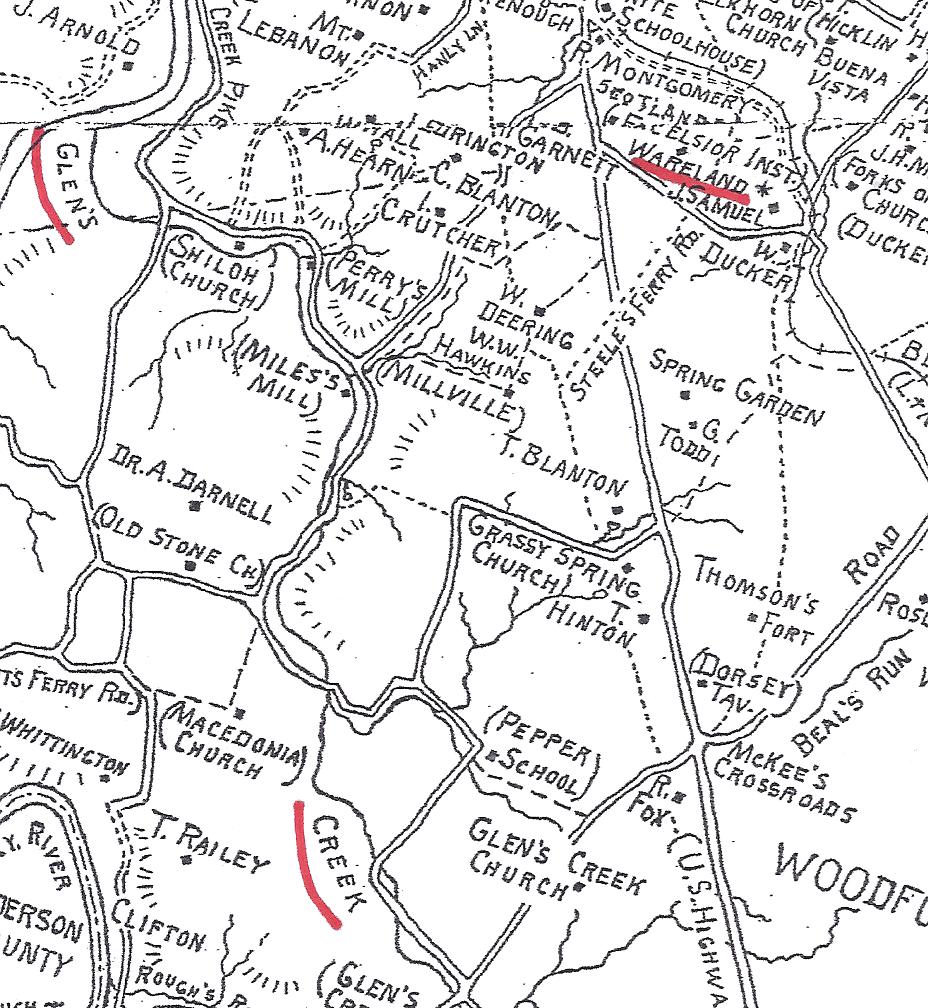
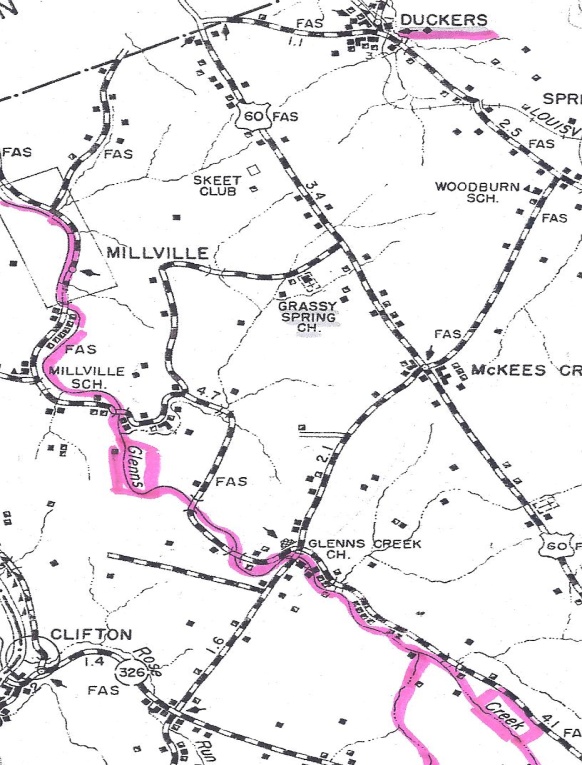
Maps showing the location of Glen’s Creek and its proximity to Wareland, home of Charles’ grandfather, James Ware I
As a land owner, Charles Ware naturally assumed his civic responsibilities that came with his age and station. He “served as one of the Commissioners on Dec. 27, 1811 for examining the accounts pertaining to the estate of Richard Blanton deceased.” His role as a Commissioner required that he “make the appraisal of the personal estate of Richard Blanton for his widow Sally Blanton. . . help examine and settle the accounts of Carter Blanton as guardian to the heirs of Richard Blanton deceased and also to make a division of the estate among his heirs and legal representatives and make a report.” (Ref. 1043 and 1044) His others duties included contracting “for the repairing of a bridge on Hornbacks Mill Road across David’s Fork, to be paid out of next year’s levy.” (Ref. 1044)
Charles loved farming best. The expanding country had great need of food, and “almost every agricultural crop, with the exception of cotton and tropical fruits, could be grown successful in Kentucky. Here, more than in any other state, the opportunity to become self-sufficient was taken advantage of to the fullest.” (Ref. 2254) Charles did exactly that. An 1811 letter written to his brother in Virginia gives insight into how well his agricultural endeavors were going.
 “I raised, last
year, some better than 2 ½ tons [of]
hemp which I sold to Capt. John Richardson and son (who has
established a Rope Walk on his farm) at seven dollars p. hundred;
payable in 12 months, which will expire the 15th
of March next. Hemp is worth about $6.00 now. It was up for two
weeks only last winter - worth $7.00. I had a good deal of trouble
with [the]
breaking of my hemp, having taken it almost all up before it was well
rotted. Notwithstanding, it passed in great credit. I’ll know
better next time.” He
went on to add, “I
have at last (not without great labor) repaired the fencing in such a
manner that with little trouble, [it]
will last my lease, and I have 13 acres of hemp a growing that is
promising; notwithstanding a severe drought this Spring. From 1
April until the 10th of June was less rain than ever was known (by
me) to have fallen in the same months. Our flak and oats will, I
fear, not be worth saving. Wheat is good. Corn is very low but
looks very well.”
(Ref.
341)
“I raised, last
year, some better than 2 ½ tons [of]
hemp which I sold to Capt. John Richardson and son (who has
established a Rope Walk on his farm) at seven dollars p. hundred;
payable in 12 months, which will expire the 15th
of March next. Hemp is worth about $6.00 now. It was up for two
weeks only last winter - worth $7.00. I had a good deal of trouble
with [the]
breaking of my hemp, having taken it almost all up before it was well
rotted. Notwithstanding, it passed in great credit. I’ll know
better next time.” He
went on to add, “I
have at last (not without great labor) repaired the fencing in such a
manner that with little trouble, [it]
will last my lease, and I have 13 acres of hemp a growing that is
promising; notwithstanding a severe drought this Spring. From 1
April until the 10th of June was less rain than ever was known (by
me) to have fallen in the same months. Our flak and oats will, I
fear, not be worth saving. Wheat is good. Corn is very low but
looks very well.”
(Ref.
341)
![]() One of the major
products that Kentucky became known for was hemp. “Since
1775, the planters of Kentucky had been growing hemp, but it was not
until later that they discovered a profitable use for its long stingy
fibers. When the shipping industry on the western rivers developed,
there was a keen demand for roping and the hemp growers began to
manufacture rope and course sail cloth.”
(Ref. 2254)
When
the Wares planted their first crops of hemp, they had no idea how
truly profitable it would become. “There
was no machinery in existence for the manufacturing of hempen goods
until 1796 when a machine for cleaning the raw stock was invented by
Nathan Burrows.”
(Ref. 2254)
With the new machinery, “it
is not surprising that from 1780 to 1811, the hempen industry
increased forty-fold.”
(Ref.
2254)
One of the major
products that Kentucky became known for was hemp. “Since
1775, the planters of Kentucky had been growing hemp, but it was not
until later that they discovered a profitable use for its long stingy
fibers. When the shipping industry on the western rivers developed,
there was a keen demand for roping and the hemp growers began to
manufacture rope and course sail cloth.”
(Ref. 2254)
When
the Wares planted their first crops of hemp, they had no idea how
truly profitable it would become. “There
was no machinery in existence for the manufacturing of hempen goods
until 1796 when a machine for cleaning the raw stock was invented by
Nathan Burrows.”
(Ref. 2254)
With the new machinery, “it
is not surprising that from 1780 to 1811, the hempen industry
increased forty-fold.”
(Ref.
2254)
Brief explanation of the crop Hemp
Hemp is the
tough, coarse fiber of the cannabis plant, often used to make rope.
It is the oldest cultivated fiber plant in the world. It contains no
toxins as it does not require pesticides. The first Gutenberg bible
was printed on hemp paper.
Christopher Columbus' sails and ropes were made from hemp and the
first drafts of the Declaration of Independence were printed on hemp
paper. 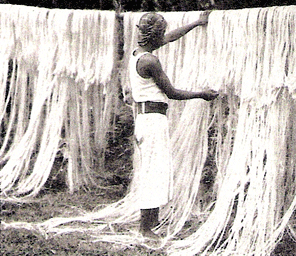
Hemp demands a
rich, well-drained soil such as is found in the Blue Grass region of
Kentucky. It must be loose and rich in organic matter. Soil that
will grow good corn will usually grow hemp. There is much history
about spinning American hemp into rope, yarn or twine in the old
Kentucky River mill at Frankfort, Kentucky. During the first third
of the nineteenth century most of the rope made in Kentucky was spun
and twisted by hand and by the use of horse power at one end of the
walk.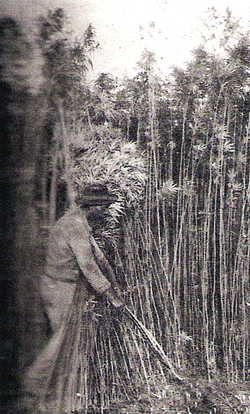
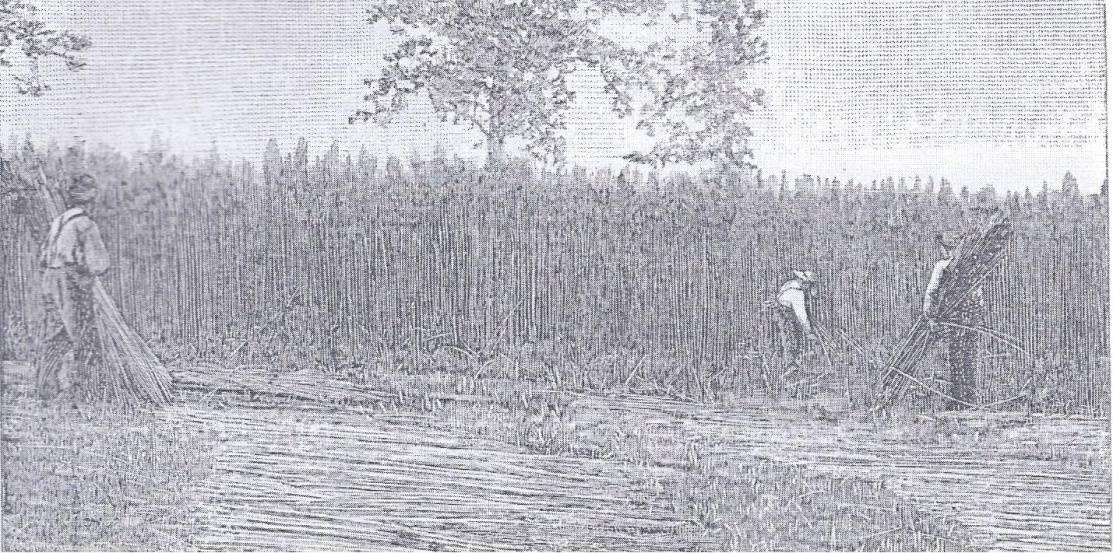

Gathering hemp Article printed in The Lexington Herald-Leader by Dick Burdette on March 20, 2000)
 VERSAILLES,
Ky. - Near the east edge of town, along U.S. 60 at Payne’s Mill
Road, there's a bronze marker commemorating the important role hemp
once played in Kentucky agriculture. It isn't unique. There are
similar signs in Boyle, Fayette, Franklin, Jessamine, Madison, Mason,
Scott, Shelby and Clark counties.
VERSAILLES,
Ky. - Near the east edge of town, along U.S. 60 at Payne’s Mill
Road, there's a bronze marker commemorating the important role hemp
once played in Kentucky agriculture. It isn't unique. There are
similar signs in Boyle, Fayette, Franklin, Jessamine, Madison, Mason,
Scott, Shelby and Clark counties.
Because of its rich soil and
mild, ideal climate, "Woodford County was the hemp seedbed of
Kentucky," Gifford said. "Hemp seed from here was shipped
all over the country."
Another author, Stephen Peterson of the Woodford Sun, wrote in 1999, “at one time, Woodford County produced more hemp seed than any other single location in the United States.” In the past, hemp was the source of a vast array of products from oil to textiles to foodstuffs.
Brief explanation of the crop Flax
This plant,
from which linen is derived, never rivaled tobacco as a cash crop in
the Chesapeake area, but most farmers and plantation owners grew
small amounts well into the 1800's for their own use. Flax is an
‘annual’ which grows two to three feet high on a slim,
little-branching stem. It is this woody stalk, hollow when dried,
which is harvested and ultimately manufactured into linen.
Additional properties of flax make it a desirable finished
product, and even the seeds can be harvested and
made into linseed oil (used in wood treatments).
The
World Book Encyclopedias
©1953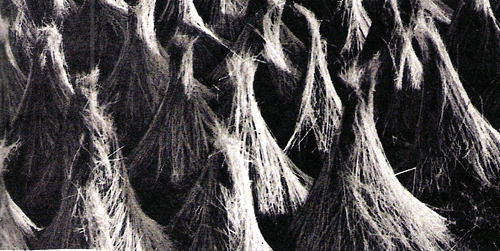
 James
and Caty were obviously proud of their son’s farming efforts.
James wrote in a letter that he had some of his horses “in
Charles Ware’s stables; up to their eyes in the best of feed etc.”
He added, “Charles
Ware made almost 3 tons of hemp last year and has sold it. Charles
has got the greatest prospect this year. He will make, I suppose, 4
or 5 tons of it, if it comes in well.”
(Ref. 341)
His love of farming paid off.
James
and Caty were obviously proud of their son’s farming efforts.
James wrote in a letter that he had some of his horses “in
Charles Ware’s stables; up to their eyes in the best of feed etc.”
He added, “Charles
Ware made almost 3 tons of hemp last year and has sold it. Charles
has got the greatest prospect this year. He will make, I suppose, 4
or 5 tons of it, if it comes in well.”
(Ref. 341)
His love of farming paid off.
In a letter Charles wrote in 1831, he mentioned his health and penned, “I find I decline more than my years speak of.” (Ref. 35G) He died in Kentucky in July 1839 at the age of 64 - - leaving no heirs to whom he could pass his farm.

 Court record
Court record
Fanny lived for many more years; the local newspaper recorded:
“Mrs. Fanny
Ware, widow of Charles Ware of Woodford County died in August 1851 at
the age of 77.”
(Ref. 1069)
![]()

6. Catherine (Kitty) Ware - By 1777, America was fully embroiled in war, and for Caty (pregnant again), it must have brought great concern over James who was serving in the military. General George Washington had just recruited 8,000 men and it would not be long before these new recruits would be seasoned soldiers.
Caty gave birth on May 1, 1777 to a girl they named Catherine, but she was usually called Kitty by the family. She joined six siblings; the oldest being eight. It was a bustling household.
At the age of 19, Catherine Ware married Dr. John Mitchell Scott in 1796. Dr. Scott “practiced medicine, first in 1796 in Woodford County, the place where Catherine’s grandparents lived.” (Ref. 2253) Then, when the couple married, they settled in Frankfort, where he “became one of the leading practitioners of his day.” (Ref. 2253) John “frequently traveled to Indiana to act as personal physician to General Harrison while he was Governor of the Indiana Territory and before he became President of the U.S. They were such close personal friends that General Harrison named his 5th child (Dr. Scott assisted at this birth) after him (John Scott Harrison) and Dr. Scott and Kitty named their son (born in 1805) William Henry Harrison Scott.” (Ref. 942)
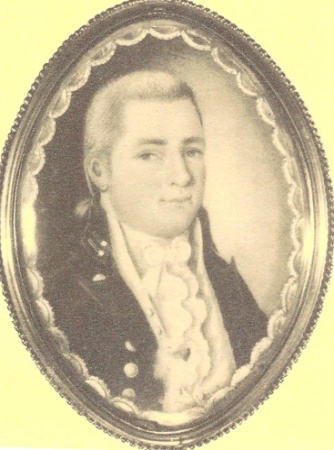
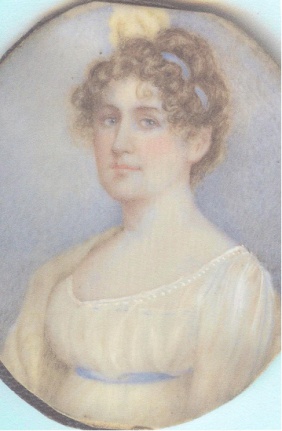
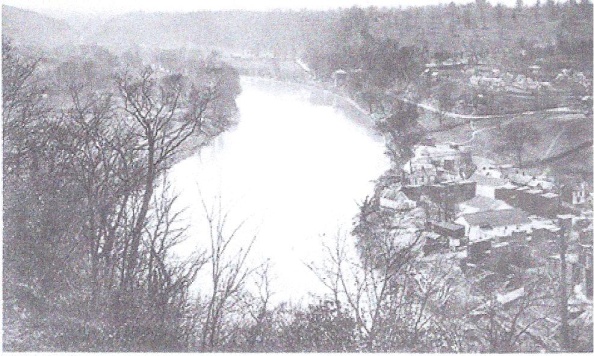
Dr. John Mitchell Scott Catherine Ware Scott Early Frankfort – photo courtesy of The Kentucky Historical Society
Photos courtesy of Maunsel White
The miniatures below of Catherine and John were painted by Matthew Harris Jouett.
Catherine Ware Scott Dr. John Mitchell Scott
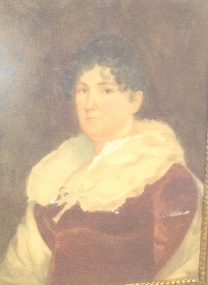
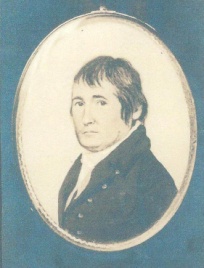
![]()
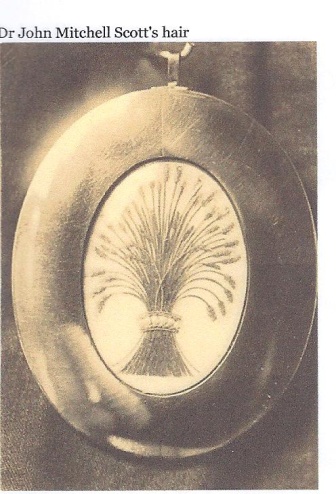
![]() The oval of Dr. Scott is
truly an exquisite work of art. The “miniature
is solid gold and the features are hand painted on ivory.”
(Ref.
2224) The
back is fascinating. In keeping with the tradition of “hair art”
of the times, it has “a
solid gold rim and the brown hair from his head is made up like a
sheaf of wheat and bound together by a
circulet
of pearls.”
(Ref.
2224) The
art of sewing a picture, using the actual hair of the one you loved,
was the height of fashion during this time.
The oval of Dr. Scott is
truly an exquisite work of art. The “miniature
is solid gold and the features are hand painted on ivory.”
(Ref.
2224) The
back is fascinating. In keeping with the tradition of “hair art”
of the times, it has “a
solid gold rim and the brown hair from his head is made up like a
sheaf of wheat and bound together by a
circulet
of pearls.”
(Ref.
2224) The
art of sewing a picture, using the actual hair of the one you loved,
was the height of fashion during this time.
There were several portraits made of both Catherine and John before 1812. Some were simply watercolor copies of the originals and, therefore, have subtle changes.
Catherine Ware Scott Dr. John Mitchell Scott
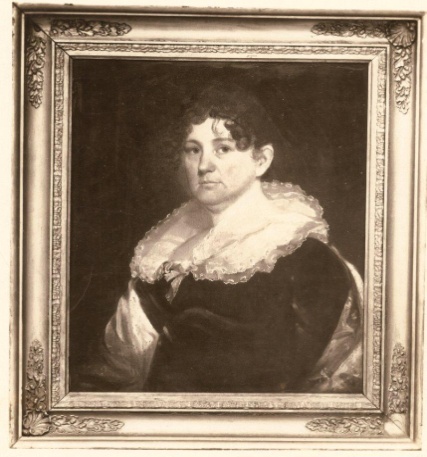
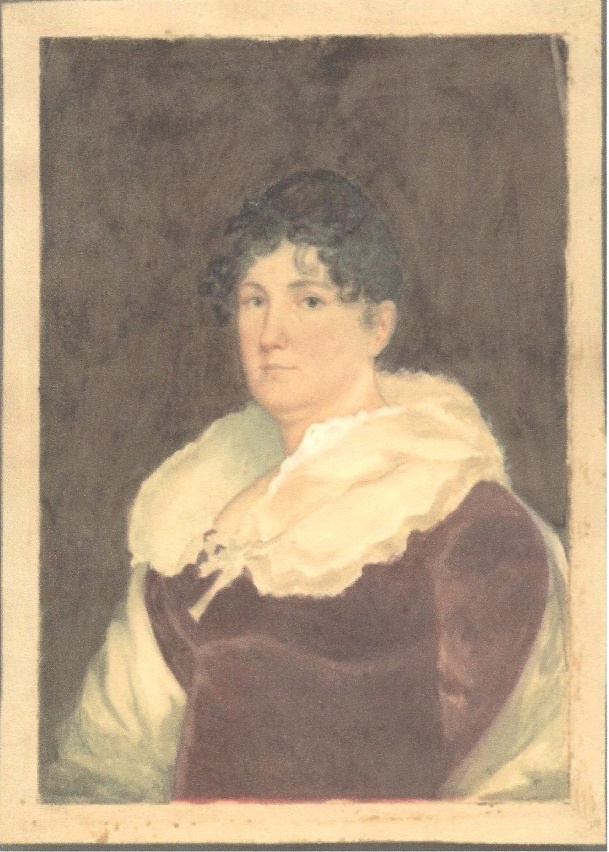
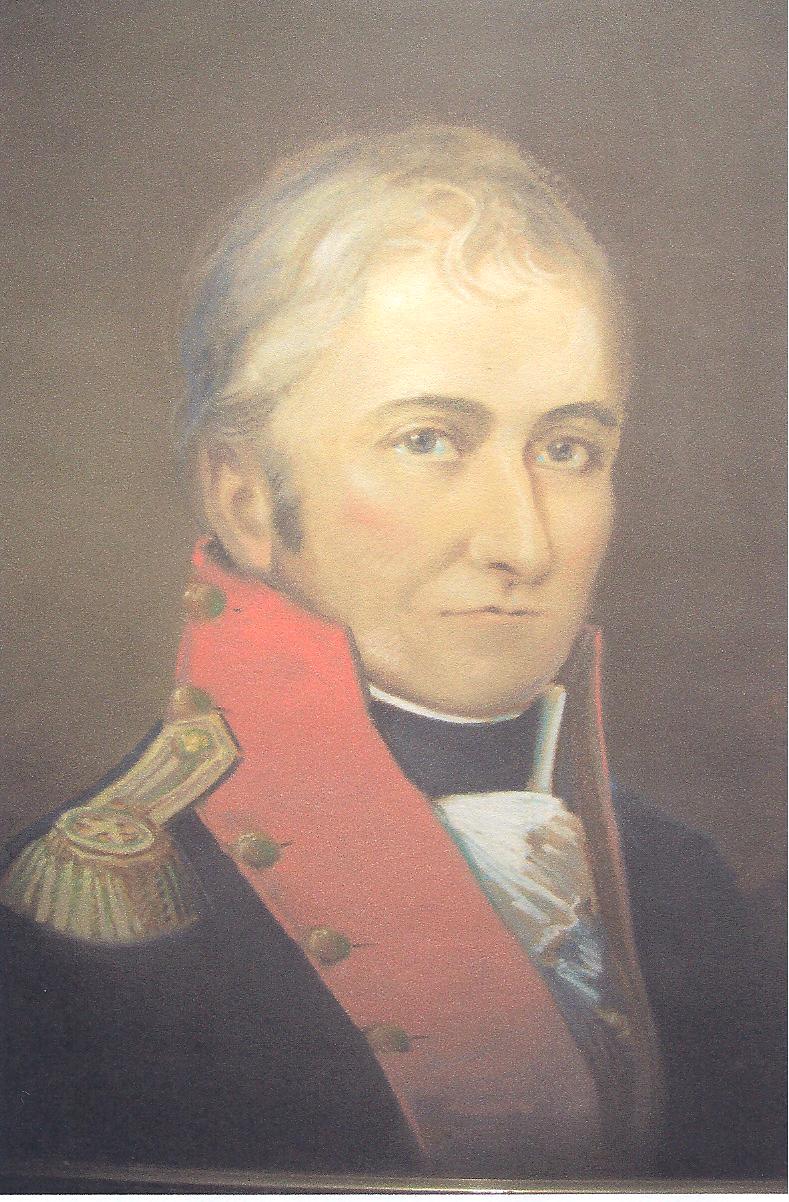
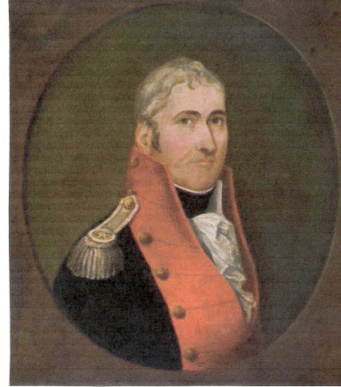
The original painting of John Mitchell Scott, done before 1812, was painted by Samuel H. Dearborn. All portraits kindly provided by both Maunsel White and Albert Bruns
When they moved to Frankfort, Dr. Scott and Catherine moved into a home previously owned by Daniel Weisiger - the first postmaster of the town in 1794. The property on which they constructed their own house was later bought by Philip Swigert who built a lovely mansion there around 1848. Known as “The Terraces,” the wisteria covered home was on Wapping Street.
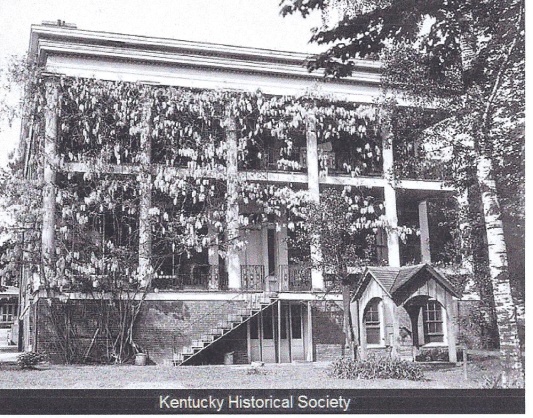 The Terraces
The Terraces
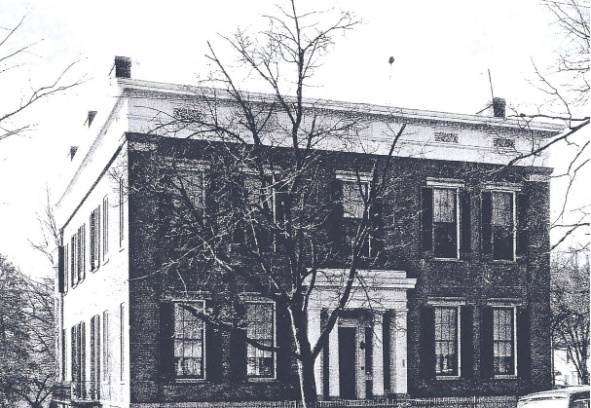
“The Terraces mansion stood on Wapping Street, but it elegant, vine-wrapped balconies faced the Kentucky River behind the house.” (Ref. Kentucky Historical Society)
The Scotts would eventually have five children, but Grandfather James only lived long enough to know about the first one. The following provides information on each child.
![]() Elizabeth
Thompson Scott
- Kitty was 21 years old when she delivered Elizabeth - usually
called either Eliza or Betsy. Born in 1798, Eliza married Colonel
Solomon Porcius Sharp in 1818.
(Ref. 974)
Her new husband
was an established politician, and in Hayden’s genealogy book, the
author wrote: “Col.
Solomon P. Sharp was a member of the U.S. Congress from 1813-1817.
John C. Calhoun said ‘He (Sharp) was the ablest man of his age
that had ever crossed the mountains.’”
(Ref. 6)
The Scott’s
son-in-law was talented, ambitious, and admired. “When
he served in the House of Representatives as a Congressman, Solomon
developed an esteemed reputation for his work.”
(Ref. 462)
Elizabeth
Thompson Scott
- Kitty was 21 years old when she delivered Elizabeth - usually
called either Eliza or Betsy. Born in 1798, Eliza married Colonel
Solomon Porcius Sharp in 1818.
(Ref. 974)
Her new husband
was an established politician, and in Hayden’s genealogy book, the
author wrote: “Col.
Solomon P. Sharp was a member of the U.S. Congress from 1813-1817.
John C. Calhoun said ‘He (Sharp) was the ablest man of his age
that had ever crossed the mountains.’”
(Ref. 6)
The Scott’s
son-in-law was talented, ambitious, and admired. “When
he served in the House of Representatives as a Congressman, Solomon
developed an esteemed reputation for his work.”
(Ref. 462)
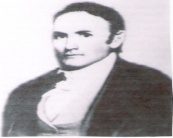 Congressman Sharp
The
couple set up housekeeping in a home that was “located
on Madison Street, facing the Old State Capitol.”
(Ref.
2286) It
was here that Eliza and Solomon lived with their three children, and
it was also here that (after seven years of marriage), Congressman
Sharp was assassinated in 1825. It was a crime that gained national
attention.
Congressman Sharp
The
couple set up housekeeping in a home that was “located
on Madison Street, facing the Old State Capitol.”
(Ref.
2286) It
was here that Eliza and Solomon lived with their three children, and
it was also here that (after seven years of marriage), Congressman
Sharp was assassinated in 1825. It was a crime that gained national
attention.
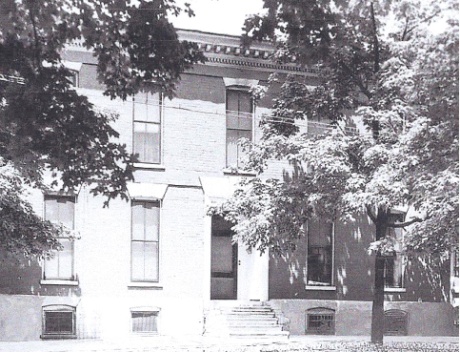
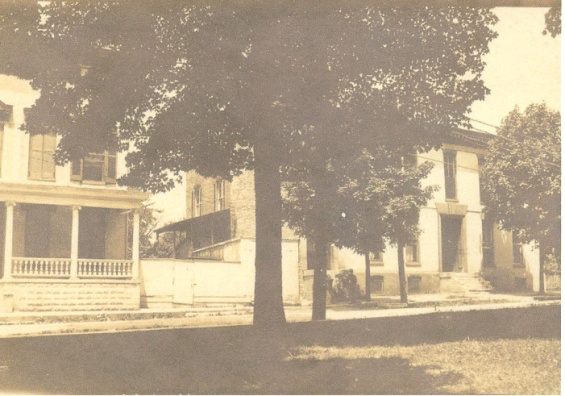
Photo of the Solomon Sharp home – used with the kind The Solomon Sharp home – permission of the Kentucky Historical Society photo provided courtesy of Maunsel White
One day in November, about 2 o’clock in the morning, a man named Jereboam Beauchamp came “to the rear side door” of the house and knocked. (Ref. 2225) This door led into the family dining room. When Congressman Sharp, “clad in his night shirt,” opened the door to find out who was knocking, Beauchamp stabbed him with a knife. The thrust of the blade “severed the large aorta about two inches below the pit of the stomach.” (Ref. 2286) Eliza, who had followed her husband to the door, witnessed everything. In a letter, dated December 25, 1825, Thompson Ware wrote:
“Your cousin, Betsy (Eliza) Sharp, lost her husband the 1st Sunday in November last by a midnight assassin. He was stabbed in the abdomen in his own house at 1 or 2 o’clock and expired without speaking a word in a few minutes in the midst of his family. The night before the Legislature was to meet (he was a member) a man was taken up on suspicion and sent for further trial. Poor Betsy was quite deranged for several days; she has since recovered and has come to her right mind. She has three children; a daughter and two sons . . . .” (Ref 35E)
![]() The
notorious trial and execution of Beauchamp was major news all over
the country. Eliza’s testimony was crucial, and she gained the
respect of many by her composure and strength of character on the
stand. Understandably
distraught, however, she later decided to change the name of her
youngest son from Thomas to Solomon - in honor of her husband. As
her aunt wrote in a letter to James, “She’s
a pretty sensible woman and has 3 fine children. They are Jean,
John Scott, and Solomon (he was called Thomas but after the death of
his father, they changed it (his name) to Solomon.”
(Ref. 597)
The
notorious trial and execution of Beauchamp was major news all over
the country. Eliza’s testimony was crucial, and she gained the
respect of many by her composure and strength of character on the
stand. Understandably
distraught, however, she later decided to change the name of her
youngest son from Thomas to Solomon - in honor of her husband. As
her aunt wrote in a letter to James, “She’s
a pretty sensible woman and has 3 fine children. They are Jean,
John Scott, and Solomon (he was called Thomas but after the death of
his father, they changed it (his name) to Solomon.”
(Ref. 597)
At some point before her death, her mother and two sisters moved in with Eliza because Lucy Webb wrote, “Your Aunt Scott (Catherine Ware Scott) with her two daughters (Catherine and Arabella), lives with Betsy (Elizabeth Scott) Sharp.” (Ref.1099) Eliza never remarried - living only to the age of 46. In 1844, she predeceased her mother by 17 years. (Ref. 483)
Eliza
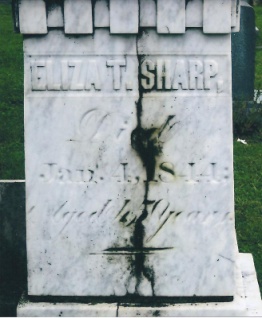

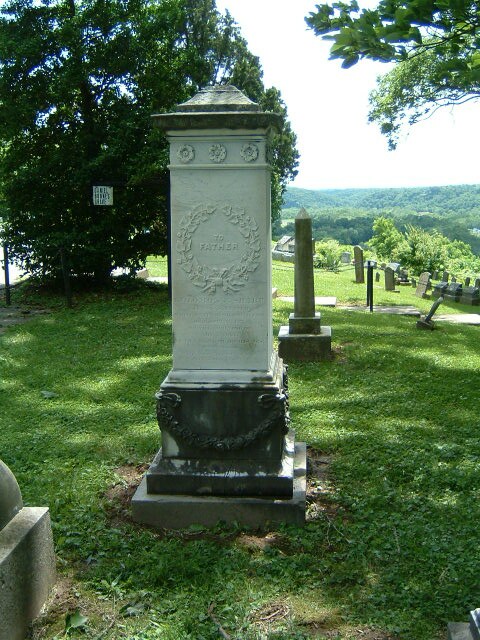 Solomon
Solomon
"Eliza T. Sharp, wife of S. P. Sharp, died January 4th, 1844 in her 45th year” “Precious in the sight of the Lord, is the death of his saints."
** The grave for Solomon P. Sharp is located in a special section of the cemetery for congressmen
Of the children of Solomon and Eliza, we know John Scott Sharp died in a ship wreck while returning from Europe where he had been sent on Confederate business, Solomon L. Sharp became a prominent and influential citizen of Bardstown who died in 1878, and Jane M. Sharp married William D. Reed and lived in Kentucky.
![]() William
Henry Harrison Scott
-
The
next few years may have been difficult ones for John and Catherine
as family records state that “there
were four children born to John Mitchell and Catherine Ware Scott
that died in infancy.”
(Ref.
2227) Eliza
was born in 1798, and it would be seven long years before another
baby came into their home. It seems probable that the four children
who died in infancy were given birth sometime during this seven year
gap. William Henry Harrison Scott, called Harrison,
was born in 1805. In a letter written by Lucy Webb, she mentioned at
the time that “Harrison
is living some distance from her [his
mother, Catherine],
I really do not know where. There was a report he was
married.”(Ref.
597)
Harrison had, indeed, gotten married. His bride was
Elizabeth
M. Wilkinson. One of their children was also
named William Henry Harrison Scott, and he “became
a physician like his grandfather and practiced in Danville,
Illinois.”
(Ref.
2219A, 2270)
William
Henry Harrison Scott
-
The
next few years may have been difficult ones for John and Catherine
as family records state that “there
were four children born to John Mitchell and Catherine Ware Scott
that died in infancy.”
(Ref.
2227) Eliza
was born in 1798, and it would be seven long years before another
baby came into their home. It seems probable that the four children
who died in infancy were given birth sometime during this seven year
gap. William Henry Harrison Scott, called Harrison,
was born in 1805. In a letter written by Lucy Webb, she mentioned at
the time that “Harrison
is living some distance from her [his
mother, Catherine],
I really do not know where. There was a report he was
married.”(Ref.
597)
Harrison had, indeed, gotten married. His bride was
Elizabeth
M. Wilkinson. One of their children was also
named William Henry Harrison Scott, and he “became
a physician like his grandfather and practiced in Danville,
Illinois.”
(Ref.
2219A, 2270)
![]() Catherine
Ware
Scott - At
the age of 30, Kitty
Scott gave birth to a daughter, Catherine Ware Scott - probably
named for both her mother and grandmother. Born in 1807, Kate (as
she was often called) was described by her Aunt Lucy as “very
sensible and economical. She would make one of the finest wives for
rich or poor.”
(Ref. 597)
Catherine
Ware
Scott - At
the age of 30, Kitty
Scott gave birth to a daughter, Catherine Ware Scott - probably
named for both her mother and grandmother. Born in 1807, Kate (as
she was often called) was described by her Aunt Lucy as “very
sensible and economical. She would make one of the finest wives for
rich or poor.”
(Ref. 597)
On June 4, 1834, at the age of 27, Kate wed Mr. William H. Johnson. (Ref.1099) “He served in the Kentucky Legislature for a year, but was assassinated on the road between Princeton and Hopkinsville by hirelings of a politician supposedly named Davis, who shortly afterwards left the state. (Ref. 2219, 2247, 2270)
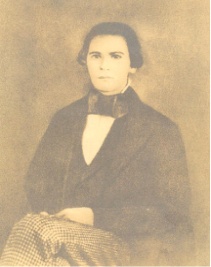 William Henry Johnson
The
couple
had three daughters: Photo
courtesy of Maunsel White
Catherine W. Johnson, Elisa S. Johnson, and Arabella W.
Johnson. Their final resting place is in the family section in the
Frankfort Cemetery. (Ref.
487, 1099)
William Henry Johnson
The
couple
had three daughters: Photo
courtesy of Maunsel White
Catherine W. Johnson, Elisa S. Johnson, and Arabella W.
Johnson. Their final resting place is in the family section in the
Frankfort Cemetery. (Ref.
487, 1099)
Grave of Catherine W. Scott Johnson
![]()
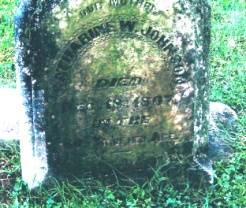
![]() Arabella Scott
– On March 14, 1811, Arabella Scott was born. Kitty now had a
busy home with Eliza (age 13), Harrison (age 6), Kate (age 4), and
the new baby. Hayden wrote in his book, “Eliza
Scott was a member of the first Sunday
school
in Kentucky where, in five months, she committed 719 verses of the
Bible and her sister, Arabella, 893
verses in six months.”
(Ref. 6,
2219A)
Arabella was 11 years old at the time. The following article in the
History
of Franklin County
lists all the memorizations made by the students in 1822.
Arabella Scott
– On March 14, 1811, Arabella Scott was born. Kitty now had a
busy home with Eliza (age 13), Harrison (age 6), Kate (age 4), and
the new baby. Hayden wrote in his book, “Eliza
Scott was a member of the first Sunday
school
in Kentucky where, in five months, she committed 719 verses of the
Bible and her sister, Arabella, 893
verses in six months.”
(Ref. 6,
2219A)
Arabella was 11 years old at the time. The following article in the
History
of Franklin County
lists all the memorizations made by the students in 1822.
![]()
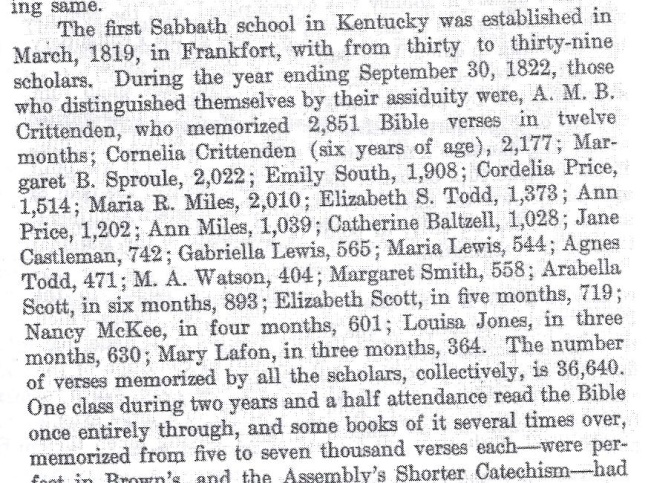
![]() (Ref.
2259)
(Ref.
2259)
Arabella married her first husband, William Milton Davis, in 1831. They had one daughter, Catherine Davis, who later married Major J. Alexander Grant. (Ref. 488,2219A) After her first husband died, Arabella married Sylvester Welch in 1838. “He was a Civil Engineer working for Allegheny Portage railroad, but he later became the Chief Engineer of Kentucky from 1837-1842.” (Ref. 488, 2219A, 2270) The couple had five daughters altogether, counting (1) Catherine from Arabella’s first marriage: (2) Mary, who wed Edward Hensley (3) Louisa, who wed Leopold Labrot; (4) Elizabeth, who wed Torbett Coryell; and (5) Arabella, who wed Edward Payson Bryan. (Ref. 2219A, 2241)
The interesting photo of the sisters on the next page was taken at the Labrot House on Main Street. Sitting from left to right are: Louisa Labrot, Catherine Grant, Arabella Bryan, and Mary Hensley. Eliza Coryell was not present. The Labrot house, a Greek revival residence located at 421 West Main Street, was owned by Kenner Taylor after Leopold and Louisa Labrot no longer lived there. It is interesting to note that Kenner Taylor was a relative of the current owners of Wareland – the property James Ware (Arabella’s great grandfather) first settled on in the 1700s.
The daughters of Arabella Scott Welch
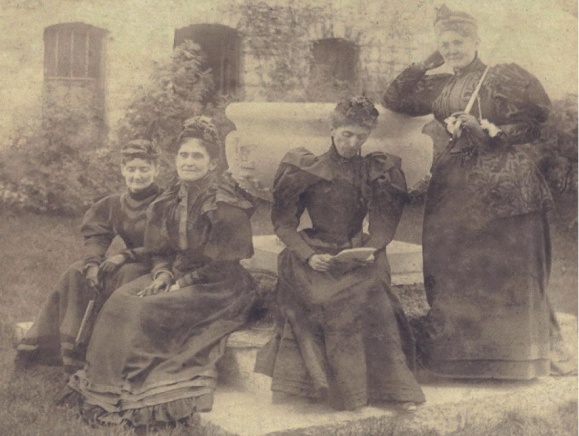
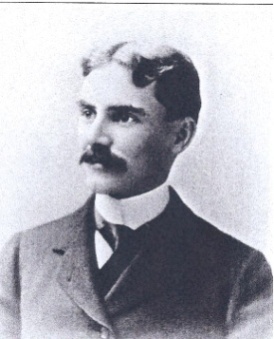 Leopold Labrot
(2561)
Leopold Labrot
(2561)
Photo kindly contributed courtesy of Maunsel White
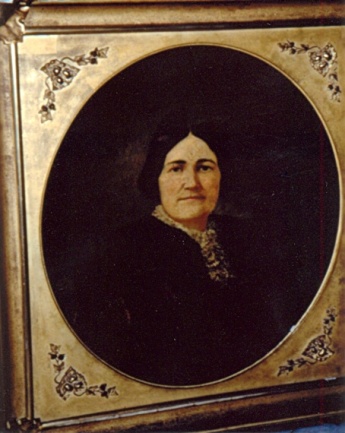 Arabella Scott Welch
Arabella Scott Welch
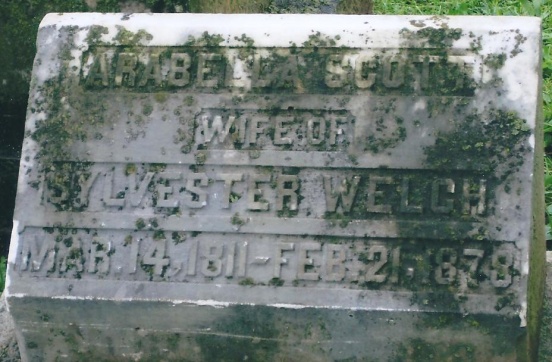 Arabella’s
grave
Arabella’s
grave
Arabella died on February 21, 1878. She was buried close to her family in the Frankfort Cemetery.
Grave for Arabella Welch Bryan (granddaughter of Catherine Ware Scott)
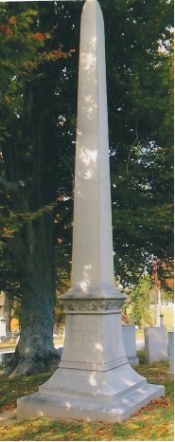
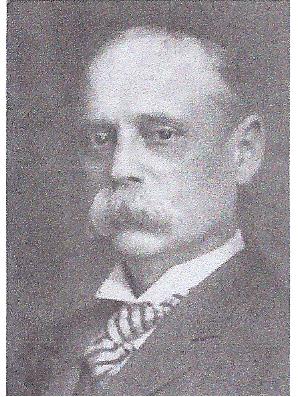 Edward P. Bryan
Edward P. Bryan
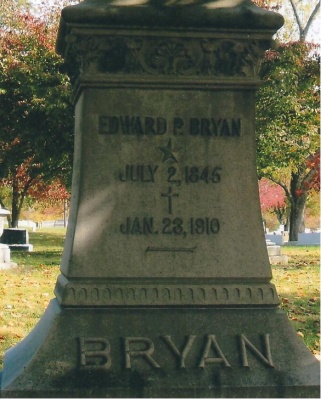
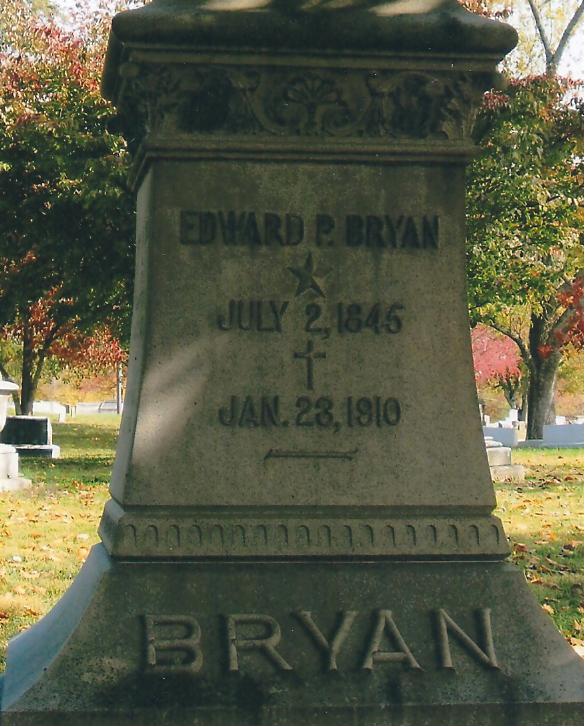 Arabella’s family
Arabella’s family
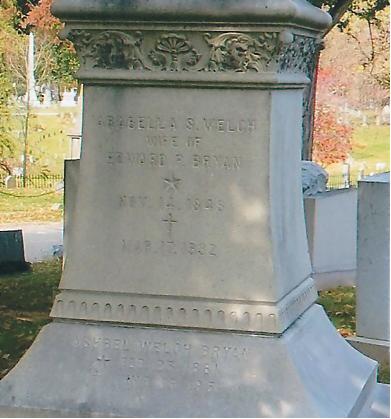
![]()
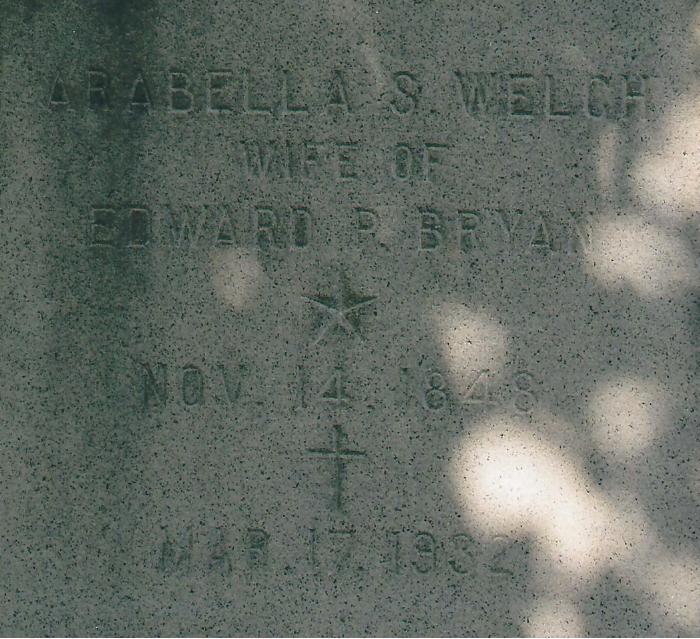
![]()
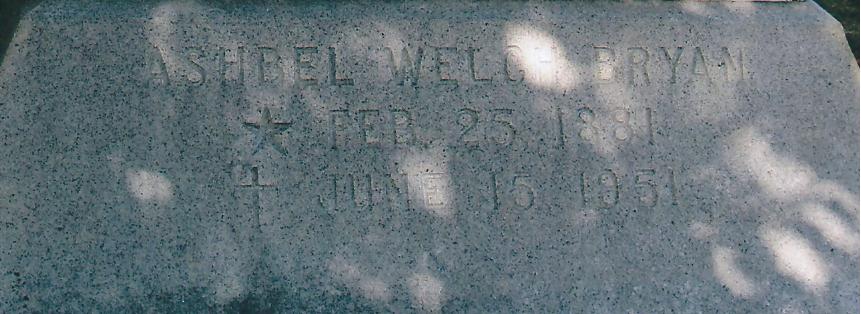
Catherine’s granddaughter, Arabella, and her husband (Edward Payson Bryan), “built a large brick house which was called Glen Tara.” (Ref. 2219A, 2241) One of their children was named Ashbel Welch Bryan.
![]() John
Mitchell Scott
- By
the time Dr. Scott was “heading
Scott’s Regiment of Kentucky Militia with the rank of Lt. Col. on
August 15, 1812,”
Catherine was about four months pregnant with (what would be) their
last child. (Ref.
1055) The
son she delivered on January 8, 1813 was, obviously, named in honor
of her husband. (Ref.
1032)
John
Mitchell Scott
- By
the time Dr. Scott was “heading
Scott’s Regiment of Kentucky Militia with the rank of Lt. Col. on
August 15, 1812,”
Catherine was about four months pregnant with (what would be) their
last child. (Ref.
1055) The
son she delivered on January 8, 1813 was, obviously, named in honor
of her husband. (Ref.
1032)
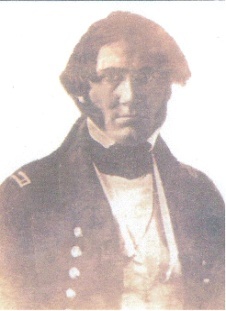 Photo courtesy of
Albert Bruns
Photo courtesy of
Albert Bruns
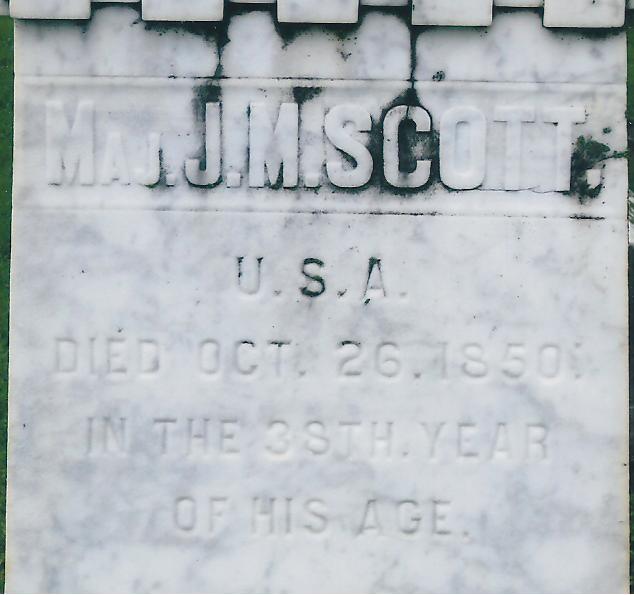 Grave
for John Mitchell Scott, Jr.
Grave
for John Mitchell Scott, Jr.
John Mitchell Scott, Jr., carried on the family tradition of military service. (Ref. 587, 602) In a letter from Lucy Webb, she stated, “Your aunt’s [Kitty’s] son, John, started three weeks ago to West Point; there to finish his education.” (Ref. 597) After graduation, he headed into battle and his promotion to Major was “for gallant and meritorious conduct in the several conflicts at Monterey, Mexico on the 21st, 22nd, and 23rd of September 1846.” (Ref. 2253) Major John Mitchell Scott, Jr. died on October 26, 1850, at the age of 38.
While Kitty and Dr. Scott were establishing themselves in Frankfort, John became well known as a man of many talents. He had a thriving medical practice, “served as a Justice in 1801, and was appointed Sheriff of Franklin in 1811.” (Ref. 484, 1033, 2220) As one author wrote, “he was a man of more than ordinary ability in his profession. Dr. Scott was decidedly military in his inclinations and in time became Colonel of a militia regiment at Frankfort.” (Ref. 2217) That devotion to service would be a hallmark of his reputation.
Taken from Virginia Roots in Kentucky Soil:
“The new country that had fought so hard to win its’ independence soon found itself again on the brink of war. Despite England losing her colonies to the American revolutionaries 25 years earlier, Great Britain, like many European countries, did not take the United States very seriously. Desperate to find sailors to man their naval fleet of over 1000 ships, arrogant British captains did not hesitate to stop and search American vessels in hopes of recovering seaman who had deserted. They felt free to board American ships at will - - a practice very galling to the new nation. Grumblings were getting louder and louder.
Great Britain, who was at war with France, had been irritating the Americans for some time. In 1807, using what Americans felt was misplaced authority, Britain had introduced a series of commerce restrictions to interfere with on-going American trade with France. America was not at war with the French, and the new nation hotly contested these restrictions as ‘illegal’ under international law. Congress, under the administration of James Madison, had a group of politicians in control called the ‘War Hawks’ who were zealous in their desire for America to be treated as a sovereign nation. Leading the movement, great orators like Henry Clay and John Calhoun were hard to ignore. To add insult to injury, the audacity of Great Britain in siding with the American Indians was ‘one more straw’ on the back of resentment that was rampant among the Americans.
The greatest slap against American pride was the continued impressment of American sailors on the high seas. This aggressive campaign not only involved the right for the British to search an American vessel, but it also gave any British officer the authority to make an “on-the-spot” decision concerning a seaman's nationality. Many of those targeted as deserters during these raids claimed American citizenship - a fact ignored by the British.
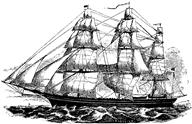 American anger at
these impressments grew hotter when British frigates
brazenly
stationed
themselves in United States territorial waters and searched ships in
full view of her own shores.
American anger at
these impressments grew hotter when British frigates
brazenly
stationed
themselves in United States territorial waters and searched ships in
full view of her own shores.
Another hot topic was Florida, which the War Hawks in Washington wanted to annex. Florida was held by Spain, a British ally. Things were on a collision course and, “in a move that surprised many, congress declared war on Britain on the 18th of June in 1812.” (Ref. 2254)
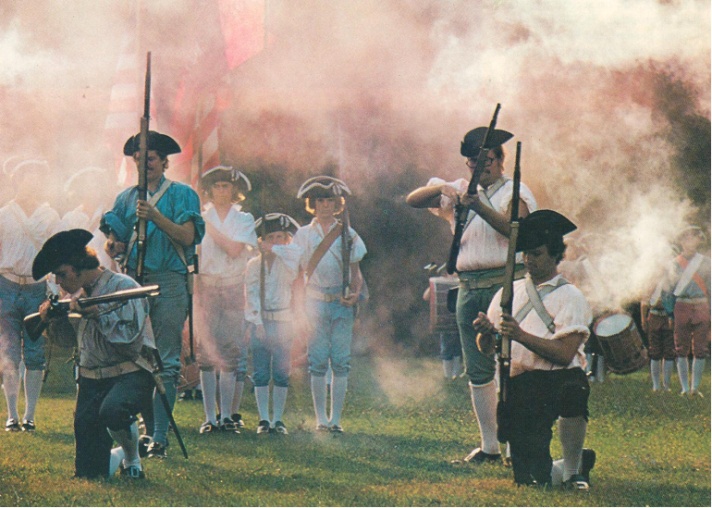 (Ref. 2537)
(Ref. 2537)
John Scott, as always, was ready to take command of his men, even though he was really not up to the task. “For some time prior to the outbreak of the war of 1812, Dr. Scott had been in poor health and fears were entertained for his recovery. It was not Governor Charles Scott’s intention, therefore, to appoint the doctor to an active role in the forthcoming campaign. Dr. Scott insisted on his right as Major of the 22nd Regiment though and on August 7, 1812, was officially appointed Lieutenant Colonel, Commandant, of the 1st Regiment, KY Volunteer Militia.” (Ref.1032, 2253)
Great efforts were made to dissuade John from endangering his health, “but as he approached his horse he was heard to mutter, ‘as long as I am able to mount you, none but myself shall lead my regiment either to fight or not to fight.’” (Ref. 2253) That decision would cost him dearly.
After 15 years of marriage, a very pregnant Catherine Scott would have to bury her husband who managed to make it home to be with her before his demise. She went into labor eight days later and delivered their last child - naming him, fittingly, John Scott. Her husband was buried Monday, December 21st with full military honors. James Ware wrote to her brother in Virginia, “I almost hate to go to Frankfort to see poor Kitty.” (Ref. 298)
![]()
Obituary from the “Kentucky Gazette”: “Died on Sunday evening last, Col. John M. Scott, of this place. He accompanied the troops at the head of his regiment on the late expedition against the Indians under General Harrison, but owing to increasing debility he was forced to leave his regiment and return home about three weeks since. In the death of Col. Scott, his family is deprived of an affectionate husband and parent – his country of a brave officer, and society, a loss not to be repaired. His military acquirements were conspicuous; as a physician he was eminent. On the knowledge of this melancholy event, the following resolution was unanimously adopted by both branches of the Legislature: “Resolved, by the senate and house of representatives of the Commonwealth of Kentucky, that as a public testimony of the high respect and estimation in which they hold the memory of Col. John M. Scott, who departed this life on the night of the twentieth instant, they will attend his burial this day at four of the clock.” (Ref. 484, 485)
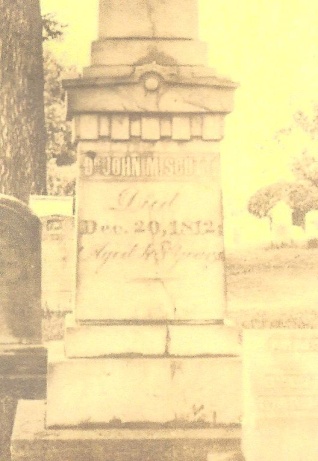
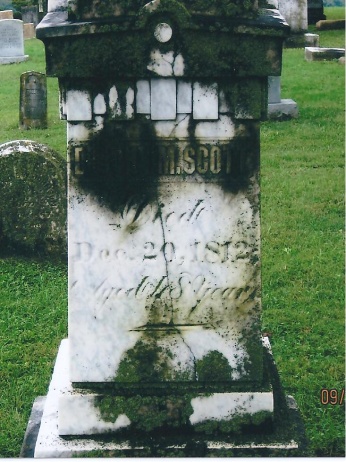 Older
photo courtesy of Maunsel White Photo
taken by Judy Ware 2009
Older
photo courtesy of Maunsel White Photo
taken by Judy Ware 2009
Catherine Scott was left a widow at the age of 35, never to wed again. Sometime after her oldest daughter Eliza married, Catherine and her two younger daughters went to live with her. “On December 11, 1861, Kitty Scott died at the age of 84.” (Ref. 942) She was buried close by her husband in the Frankfort Cemetery.
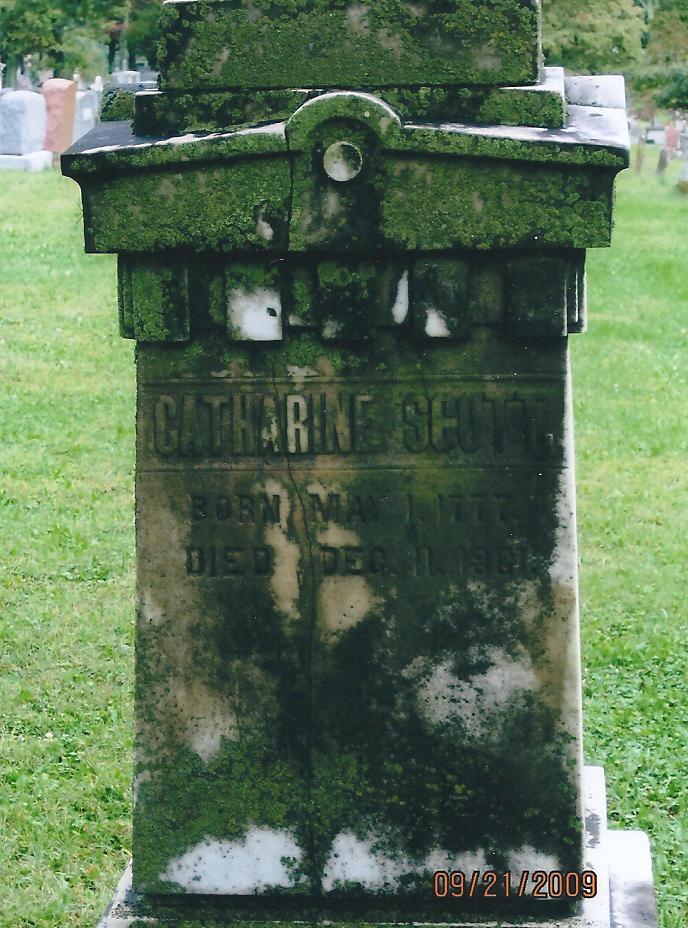

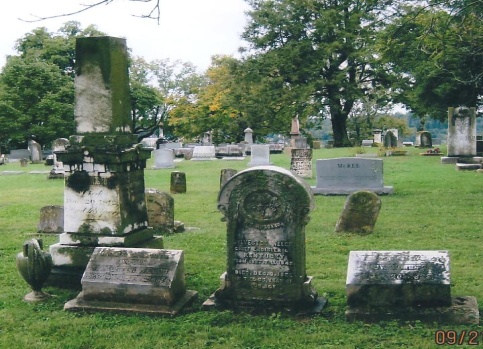 Catherine
Ware Scott Scott section of the
cemetery
Catherine
Ware Scott Scott section of the
cemetery
![]()
![]()
7. George Ware The last child of James and Caty Ware was George Ware, born on February 9, 1779. By this time, James was 38 and Caty was 26 years old. George came into the world with no lack of siblings with which to play. Thompson was 10, James 8, Polly 7, Lucy 6, Charles 4, and Kitty was 2 years old.
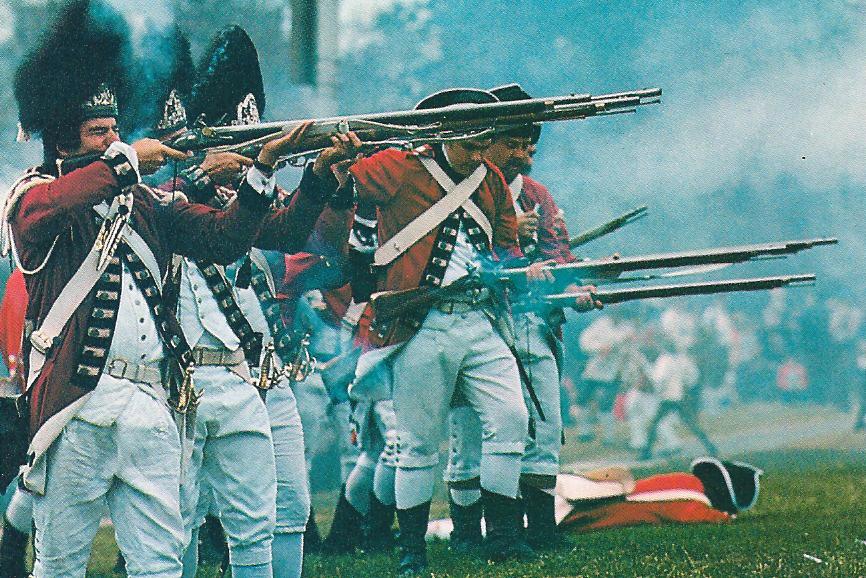 The stress of the times
was something both James and Caty still had to bear, but “two
years after the birth of George Ware, the War for Independence took a
dramatic twist in [their]
home colony of Virginia. On October
19, 1781, British General Charles Cornwallis surrendered his army,
consisting of some 8,000 men, to General George Washington at
Yorktown, thereby giving up any chance of Great Britain winning the
war. The fighting did not end immediately, but Cornwallis’
surrender was certainly the death knell for England’s thoughts of
celebrating a victory.”
(Ref. 2350)
The stress of the times
was something both James and Caty still had to bear, but “two
years after the birth of George Ware, the War for Independence took a
dramatic twist in [their]
home colony of Virginia. On October
19, 1781, British General Charles Cornwallis surrendered his army,
consisting of some 8,000 men, to General George Washington at
Yorktown, thereby giving up any chance of Great Britain winning the
war. The fighting did not end immediately, but Cornwallis’
surrender was certainly the death knell for England’s thoughts of
celebrating a victory.”
(Ref. 2350)
The change on the Revolutionary War front was a precursor for all the changes that were coming on the home front. “George spent his first formative 12 years in Virginia, but he would know Kentucky as his home longer than any of his brothers and sisters. He settled with James and Caty on their new land in Fayette County until he married.” (Ref. 2530)
In 1812, George Ware experienced two life altering events - - he went to war and he got married. Serving under the command of Captain James Taylor, he joined the ranks of other Ware men who proudly served their country.
![]()
![]() Military record for
George Ware
Military record for
George Ware
![]()
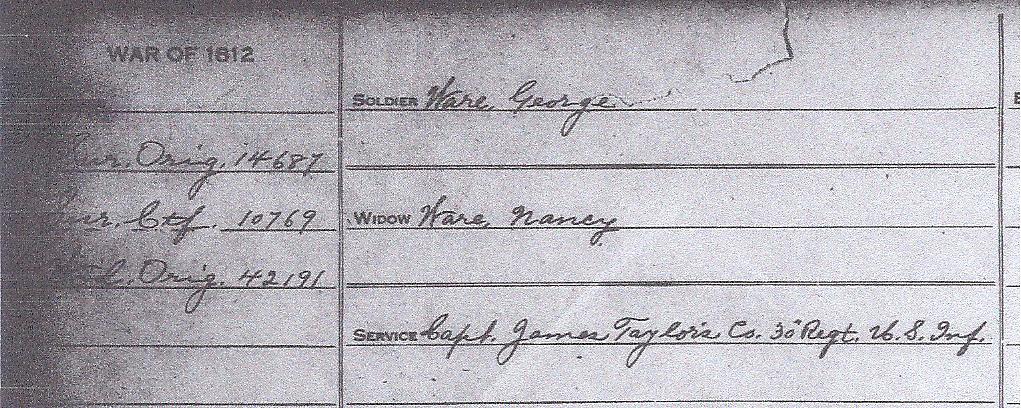 Pension
Record
Pension
Record
There is not much known about George’s war experiences, but it is interesting to note that his son, Abram, also did military service during this same war.
On October 8, 1812, George married a neighbor’s daughter, Nancy Ferguson. James was obviously pleased about the union because he wrote in a letter back home that “George Ware is married at last to Mrs. Ferguson’s daughter; a close neighbor . . . he was married the day I started from Frederick.” (Ref. 298) George was 33 years old at the time and Nancy was 22.
The newlyweds “lived on the land of James Ware II.” (Ref. 940) By 1812, Thompson had already married and settled his own property close to Centerville. James III had returned to Virginia where he married and built his estate of Riverside on the Shenandoah River. Polly, Lucy, and Catherine were married and obviously living with their husbands, and Charles had gone back to Virginia for a while, but then returned, married, and settled on his property. George, only 12 when the migration to Kentucky took place, had naturally stayed with his parents (James and Caty) to help them with their home and property. It was logical that he and his wife would also continue to stay, not only to help the older Wares, but to inherit that property into which George had invested so much of his labor. George would later bequeath the acreage to one of his own sons, Abram, who also grew up there. A family bible states that Abram, “always having lived on his father’s place which had also been his grandfather’s,” inherited the property. (Ref. 940)
George and Nancy had a large family - it seemed like a new baby came into the home about every two years. Nancy delivered ten children in all. The following is information on each of their offspring: (1) Elizabeth Catherine Ware - One year after their wedding, Nancy gave birth to Elizabeth Catherine Ware on July 11, 1813. The couple called her Catherine, probably in honor of George’s late mother. At the age of 20, Catherine married Robert James Didlake on January 31, 1833. The couple had the following children: Mary (1833-1890), George (1835-1895), Anna (1836-1924),
Laura (1838-1916), Amanda (1840-1880), Ellen (1846), and
Kate (1852-1903). Robert, a proprietor of the Broadway Hotel in Lexington, died in February of 1859, and Catherine passed away on July 4, 1868, at the age of 55.
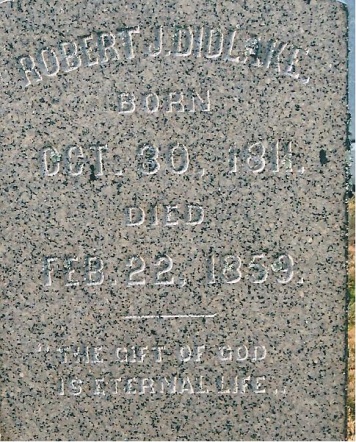
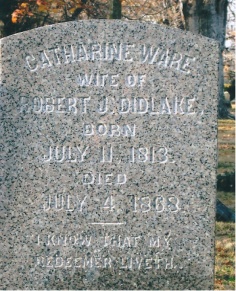
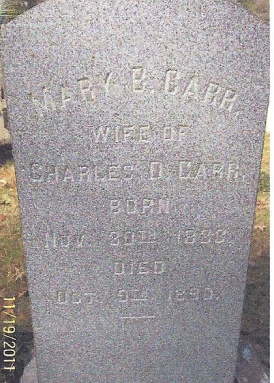
Grave of Robert Didlake Grave of Catharine Ware Didlake Mary Didlake Carr
Mary B. Didlake (1833-1890) Mary wed Charles D. Carr.
George Ware Didlake (1835-1895)
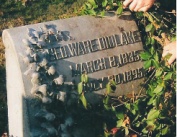
Anna Ferguson Didlake (1836-1924) Anna never married, but she lived to be 89 years old.
Laura Didlake (1838-1916) Laura
married James Shropshire.
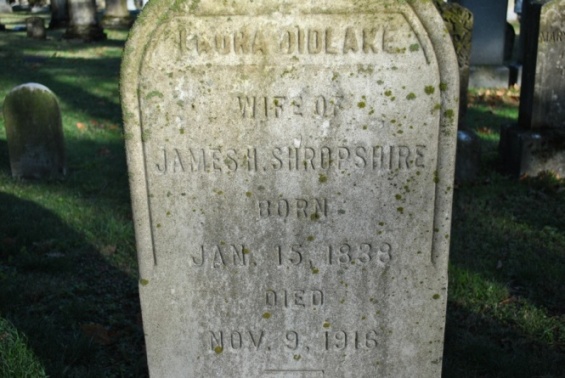
Amanda Didlake (1840-1880) Amanda
married James L. Watson.
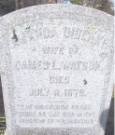
Ellen Didlake (1846-1863) Ellen
died at age 17.
![]()
Kate Didlake (1852-1903) Kate
married Robert Berry.
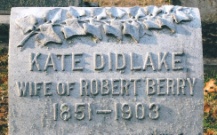
(2) Mary Ann Webb Ware – George and Nancy welcomed another daughter on December 18, 1814. She was named Mary Ann Webb Ware, most likely after George’s Aunt Polly, whose full name was Mary Ann Todd Ware Webb. In a letter from Lucy Webb, she wrote, “Your Uncle George Ware’s family are well. [As of this date] he has two daughters, nearly grown – Catharine, she is a handsome girl with a good figure, and Mary Ann.” (Ref. 597) Mary Ann married Thomas Woods Goodloe on January 17, 1844, at the age of 30. They never had any children, and Mary died in January 1887.
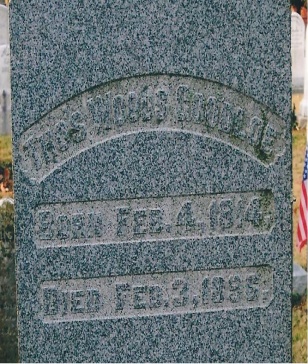
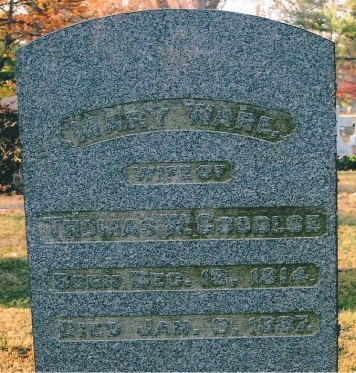 Grave
of Thomas Woods Goodloe Grave of Mary Ware Goodloe
Photos
courtesy of James and Judy Ware 2010
Grave
of Thomas Woods Goodloe Grave of Mary Ware Goodloe
Photos
courtesy of James and Judy Ware 2010
(3) James Todd Ware - Almost two years later, to the day, Nancy gave birth to the next child. On December 23, 1816, James Todd Ware was born; honoring both maternal and paternal grandparents with his name. James lived to be 55, and died on Wednesday, July 5, 1871.
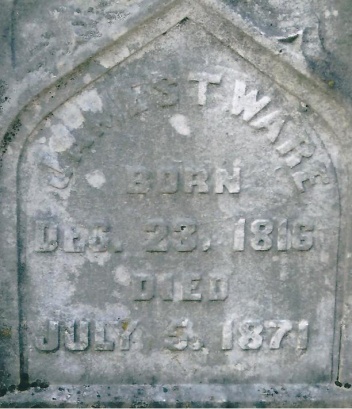
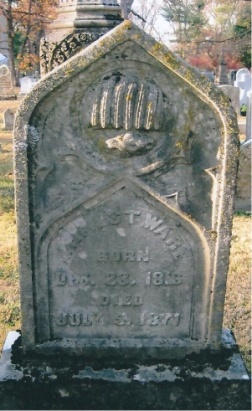
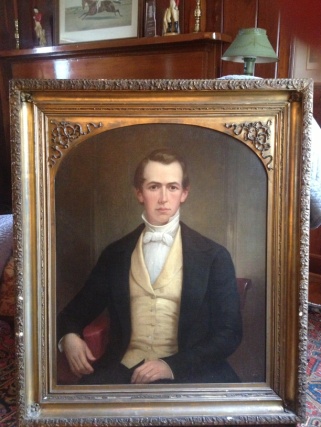 Grave
of James Todd Ware James Todd Ware
Grave
of James Todd Ware James Todd Ware
Descendants of the Shropshire family who had possession of this painting in 2013 recall this as a portrait of James Todd Ware, son of George and Nancy Ware.
I would like to thank Jim and Jane Shropshire for sharing the beautiful painting of James Todd Ware with the family. It has provided a wonderful opportunity to see, again, family characteristics that continue to be passed down through the generations.
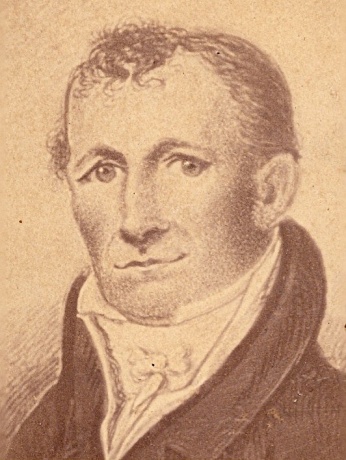 1st
cousins
1st
cousins
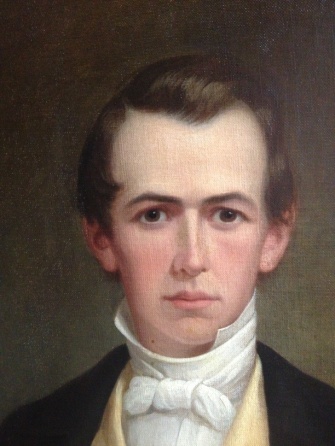
Josiah Ware (1802 – 1883) James Todd Ware (1816 – 1871)
(4) Ann Ware – Nancy had a daughter on October 13, 1818. Named Ann, this child only lived to be 22 years old. She died on September 12, 1840.
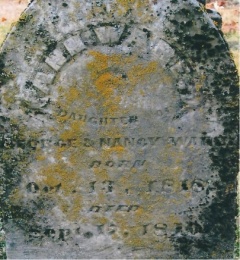 Ann
Ware
Ann
Ware
(5) Abraham Ware – In 1820, Abraham Thompson Ware, always known as Abram, was born. Grandpa James had passed away two months before his birth. It would be Abram, however, who would one day inherit the land his grandfather carved out for the family.
![]() Abram
Ware loved farming and spent his whole life on the family land. His
occupation of ‘farmer’ is recorded in Pioneer
Record and Reminiscences of the Early Settlers,
written by Rufus Putnam. (Ref.
2281) He
was well known in Fayette County and obviously held in high regard.
One local publication mentioned several men residing in the area, and
his name appeared above the notation - “the
above are all farmers and honest men.”
(Ref.
2281) Abram
never married, and he was the last namesake of James
and Caty to live on the Ware property. On Thursday, September 29,
1890,
“Abraham
Ware,
an old
and wealthy farmer of Fayette County, died.”
(Ref. 940,
964)
Abram
Ware loved farming and spent his whole life on the family land. His
occupation of ‘farmer’ is recorded in Pioneer
Record and Reminiscences of the Early Settlers,
written by Rufus Putnam. (Ref.
2281) He
was well known in Fayette County and obviously held in high regard.
One local publication mentioned several men residing in the area, and
his name appeared above the notation - “the
above are all farmers and honest men.”
(Ref.
2281) Abram
never married, and he was the last namesake of James
and Caty to live on the Ware property. On Thursday, September 29,
1890,
“Abraham
Ware,
an old
and wealthy farmer of Fayette County, died.”
(Ref. 940,
964)
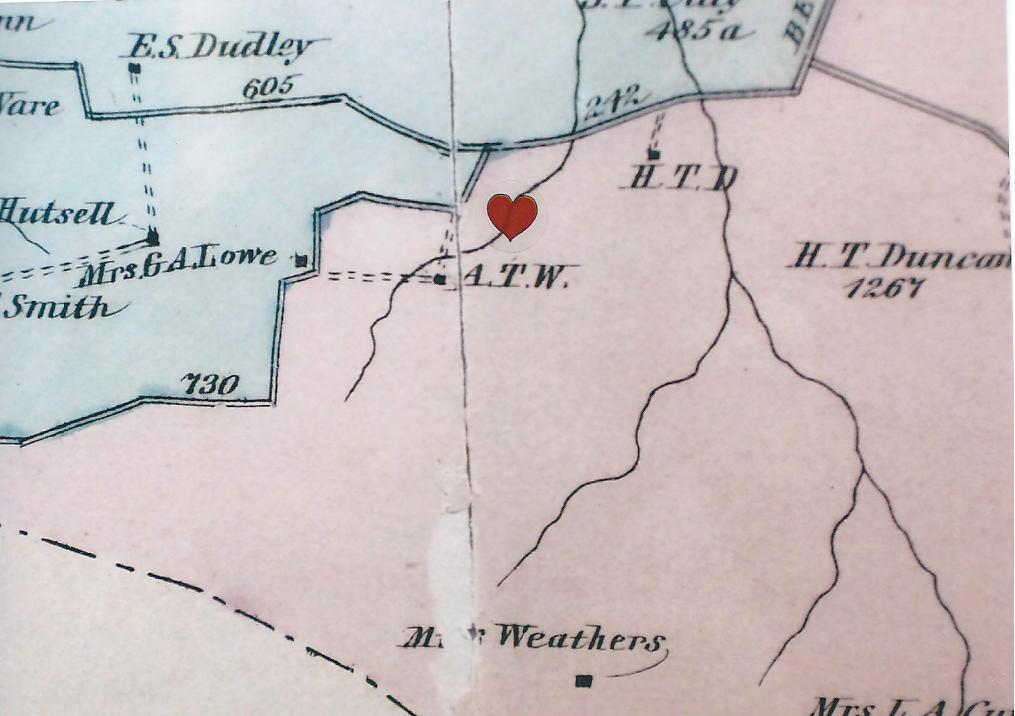
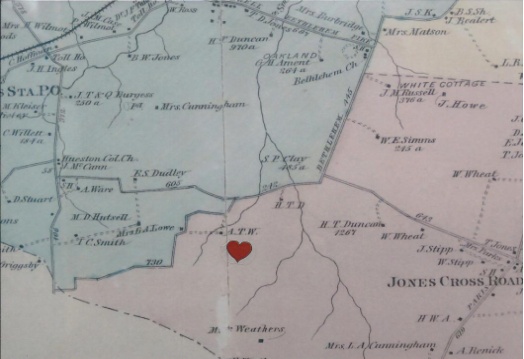
Maps showing the location of the land of A. T. W. (Abram Thompson Ware).
The land was originally settled by his grandfather, James Ware II.
The property of Dr. James Ware had originally been inherited by George and then passed to his son, Abram. Ten years before his death, however, Abram decided to divide the land with his younger sister, Lucy Ware Shropshire. It was a logical thing to do when you look at the family situation he faced. In 1884, there was only one of his eight other siblings who had any interest in the land. His sister, Elizabeth, had died in 1868; Mary Ann was childless; James Todd had died in 1871; Ann in 1840; Cliff died in 1866; Charles died young; John had passed away in 1867; and even his baby brother, Joseph, had died in 1853. It would make perfect sense that Abram (a lifelong bachelor with no children) would want to ensure that the land his grandfather settled on would stay in the family. So, in 1884, the Ware land “was divided between Abram and his sister, Lucy Ware Shropshire.” (Ref. 2600) She would, after Abram’s death, be the sole owner of all the property. It would not be until 1898, however, before all his legal paperwork was finally settled.
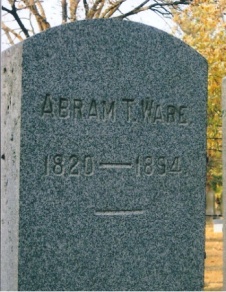
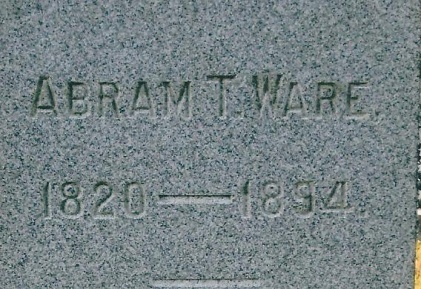 Photos taken by Judy Ware
2010
Photos taken by Judy Ware
2010
Grave marker for Abraham Thompson Ware – son of George and Nancy Ware and grandson of James and Caty Todd Ware.
(6) Clifton Ware - Another son was born to George and Nancy on December 29, 1822 - George Clifton Ware. He was always called Clifton, and he joined siblings: Catherine (9), Mary Ann (8), James (6), Ann (4), and Abram (2). The Ware family was growing rapidly. Clifton lived to be 44 years old, dying on April 5, 1866.
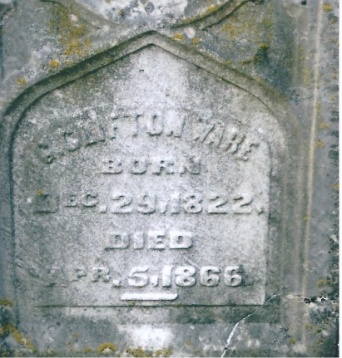
Grave of George Clifton Ware in Lexington Cemetery Photo taken by Judy Ware 2010
(7) Charles William Ware – This son arrived on April 7, 1825, but very little is known about Charles William Ware. Even his tombstone is very hard to read.
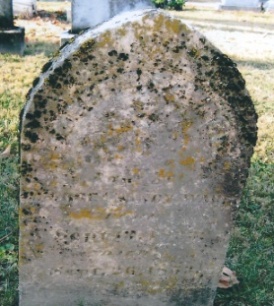 Charles
William Ware
Charles
William Ware
(8) John William Ware - Another son, John William, was born into the family on September 16, 1867. He died at the age of 40 on August 31, 1867.
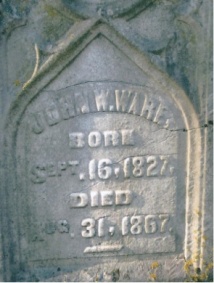 Grave
of John W. Ware in Lexington Cemetery
Grave
of John W. Ware in Lexington Cemetery
(9) Lucy Arabella Ware – Nancy delivered a daughter, Lucy Arabella Ware, on September 24, 1830. At age 30, Lucy wed James Hutchison Shropshire on Oct. 11, 1850. “Lucy and James had the following children: Mary, who married Mat Simpson; Catherine, who married David Field; Cliff, who married, first Miss Kinnaird, and then Miss Willie Robb; and Laura who never married. Lucy died in 1876 at the age of 46. Her husband lived another 46 years and [married] Laura Didlake, the niece of his first wife.” (Ref. 2227) Laura was the daughter of Catherine Ware, who had married Robert James Didlake. Both the Didlake and Shropshire families lived by Dr. Ware and Caty.
![]()
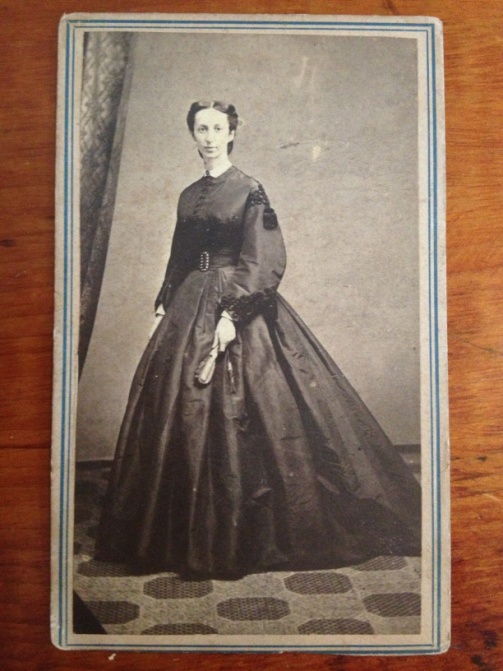
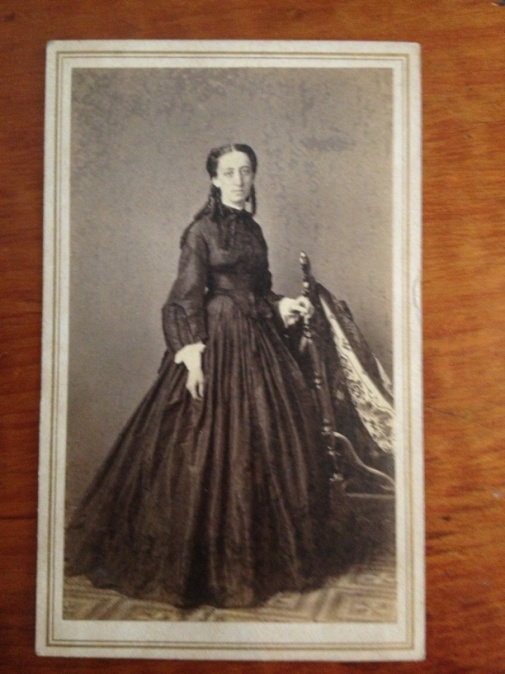
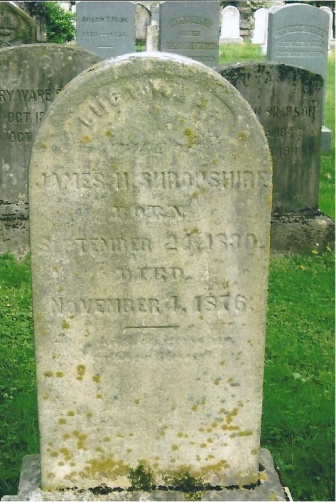
Lucy’s Grave
Lucy Ware Shropshire – both photos provided courtesy of Jim and Jane Shropshire of Kentucky
The map below reflects both family names.
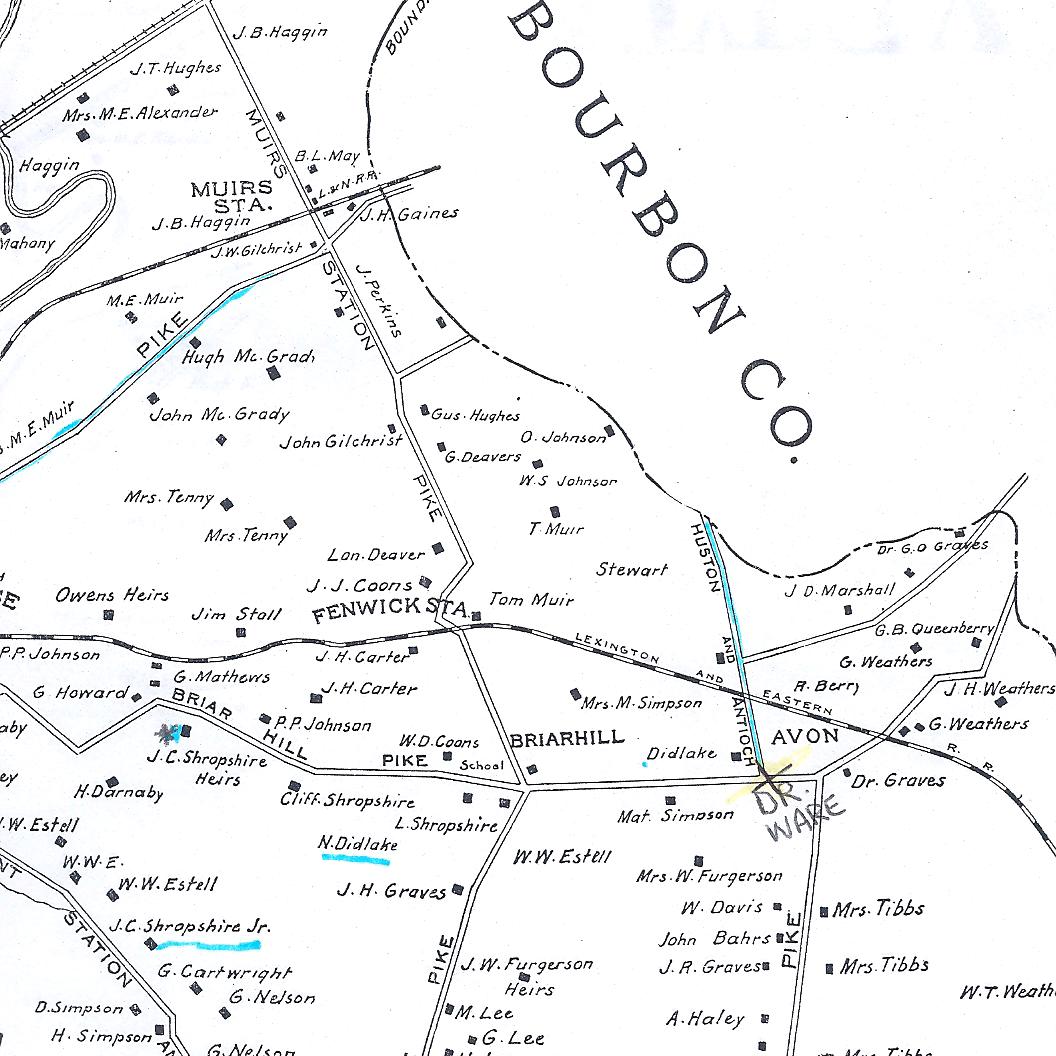 Map showing the location
of the property of James Ware and the properties of both Didlake and
Shropshire families
Map showing the location
of the property of James Ware and the properties of both Didlake and
Shropshire families
(10) Joseph Scott Ware - George and Nancy had their last child on September 13, 1833, and named him Joseph Scott Ware. Nancy was 43, George was 54, and the age gap between their first child (Catherine, born in 1813) and baby Joseph was 20 years. Ironically, this child was born in the middle of the cholera epidemic which killed so many other family members. He survived the cholera, but still died young on (age 20) September 26, 1853, of “flux.” Flux was often the term used to describe what is now known as bloody diarrhea or dysentery. The combination of loss of water and blood could rapidly cause dehydration and eventually death. (Ref. 586,602, 940,970)
Photo
taken by Judy Ware 2010
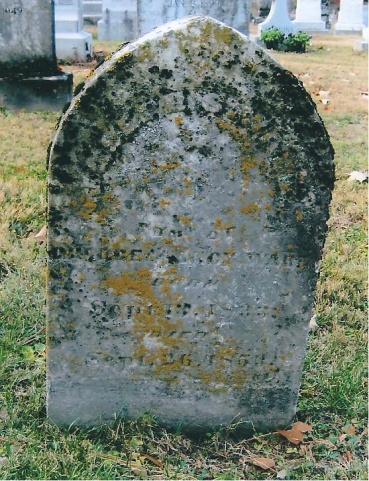 Grave of Joseph Scott Ware
Grave of Joseph Scott Ware
![]()
George Ware worked hard to take care of the legacy passed on to him by his father. With the help of his sons and slave labor, he (like most Fayette County farmers) “produced a range of livestock which included cattle, pigs, mules, chickens, and sheep. Also, many of the county’s farms produced wheat, hay, corn, and tobacco . . . . The land was a key to unlock the potential of one’s present state of welfare and a way to provide for future prosperity.” (Ref. 2600)
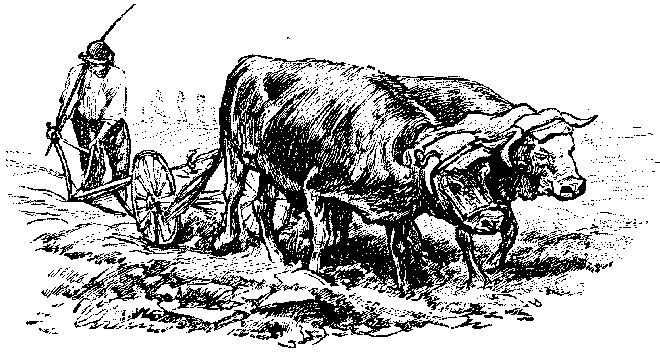 In keeping with his
status as a land owner, George was also active in civic matters. He
was “appointed
overseer of Cleveland’s Landing Road towards Bourbon from Estes’
Tavern to the Bourbon line, in place of Jeramiah White.”
(Ref. 1044)
Just as his brother, Charles Ware, George also served in the
capacity of a county commissioner. Being
a property owner came with definite responsibilities, and George had
quite a bit of land.
In keeping with his
status as a land owner, George was also active in civic matters. He
was “appointed
overseer of Cleveland’s Landing Road towards Bourbon from Estes’
Tavern to the Bourbon line, in place of Jeramiah White.”
(Ref. 1044)
Just as his brother, Charles Ware, George also served in the
capacity of a county commissioner. Being
a property owner came with definite responsibilities, and George had
quite a bit of land.
The following excerpt from the 1838 Directory of Landowners in Lexington, Fayette County, Kentucky allows us to see the amount of acreage the Wares owned at that time and how far away they lived from the Lexington Courthouse. Before George’s death, the combined property he and his son, Abram, possessed was 807 acres. Clearly, either Dr. Ware or George had previously sold (or given away) 693 acres that were part of James’ original land claim.
 from
Court House at Lexington.”
from
Court House at Lexington.”
![]() Ware
Geo., 684, Old Frankfort road, 4 m.
Ware
Geo., 684, Old Frankfort road, 4 m.
![]()
Ware
Abraham, 123, Russel road, 5 m.
During their years in Kentucky, George and Nancy also embraced the Baptist faith and became active members of the David’s Fork Baptist Church. We know from the church records that some of their slaves attended there as well, and the following people were baptized: “Charlotte, Caty, Alsy, Jane, George, John, Clary, Celia, and Caleb.” (Ref. Church Records)
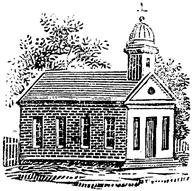
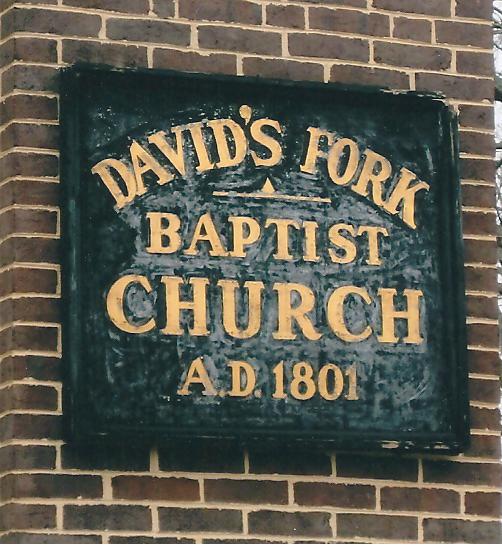 Sign
on David’s Fork Church
Sign
on David’s Fork Church
The Wares were married for 37 years. Nancy died less than two months after George, and since we now know that “George Ware, of near David’s Fork meeting house, died of cholera on Saturday, July 28, 1849,” it would seem safe to assume that Nancy’s death on September 14th could have been related to cholera as well. (Ref. 940, 975, 1069) George was 71 when he died, and Nancy was 59. Both were buried in the Lexington Cemetery. (Ref. 975)
![]()
![]() Death
notice for George Ware (Ref.1069)
Death
notice for George Ware (Ref.1069)

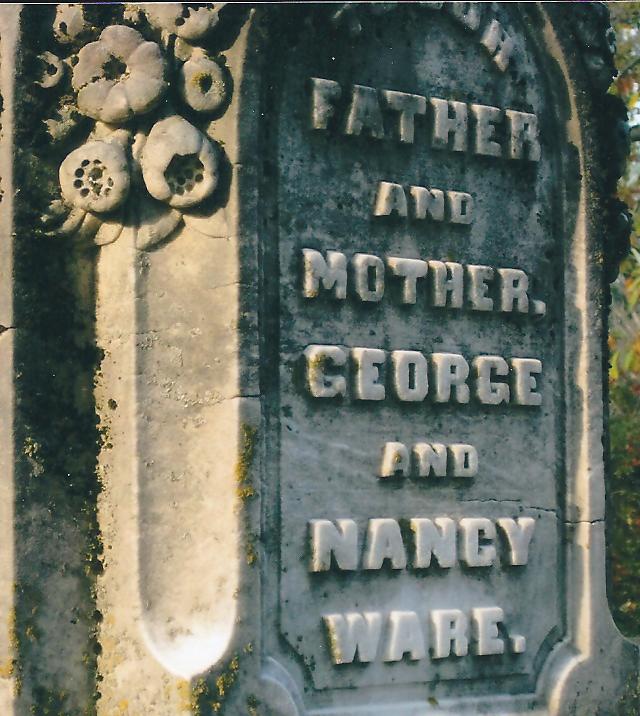
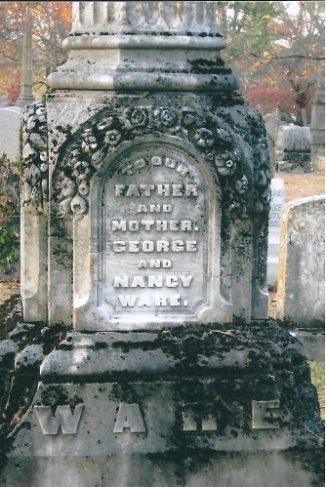
Monuments for George and Nancy Ware located in family section of the cemetery
Photos below show the original old grave markers for George and Nancy Ware and the placement of those stones in relation to the larger monument erected for them later.
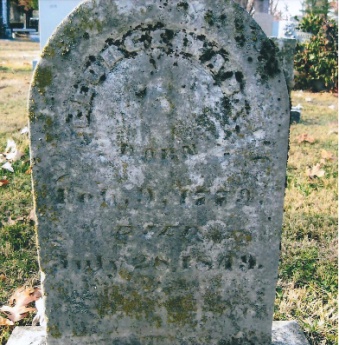 e
e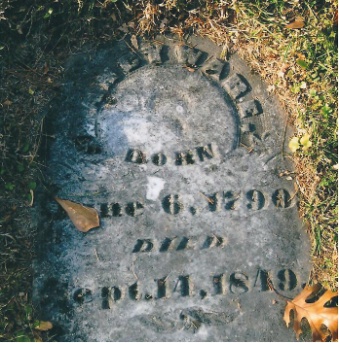
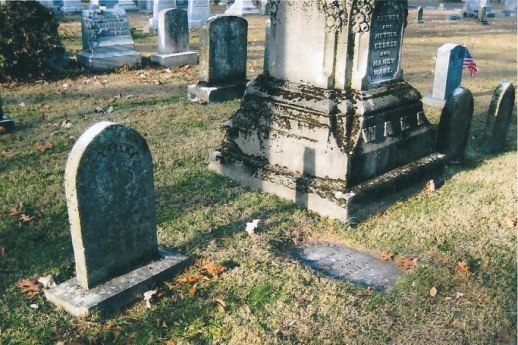 Photos
courtesy of James and Judy Ware 2010
Photos
courtesy of James and Judy Ware 2010
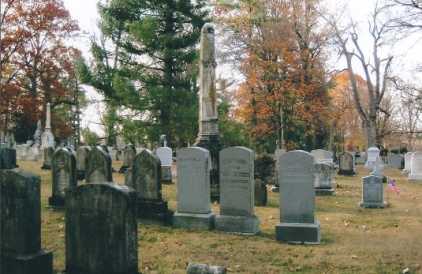
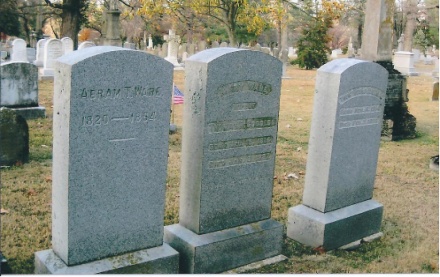
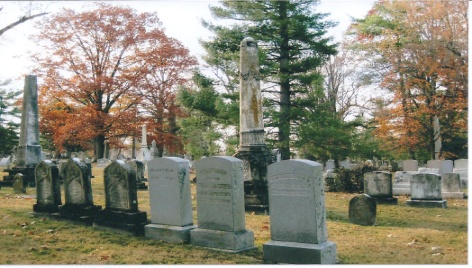
Graves of Abram Ware, Mary Ware Goodloe, and Thomas Woods Goodloe
Family section in the Lexington Cemetery

![]()
Lexington would grow unbelievably in the years after Dr. James Ware and Caty first arrived. When James had first visited in 1784, “there was not then a shingle roof in Lexington. The court house was an open log building with a board roof.” (Ref. 2288) By the close of that very year, “several stores, which provided a ready market for supplies produced by the farmers” had set up business. In 1788, the town newspaper listed advertisements for such comforts as silk, china, cotton stockings, spelling books, sewing needles, garters, and even small looking glasses. (Ref. 2288) By the time the Wares arrived in 1792, merchants (ranging from blacksmiths, to silversmiths, to watchmakers, to bakers) had set up shop. (Ref. 2288) By 1810, Lexington “was considered the largest town in the state at that time. There were nine ropewalks, four cotton bagging mills, an oil carpet factory, three paper mills, three grist mills, four coach factories, six cabinet makers, four soap and candle factories and three tobacco factories.” (Ref. 2535) Dr. and Mrs. Ware were fortunate to be on the “ground floor” of such growth and prosperity. Early Lexington
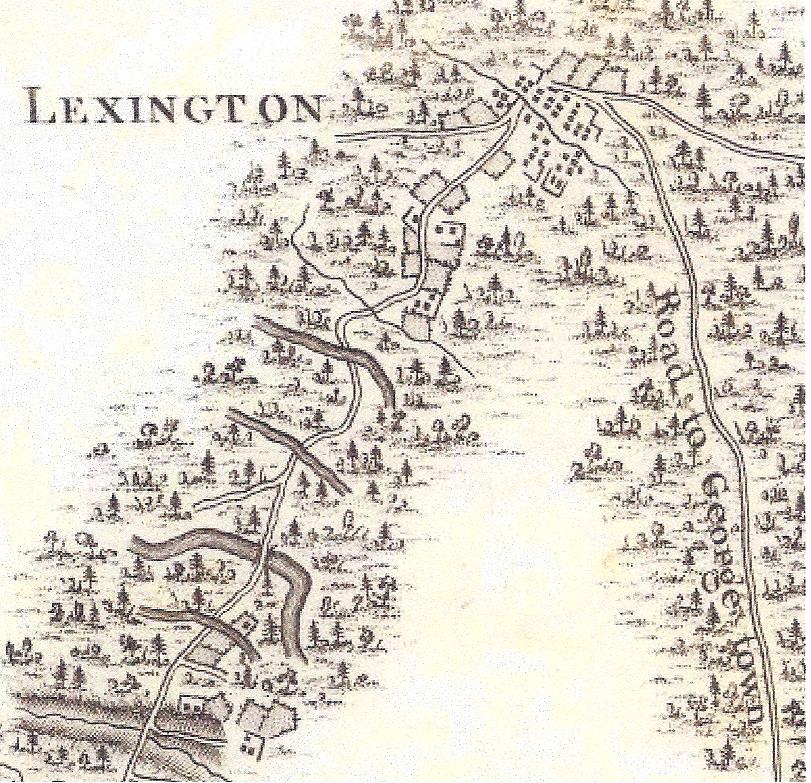

The modern map below will show the following landmarks –
(1) Forks of Elkhorn, (2) Frankfort (where Caty Scott lived), (3) Woodford (where James Ware I built his home), (4) Versailles, (5) one branch of Elkhorn Creek, (6) Fayette County, (7) Lexington, (8) Paris, (9) Hinkston Creek, (10) Stoner Creek, (11) Centerville, (12) another branch of Elkhorn.
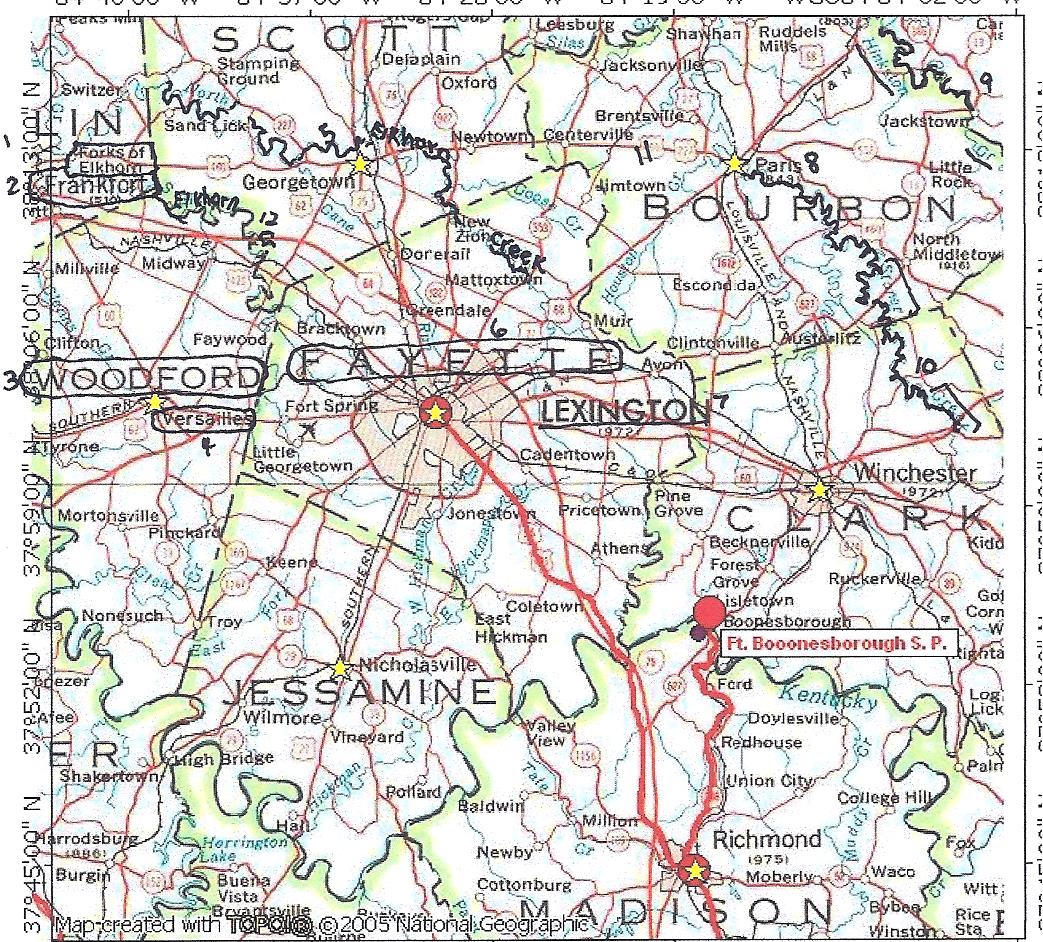
Their land was
perfectly suited for the production of good crops and nurturing
livestock that would soon rival the best breeding farms in Virginia.
“It
would not be long before Kentucky would be known as the epicenter of
good horse flesh; a reputation it still maintains today.”
(Ref. 2350)
 From its earliest
days, racing was as much a part of Kentucky life as breathing. “The
first Lexington
horse races took place on the Water Street Commons in 1787, but the
town trustees banned Main Street racing in August.” (wikipedia)
The
problem continued though, and in 1793, “the
citizens were much worried at this time regarding the jockeys racing
their horses through the streets . . . the trustees promptly met and
issued strict orders, confining the racing to the lower end of the
Commons (west Water street) where stud horses can be shown.” (Ref.
2288) More
measures were taken in “July
1797, [when]
the
Kentucky Jockey
Club was officially organized and established rules
that were generally adopted at other state tracks.”
(Ref. 2288, 2543)
From its earliest
days, racing was as much a part of Kentucky life as breathing. “The
first Lexington
horse races took place on the Water Street Commons in 1787, but the
town trustees banned Main Street racing in August.” (wikipedia)
The
problem continued though, and in 1793, “the
citizens were much worried at this time regarding the jockeys racing
their horses through the streets . . . the trustees promptly met and
issued strict orders, confining the racing to the lower end of the
Commons (west Water street) where stud horses can be shown.” (Ref.
2288) More
measures were taken in “July
1797, [when]
the
Kentucky Jockey
Club was officially organized and established rules
that were generally adopted at other state tracks.”
(Ref. 2288, 2543)

James had bred horses while they lived in Virginia, and undoubtedly brought that passion for good horse flesh with him to his new home. One of his best racehorses, Godolphin, won many races and became quite famous. In the early 1800s, it was noted that in Kentucky, “horses are raised in great numbers, and of the noblest kinds. A handsome horse is the highest pride of a Kentuckian; and common farmers own from ten to fifty.” (Ref. 2543) James clearly adhered to that principle. (See following documentation)

![]()
![]()
![]() From
an article printed in 1835
From
an article printed in 1835
![]()

Note written by James Ware in 1806 verifying the lineage of a horse named Mendoza
Cornelia Ware made an interesting observation when transcribing old Ware family letters from the late 1700s. “In reading the old letters, punctuation is almost nonexistent, with capitals thrown in indiscriminately, but one thing I notice is that there are three words that are unfailingly capitalized, namely ‘Money’, ‘Interest’ and ‘Horse’. These old Wares had the greatest respect for ‘Property’ and the love of good horses is in our blood.” (Ref. 2)
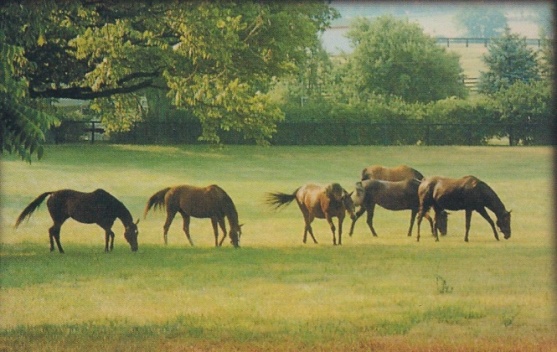
When James and Caty made the transition to Kentucky, they not only left behind their Virginian origins but their Episcopalian roots as well. Most of the Wares that settled in Kentucky joined different Baptist churches. “Westerners, for the most part, detested the English social and political systems which the Episcopal Church represented. It was partly this system of society which drove the Kentucky settlers out of the eastern seaboard colonies into the West.” (Ref. 2208) The newly settled frontier provided fertile ground for the quickly growing Baptist movement. James and Caty became members of the Forks of Elkhorn Baptist Church, and “in May 1801, on Saturday evening, the church met and after divine worship, proceeded to business and received by experience James Ware Jr.” (Ref. 1028) By this time, Caty had seen the birth of 18 of the (more than) 53 grandchildren that her sons and daughters would bring into this world. Thompson had 12, James nine (although many would die very young), Polly eight, Lucy nine, Kitty five, and George 10. Only her son, Charles, remained childless.
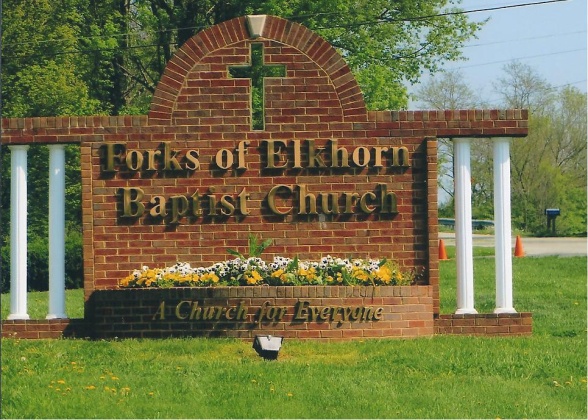 2012
2012
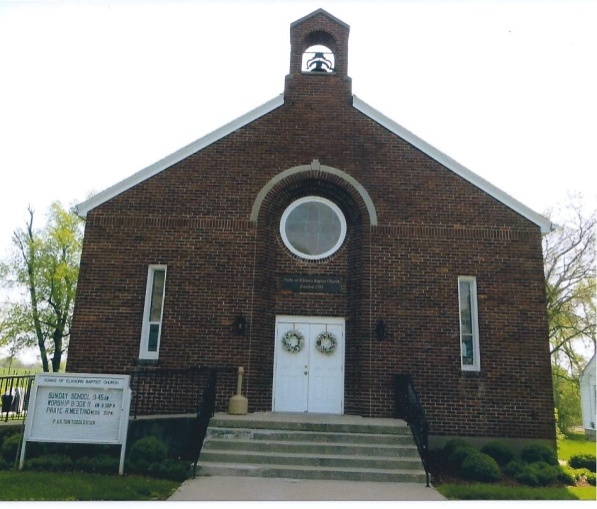 Forks
of Elkhorn Baptist Church
Forks
of Elkhorn Baptist Church
Virginia Catherine Todd Ware died April 23, 1802, at the young age of 49. (Ref. 621,940, 975, 1070) Dr. James Ware lived another 18 years, dying on May 7, 1820, at the age of 79. His will, on file in Fayette County, is interesting to read. He clearly had given a lot of his land away to his children before his death as “gifts” to them. This would explain why his property dropped from 1,500 acres (when he settled on it) to the 693 acres George inherited. Named as the executor of the will, George was bequeathed the “plantation on which the testator now resides,” but James specifically noted that each one of his children would equally benefit from his estate. The will was probated two months after his death, and there was a public sale to liquidate some of his personal property. In an odd twist of fate, James’ son and namesake, James Ware III, would die in Virginia just one year after his father’s passing.
Last Will and Testament of James Ware II
![]()
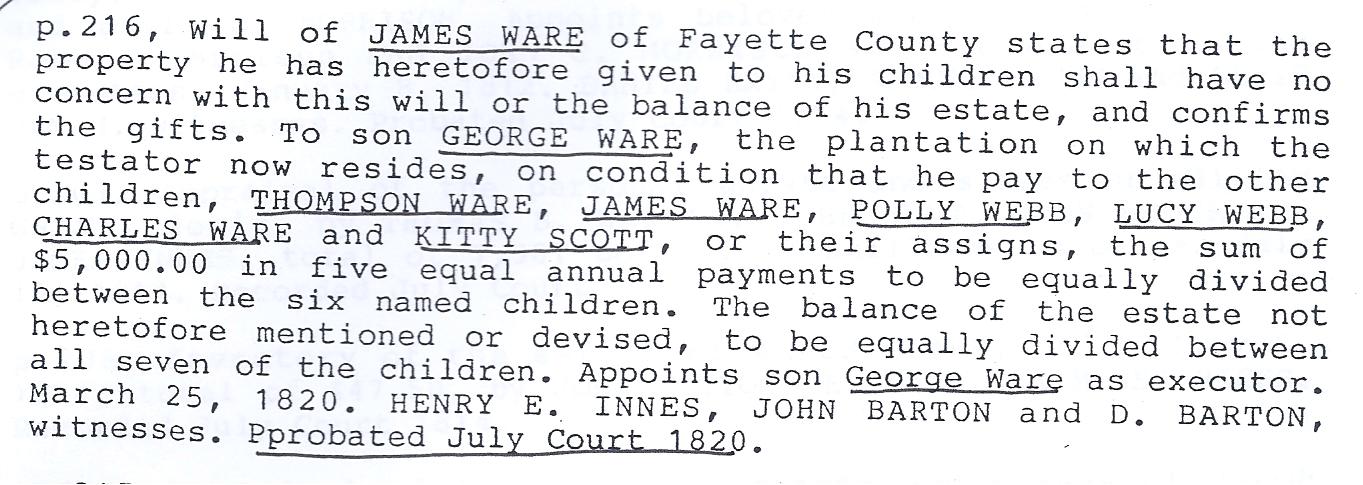
![]()
![]()

“George took over the estate of his parents and lived there until his death in 1849. At that point, the land, which had initially been purchased prior to 1785, passed into his son, Abram Ware’s, hands. Abram resided there until his death in 1894, making the property over 100 years old at the time.” As mentioned in the section under Abram Ware, in 1884, the land had been “divided between Abram and his sister, Lucy Ware Shropshire.” (Ref. 2600)
When George and Nancy Ware died, they were buried in the Lexington Cemetery, but as of now, no grave has ever been found for Caty or James Ware. Most of the Ware and Webb family who died during the cholera epidemic of 1833, were “buried in a small cemetery near the home of Isaac Webb.” (Ref. 934) The map below shows the close proximity of that graveyard to the home of James Ware. It is possible that the graves of James and Caty Ware were among the unrecognizable ones located in the Webb/Ware Cemetery at the time of the 1931 restoration - many of the oldest stones were beyond saving. It is also possible the couple was buried somewhere else on their land.
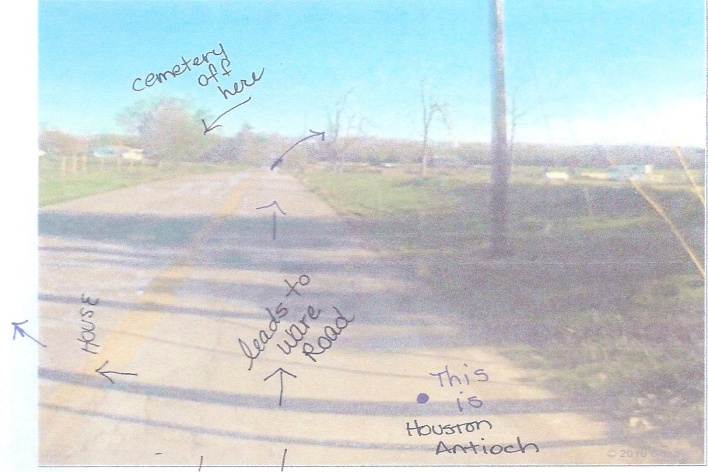
<------<----- Briar Hill Road goes this way--->----- >
In 2009, my husband and I first laid our eyes on the actual property that James and Caty had owned. We, subsequently, got to visit again in 2012. It was a remarkable experience to see the land on which our ancestors had walked. Married for 35 years, James and Caty had shared an amazing adventure of traveling from Virginia to Kentucky. They obviously had witnessed many changes in their lives together, but it would seem the one thing that remained unchangeable was their devotion to each other.

Property originally owned by Caty and James Ware II
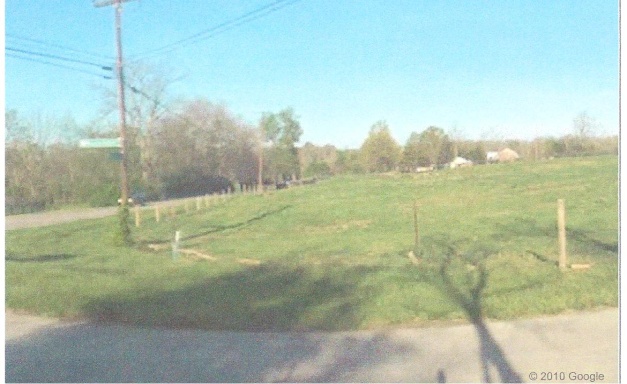
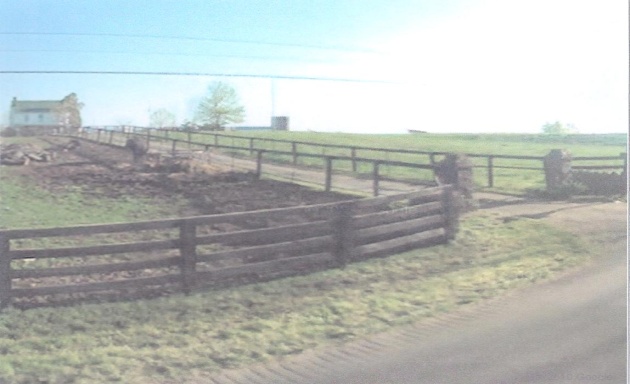 Source:
Google Maps
Source:
Google Maps
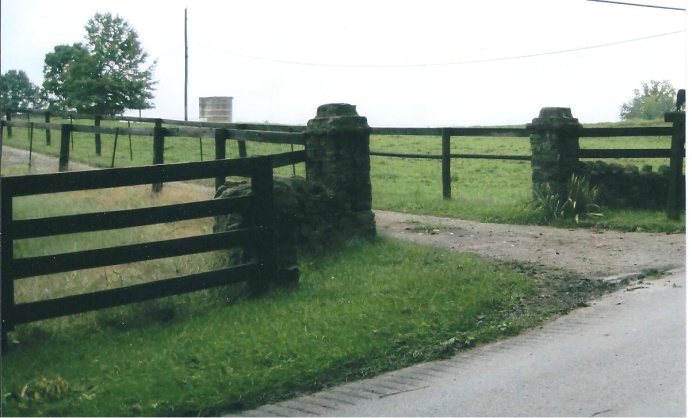
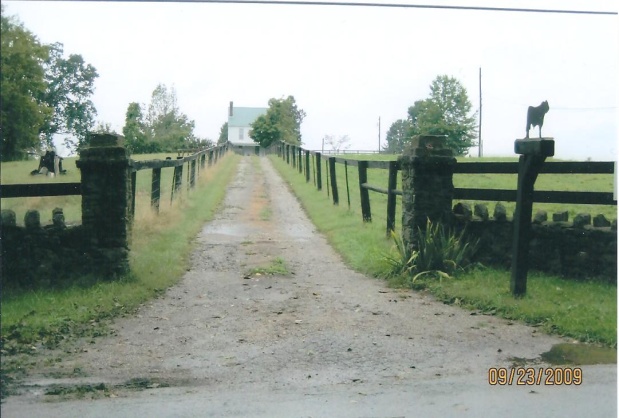
Photos above taken by James & Judy Ware 2009
Land purchased by James Ware II in the late 1700s
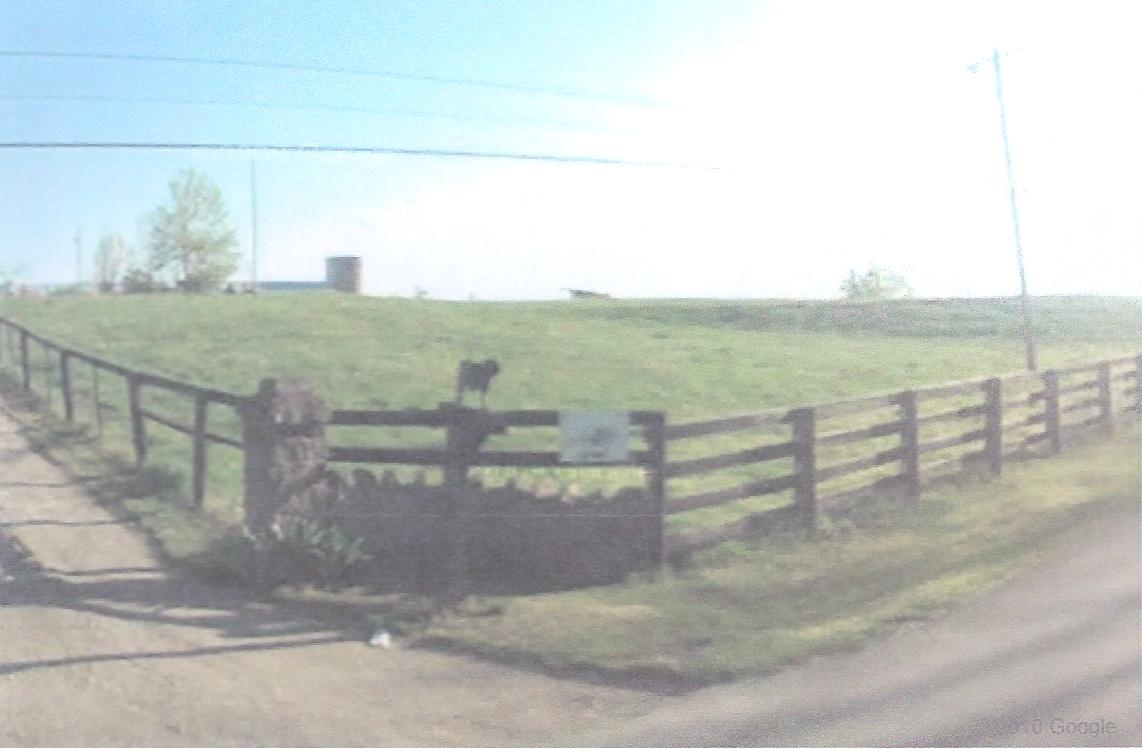

Supporting Documentation for Chapter 6
 EXPLANATION
OF DOUBLE-DATING
EXPLANATION
OF DOUBLE-DATING
The following is an explanation taken from Virginia Roots in Kentucky Soil. It is an interesting and clarifying piece of data on “establishing dates” for genealogists who may not be familiar with it. It was kindly provided by Debbie McArdle with proper accreditation for the original source shown at the bottom.”(Ref. 2350)
"Calendar difficulties may come as a surprise to you unless you have either studied astronomy or have a good background in history. However, the calendar and its transition from the Julian to the Gregorian system and other changes involved therewith have considerable impact on many early American genealogical problems.
The main problem has to do with the changing of the calendars - when the switch was made from the Julian to the Gregorian. In Britain and her colonies (which included most colonies in America) this took place in 1752. (The Dutch in New Netherland never used the Julian Calendar. The Dutch had accepted the Gregorian Calendar prior to their American colonization. These people even continued to use New Style dates in their private records after England had control of their colony. The Quakers did not accept the ecclesiastical calendar but began their year on January 1 even though they otherwise accepted the dates of the Julian Calendar.) Remember that 1752 date; it is important. During the period while the Julian Calendar was used, the Christian church and the countries within which that church prospered used what we call an ecclesiastical calendar which had New Year's Day falling on March 25. This was the day of the Feast of the Annunciation which commemorates the visit of the Angel Gabriel to the Virgin Mary to inform her that she would be the mother of the Messiah. Note that this date is exactly nine months before Christmas, when we celebrate that birth.
Let's take an example to show the effects of this situation. You have several documents (such as wills) recorded in chronological order. The dates on these might run something like this:
November 14, 1718
December 26, 1718
January 3, 1718
January 22, 1718
February 16, 1718
March 5, 1718
March 23, 1718
March 28, 1719
April 12, 1719
This is very simple, isn't it? The main difficulty here is that we are accustomed to beginning our years on January 1, so when we see a date like one of these (say February 16, 1718) we automatically put it in the wrong year - we are automatically one year off.
One year off isn't bad, you say? This is true unless it leads you to make incorrect conclusions. If the record in question happens to be a church register and the christenings, etc. of your ancestor's children recorded therein, you may have a problem. Let's say you find two christenings on the following dates for persons you suppose are your ancestor's children:
April 1, 1720 March 22, 1720
If you didn't know that the year 1721 began three days after the second of these two christenings, what would be your conclusion?
Because of this problem, we use what we call double-dating. This means that whenever a date falls between January 1 and March 24, inclusive, before 1752, it should be recorded to reflect both the ecclesiastical and the historical calendars. (Ref. 2117) "The Researcher's Guide to American Genealogy" 2nd Edition, Val D. Greenwood, Genealogical Publishing Co., Baltimore, MD, 1993, p41-43, kindly shared by Debbie McArdle
![]()
CHILDREN OF: DR. JAMES WARE II & VIRGINIA (CATY) TODD WARE
B. March 13, 1741/2 (1767) B. February 9, 1753
D. May 7, 1820 D. April 23, 1802
Dr. James Ware was the 2nd son of James Ware I and his wife, Agnes Todd Ware. He studied medicine in Virginia and married Virginia Catherine Todd there in 1767. He later relocated to Kentucky with his whole family except his namesake, James Ware III. (Ref. 1070 and 2227 for exact dates)
(7) George Ware (Feb. 9, 1779 - July 28, 1849) wed Nancy Ferguson on June 10, 1812. (Ref. 975)
![]()
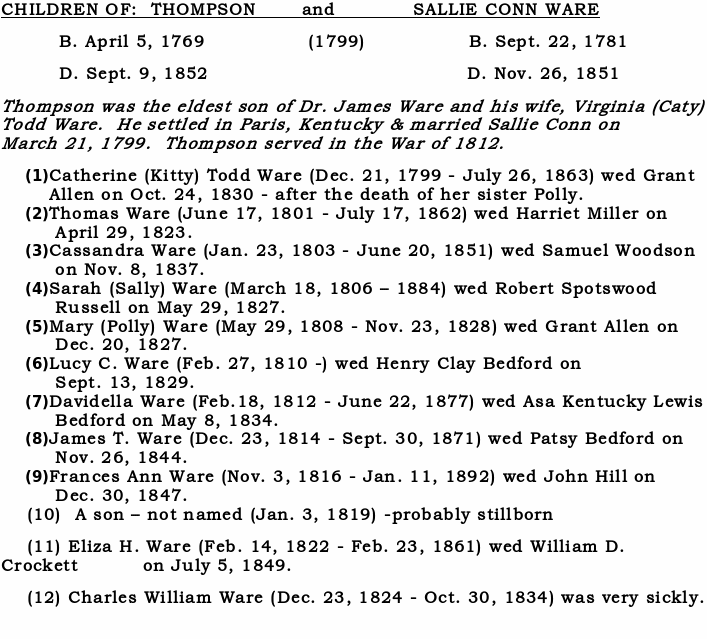 New
information was provided from the Ware Family Bible of James Thompson
Ware – generously shared courtesy of Debbie McArdle (Ref.
1070)
New
information was provided from the Ware Family Bible of James Thompson
Ware – generously shared courtesy of Debbie McArdle (Ref.
1070)

CHILDREN OF:
JAMES THOMPSON and PATSY BEDFORD WARE
B. Dec. 23, 1814 B. July 3, 1823
D. Sept. 30, 1871 D. June 3, 1896
James Thompson was the 2nd son of Thompson and Sallie Ware. He was the grandson of Dr. James Ware and his wife, Virginia (Caty) Todd Ware. He married Patsy Bedford on November 26, 1844.
never married. She was shown as single on all census records through 1930, living with her brother, Henry.
(4) Mary Ware (July 7, 1852 - July 29, 1852) died at 3 weeks.
(5) Henry Bedford Ware (Dec. 22, 1853 - Dec. 23, 1930) never married. He
lived with his sister, Lucy.

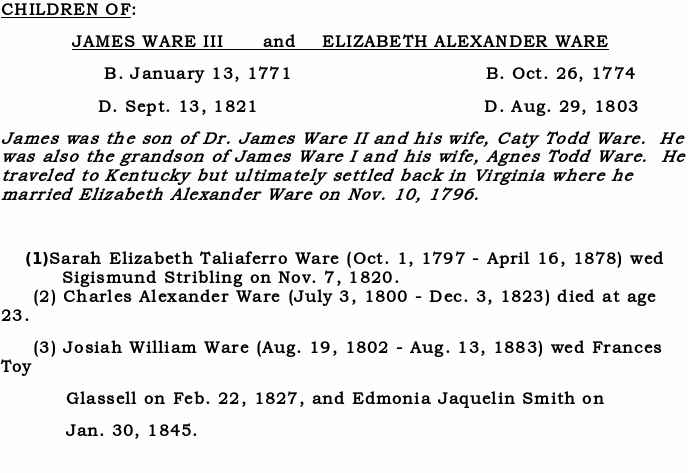
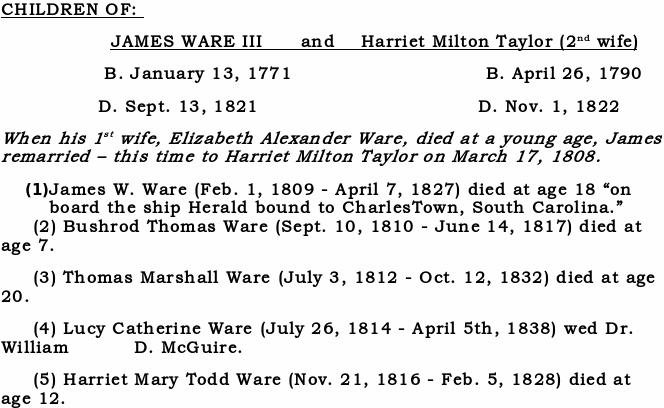 (6) Elizabeth
Alexander Ware (Nov. 6, 1818
- Jan. 6, 1820) died at 14 months.
(6) Elizabeth
Alexander Ware (Nov. 6, 1818
- Jan. 6, 1820) died at 14 months.
![]()
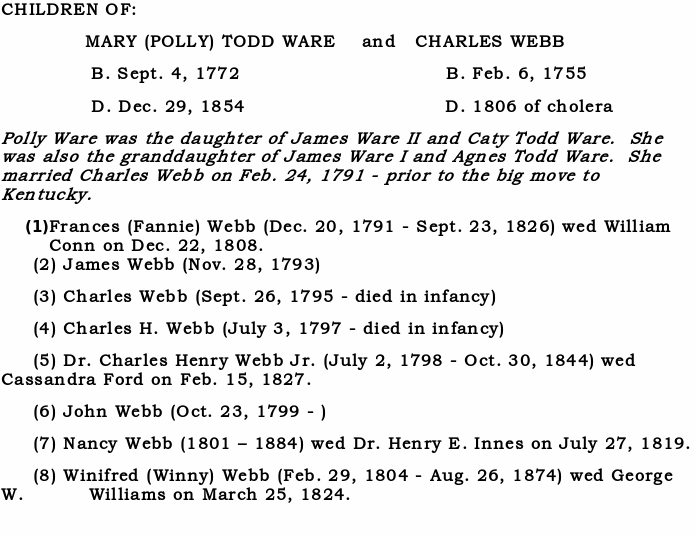 **
Above information kindly provided from family records of Sandra
Walker
**
Above information kindly provided from family records of Sandra
Walker
(Ref. 2210)
![]()
![]()
CHILDREN OF:
CHARLES HENRY WEBB JR. and CASSANDRA FRANCES FORD
B. July 2, 1798 B. Aug. 7, 1807
D. Oct. 1844 D. Dec. 6, 1863
Charles Henry Webb was the son of Mary Todd Ware Webb (Polly) and her husband, Charles Webb. He married Cassandra Frances Ford on February 15, 1827. She was the daughter of James Ford.
(3) James Philip Webb (June 7, 1831 - ) wed Nannie Machen.
(4) Nancy Winifred Webb (Jan. 31, 1833 - ) wed Thomas J. Duncan.
(5) Cannie Webb (Nov. 26, 1834 - Oct. 22, 1844)
(6) Charles William Webb (June 9, 1836 - Sept. 26, 1837) died at 15 months.
(7) Augusta Ware Webb (Oct. 2, 1840 - April 11, 1907) wed Francis (Frank) Ford on July 23, 1869.
(8) Charles Henry Webb III (Sept. 9, 1843 - July 8, 1861)
(9) Cassandra Ford Webb (May 10, 1845 - Sept. 13, 1924)
CHILDREN OF:
WINIFRED WEBB and MAJOR GEORGE W. WILLIAMS
B. Feb. 29, 1804 B. Oct. 7, 1801
D. Aug. 26, 1874 D. Jan. 1870
Winnie was the daughter of Polly and Charles Webb and the granddaughter of James & Caty Ware. She and George Williams married on March 23, 1824.
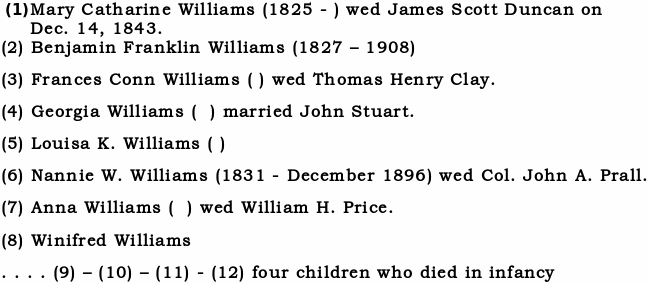
![]()
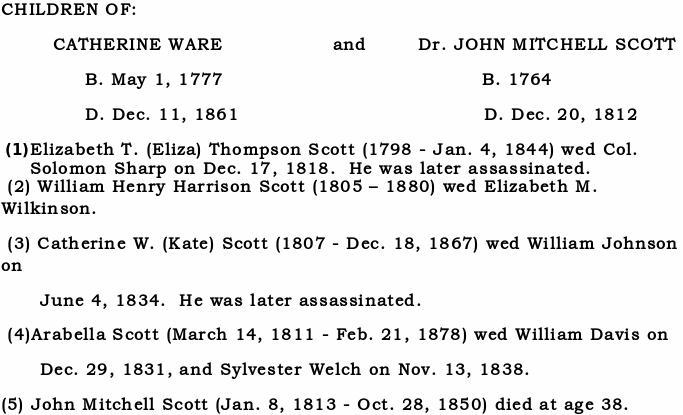 ***Four
children died in infancy (Ref.
484, 1032, 2219, 2220, 2227, 2247, 2253)
***Four
children died in infancy (Ref.
484, 1032, 2219, 2220, 2227, 2247, 2253)
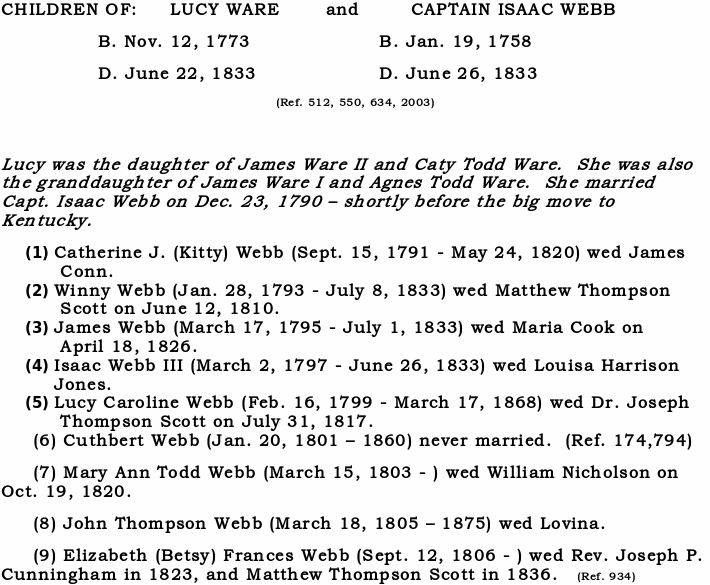
![]()
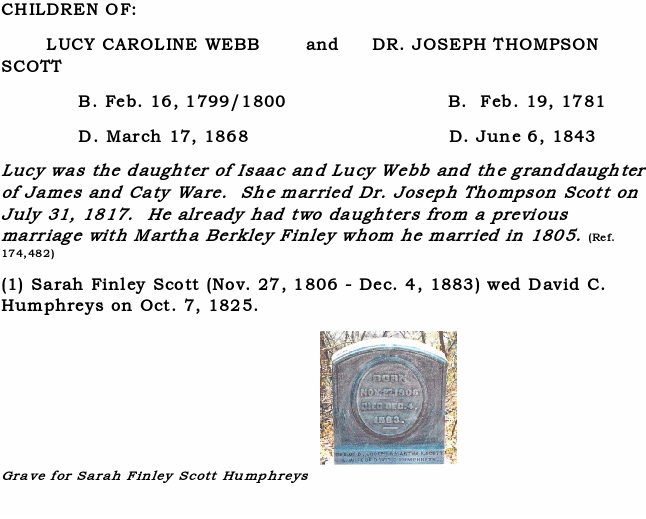 (2)
Elizabeth Thompson Scott (May 10, 1808
- March 6, 1876) wed Humphrey Fullerton on Oct. 31, 1833.
(2)
Elizabeth Thompson Scott (May 10, 1808
- March 6, 1876) wed Humphrey Fullerton on Oct. 31, 1833.
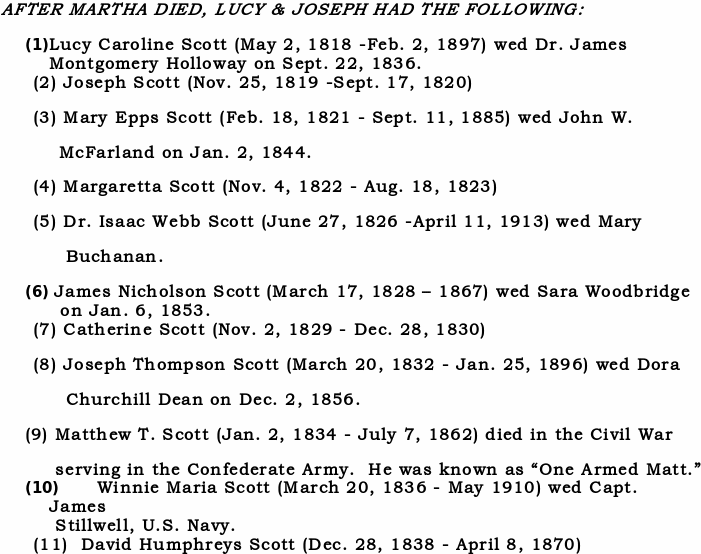 (Ref.
479, 796, 2261)
(Ref.
479, 796, 2261)
![]()
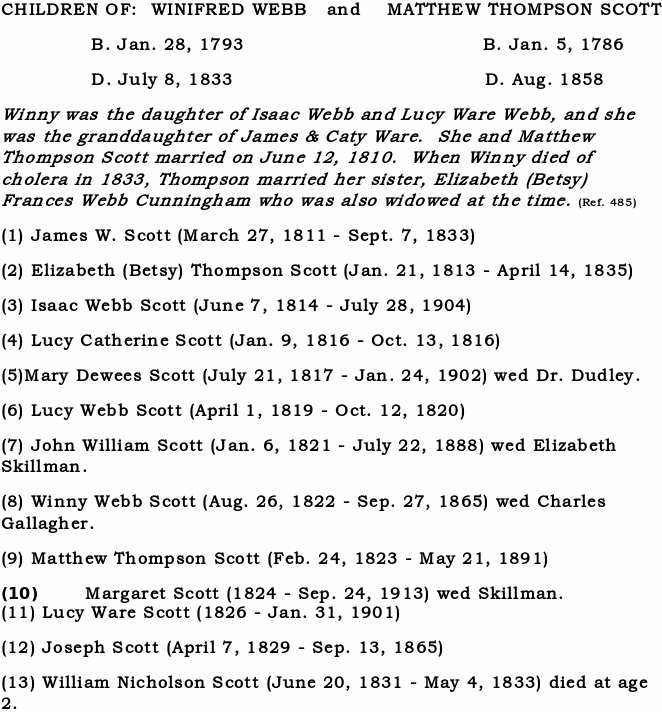 (14)
William Thompson Scott (June 23, 1833
- Jan. 2, 1875)
(14)
William Thompson Scott (June 23, 1833
- Jan. 2, 1875)
![]()
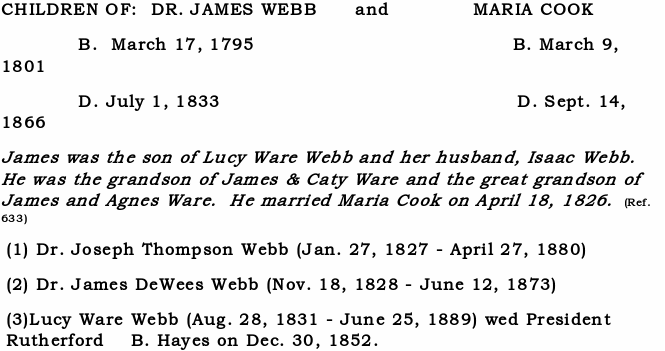 (Ref. 411, 633)
(Ref. 411, 633)
![]()
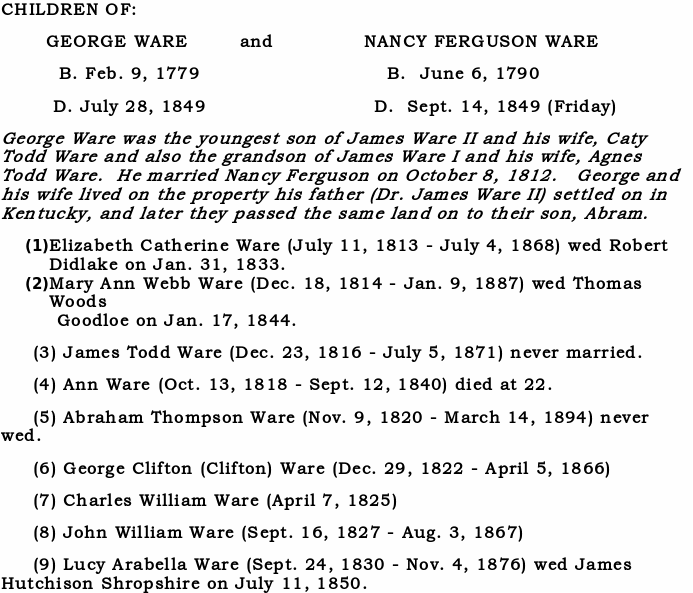 (10) Joseph Scott Ware
(Sept. 13, 1833
- Sept. 26, 1863) died at 20 years.
(10) Joseph Scott Ware
(Sept. 13, 1833
- Sept. 26, 1863) died at 20 years.
![]()
![]()
The following bible pages provided through the kindness of Debbie McArdle
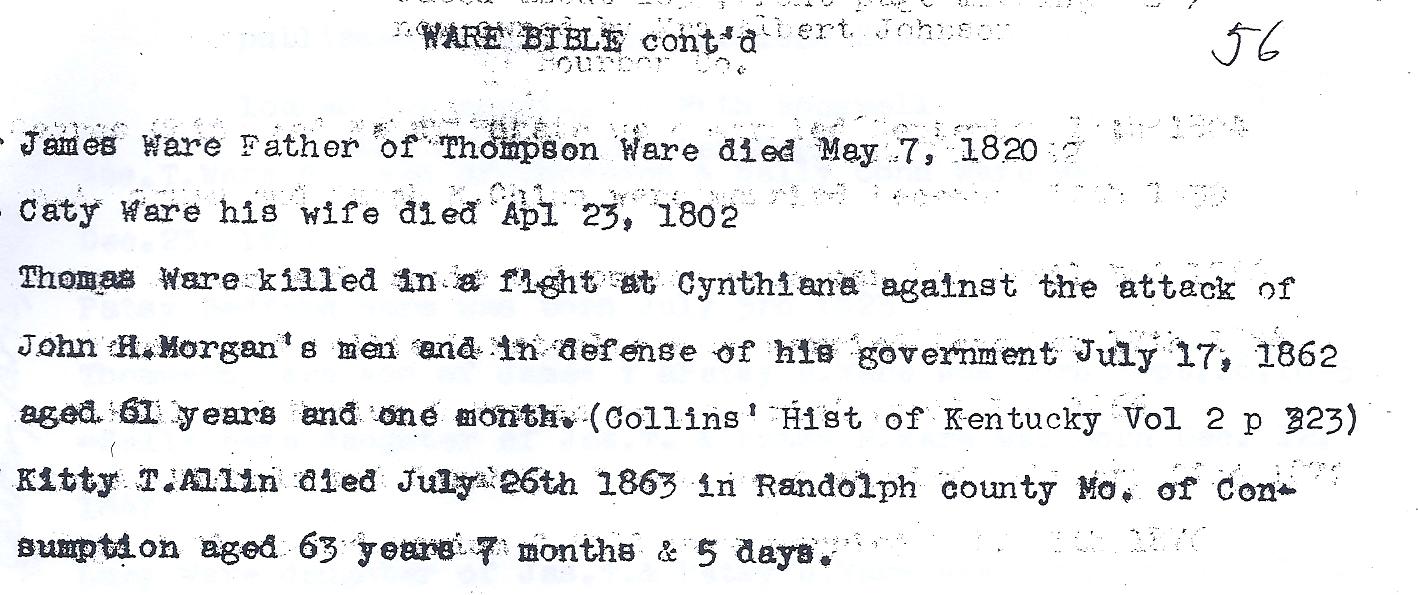
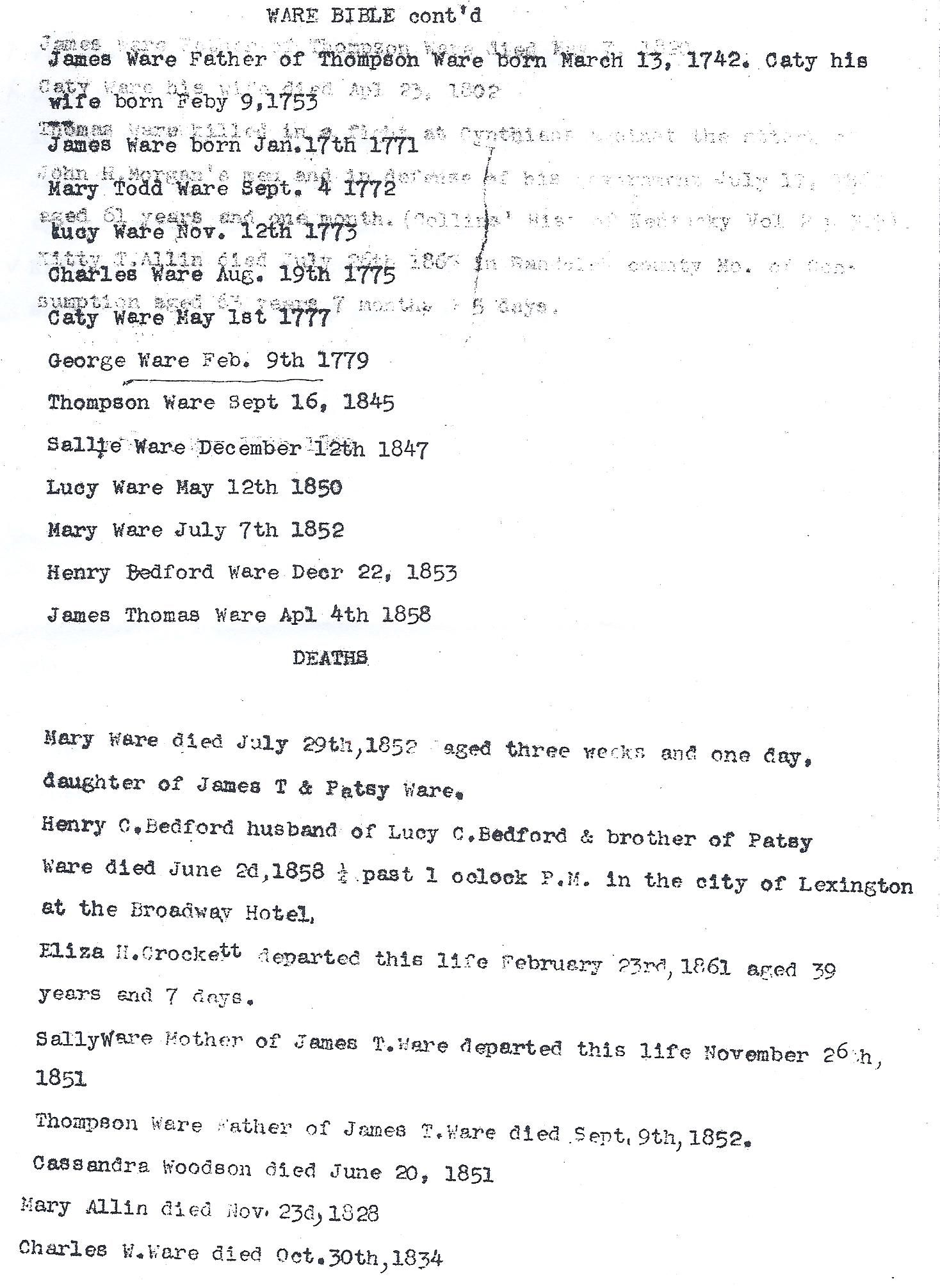
![]()
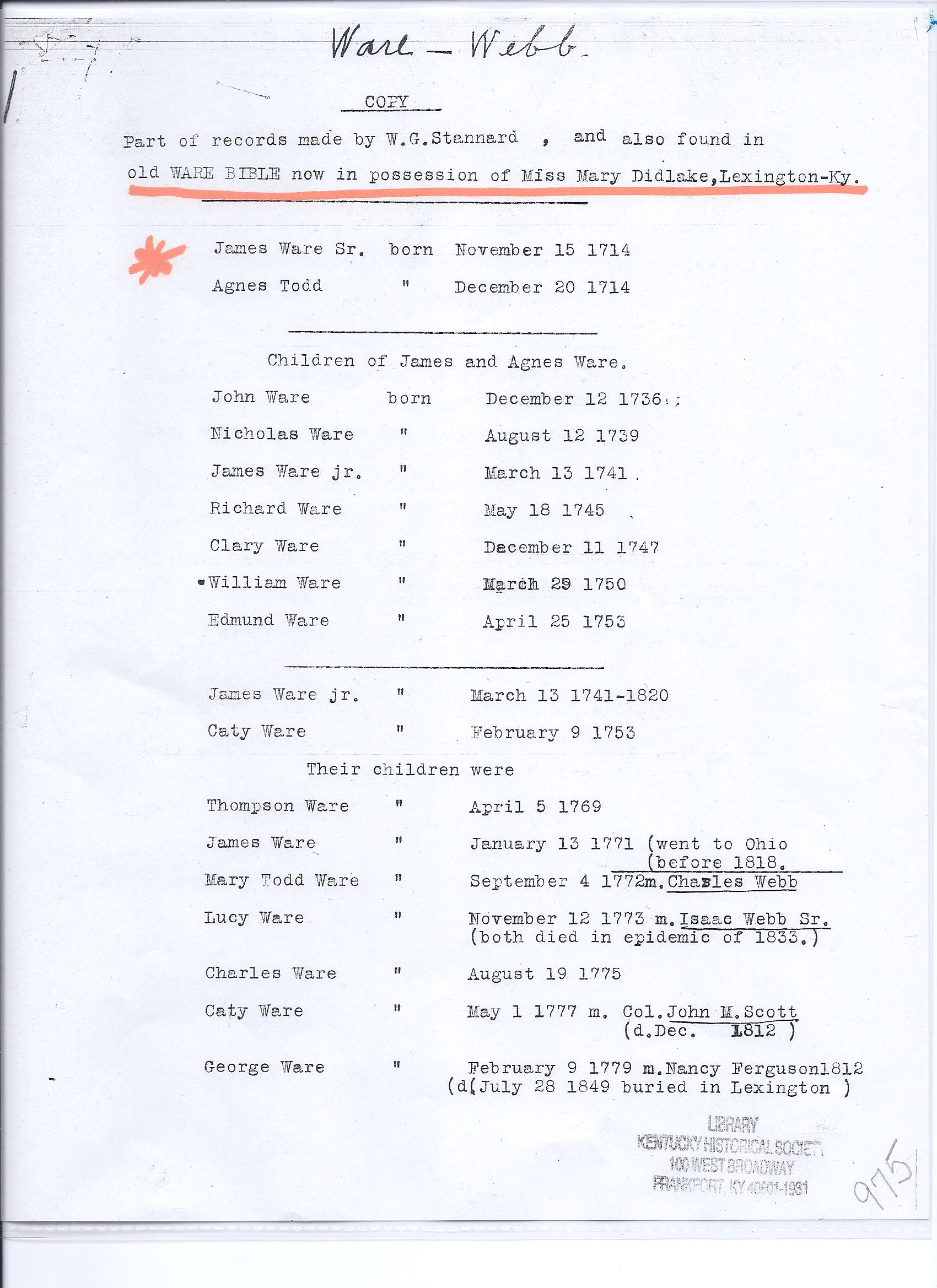
Didlake Bible
![]()
![]()
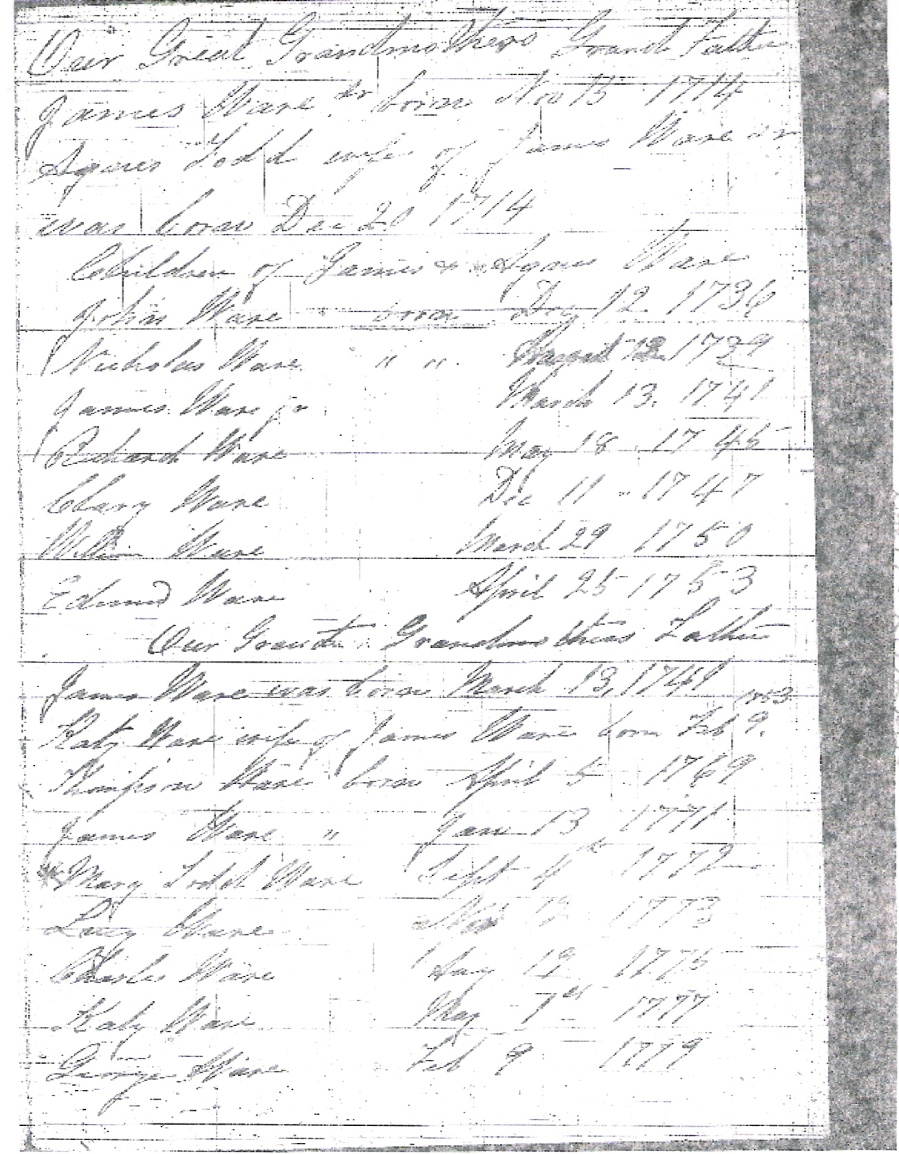
Ware/Webb Bible
![]()
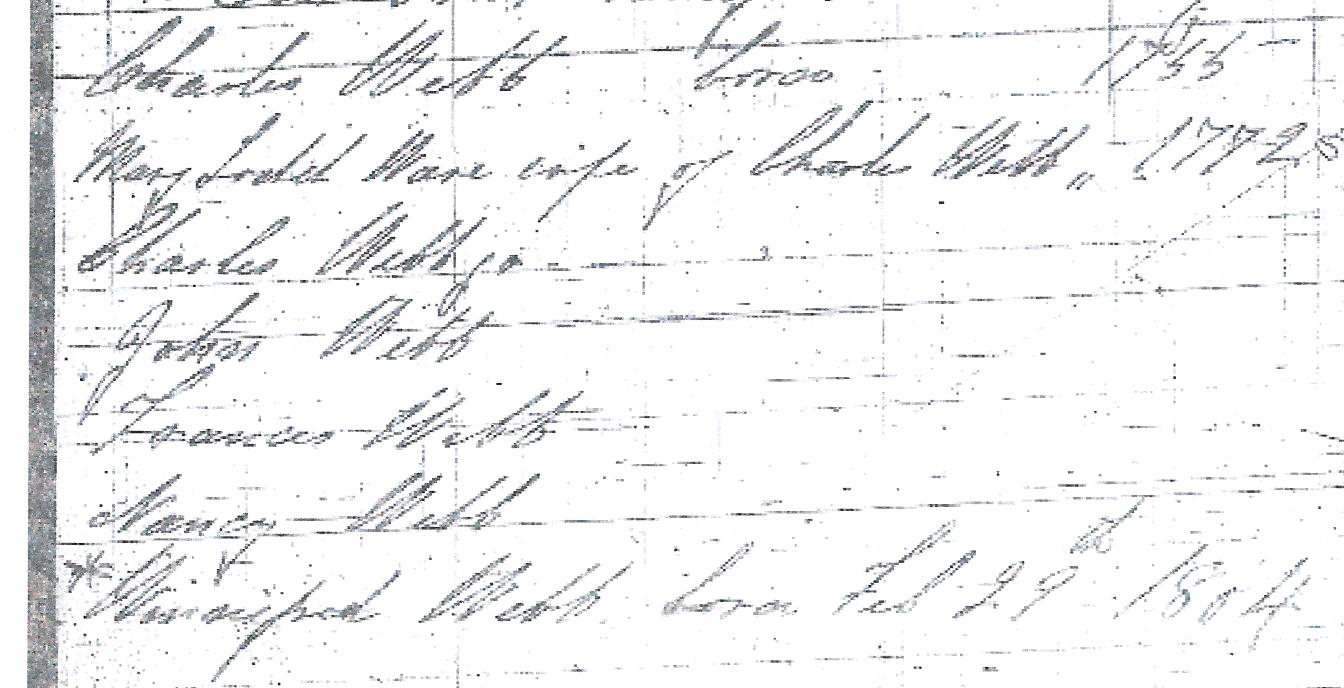
![]()
Showing births of both Charles and Polly
![]()
The following sections are from Woodford County Land Patents: History, Components, & Series by Alison Lundergan Grimes, Kentucky Secretary of State 2012 - They offer a wonderful explanation of the procedures involved in legalizing a land warrant from the war.
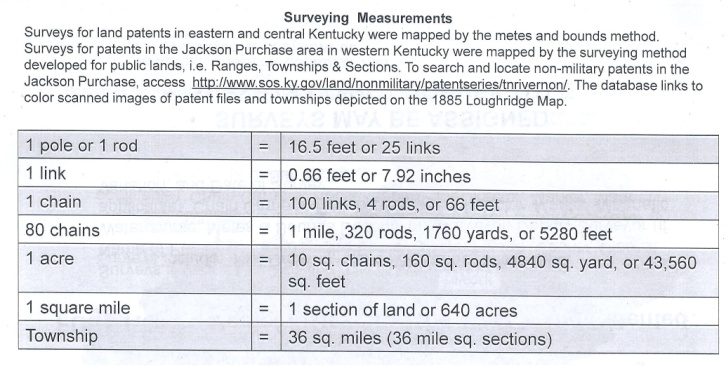
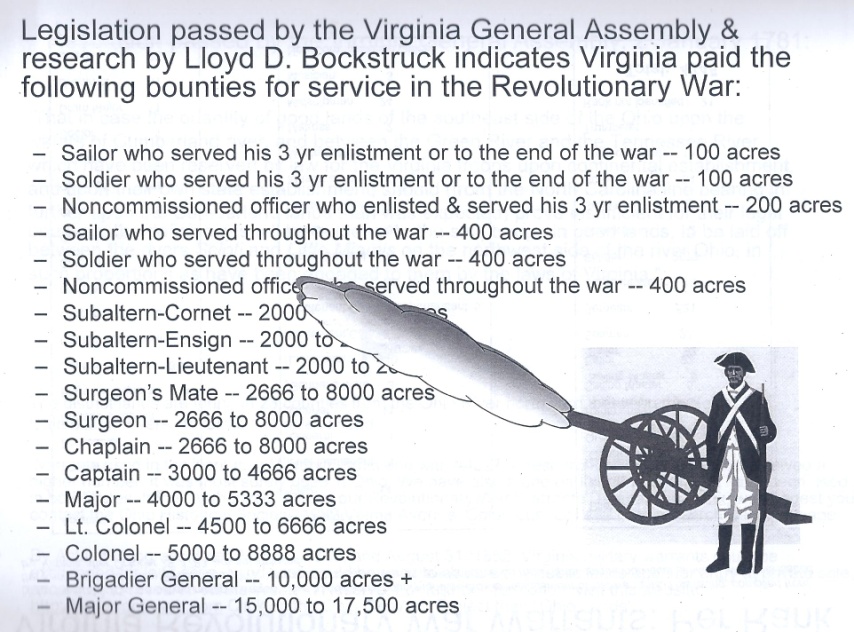
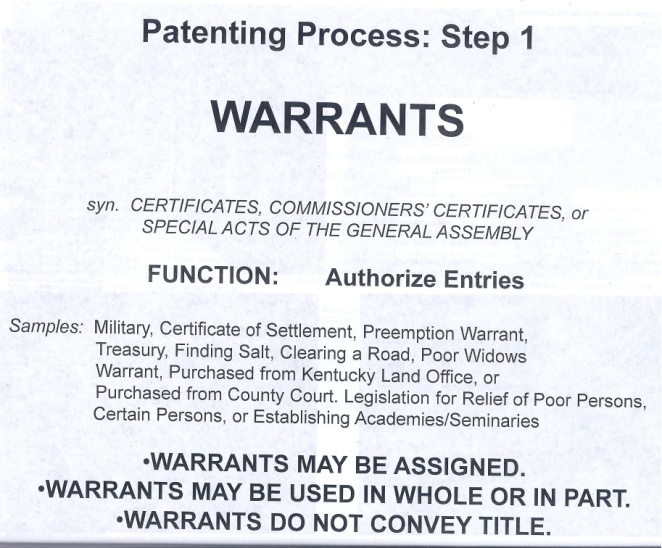
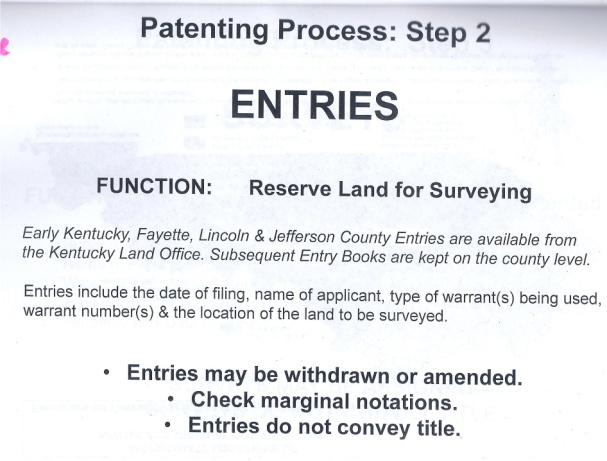
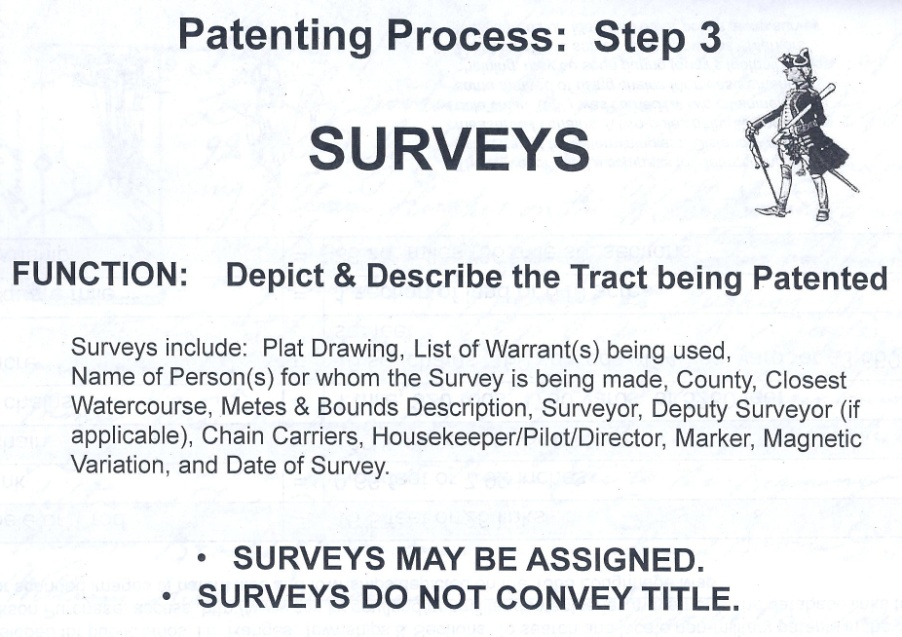
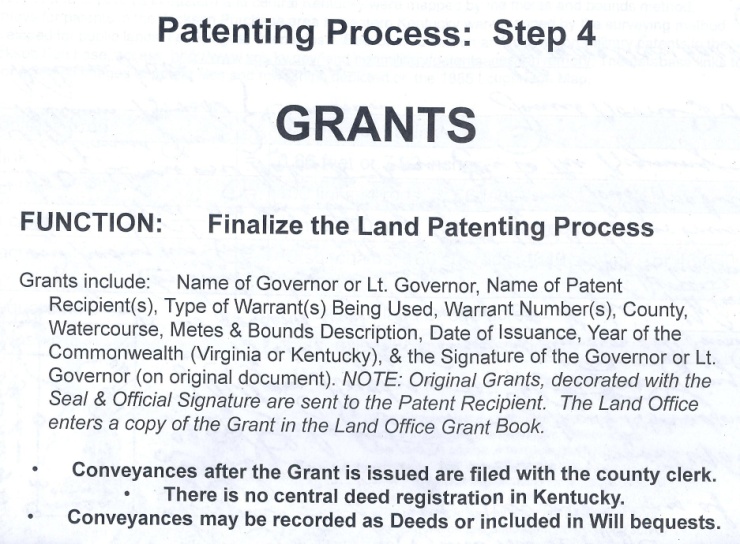
![]()
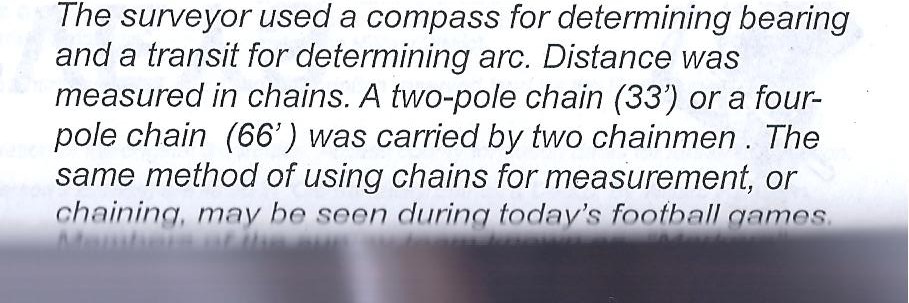
![]()